11.5: South America before c. 1500
- Page ID
- 67099
South America to c. 1500
3500 B.C.E.–1500 C.E.
Introduction to Andean Cultures
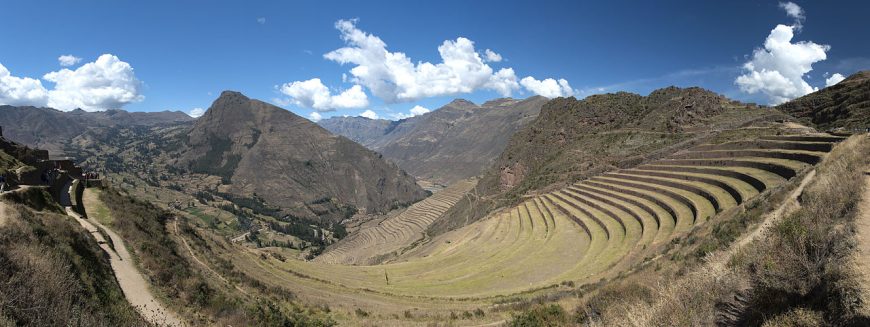
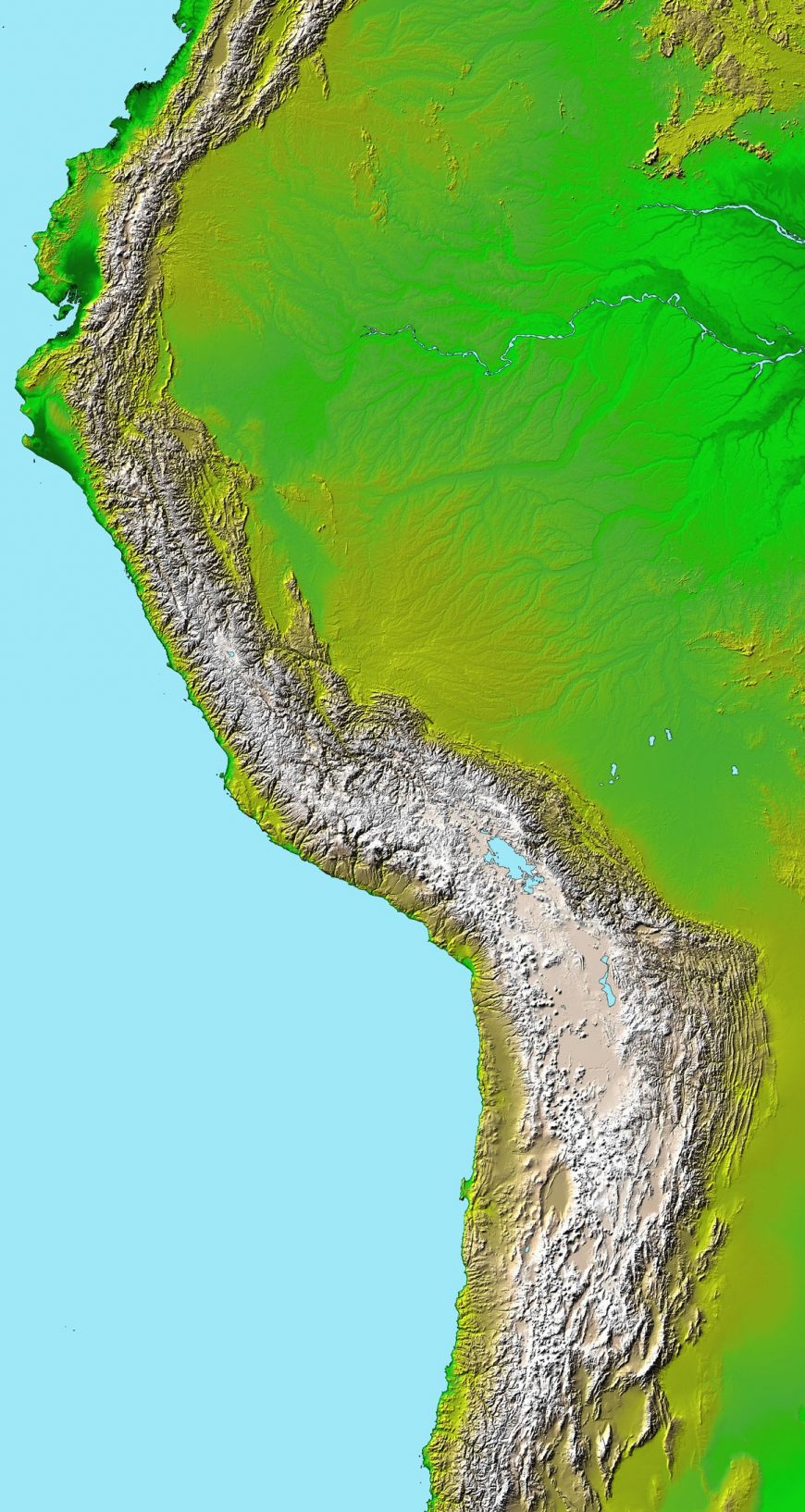
A land of contrasts
“The Andes” can refer to the mountain range that stretches along the west coast of South America, but is also used to refer to a broader geographic area that includes the coastal deserts to the west and into the tropical jungles to the east of those mountains. This region is seen as home to a distinct cultural area—dating from around the fourth millennium B.C.E. to the time of the Spanish conquest—and many of these cultures still persist today in various forms.
From the desert coast, the mountains rise up quickly, sometimes within 10-20 kilometers of the Pacific Ocean. Therefore, the people who lived in the Andes had to adapt to varying types of climate and ecosystems. This diverse environment gave rise to a range of architectural and artistic practices.
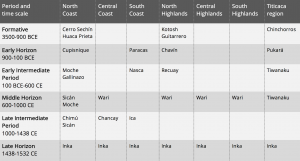
Deserts, mountains, and farms
Though much of the Andean coast is near the Equator, its waters are cold, due to currents from the Antarctic. This cold water is rich in sea life; however, during El Niño years, warm water takes over, leading to large die-offs of fish and marine mammals, and often creating catastrophic flooding on the coast.
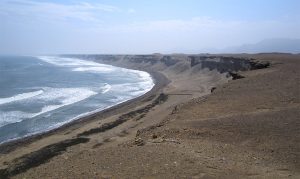
In normal years, the coast is very dry. The rivers that run to the coast, fed by melting snow from the Andes mountains (called the Cordillera Blanca, or White Mountains, in contrast to the Cordillera Negra, or Black Mountains to the west where snow does not fall), create areas of agricultural lands interspersed with desert. Cultures eventually learned to create canals, allowing them to irrigate more land, and irrigation remains important to farming on Peru’s coast.

As the elevation climbs, different ecological zones are created, and people of the Andes used these to grow different products: maize (corn), hot peppers, potatoes, and coca all grew at different elevations. Some cultures (such as the Cupisnique and Paracas) developed on the coast, and incorporated seafood into their diet. They would trade with the cultures that lived in the highlands (such as the Recuay and the inhabitants of Chavín de Huantar) for the things they could not grow for themselves. The people in the highlands would likewise trade with the coastal peoples for dried fish and products that would not grow at their elevation, as well as exotic animals like parrots from the tropical jungles to the east.
Plants and animals
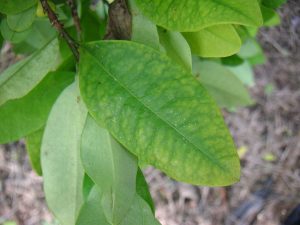
The plants and animals of the Andes provided ancient peoples with food, medicine, clothing, heat, and many other resources for daily life. As noted above, the rapid change in elevation of the Andes meant that many different foods could be grown in a compressed area. Potatoes were a staple food of the highlands, and maize and manioc were important in the lower elevations.
Coca grew in the highlands but was traded all over the Andes. The leaves of this plant, when chewed, provide a stimulant that allows people to walk for long periods at high altitude without getting tired, and it suppresses hunger. It was used by travelers in the highlands, but was also used in ritual practices to endure long nights of dancing. In modern times, people drink it as a tea to help with the symptoms of altitude sickness.
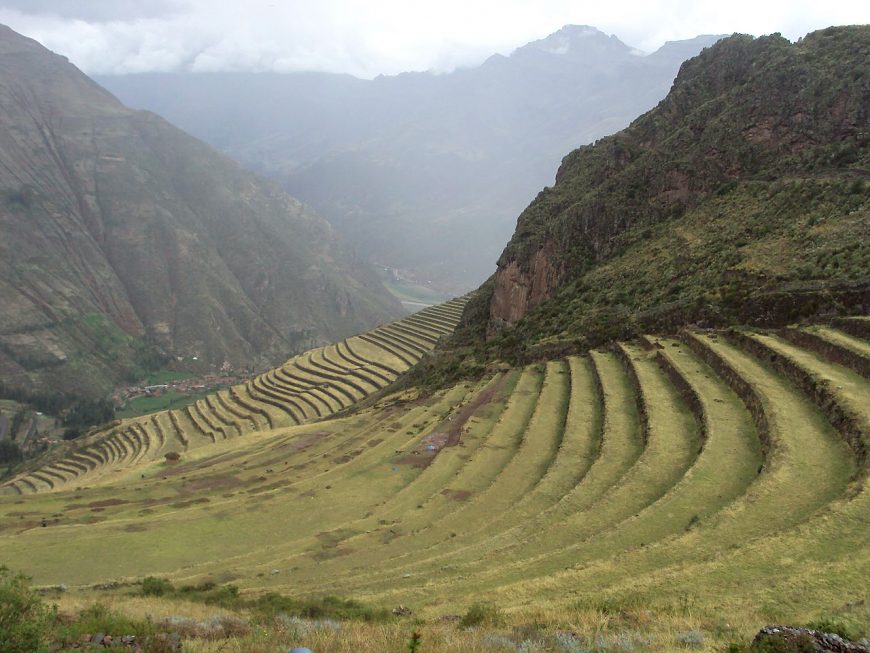
Farming in the steep topography of the mountains could be difficult, and an important innovation developed by the Andeans was the use of terracing. By creating terraces (essentially giant steps along the contours of a mountain) people were able to make flat, easily worked plots. The terraces were formed by creating retaining walls that were then backfilled with a thick layer of loose stones to aid drainage, and topped with soil.
The most important animals in the highlands were camelids: the wild vicuña and guanaco, and their domesticated relatives, the llama and alpaca. Alpacas have soft wool and were sheared to make textiles, and llamas can carry burdens over the difficult terrain of the mountains (an adult male llama can carry up to 100 pounds, but could not carry an adult human).
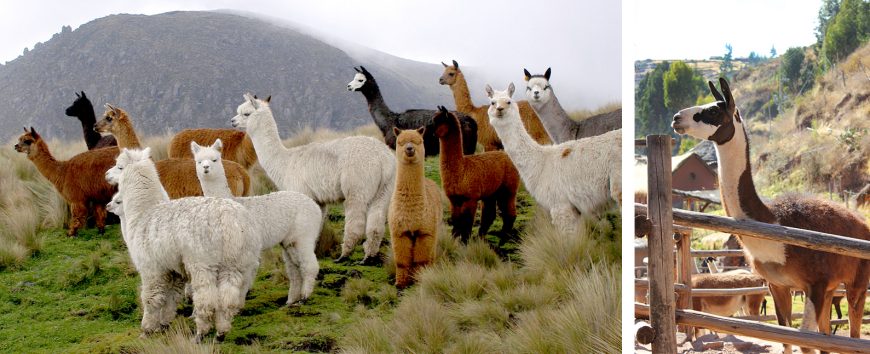
Both animals were also used for their meat, and their dried dung served as fuel in the high altitudes, where there was no wood to burn. Andean camelids, like their African and Asian cousins, can be very headstrong. If they are overloaded, they will sit on the ground and refuse to budge. Because of this, the ancient people of the Andes did not have domesticated animals that could carry them or pull heavy wagons, and so roads and methods of moving people and goods developed differently than in Europe, Asia, and Africa. The wheel was known, but not used for transport, because it simply would not have been useful.
Textile arts
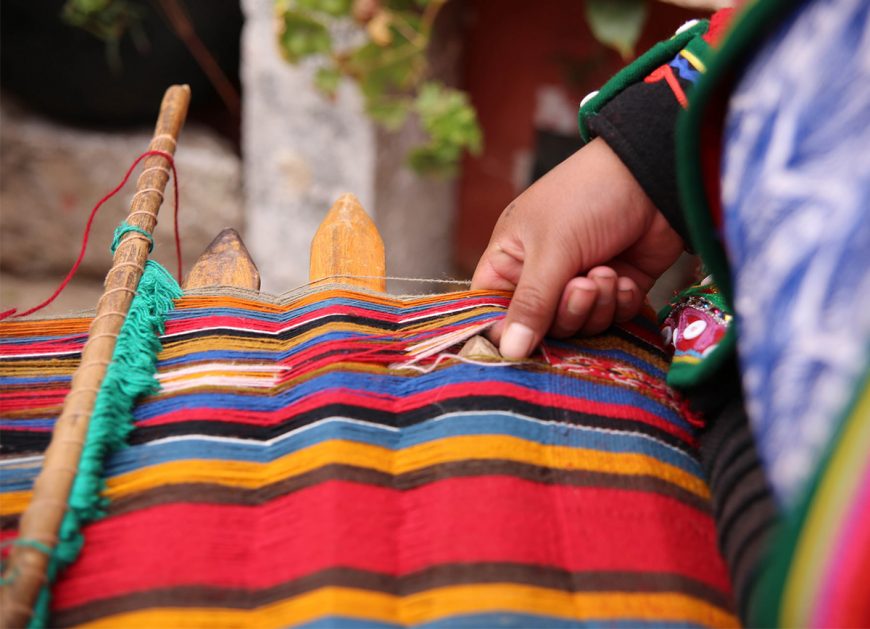
The ancient peoples of the Andes developed textile technology before ceramics or metallurgy. Textile fragments found at Guitarrero Cave date from c. 5780 B.C.E. Over the course of millennia, techniques developed from simple twining to complex woven fabrics. By the first millennium C.E., Andean weavers had developed and mastered every major technique, including double-faced cloth and lace-like open weaves.
Andean textiles were first made using fibers from reeds, but quickly moved to yarn made from cotton and camelid fibers. Cotton grows on the coast, and was cultivated by ancient Andeans in several colors, including white, several shades of brown, and a soft grayish blue. In the highlands, the alpaca provided soft, strong wool in natural colors of white, brown, and black. Both cotton and wool were also dyed to create more colors: red from cochineal, blue from indigo, and other colors from plants that grew at various elevations. Alpaca wool is much easier to dye than cotton, and so it was usually preferred for coloring. The extra time and effort needed to dye fibers made the bright colors a symbol of status and wealth throughout Andean history.
Ceramics
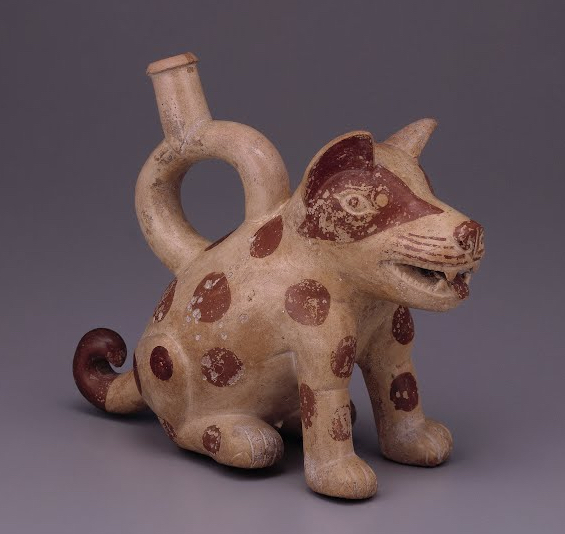
Though ceramics were not as valuable as textiles to Andean peoples, they were important for spreading religious ideas and showing status. People used plain everyday wares for cooking and storing foods. Elites often used finely made ceramic vessels for eating and drinking, and vessels decorated with images of gods or spiritually important creatures were kept as status symbols, or given as gifts to people of lesser status to cement their social obligations to those above them.
There are a wide variety of Andean ceramic styles, but there are some basic elements that can be found throughout the region’s history. Wares were mostly fired in an oxygenating atmosphere, resulting in ceramics that often had a red cast from the clay’s iron content. Some cultures, such as the Sicán and Chimú, instead used kilns that deprived the clay of oxygen as it fired, resulting in a surface ranging from brown to black.
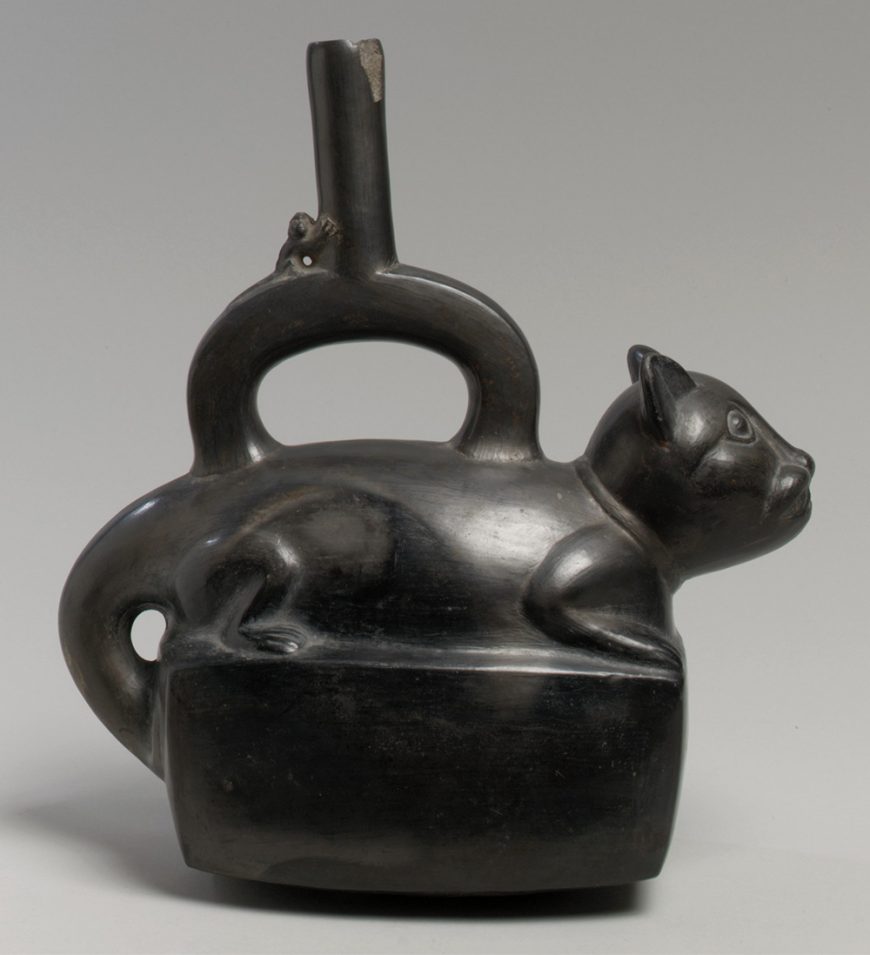
Decoration of ceramics could be done by incising lines into the surface, creating textures by rocking seashells over the damp clay, or by painting the surface.
Some early elite ceramics were decorated after firing with a paint made from plant resin and mineral pigments. This produced a wide variety of bright colors, but the resin could not withstand being heated and so these resin-painted wares were only for display and ritual use. Most ceramics in the Andes instead were slip-painted. Slip is a liquid that is made of clay, and the color of the slip is determined by the color of the clay and its mineral content. Most slip painting was applied before firing, after the semi-dry clay had been burnished with a smooth stone to prepare the surface. The range of slip colors could vary from two (seen in Moche ceramics) to seven or more (seen in Nasca ceramics). Once fired, the burnished surface would be shiny. Ceramics, because of their durability, are one of the greatest resources for understanding ancient Andean cultures.
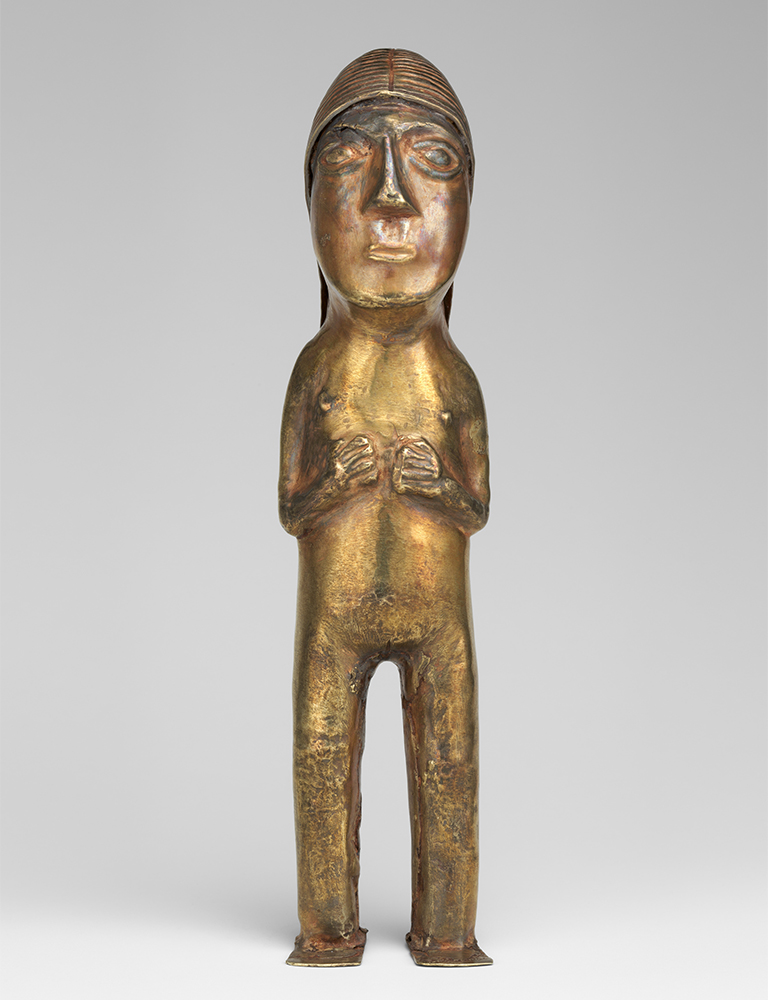
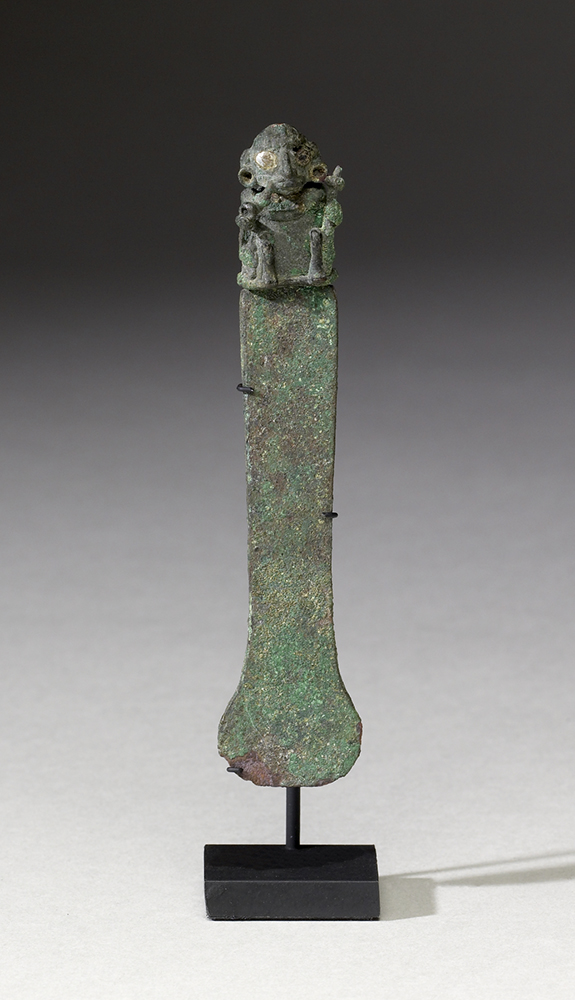
Metalwork
Metalworking developed later in Andean history, with the oldest known gold artifact dating to 2100 B.C.E., and evidence of copper smelting from around 900–700 B.C.E. Gold was used for jewelry and other forms of ornamentation, as well as for making sculptural pieces. Inka figurines of silver and gold depicting humans and llamas have been recovered from high-altitude archaeological sites in Peru and Chile. Copper and bronze were also used to create jewelry and items like ceremonial knives (called tumis).
Architecture
The architecture of the Andes can be divided roughly between highland and coastal traditions. Coastal cultures tended to build using adobe, while highland cultures depended more on stone. However, the lowland site of Caral, which is currently the oldest complex site known in the Andes, was built mainly using stone.

Beginning with Caral in 2800 B.C.E, various cultures constructed monumental structures such as platforms, temples, and walled compounds. These structures were the focus of political and/or religious power, like the site of Chavín de Huantár in the highlands or the Huacas de Moche on the coast. Many of these structures have been heavily damaged by time, but some reliefs and murals used to decorate them survive.
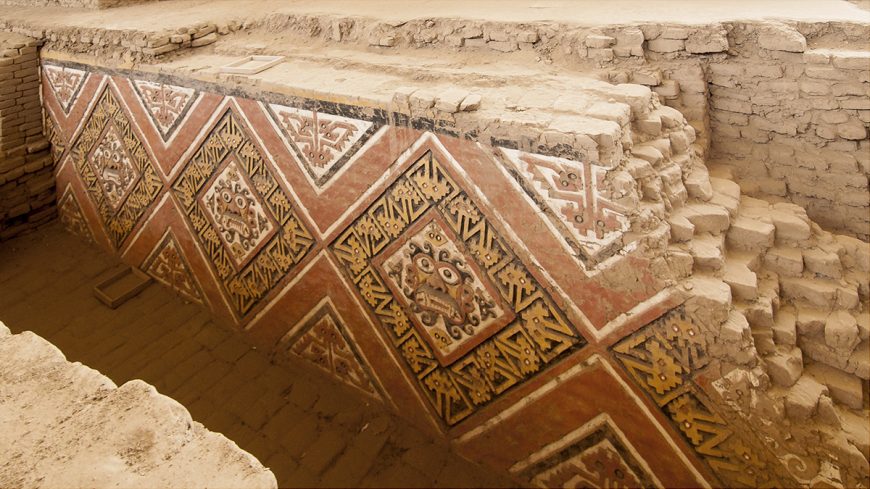
The best-known architecture in the Andes is that of the Inka. The Inka used stone for all of their important structures, and developed a technique that helped protect the structures from earthquakes. Because of its stone construction, Inka architecture has survived more easily than the adobe architecture of the coast. Ongoing efforts by archaeologists and the Peruvian Ministry of Culture are also focused on restoring and preserving the great works of coastal architecture.

Ancient past, continuing traditions
From textiles to ceramics, metalwork, and architecture, Andean cultures produced art and architecture that responded to their natural environment and reflected their beliefs and social structures. We can learn much about these ancient traditions through the artifacts and sites that survive, as well as the many ways that these practices—such as weaving—persist today.
Additional resources:
Dualism in Andean Art from The Metropolitan Museum of Art’s Timeline of Art History
Chavin (UNESCO World Heritage Site)
Project page for the Huaca de la Luna restoration by the World Monuments Fund
Introduction to Ancient Andean Art
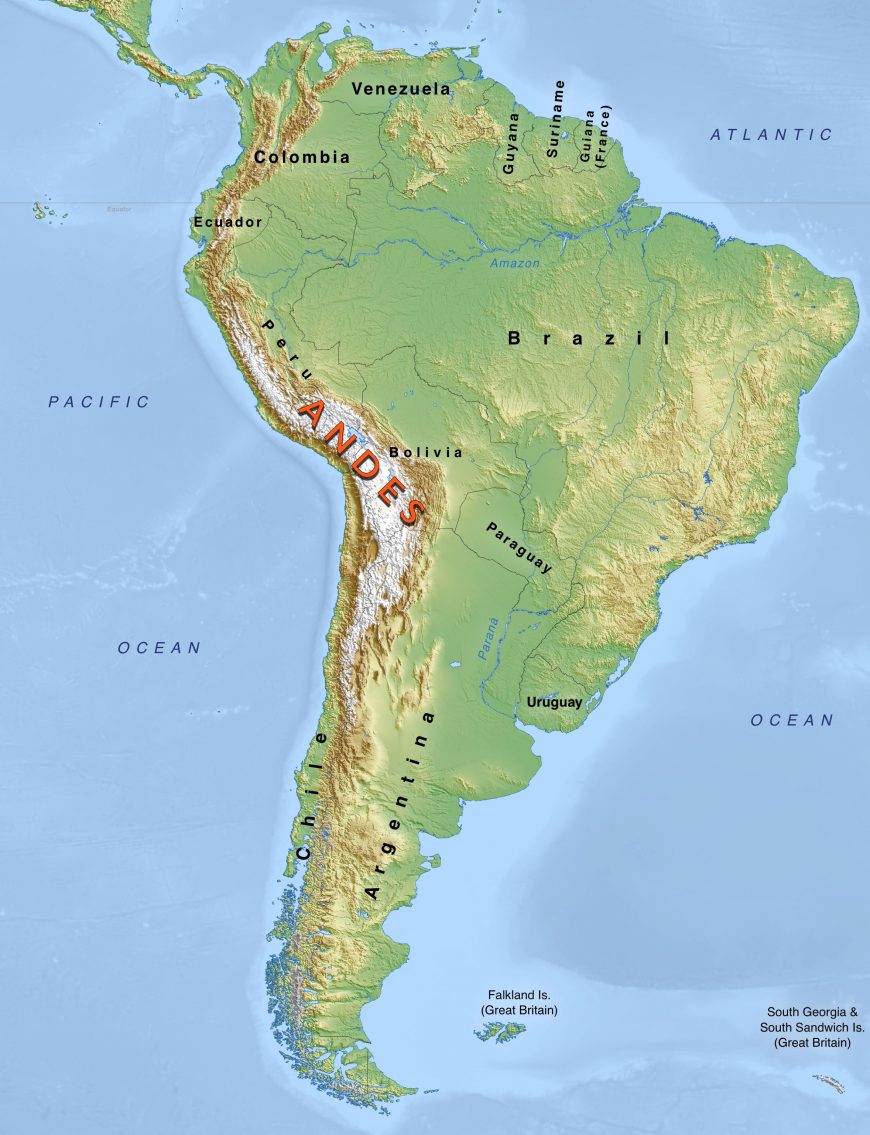
Mountain highlands to arid coastlines
The Andes region encompasses the expansive mountain chain that runs nearly 4,500 miles north to south, covering parts of modern-day Venezuela, Colombia, Ecuador, Peru, Bolivia, Chile, and Argentina. The pre-Columbian inhabitants of the Andes developed a stunning visual tradition that lasted over 10,000 years before the Spanish invasion of South America in 1532.
One of the most ecologically diverse places in the world, the Andes mountains give way to arid coastlines, fertile mountain valleys, frozen highland peaks that reach as high as 22,000 feet above sea level, and tropical rainforests. These disparate geographical and ecological regions were unified by complex trade networks grounded in reciprocity.
The Andes was home to thousands of cultural groups that spoke different languages and dialects, and who ranged from nomadic hunter-gatherers to sedentary farmers. As such, the artistic traditions of the Andes are highly varied.
Pre-Columbian architects of the dry coastal regions built cities out of adobe, while highland peoples excelled in stone carving to produce architectural complexes that emulated the surrounding mountainous landscape.
Artists crafted objects of both aesthetic and utilitarian purposes from ceramic, stone, wood, bone, gourds, feathers, and cloth. Pre-Columbian Andean peoples developed a broad stylistic vocabulary that rivaled that of other ancient civilizations in both diversity and scope. From the breathtaking naturalism of Moche anthropomorphic ceramics to the geometric abstraction found in Inka textiles, Andean art was anything but static or homogeneous.
Characteristics
While Andean art is perhaps most notable for its diversity, it also possesses many unifying characteristics. Andean artists across the South American continent often endowed their works with a life force or sense of divinity. This translated into a process-oriented artistic practice that privileged an object’s inner substance over its appearance.
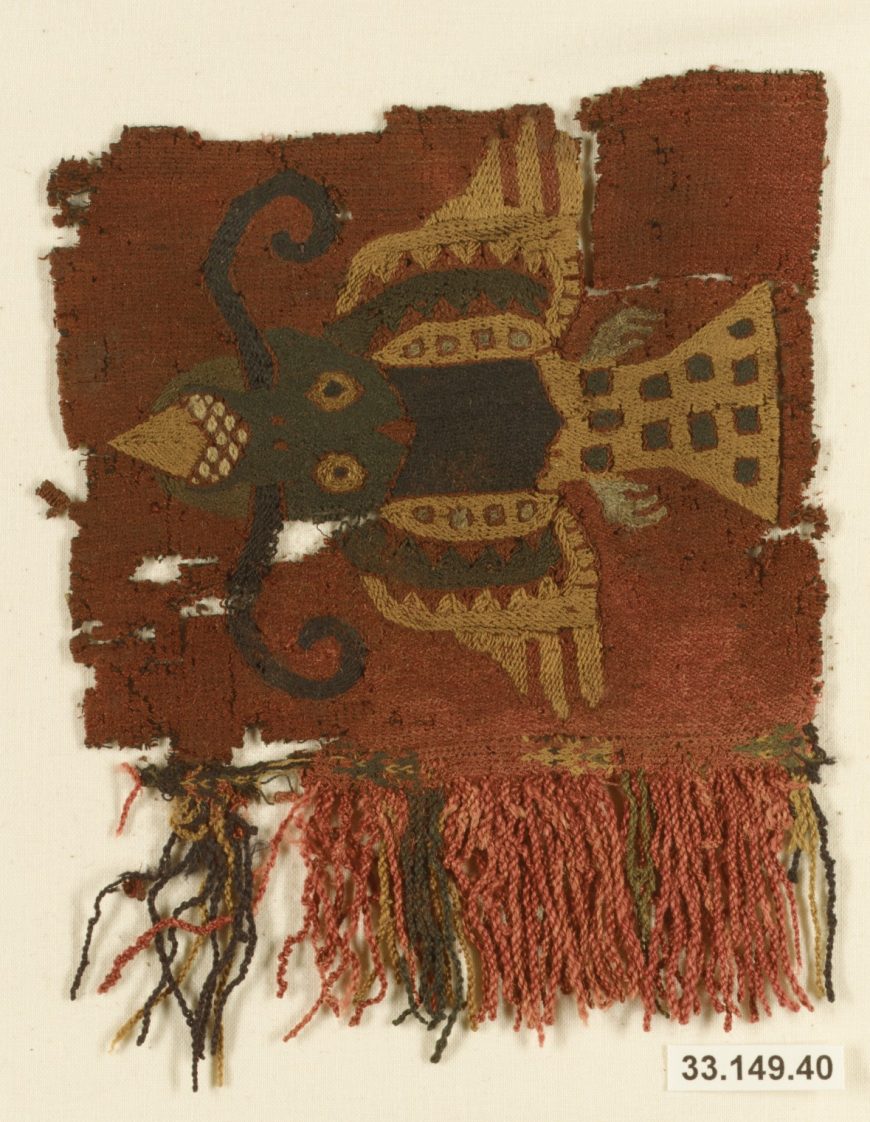
Andean art is also characterized by its environmental specificity; pre-Columbian art and architecture was intimately tied to the natural environment. Textiles produced by the Paracas culture, for instance, contained vivid depictions of local birds that could be found throughout the desert peninsula.
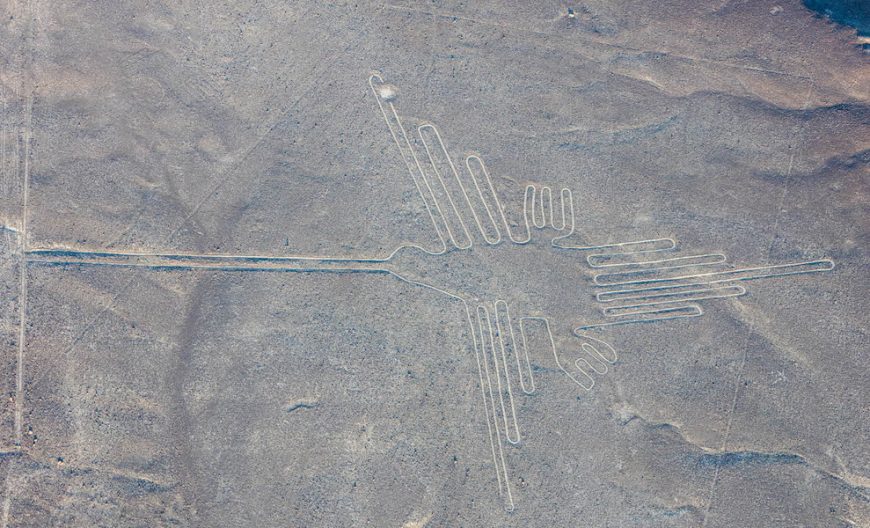
The nearby Nazca culture is best known for its monumental earthworks in the shape of various aquatic and terrestrial animals that may have served as pilgrimage routes. The Inkas, on the other hand, produced windowed monuments whose vistas highlighted elements of the adjacent sacred landscape. Andean artists referenced, invoked, imitated, and highlighted the natural environment, using materials acquired both locally and through long-distance trade. Andean objects, images, and monuments also commanded human interaction.
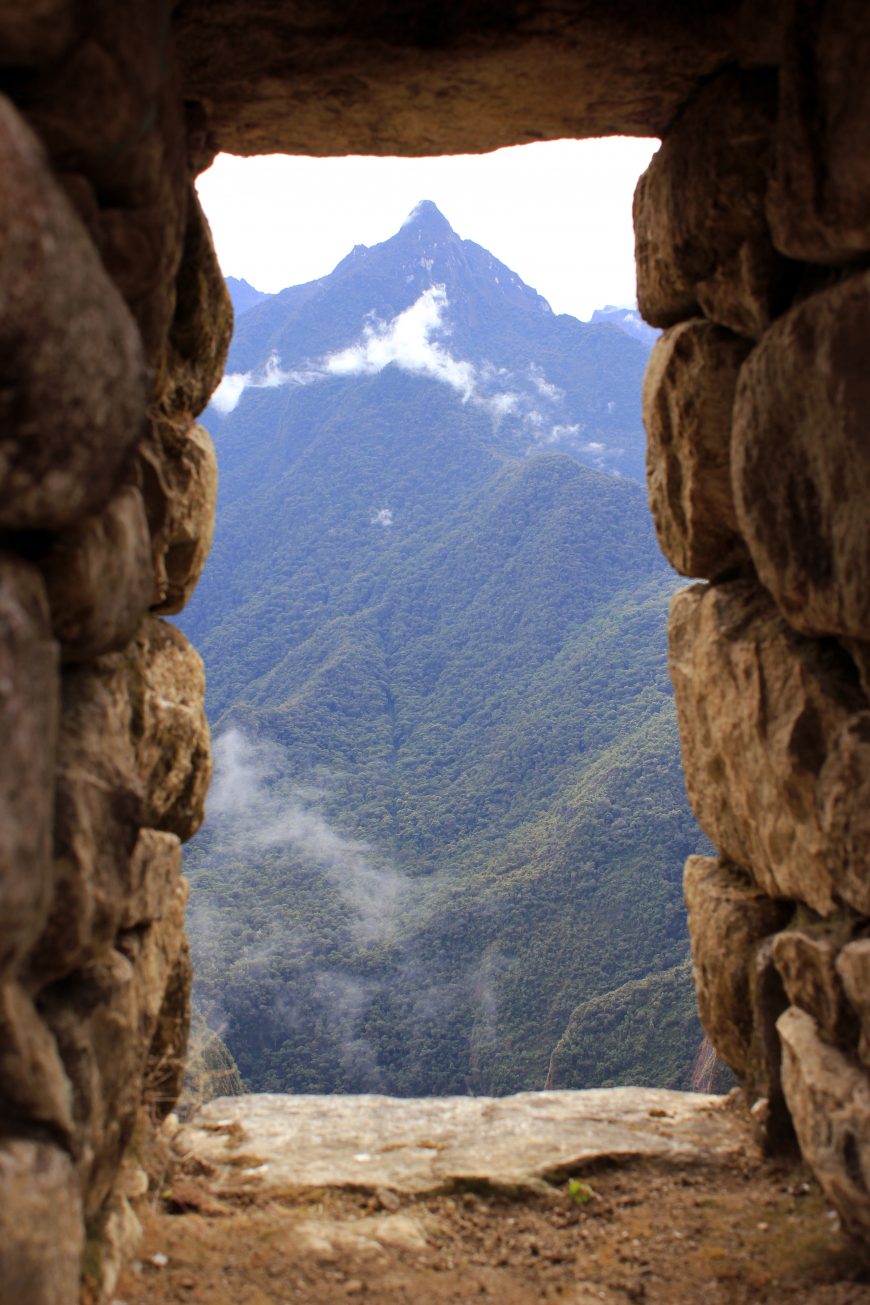
Worn, touched, held, maneuvered, or ritually burned
Pre-Columbian Andean art was meant to be touched, worn, held, maneuvered, or ritually burned. Elaborately decorated ceramic pots would have been used for storing food and drink for the living or as grave goods to accompany the deceased into the afterlife. Textiles painstakingly embroidered or woven with intricate designs would have been worn by the living, wrapped around mummies, or burned as sacrifices to the gods. Decorative objects made from copper, silver, or gold adorned the bodies of rulers and elites. In other words, Andean art often possessed both an aesthetic and a functional component — the concept of “art for art’s sake” had little applicability in the pre-Columbian Andes. This is not to imply that art was not appreciated for its beauty, but rather that the process of experiencing art went beyond merely viewing it.
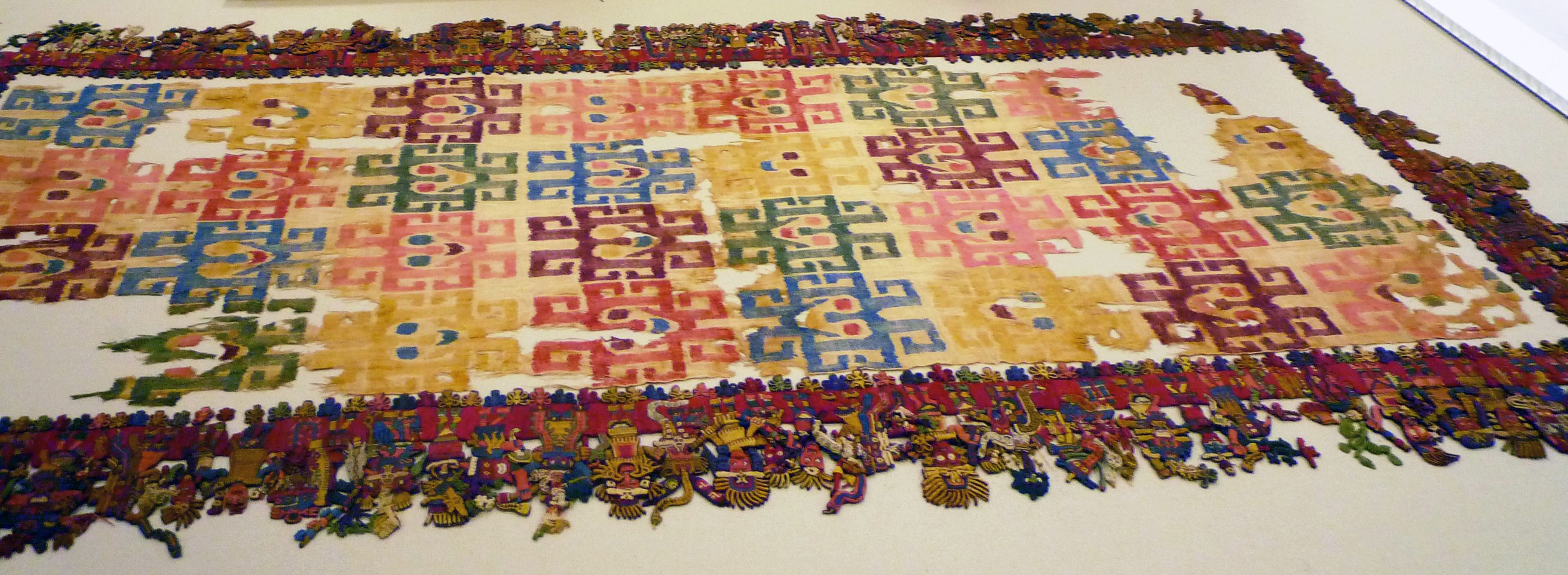
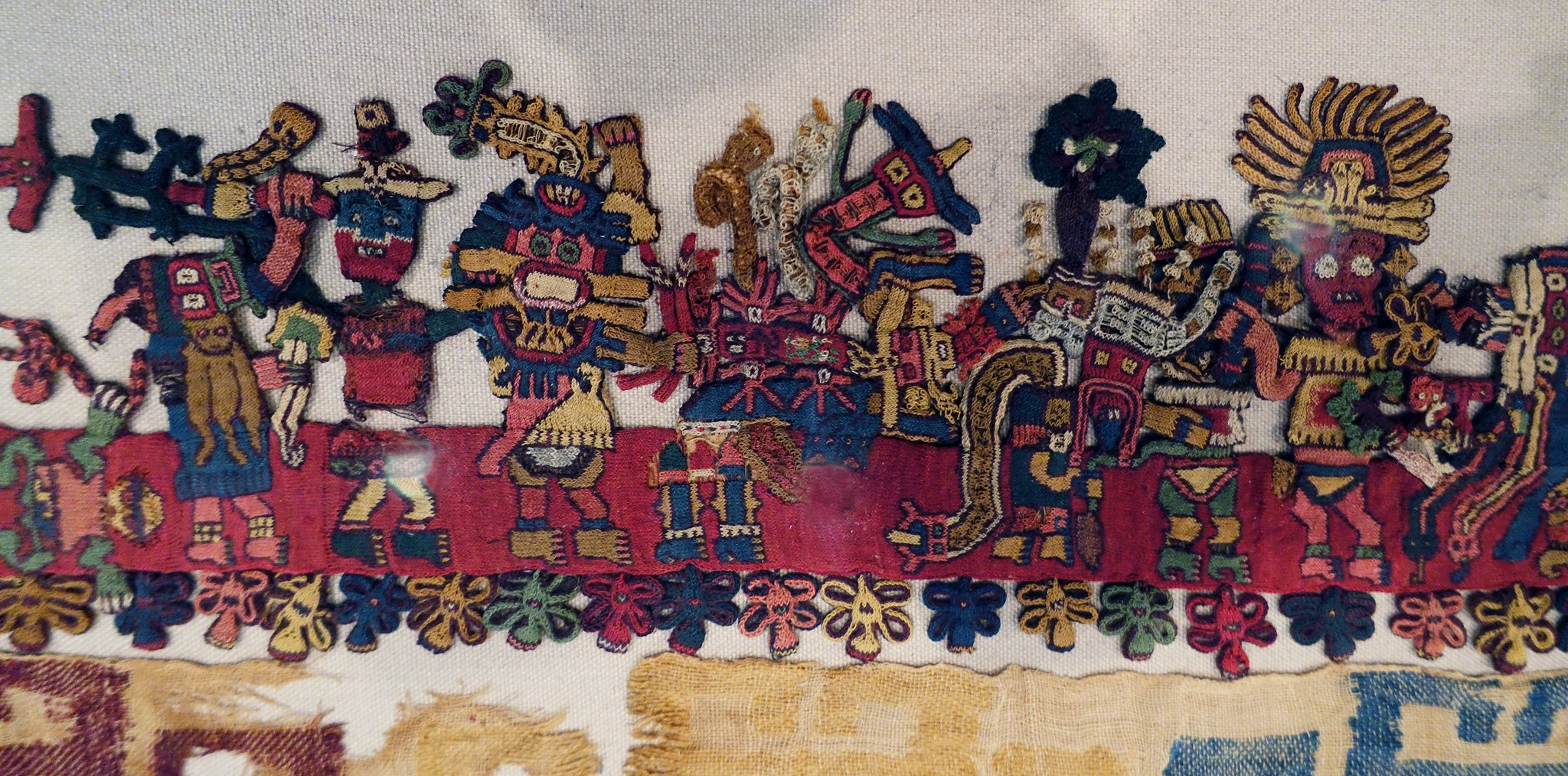
The supernatural
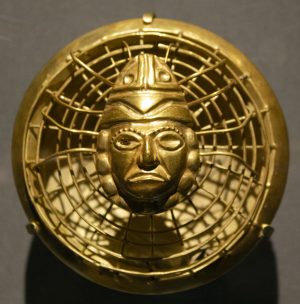
At the same time that Andean art commanded human interaction, it also resonated with the supernatural realm. Some works were never seen or used by the living. Mortuary art, for instance, was essentially created only to be buried in the ground.
The magnificent ceramics and metalwork found at the grave of the Lord of Sipán on Peru’s north coast required a tremendous output of labor, yet were never intended for living beings. The notion of “hidden” art was a convention found throughout the pre-Columbian world. In Mesoamerica, for instance, burying objects in ritual caches to venerate the earth gods was practiced from the Olmec to the Aztec civilizations.
Works of art associated with particular rituals, on the other hand, were often burned or broken in order to “release” the object’s spiritual essence. Earthworks and architectural complexes best viewed from high above would have only been “seen” from the privileged vantage point of supernatural beings. Indeed, it is only with the advent of modern technology such as aerial photography and Google Earth that we are able to view earthworks such as the Nazca lines from a “supernatural” perspective.
Art was often conceived within a dualistic context, produced for both human and divine audiences. The pre-Columbian Andean artistic traditions covered here comprise only a sampling of South America’s rich visual heritage. Nevertheless, it will provide readers with a broad understanding of the major cultures, monuments, and artworks of the Andes as well as the principal themes and critical issues associated with them.
Additional resources:
Dualism in Andean Art on The Metropolitan Museum of Art’s Heilbrunn Timeline of Art History
Music in the Ancient Andes on The Metropolitan Museum of Art’s Heilbrunn Timeline of Art History
Birds of the Andes on The Metropolitan Museum of Art’s Heilbrunn Timeline of Art History
Elizabeth Hill Boone, ed., Andean Art at Dumbarton Oaks (Dumbarton Oaks Research Library and Collection, 1996)
Sarahh Scher and Billie J. A. Follensbee, eds., Dressing the Part: Power, Dress, Gender, and Representation in the Pre-Columbian Americas (University Press of Florida, 2017)
Rebecca Stone. Art of the Andes: from Chavín to Inca (Thames & Hudson 2012)
Cupisnique
Feline-Head Bottle
Video \(\PageIndex{1}\): Feline-Head Bottle, 15th-5th century B.C.E., Cupisnique, Jequetepeque Valley (possibly Tembladera), Peru, ceramic and post-fired paint, 32.4 x 20.5 x 13.3 cm (The Metropolitan Museum of Art)
Speakers: Dr. Sarahh Scher and Dr. Steven Zucker
Smarthistory images for teaching and learning:


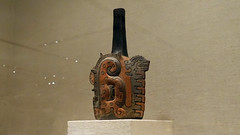

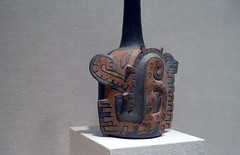


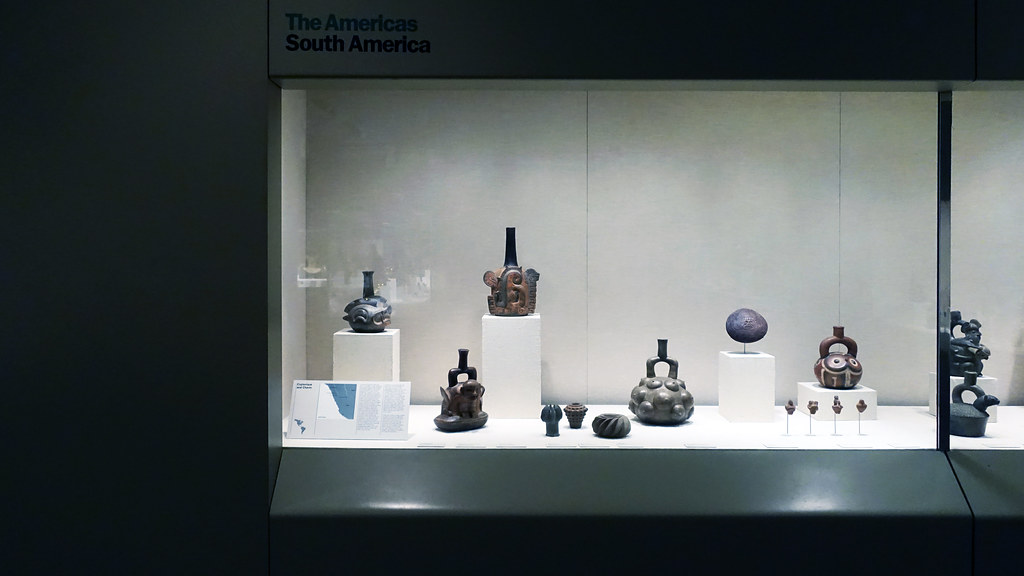
Chavín culture
Chavín de Huántar


Chavín de Huántar is an archaeological and cultural site in the Andean highlands of Peru. Once thought to be the birthplace of an ancient “mother culture,” the modern understanding is more nuanced. The cultural expressions found at Chavín most likely did not originate in that place, but can be seen as coming into their full force there. The visual legacy of Chavín would persist long after the site’s decline in approximately 200 B.C.E., with motifs and stylistic elements traveling to the southern highlands and to the coast. The location of Chavín seems to have helped make it a special place—the temple built there became an important pilgrimage site that drew people and their offerings from far and wide.
At 10,330 feet (3150 meters) in elevation, it sits between the eastern (Cordillera Negra—snowless) and western (Cordillera Blanca—snowy) ranges of the Andes, near two of the few mountain passes that allow passage between the desert coast to the west and the Amazon jungle to the east. It is also located near the confluence of the Huachesca and Mosna Rivers, a natural phenomenon of two joining into one that may have been seen as a spiritually powerful phenomenon.
Over the course of 700 years, the site drew many worshipers to its temple who helped in spreading the artistic style of Chavín throughout highland and coastal Peru by transporting ceramics, textiles, and other portable objects back to their homes.

The temple complex that stands today is comprised of two building phases: the U-shaped Old Temple, built around 900 B.C.E., and the New Temple (built approximately 500 B.C.E.), which expanded the Old Temple and added a rectangular sunken court. The majority of the structures used roughly-shaped stones in many sizes to compose walls and floors. Finer smoothed stone was used for carved elements. From its first construction, the interior of the temple was riddled with a multitude of tunnels, called galleries. While some of the maze-like galleries are connected with each other, some are separate. The galleries all existed in darkness—there are no windows in them, although there are many smaller tunnels that allow for air to pass throughout the structure. Archaeologists are still studying the meaning and use of these galleries and vents, but exciting new explorations are examining the acoustics of these structures, and how they may have projected sounds from inside the temple to pilgrims in the plazas outside. It is possible that the whole building spoke with the voice of its god.

The god for whom the temple was constructed was represented in the Lanzón (left), a notched wedge-shaped stone over 15 feet tall, carved with the image of a supernatural being, and located deep within the Old Temple, intersecting several galleries.
Lanzón means “great spear” in Spanish, in reference to the stone’s shape, but a better comparison would be the shape of the digging stick used in traditional highland agriculture. That shape would seem to indicate that the deity’s power was ensuring successful planting and harvest.
The Lanzón depicts a standing figure with large round eyes looking upward. Its mouth is also large, with bared teeth and protruding fangs. The figure’s left hand rests pointing down, while the right is raised upward, encompassing the heavens and the earth. Both hands have long, talon-like fingernails. A carved channel runs from the top of the Lanzón to the figure’s forehead, perhaps to receive liquid offerings poured from one of the intersecting galleries.


Two key elements characterize the Lanzón deity: it is a mixture of human and animal features, and the representation favors a complex and visually confusing style. The fangs and talons most likely indicate associations with the jaguar and the caiman—apex predators from the jungle lowlands that are seen elsewhere in Chavín art and in Andean iconography. The eyebrows and hair of the figure have been rendered as snakes, making them read as both bodily features and animals.
Further visual complexities emerge in the animal heads that decorate the bottom of the figure’s tunic, where two heads share a single fanged mouth. This technique, where two images share parts or outlines, is called contour rivalry, and in Chavín art it creates a visually complex style that is deliberately confusing, creating a barrier between believers who can see its true form and those outside the cult who cannot. While the Lanzón itself was hidden deep in the temple and probably only seen by priests, the same iconography and contour rivalry was used in Chavín art on the outside of the temple and in portable wares that have been found throughout Peru

The serpent motif seen in the Lanzón is also visible in a nose ornament in the collection of the Cleveland Museum of Art (above). This kind of nose ornament, which pinches or passes through the septum, is a common form in the Andes. The two serpent heads flank right and left, with the same upward-looking eyes as the Lanzón. The swirling forms beneath them also evoke the sculpture’s eye shape. An ornament like this would have been worn by an elite person to show not only their wealth and power but their allegiance to the Chavín religion. Metallurgy in the Americas first developed in South America before traveling north, and objects such as this that combine wealth and religion are among the earliest known examples. This particular piece was formed by hammering and cutting the gold, but Andean artists would develop other forming techniques over time.
Video \(\PageIndex{2}\)
Additional resources:
Chavín de Huántar Archaeological Acoustics Project
Chavin (UNESCO World Heritage Site)
Nose Ornament at the Cleveland Museum of Art
Richard L. Burger, Chavín and the Origins of Andean Civilization, London: Thames and Hudson, 1992.
RL Burger, “The Sacred Center of Chavín de Huántar” in The Ancient Americas: Art from Sacred Landscapes , ed. by RF Townsend (The Art Institute of Chicago, 1992), pp. 265-77.
Complexity and vision: the Staff God at Chavín de Huántar and beyond
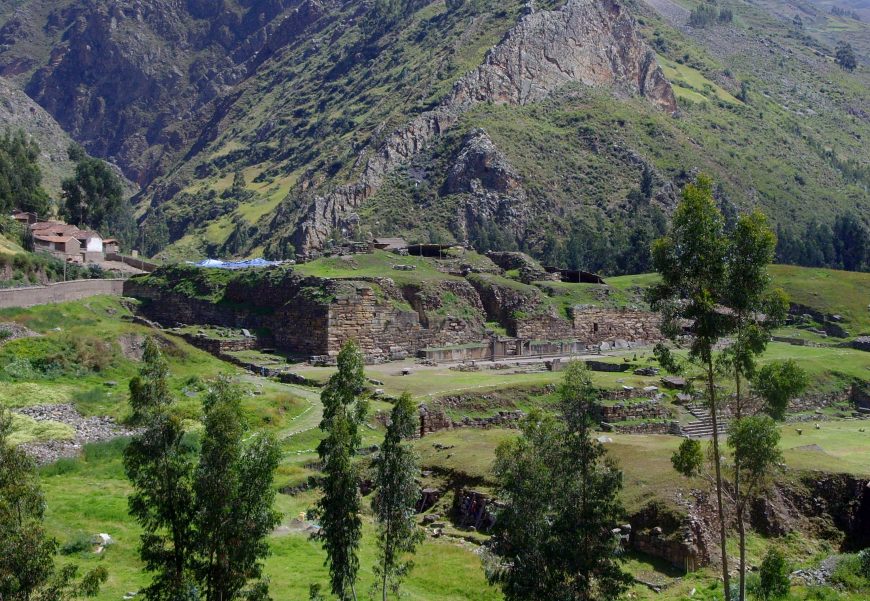
Art for the initiated
The artistic style seen in stone sculpture and architectural decoration at the temple site of Chavín de Huántar, in the Andean highlands of Peru, is deliberately complex, confusing, and esoteric. It is a way of depicting not only the spiritual beliefs of the religious cult at Chavín, but of keeping outsiders “out” while letting believers “in.” Only those with a spiritual understanding would be able to decipher the artwork.
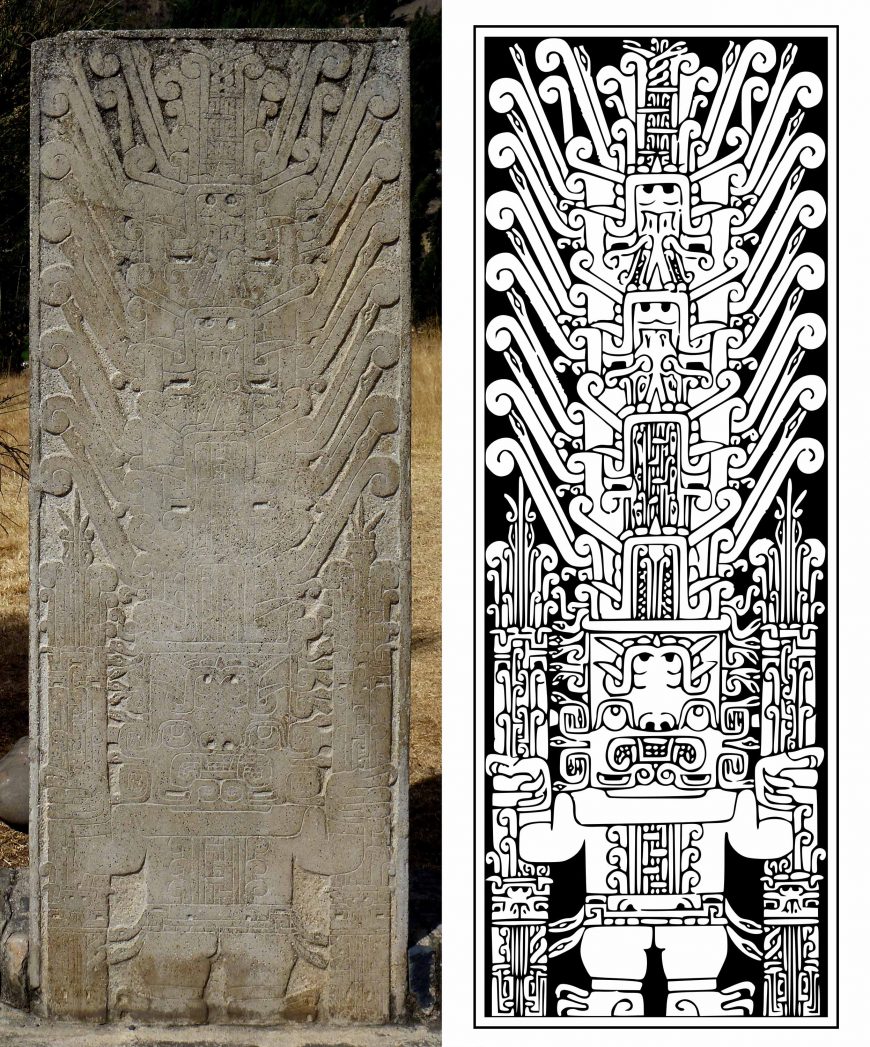
The Raimondi Stele from Chavín de Huántar is an important object because it is so highly detailed and shows Chavín style at its most complex. It is easiest to see in a drawing, because the original sculpture is executed by cutting shallow but steep lines into the highly-polished stone surface, making it very difficult to make out the incised image. This style is deliberately challenging to understand, thereby communicating the mystery of the Staff God, and creating a difference between those initiated in the religion who can understand the imagery, and outsiders who cannot.
Powerful animals
The stele (see video directly below) shows the god holding staffs composed of numerous curling forms. Beneath the god’s hands we see upside-down and sideways faces, and the staffs terminate at the top in two snake heads with protruding tongues. The god’s belt is a compressed, abstracted face with two snakes extending from where the ears should be, perhaps substituting the snakes for hair, and turning the face with its snake-hair into a belt. The god’s hands and feet have talons rather than human fingernails, evoking felines and birds of prey.
Video \(\PageIndex{3}\)
These are references to animals that would have been exotic rumors to the people of highland Chavín: the jaguar, the harpy eagle, and the anaconda are all animals that dwell in the lush tropical jungle over the Andes mountains to the east. They are all apex predators, possessing physical qualities like strength, flight, and stealth that become metaphors for the power of the Staff God. Other supernatural imagery from Chavín includes images of caimans, crocodile-like animals that also inhabit the eastern jungles. Most people would never have seen these creatures, rendering them mythical in their own right, and suitable for depicting the mysterious nature of the god.
Multiple faces
The god’s face is actually composed of multiple faces (see video directly below). The eyes in the center looking upward are above a downturned mouth sporting feline fangs, but beneath that we can see another upside-down pair of eyes and a nose that use the same mouth. This is an artistic technique known as contour rivalry, where parts of an image can be visually interpreted in multiple ways. A similar thing is taking place on the god’s “forehead,” where we see another upside-down mouth with four large fangs protruding from it, which when associated with the eyes in the middle completes a full face. Above this multi-faced head is what appears to be an enormous headdress, which is composed of more faces that also multiply using contour rivalry, and have extensions emanating from them that terminate in curls and snake heads.
Video \(\PageIndex{4}\)
An intricate style
This intricate and confusing style was not just used for large monuments at Chavín. Smaller carved, decorative elements of the site’s architecture also display these kinds of supernatural figures. The two stone slabs seen below are examples of the kinds of sculptures found in cornices and other architectural elements at Chavín.
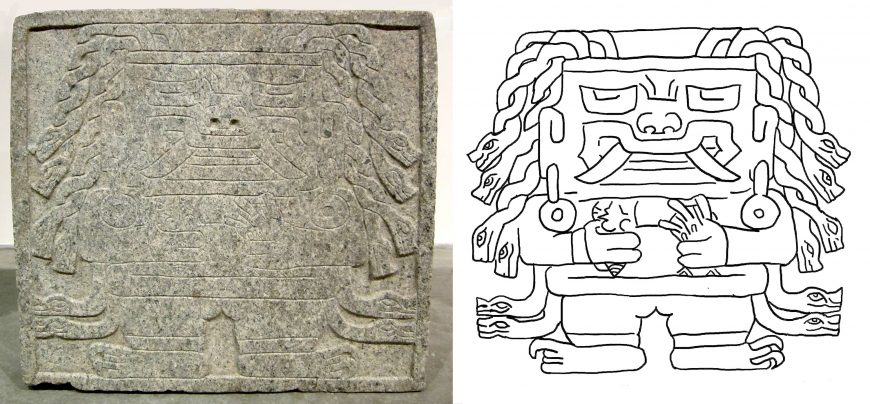
One of these depicts a standing figure with snakes for hair. It sports the same protruding fangs we see in the upside-down heads above the Staff God’s face. Large pendant earrings rest on its shoulders, and in its hands it holds two shells: a Strombus in its right hand and a Spondylus in its left. Spondylus shells are not native to Peru; they thrive in the warm coastal waters of what is now Ecuador, hundreds of kilometers from Chavín. Early on in the history of the Andes, there was a brisk trade in these shells as luxury items.
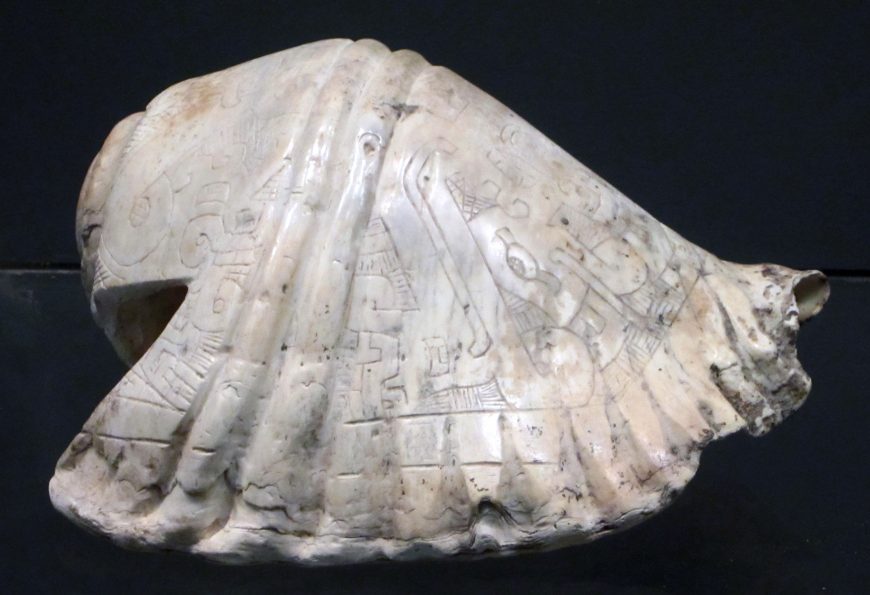
Strombus can be found in Peruvian waters, but that is the southernmost reach of their range—they are more common in the north. A great number of carved Strombus shells turned into trumpets (called pututu) have been found at Chavín. Far from the ocean, these shells symbolized water and fertility. Furthermore, the Strombus is frequently associated with masculinity, while the Spondylus has feminine associations. The two together therefore signaled generative fertility and the power of the cult to foster agricultural prosperity.
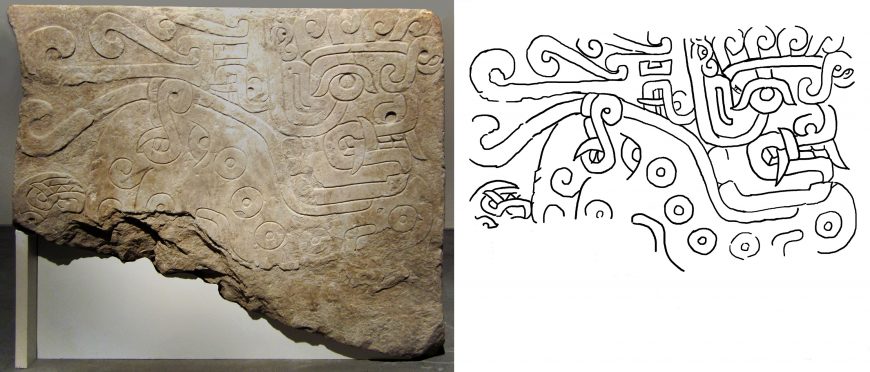
A second carved figure is more enigmatic, and is full of contour rivalry. The main figure appears to be composed of the head to the right, attached to a body with round spots, probably alluding to a jaguar. However, behind the head is another eye, nose, and fanged mouth, and the jaguar spots are joined by an eye with a profile mouth with fangs. Thus, what appears to be one creature at first glance may be as many as three. At the bottom left, we can see another fanged mouth, this one upside-down, but because the stone is broken, we’ve lost its context.
The spread of the Staff God
The image of the Staff God would spread throughout Peru. The imagery’s geographic reach gives us some insight into the contact between distant areas and the diffusion of imagery. Once thought to show the expansion of the cult of Chavín, today scholars are more hesitant to draw direct relationships between Chavín influence and these far-flung images. The Staff God may have had its roots in earlier cultural styles, including the one known as Cupisnique, making Chavín just one of many expressions of this deity. The Staff God’s imagery traveled extensively, far beyond the areas already mentioned.
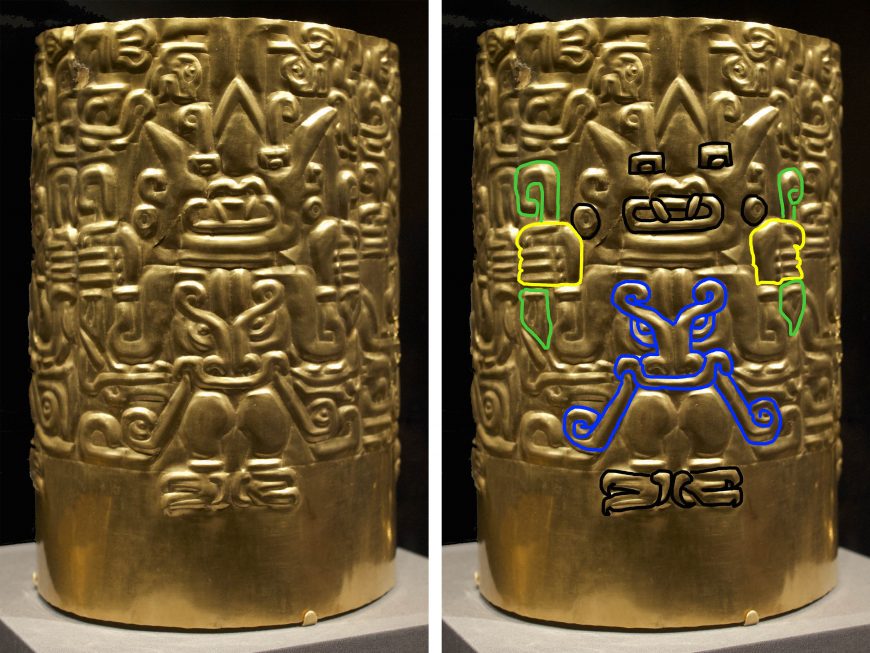
A Cupisnique gold crown from Chongoyape, Peru, also demonstrates the Staff God’s reach. The crown depicts a version of the god that is simpler than that seen in the Raimondi Stele, but it still uses contour rivalry and the trademark fanged mouths.
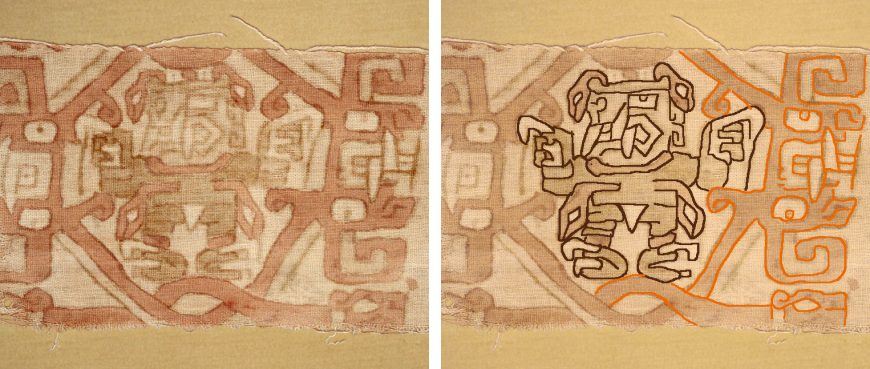
A painted textile fragment with the Staff God is thought to be from the southern Peruvian coast, hundreds of kilometers from Chavín (which is in the highlands). It is woven from cotton, which is a coastal agricultural product, and distinct from the camelid wool that came from the highlands. The Staff God here is shown with the head in profile, and with snakes emerging from the top of the head, with a feline-fanged mouth, snake belt, and taloned hands and feet. The figure is enclosed in a knot-like shape, composed of supernatural figures that blend snake and feline attributes. Other southern coastal textiles with Staff God imagery have been found, including some that render the Staff God as explicitly female, showing how this religious imagery transformed as it traveled.
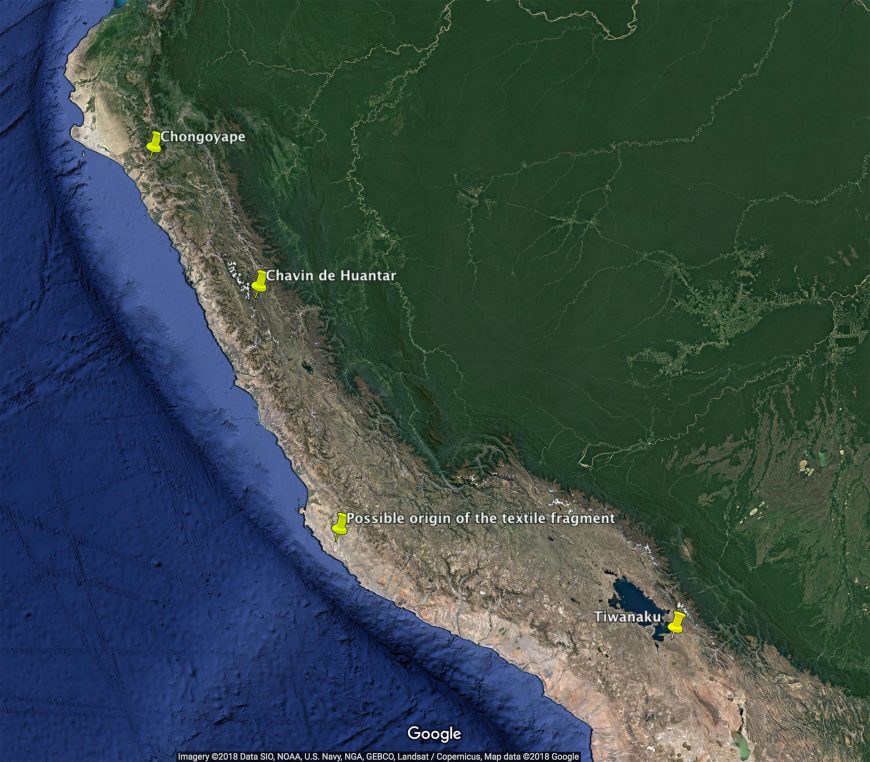
Traveling in time
The image of a divine figure holding staffs or similar objects in its hands would persist in Andean art long past the time of Chavín. The so-called “Sun Gate” at the site of Tiwanaku, near lake Titicaca in modern-day Bolivia, is 748 miles (about 1200 km) from Chavín. It dates from around 800–1000 C.E., and so is separated by at least a thousand years from the Raimondi Stele. However, like the Stele, it features an abstracted and intricate style that separates believers from outsiders.
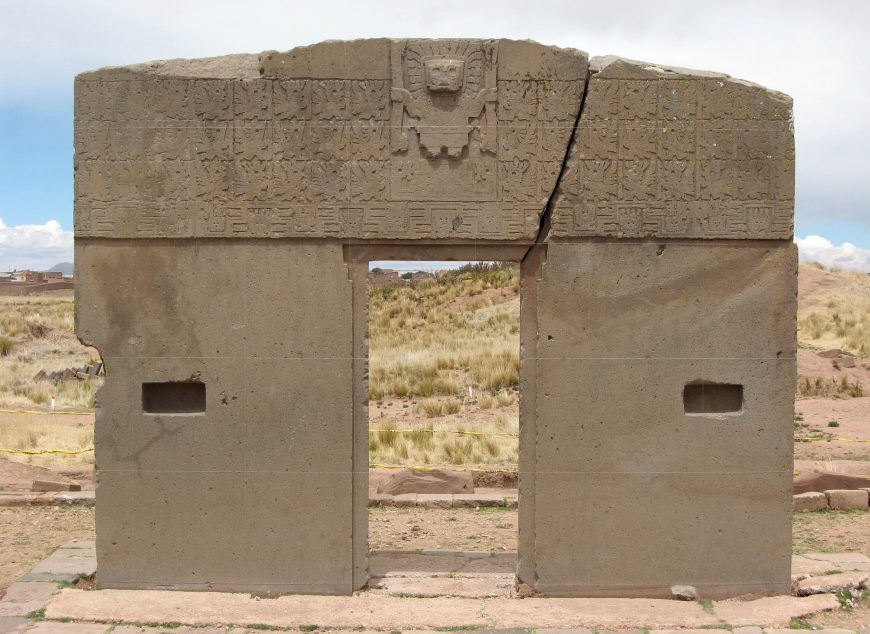
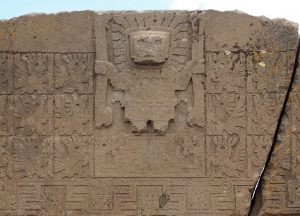
Tiwanaku style is more angular than Chavín, and the Sun Gate has a strong gridded organization that adds to the geometric feel. The central figure of the Sun Gate, while sharing the frontality of the Staff God and the familiar pose (arms at the sides, elbows bent, and vertical objects in its grasp), is also different from earlier iterations. The head is disproportionately large, rendered in a higher relief than the rest of the figure, and features projecting shapes that may represent the rays of the sun. Some terminate in feline heads in profile, a change from the earlier serpents seen at Chavín, Chongoyape, and in the textile fragment. In its hands it holds projectiles and a spear-thrower—weapons rather than elaborate staffs.
The Sun Gate figure stands atop a stepped pyramid shape with serpentine figures emerging from it, a representation of the Akapana pyramid, which mirrored the nearby sacred mountain Illimani not only in shape but by having a series of internal and external channels that allowed rain water to cascade down the side of the structure like the above-and below-ground rivers of the mountain. Not only does it stand in the same pose as the Staff God; it, too, is associated with natural forces, like the mountain, the sun, and the waters of Illimani. The feline heads terminating the rays from the figure’s head are joined by the bird-human hybrid “attendant” figures in the rows to either side.
The meaning of the Staff God image was likely different in each of the places it has been found, an image of the sacred that came from afar and was adopted and adapted to the needs of the local people. In each case, however, we find that the intricate and often inscrutable imagery was a way of keeping believers separate from outsiders.
Additional resources:
Richard L. Burger, Chavin and the origins of Andean civilization (London: Thames and Hudson, 1995).
Julia T. Burtenshaw-Zumstein, Cupisnique, Tembladera, Chongoyape, Chavín? A Typology of Ceramic Styles from Formative Period Northern Peru, 1800-200 BC, doctoral dissertation, University of East Anglia, 2014.
Joanne Pillsbury, Timothy Potts, and Kim N. Richter, Golden Kingdoms: Luxury arts in the ancient Americas (Los Angeles: Getty Trust Publications, 2017).
Nasca
Nasca Art: Sacred Linearity and Bold Designs
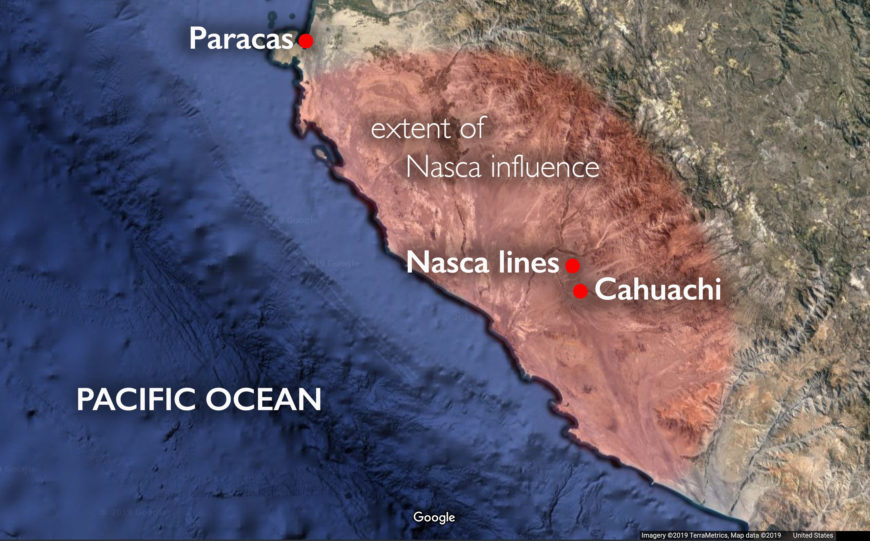
The Nasca (also spelled Nazca) civilization flourished from 100–800 C.E. in the Nasca Desert of Peru’s south coast, located about 200 miles south of Paracas. The Nasca lived in dispersed settlements along the Nasca River, and the site of Cahuachi served as their main ritual and pilgrimage center. The flat desert terrain proved to be a favorable canvas for Nasca artists, which they utilized to create artworks of unprecedented grandeur, size, and sophistication.
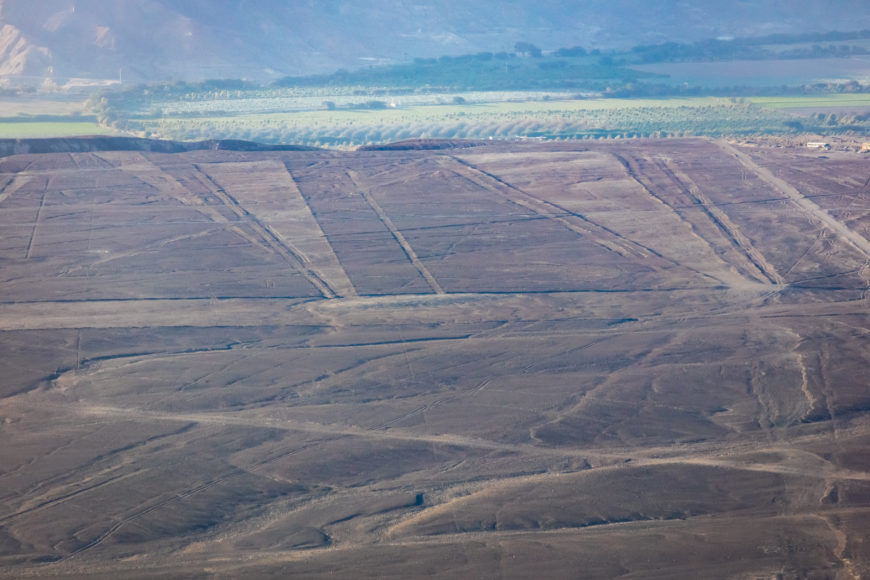
The Nasca Lines
The Nasca Lines are geoglyphs consisting of lines and representational images etched onto the desert floor. The lines cannot be viewed in their entirety from the ground, and are best seen either from the surrounding foothills or by plane. The Nasca Lines have garnered the attention of archaeologists, art historians, explorers, journalists, and artists, inspiring a slew of interpretations over the course of nearly a century.
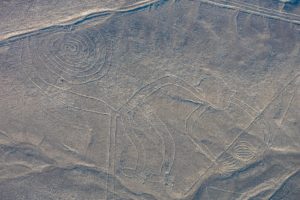
While scholars remain divided on the precise meaning of the lines, all can agree that they were not made by aliens, as the popular show Ancient Aliens would like people to believe. One of the most convincing interpretations put forth by archaeologist Anthony Aveni and his colleagues argues that the Nasca lines traced important underground water sources. The vast majority of the Nasca lines are just that—straight lines, which run parallel, converge, and intersect with one another. In an excessively dry desert climate that receives less than one inch of rainfall per year, access to fresh water would have been a central concern for ancient Nasca peoples.
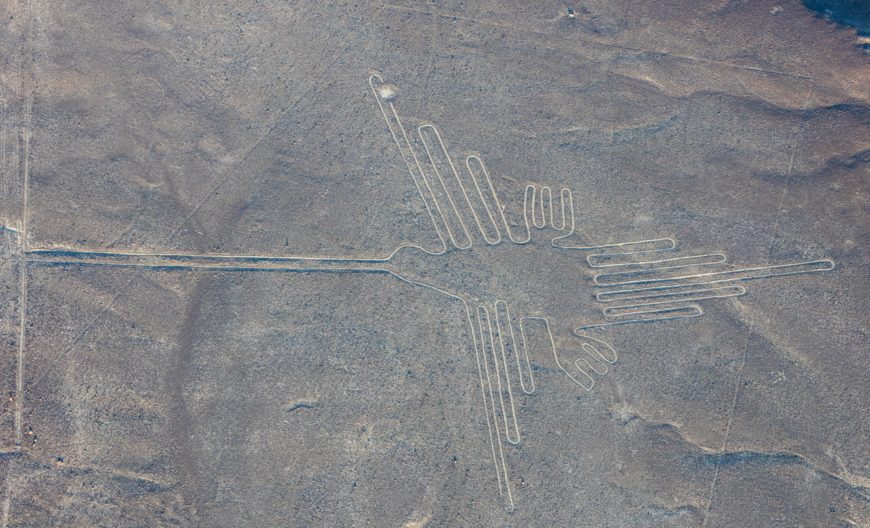
The Nasca landscape also contains a series of representational images of a monkey, whale, condor, spider, dog, heron, and others. One of the most iconic images is that of the Nasca Line Hummingbird, which features a stylized rendition of this miniscule bird, measuring over 300 feet long. The hummingbird is rendered in bird’s-eye view with outstretched wings, tail, and long characteristic beak that extends to another set of lines.
While the lines seem impossible to create without the use of modern technology, archaeologists discovered that the lines are indeed reproducible with a large labor force and a system of measurement that employs a set of strings or ropes of different lengths. One striking feature of all the figural Nasca lines is they are contour drawings—the lines never cross each other. If one traversed the lines of the hummingbird, for instance, he or she would return full circle to the starting point. This suggests that the animal figures could have each served as special pilgrimage routes. Indeed, the existence of pottery fragments and food remains along the lines indicate frequent human visitation.
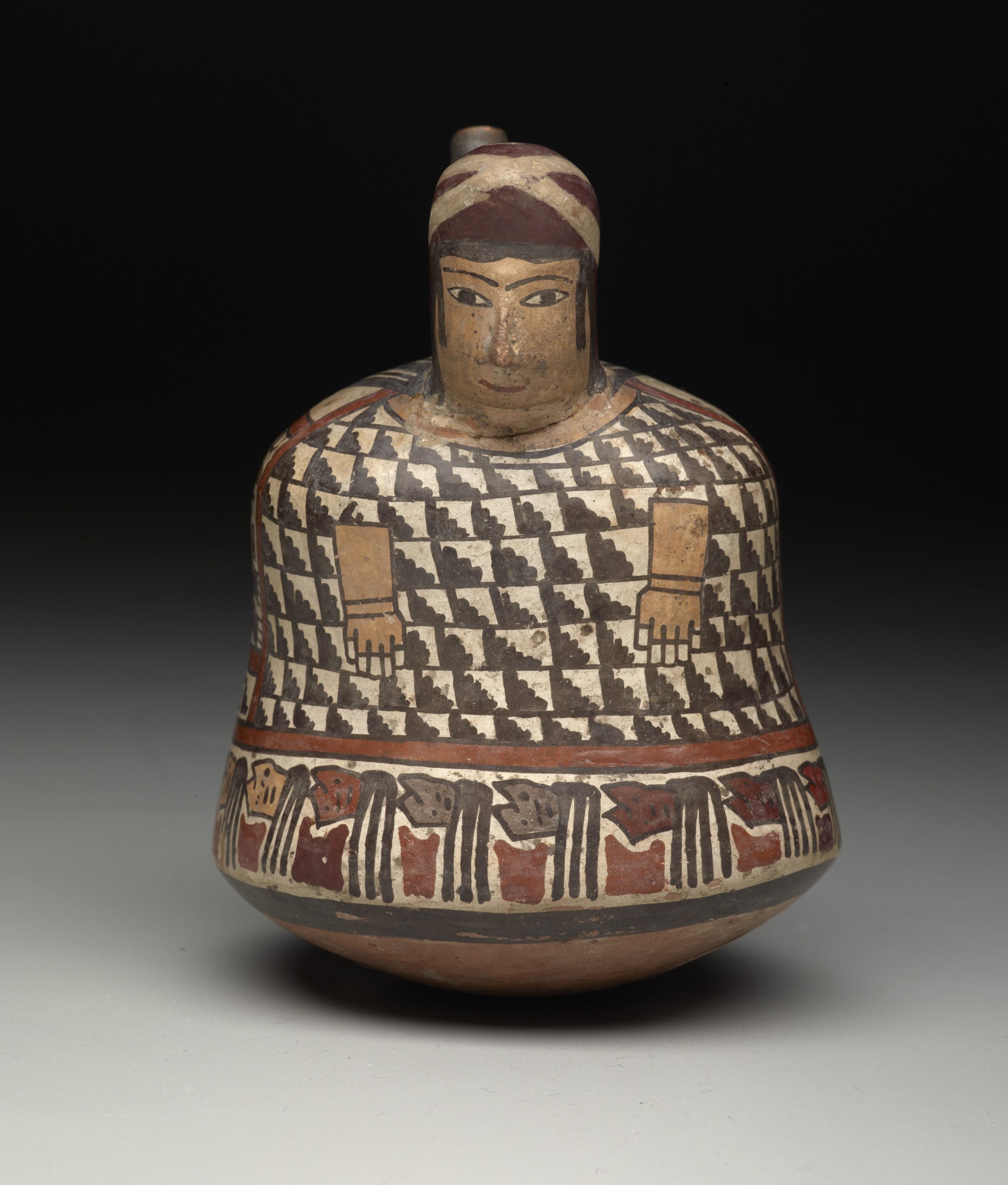
Nasca ceramics
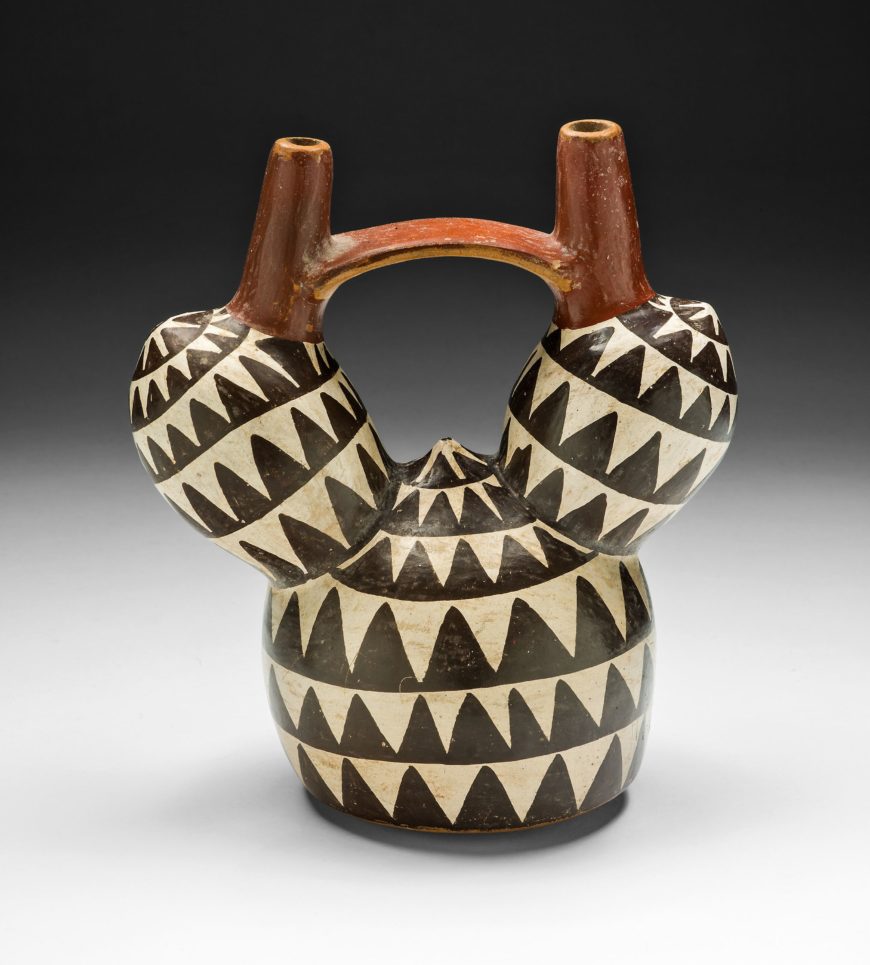
Nasca ceramic art also exhibits a strong interest in bold design. The Figure with Human Heads consists of a person gendered as male, either standing or seated, with his arms at his sides. His nose is modeled in three dimensions, but the rest of his facial features are painted, and his body is rendered as the general form of the vessel. He wears a headcloth over his hair, held in place with a criss-crossed band, and a tunic that features a design consisting of black and white stepped motifs arranged into repeating squares. Beneath this pattern is a border decorated in a repeating rhythm of highly abstracted heads seen in profile. The closed eyes and loose hair indicate that they are ritual heads, associated with fertility in Nasca art. (While sometimes referred to as “trophy heads,” archaeologists have found increasing evidence that heads were curated by the Nasca as part of ancestor veneration, and that they were usually not associated with warfare). The use of the monochromatic scheme in the man’s tunic intensifies the design’s visual impact, and is similar to the pattern seen in a vessel depicting an achira (a root vegetable).
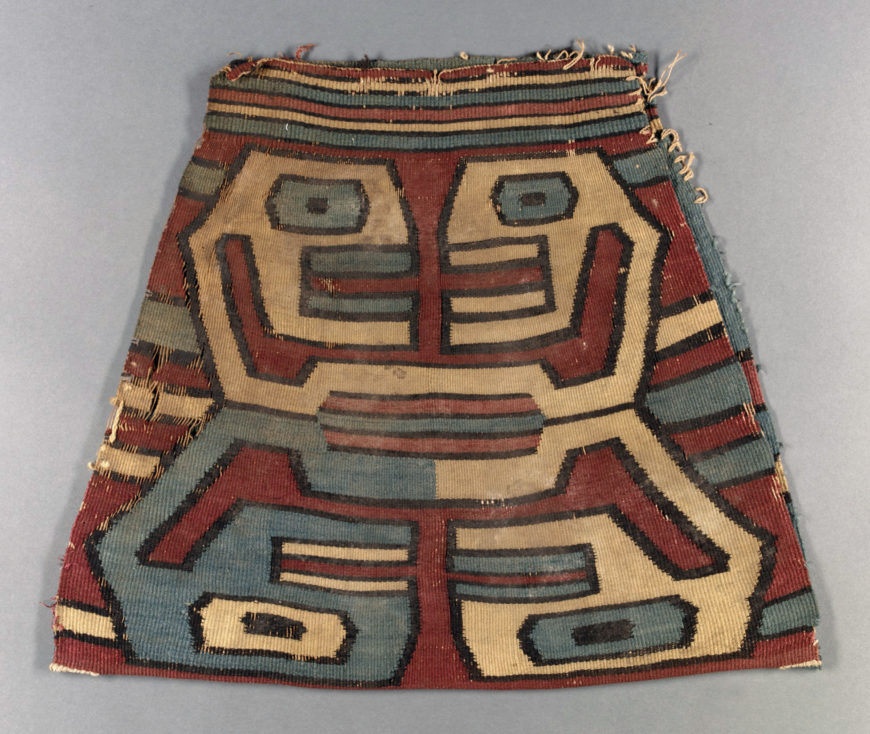
The Nasca were interested in issues of design and abstraction centuries before the rise of abstract art in the twentieth century. Nasca earthworks carved into the ground left an indelible mark on the coastal landscape, revealing a great deal about Nasca beliefs and aesthetic traditions. The Nasca introduced a stunning linearity to the arts of the pre-Columbian Andes, which carried through to other aspects of their artistic repertoire.
Additional resources
Rebecca R. Stone, Art of the Andes: From Chavín to Inca (London: Thames & Hudson 2012)
Super/Natural: Textiles of the Andes at the Art Institute of Chicago
Anthony Aveni, “Solving the Mystery of the Nasca Lines,” 53 no. 3 (May/June 2000)
Helaine Silverman, Cahuachi in the Ancient Nasca World (Iowa City: University of Iowa Press, 1993)
“Archaeologists Identify 143 New Nazca Lines,” Smithsonian Magazine
Nasca Geoglyphs

Located in the desert on the South Coast of Peru, the Nasca Geoglyphs are among the world’s largest drawings. Also referred to as the Nasca Lines, they are more accurately called geoglyphs, which are designs formed on the earth. Geoglyphs are usually constructed from strong natural material, such as stone, and are notably large in scale.
Imagine encountering such a drawing. The hummingbird measures over 300 feet in length, and is one of the most famous Nasca Geoglyphs. Among the other celebrated geoglyphs of mammals, birds and insects are a monkey, killer whale, spider, and condor. Various plants, geometric shapes (spirals, zigzag lines and trapezoids), abstract patterns, and intersecting lines fill the desert plain, known as the Pampa, an area covering approximately 200 square miles near the foothills of the Andes. The zoomorphic geoglyphs are the oldest and most esteemed. Each appears to have been made with a single continuous line.
Today it is believed that the geoglyphs were created by the Nasca people, whose culture flourished in Peru sometime between 1-700 C.E. They inhabited the river valleys of the Rio Grande de Nasca and the Ica Valley in the southern region of Peru, where they were able to farm, despite the desert environment—one of the driest regions in the world. The high Andes Mountains to the east prevent moisture from the Amazon from reaching the coast, so there is very little rainfall; water that does arrive, comes from mountain runoff.
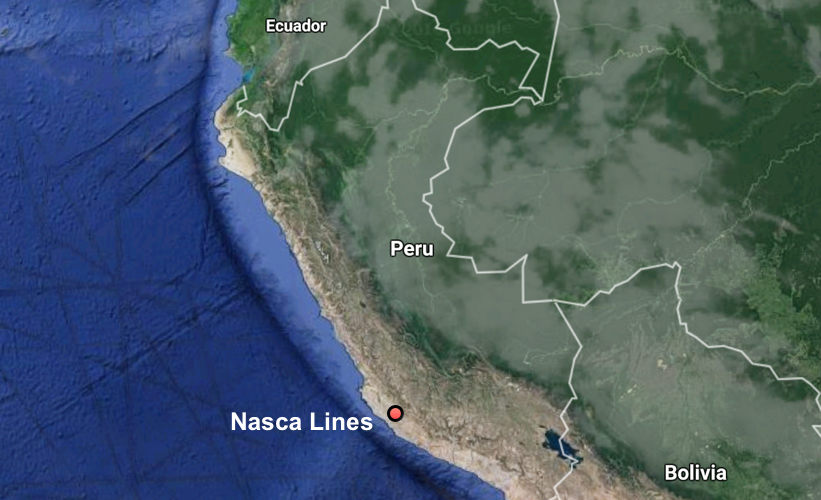
The Nasca people are also famous for their polychrome pottery, which shares some of the same subjects that appear in the Nasca Geoglyphs. Remains of Nasca pottery left as offerings have been found in and near the geoglyphs, cementing the connection between the geoglyphs and the Nasca people. Because the quality of the ceramics produced in Nasca is very high, archaeologists deduce that specialists shaped and painted the pottery vessels. This suggests a society that, at its height, had a degree of wealth and a division of labor. However, the Nasca people had no writing. In cultures without writing, images often assume an increased level of importance. This may help explain why the Nasca came together to create vast images on the desert floor.
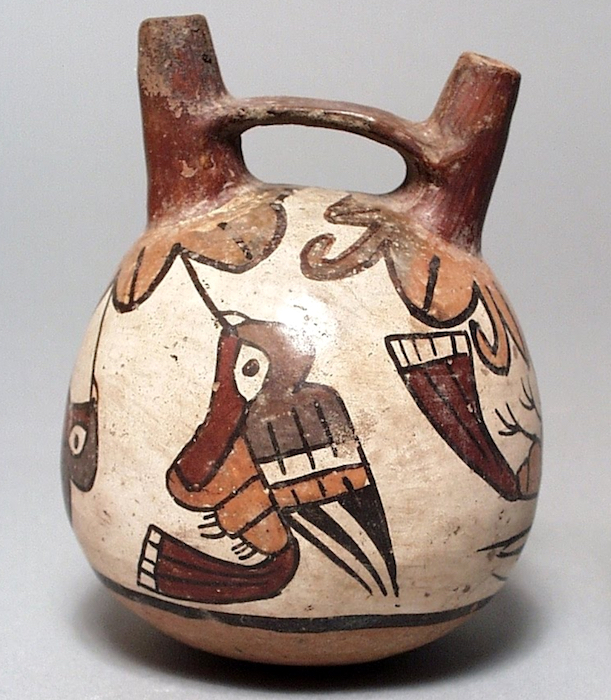
How were they made?
Since the Nasca geoglyphs are so large, it seems clear they were constructed by organized groups of people and that no single artist made them. The construction of the geoglyphs are thought to represent organized labor where a small group of individuals directed the design and creation of the lines, a process that may have strengthened the social unity of the community. Despite the impressive scale of the geoglyphs, these remarkable works did not require complex technology. Most geoglyphs were formed by removing weathered stones from the desert floor, stones that had developed a dark patina known as “desert varnish” on their surface. Once removed, the lighter stones below became visible, forming the famous Nasca Lines. The extracted darker stones were placed at the edges of the lines, forming a border that accented the lighter lines within. Straight lines could be created by extending cords, one on each side of the line, between two wooden stakes (some of which have been recovered) that guided workers and allowed for the creation of sight lines.
For larger geometric shapes, such as trapezoids, borders were marked and then all the stones on the interior were removed and placed along edges or heaped in piles at the edges of the geoglyph. Broken pottery has been found mixed with the piles of stones. Spirals and animal shapes were made in a similar manner. Spirals, for example, would be formed by releasing slack in a cord as workers moved around in a circular path, moving further and further from the center where the spiraling line begins. For animal forms, such as monkeys, whales, or hummingbirds, portions of the figures might be made in the same manner as the spiral in the monkey’s tail, or the image might be based on a gridded drawing or textile model that was enlarged on the desert floor where lines were staked out to create the figure.
When were they made?
The oldest of the Nasca Geoglyphs is more than 2000 years of old, but, as a group, the Nasca geoglyphs were created over several centuries, with some later lines or shapes intersecting or overlapping with previously created lines. This is just one of the unusual features of these geoglyphs. Even more curious, the drawings are best observed from the air, which is why they did not become widely known until the 1920s after the development of flight. Although it is possible to observe some of the lines from the adjacent Andean foothills or the modern mirador (viewing platform), the best way to see the lines today remains a flight in a small plane over the Pampa (lowlands). These amazing images are so large that they cannot be truly appreciated from the ground. This, of course, raises the question: for whom were the lines made? And, what was their purpose?

What was their purpose and meaning?
Archaeologists are not certain of the purpose of the lines, or even of the audience for whom the lines were intended since they can only be seen clearly from the air (This is now particularly true of the older animal designs). Were they made to be seen by deities looking down from the heavens or from distant mountain tops? Perhaps the numerous theories that have been proposed will eventually be clarified as our understanding of the cultures of ancient Peru increases.
Celestial alignments?
Shortly after the geoglyphs were first investigated, researchers sought an astronomical interpretation, suggesting that the geoglyphs might be aligned with the heavens, and perhaps represented constellations or marked the solstices or planetary trajectories. While some geoglyphs seem connected to celestial events, such as marking the summer solstice (in December) when mountain waters flow to the coast, it is difficult to find celestial alignments for most of the geoglyphs. As far as we know, Andean peoples did not form pictures by connecting the stars in the night sky as we do; rather they looked at the black spaces between stars and saw shapes that they converted into their own reverse “constellations.” It is important to note that these constellations do not seem to match the Nasca geoglyphs.
Deities or ceremonial walkways?
Many other reasonable theories have been proposed. Some scholars have suggested that the geoglyphs represent Nasca deities, or formed a calendar for farming, or represented ceremonial walkways. Because some of the lines do seem to direct people to Cahuachi, a Nasca religious center and pilgrimage destination, it seems possible that ancient Nasca people walked the lines. It is also possible that Nasca people ritually danced on the lines, perhaps in connection with shamanism and the use of hallucinogens. The geoglyphs, particularly the early animals which are clearly spaced apart from each other, may also have strengthened group identity and reinforced social interaction patterns as individual groups of people may each have tended or “owned” one of the geoglyphs,
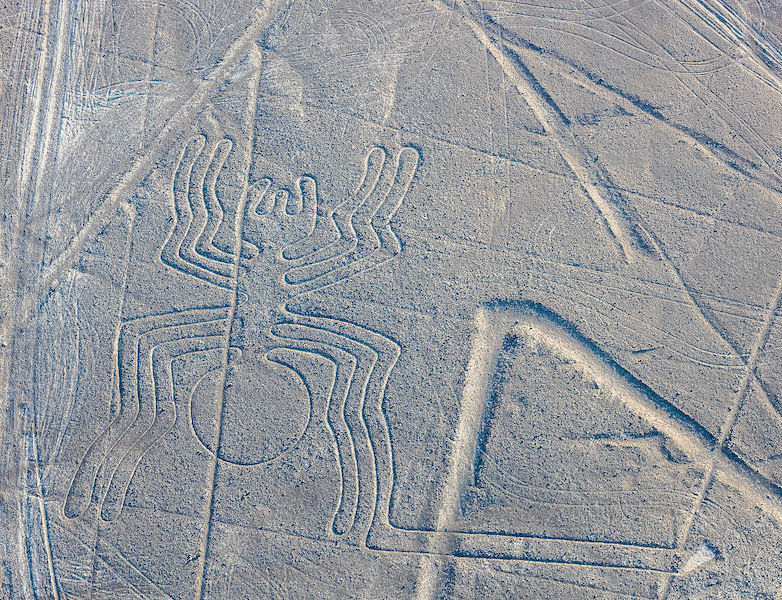
A discredited theory proposed that the geoglyphs are the result of alien contact. While this is sensationalist and helped to secure the popular fame of the Nasca geoglyphs, there is no evidence to support this assertion. Archaeologists and scientists have rejected this proposal and it is important to recognize the implication of this theory is that the Nasca people needed the influence of aliens peoples to create their geoglyphs. We know that the technology to manufacture the geoglyphs was available to the Nasca people and that they had a social system that was fully capable of organizing and producing large geoglyphs. We also know that the designs are consistent with other art forms native to Nasca culture.
Farming, fertility, and water?
Among the most promising recent theories, archaeologists have begun to secure a link between the geoglyphs and farming, which sustained the Nasca people. Some geoglyphs may deal with fertility for crops; others may be associated with the water needed to raise the crops. In a desert, water is the most important commodity. In Andean mythology the mountains are revered as the home of the gods. It has been suggested that the lines were intended to be visible to the gods in the mountains. Some lines also seem to point in the direction of the mountains — the origin of fresh water for the desert South Coast of Peru. Snow pack melts high in the mountains and becomes runoff and a vital source of water for the coast. In fact, ancient underground water channels are sometimes marked on the surface by Nasca geoglyphs, particularly at the points of intersection. These have been dubbed “ray centers,” spots where lines converge. Offerings have been found at these points, including conch shells. The spirals on the desert floor, in the monkey’s tail, and as independent abstract designs, may refer to the spirals found in conch shells and thus may reference water. This same shape appears in Nasca puquios —gradually descending tunnels that tap ancient subterranean aquifers and water channels. Puquios have been described as wells, and formed part of this ancient irrigation system. Puquios, found in Nasca (and elsewhere in Peru), allowed people to reach water in times of drought. Geoglyphs other than spirals may also be directly associated with water.
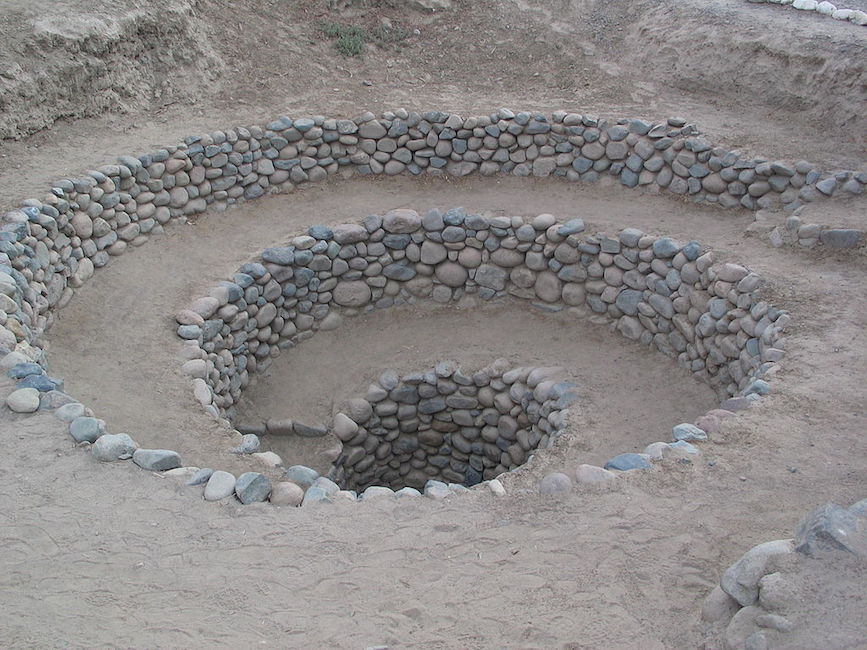
Preservation
Because the Nasca Geoglyphs were made directly on the earth by rearranging stones on the desert floor, these giant images are actually quite vulnerable to damage. In time the lighter-colored stones exposed by the Nasca people may attain their own patina, making them less visible, but the designs face greater threats from vehicle and pedestrian traffic. Crossing the lines can damage their borders and make the images less distinct. Because of this, the Peruvian government has created a mirador (viewing platform) along the Pan American Highway where visitors can climb to view a few drawings without damaging the lines.
In the end, it is likely that the Nasca Geoglyphs served more than one purpose, and these purposes may have changed over the centuries, especially given that new lines often “erased” older ones by “drawing” over them. It does appear that many geoglyphs made reference to water and agricultural fertility, and were used to promote the welfare of the Nasca people. The geoglyphs were also a place where people gathered, perhaps for pilgrimage, perhaps to walk or dance on the lines in a ritual pattern. As a gathering place, the Nasca geoglyphs may additionally have turned the Pampa into a map of social divisions, where different families or clans tended different geoglyphs. Although we do not know exact details, we can surmise that the geoglyphs represent a community investment meant to serve this ancient people.
Backstory
In January, 2018, a semi truck traveling through Peru on the Pan-American highway veered off the road and plowed through the desert. The deep ruts that it made damaged several of the Nasca lines. Though the area is clearly marked as a protected zone, according to the archeologist Johnny Isla , co-director of the Nasca-Palpa Project, cases like this “occur daily.” The driver, who authorities suspect may have been trying to avoid a toll, was charged with an “attack against cultural heritage.”
Human interventions like this constitute the main threat to the Nasca-Palpa area, whose geoglyphs extend across almost 300 square miles. In 2014, Greenpeace activists damaged the desert floor around the famous hummingbird geoglyph as they lay out a large protest sign meant to be seen from the air. Their action was a protest against climate change during the United Nations summit in Lima, and was not intended to damage the site; the organization has since apologized. However, the marks made by the activists’ footprints have been deemed possibly “irreparable” by Luis Jaime Castillo Butters, a professor of archeology and Peru’s Vice Minister for Cultural Heritage. “A bad step, a heavy step … marks the ground forever,” he said . “There is no known technique to restore it the way it was.”
The construction of the Pan-American highway has also increased the risks to the area, not only because of vehicles that can potentially veer off the road, but also because rains and mud can wash off of the surface and damage the lines .
Nasca-Palpa was designated as a UNESCO World Heritage Site in 1994. In contrast to many other at-risk heritage sites around the world, UNESCO states that
Even though there have been some impacts caused by natural and human factors, these have been minimal and the geoglyphs maintain their authenticity and express their high symbolic and historic value even today.
The most pressing need, now being discussed by Isla and others , is for better, 24-hour monitoring of the area — possibly using drone technology — so that human incursions on the site can be quickly addressed and avoided.
Backstory by Dr. Naraelle Hohensee
Additional resources:
Birds of the Andes on the Metropolitan Museum of Art’s Heilbrunn Timeline of Art History
UNESCO World Heritage webpage for Nasca-Palpa
Anthony Aveni, Between the Lines (Austin: University of Texas Press, 2000).
Jeffrey Quilter, The Ancient Central Andes (London and New York: Routledge, 2014).
Johan Reinhard, The Nazca Lines: A New Perspective on their Origin and Meaning (Lima: Editorial Los Pinos, Sixth edition 1996).
Helaine Silverman and Donald A. Proulx, The Nasca (Malden, MA: Blackwell Publishers, 2002).
“Rains damage Peru’s Nazca lines,” The Telegraph, January 20, 2009
The Paracas Textile

Mummy bundles
One of the most extraordinary masterpieces of the pre-Columbian Americas is a nearly 2,000-year-old cloth from the South Coast of Peru, which has been in the collection of the Brooklyn Museum of Art since 1938.
Despite the textile’s small size (it measures about two by five feet), it contains a vast amount of information about the people who lived in ancient Peru; and despite its great age and delicacy, its colors are brilliant, and tiny details amazingly intact. This is due to the arid environment of southern Peru along the Pacific shore, where it is so dry that organic material buried in the sand remains well preserved for hundreds or even thousands of years.


In the ancient cemeteries on the Paracas Peninsula, the dead were wrapped in layers of cloth and clothing into “mummy bundles.” The largest and richest mummy bundles contained hundreds of brightly embroidered textiles, feathered costumes, and fine jewelry, interspersed with food offerings, such as beans. Early reports claimed that this cloth came from the Paracas peninsula, so it was called “THE Paracas textile,” to mark its excellence and uniqueness. Currently, scholars have revised this provenance, and now attribute the cloth to the related, but slightly later Nasca culture.
Thread by thread
Recently, the Brooklyn Museum has posted high quality, close-up views of this masterpiece online, allowing viewers to scrutinize the textile, thread by thread. Such a detailed inspection has not been possible since the piece was first made. With simple tools, the early cultures of the Andean region of South America produced textiles of astonishing virtuosity. Some extremely fine pieces, like this one, are too delicate to have served any utilitarian purpose, and so are considered ceremonial.

Like some other very fine cloths, the Brooklyn textile is finished so carefully on both sides that it is almost impossible to distinguish which is the correct side. Although the central cloth and its framing dimensional border are created by different techniques, both display perfect reversibility—except for three border figures. These three—instead of being duplicated on the back (as if flipped in mirror image), like all the others—appear in back view on one side of the cloth, thereby designating a “front” and “back” to the textile.


The central cloth’s design of 32 geometric faces is created by “warp-wrapping,” a technique in which colored fleece is wound around sections of cotton warp threads before weaving.
Because the central cloth and the border have different color palettes, they may have been created at different times. The triple-layer border has colorful outer veneers of wool “crossed-looping” that envelop inner cotton cores of looping or weaving.

“Crossed-looping” resembles knitting (but is accomplished with a single needle); in areas where the threads are broken, it is possible to glimpse the underlying cotton substrates. While the cotton is off-white, the wool is dyed in jewel-bright tones.

The combination of materials suggests extensive trading relationships: for while cotton was grown in coastal valleys, wool came from camelids (such as the llama, alpaca, and vicuña) that live at high altitudes in the Andes mountains.

Monstrous hybrids
On the border, a parade of 90 figures is linked together on their lower bodies, which are worked two-dimensionally against a red background.

Each figure’s upper body and head is constructed as a separate unit, and attached to the woven strip. The upper bodies are worked in bas-relief, with some parts projecting outwards from the plane of the fabric. Tiny components (like leaves and feathers) were worked as separate pieces and then attached, giving a wonderful three-dimensionality and liveliness to the figures, especially because they mingle and overlap.


The parade is arranged in four, single-file, L-shaped lines that proceed around each corner of the cloth. A wide variety of types appear, including human, animal, and monstrous hybrids. Some figures are unique, others are twins, triplets, or even sextuplets; a few are in related groups.
Most of the animals and plants that appear can be tied to species still found on the South Coast, and many human figures wear or carry items that directly relate to the archaeological record.
Their jewelry, for example, corresponds to specimens formed from thin sheets of gleaming gold. These include: “forehead ornaments” (shaped like a bird with outstretched wings); “hair spangles” (disk or star shapes that dangle from the wingtips of the forehead ornament); slender, feather-shaped headdress “plumes;” and “mouthmasks.” Mouthmasks hung from the nose septum, and had flaring extensions, like cat whiskers.

Garments
The border figures’ clothing also matches examples found archaeologically, and some bear minuscule designs that faithfully represent embroidered decorations found on life-sized garments. Some wear wrap-around dresses of a style worn by women in ancient times; others wear two-part outfits, associated with men (below). The largest and most beautifully decorated garments were mantles that draped over the shoulders, and fell to the knee. By examining stitches on actual mantles, archaeologists have determined that teams of artists worked on them, sitting side-by-side.

Other border details, rather than realistic, seem to be fantastic or mythological. The severed heads (sometimes called “trophy heads”) brandished by some figures, for example, sometimes sprout flourishing plants—as if to suggest themes of sacrifice and fertility. And snake-like streamers that flow from some figures do not correspond to any known object, and may indicate supernatural qualities.

When they depicted clothing, Paracas and Nazca artists often added a face, or an animal body to the loose ends of fabric hanging behind a wearer. This artistic convention seems to suggest the lively movements of cloth fluttering behind a wearer, and hints that these ancient people considered cloth a precious carrier of vitality: an interpretation that seems warranted because this vibrant textile gives us such an evocative and animated glimpse into their world.
Backstory
The Paracas Textile is only one of hundreds of similar textiles that originate from multiple burial sites on the Paracas peninsula. These burials were first identified and excavated by the renowned Peruvian archaeologist Julio Tello in the 1920s. For political reasons, Tello was forced to abandon the site in 1930, and, without a team of archaeologists to oversee the area, a period of intense looting followed. It is now believed that a great number of the Paracas textiles in international museum collections were acquired as a result of this looting, which occurred most heavily between 1931 and 1933.
A large group of these illegally acquired textiles is held by the Gothenburg Collection in the Museum of World Culture in Gothenburg, Sweden. The objects were smuggled out of Peru by the Swedish consul in the early 1930s, and donated to the city of Gothenburg. The museum and city fully acknowledge the objects’ illicit provenance, and have been working with the Peruvian government on a plan for their systematic return. As stated on the museum website,
Large quantities of Paracas textiles were illegally exported to museums and private collections all over the world between 1931 and 1933. About a hundred of these were taken to Sweden and donated to the Ethnographic Department of Gothenburg Museum. Today, problems associated with looted artifacts and illicit trade in antiques are better acknowledged and being addressed.
Though Peru began lobbying for repatriation in 2009, Gothenburg has been somewhat slow to respond to the requests, partly due to the fragile condition of the textiles. According to the museum website, even the transport of these objects between the museum’s archives and their exhibition space in Sweden—a distance of only a few kilometers—has resulted in their deterioration. Despite these concerns, a plan has been put in place to systematically return some of the textiles to Peru. The first four were delivered in 2014, and another 79 in 2017. Further works are set to be returned by 2021. The repatriated textiles are now in the possession of Peru’s General Directorate of Museums of the Ministry of Culture.
The case of the Gothenburg Paracas textiles highlights the need not only for governmental and institutional agreements regarding the restitution of illegally acquired objects, but also for oversight concerning the continued stewardship and preservation of these fragile artworks.
Backstory by Dr. Naraelle Hohensee
Additional resources:
This textile at the Brooklyn Museum
The Gothenburg Collection of Paracas textiles
Article on the looting of Paracas textiles on Trafficking Culture
“Peru recovers 79 pre-Hispanic textiles illegally kept in Sweden,” The Local, December 15, 2017
“Peru recovers Paracas textiles,” Diario UNO, December 15, 2017
“Sweden Returns Ancient Andean Textiles to Peru,” The New York Times, June 5, 2014
Frame, Mary. 2003–4. “What the Women Were Wearing: A Deposit of Early Nasca Dresses and Shawls from Cahuachi, Peru.” Textile Museum Journal, 42/43:13–53.
Paul, Anne. 1990. “Paracas ritual attire: symbols of authority in ancient Peru,” Civilization of the American Indian series. Norman: University of Oklahoma Press.
Paul, Anne. 1991. Paracas art & architecture : object and context in South Coastal Peru, 1st ed. Iowa City: University of Iowa Press.
Silverman, Helaine. 2002. “Differentiating Paracas Necropolis and Early Nasca Textiles,” Andean archaeology II: Art, Landscape, and Society, edited by W. H. Isbell and H. Silverman. New York: Kluwer Academic/Plenum Publishers, 71–105.
Smarthistory images for teaching and learning:


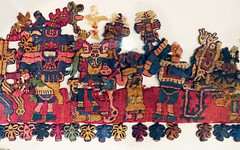
Paracas
Paracas, an introduction

Sand and sea
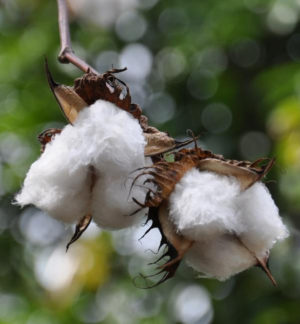
Imagine living in the driest desert on earth located next to the richest ocean on earth. How would these extremes shape social and religious life? What kind of mythology would the drama of this landscape generate? Some ideas can be found in an ancient south-coastal Peruvian people now known as Paracas, from the later Inka Quechua word para-kos, meaning “sand falling like rain.” Paracas refers to both an arid south coastal peninsula and the culture that thrived in the region c. 700 B.C.E. to 200 C.E. The area is a starkly beautiful desert of ochre red, yellow, and gold sediments juxtaposed with the vivid Pacific Ocean. The ocean, enriched by the icy Peruvian current, is a haven for marine life. Ancient inhabitants, likely drawn to the ocean’s resources, had to make do with small coastal rivers trickling down from the Andes for fresh water and agricultural opportunities. In this environment, with visual contrasts so extreme the landscape approaches Color Field abstraction, small villages that depended on fishing and farming created one of the most extraordinary cultures and art traditions in the ancient Americas.
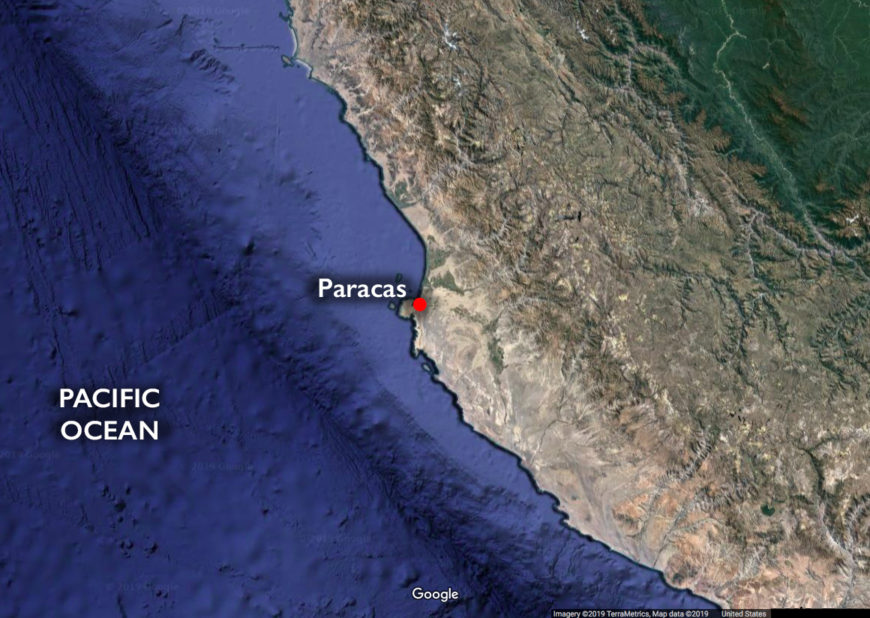
The Pacific bounty and the cotton grown in coastal river valleys gave Paracans the means to support a rich culture and forge reciprocal trade relationships with other Early Horizon highland cultures, principally Chavín. As a result, they assimilated and transformed art and ideas from the highlands, while inventing new beliefs and accompanying art forms that were largely inspired by their unique coastal ecology. Unlike other coastal and highland Andean communities, Paracans did not pursue monumental architecture, rather, they directed their considerable creative energies to textiles, ceramics, and personal regalia.
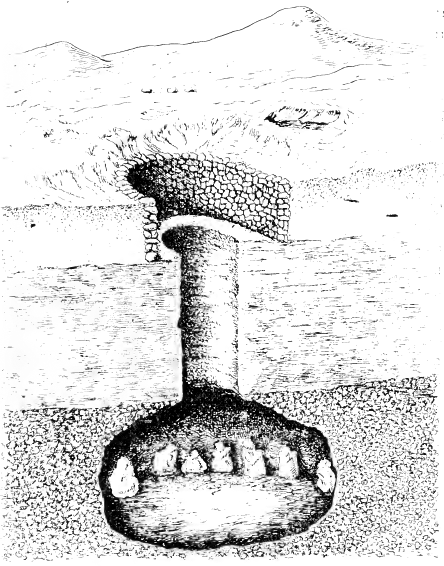
Belief in an afterlife led to the creation of subterranean burial chambers filled with elaborate mummy bundles and artifacts. Remarkably preserved in the arid coastal desert, the burials were forgotten and undisturbed for nearly 2,000 years. They were discovered in the early 20th century by Peruvian archeologist Julio C. Tello. The contents of these burials constitute the only known records of Paracas culture.
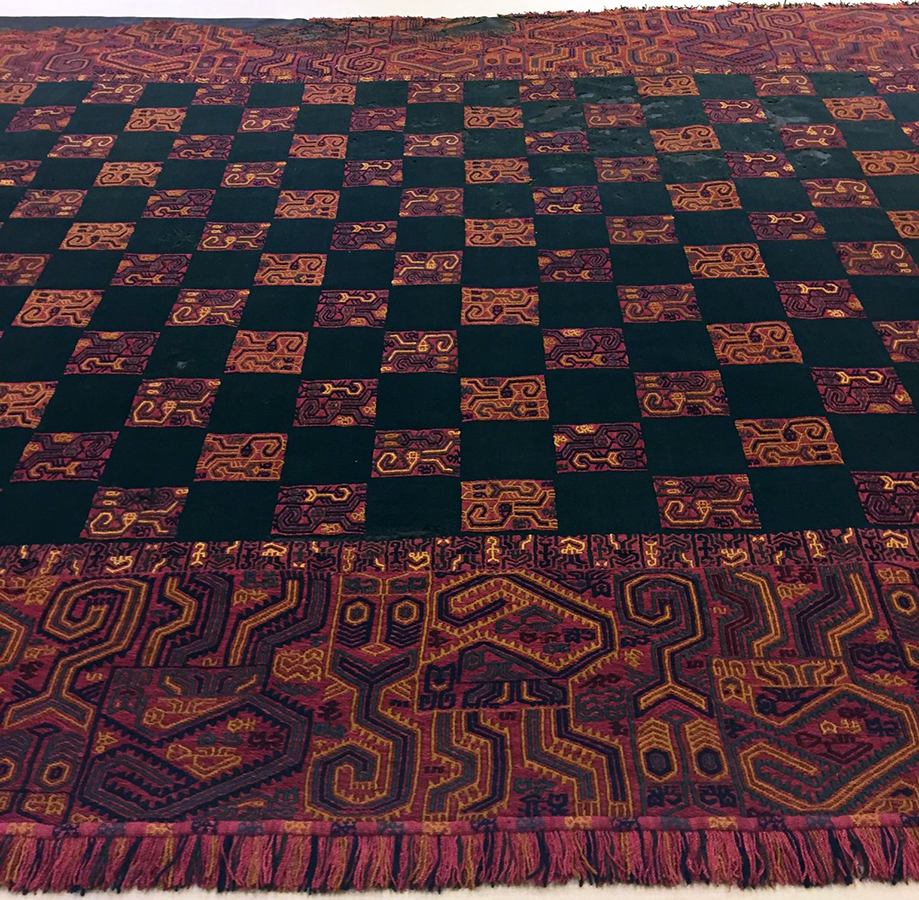
Mummy bundles and personal adornment
Most individuals were modestly wrapped in rough, plain cotton fabric to form a mummy bundle. Some adult males, presumably elites, were wrapped in multiple layers of vividly colored, elaborately woven and embroidered textiles made with cotton from the coast and camelid wool imported from the highlands. Ceramics, gold items, spondylus shells, feather fans, and individual feathers also accompanied these individuals.
Before his death and burial, an elite Paracas man would have been a dazzling sight in the desert, showing off concentrated finery that exuded status, power, and authority. These individuals are generally understood to be the religious and political leaders of Paracas chiefdom society, whose leadership and ritual duties likely continued in the afterlife. Such elites needed all their ritual attire and accessories to perform their duties and roles effectively on both sides of life and death, much like the pharaohs of ancient Egypt. Mummies may also have helped to maintain the tenuous desert agricultural cycle (often disturbed by El Niño climate events). As metaphorical seeds germinating the land, some bundles contained cotton sacks of beans rather than human bodies.[1]
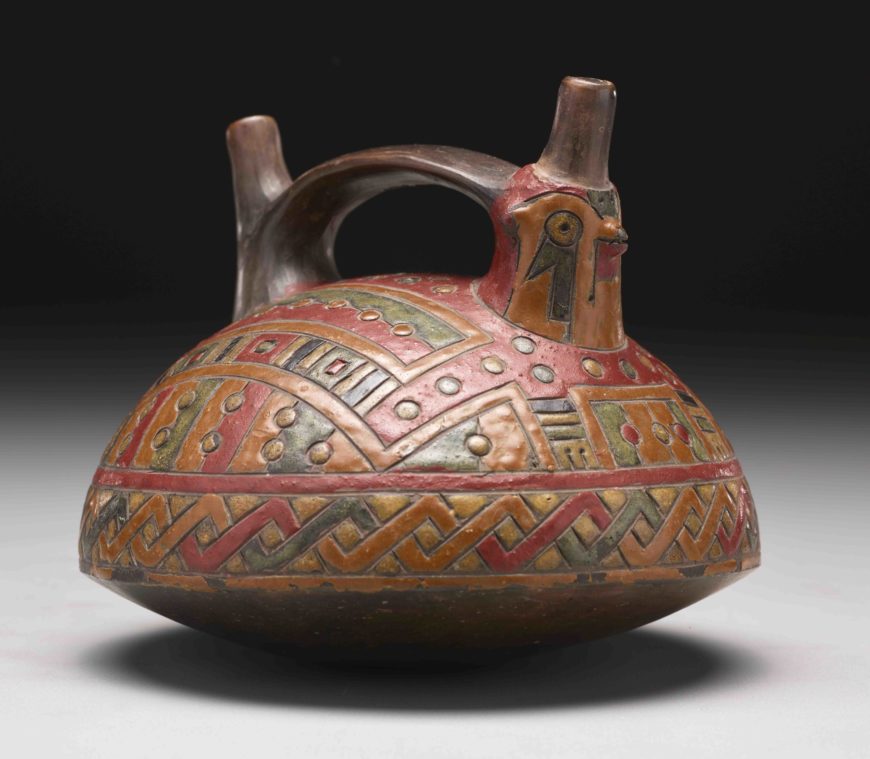
Burial artifacts
The Paracas achievements in ceramic and textile arts are among the most outstanding in the ancient Americas. The majority of Paracas ceramics were decorated after firing, with plant and mineral resin dyes applied between incised surface lines to build an image in abstract bands. In a final, transitional stage, pre-fire monochrome clay slips were applied to vessels in the shape of gourds, resulting in smooth, elegant wares.

Other notable items found in the burials included pyro-engraved gourd bowls, as well as gourd rattles and ceramic bugles, revealing the culture’s interest in musical performance. Textiles were, without question, the most outstanding of the burial finds in both quantity and quality, with every known weaving and embroidery technique mastered. Their embroidered imagery is also a form of text and the source of nearly all interpretations of Paracas beliefs and conceptions of their ritual life.
Mythical imagery in textile art
Linear Style
Complex textile imagery was likely accompanied by equally complex oral narratives. At the start of the Paracas textile tradition, c. 700 B.C.E., the imagery is dominated by the traditional Andean animal triad of serpent, bird, and feline, rendered in an abstract style known as the Linear Style and accompanied by their own creation, the Oculate Beings.
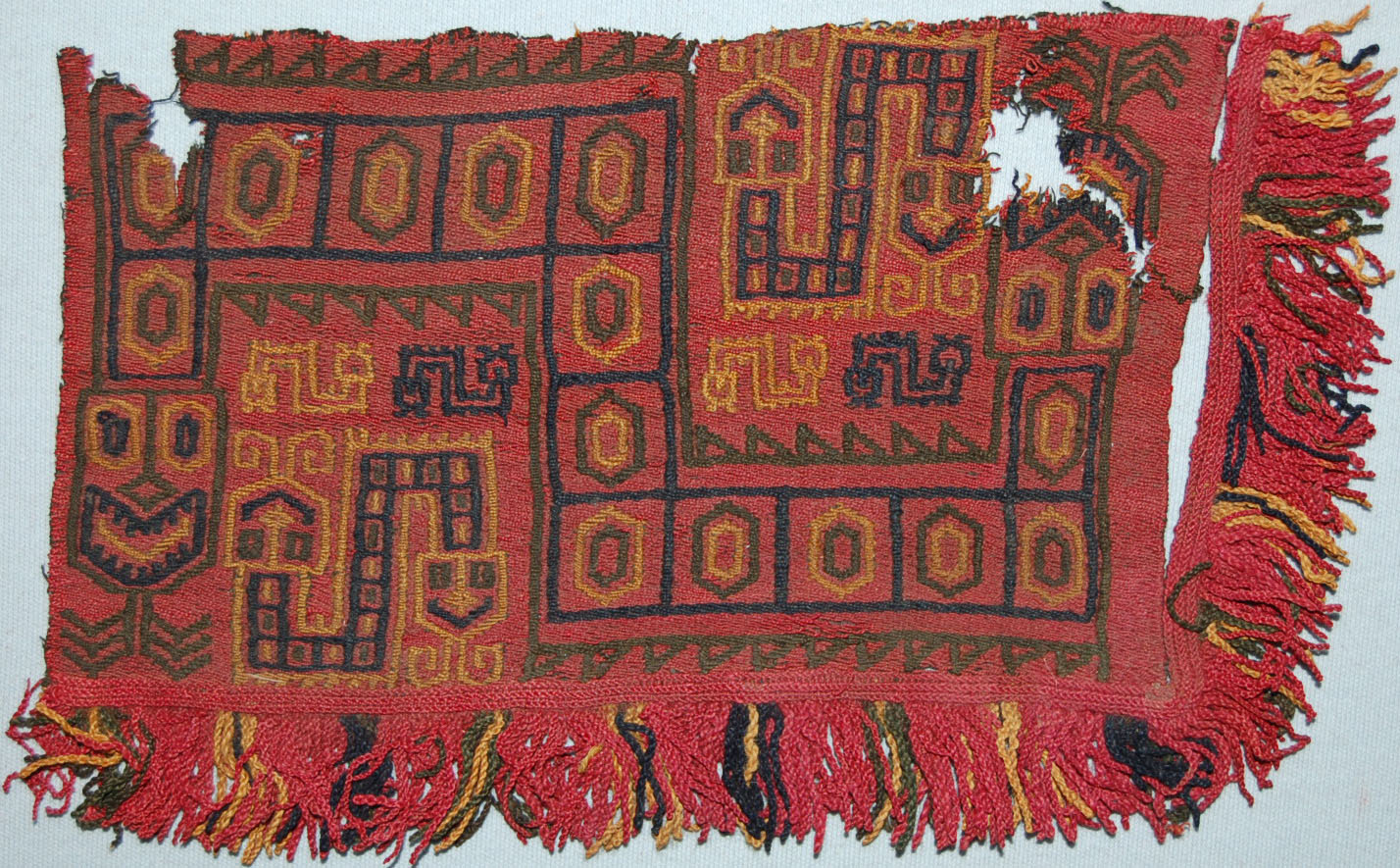
Oculate Beings were named for their enormous eyes, possibly inspired by the coastal burrowing owl or the enlarged eyes of a person in trance, and are believed to be key Paracan supernatural figures due to their frequent and enduring presence in Paracas art. Oculate Beings appeared in both humanoid and zoomorphic forms. Art historian Anne Paul identified eight distinct Oculate Beings based on different animals and poses: serpent, bird, and feline, symmetrical, seated, inverted head, flying, and with streaming hair.[2] Paracas embroiderers developed the visual potential of the Linear style to the highest degree, embedding images of animals and Oculate Beings into complex visual effects.
Block Color Style
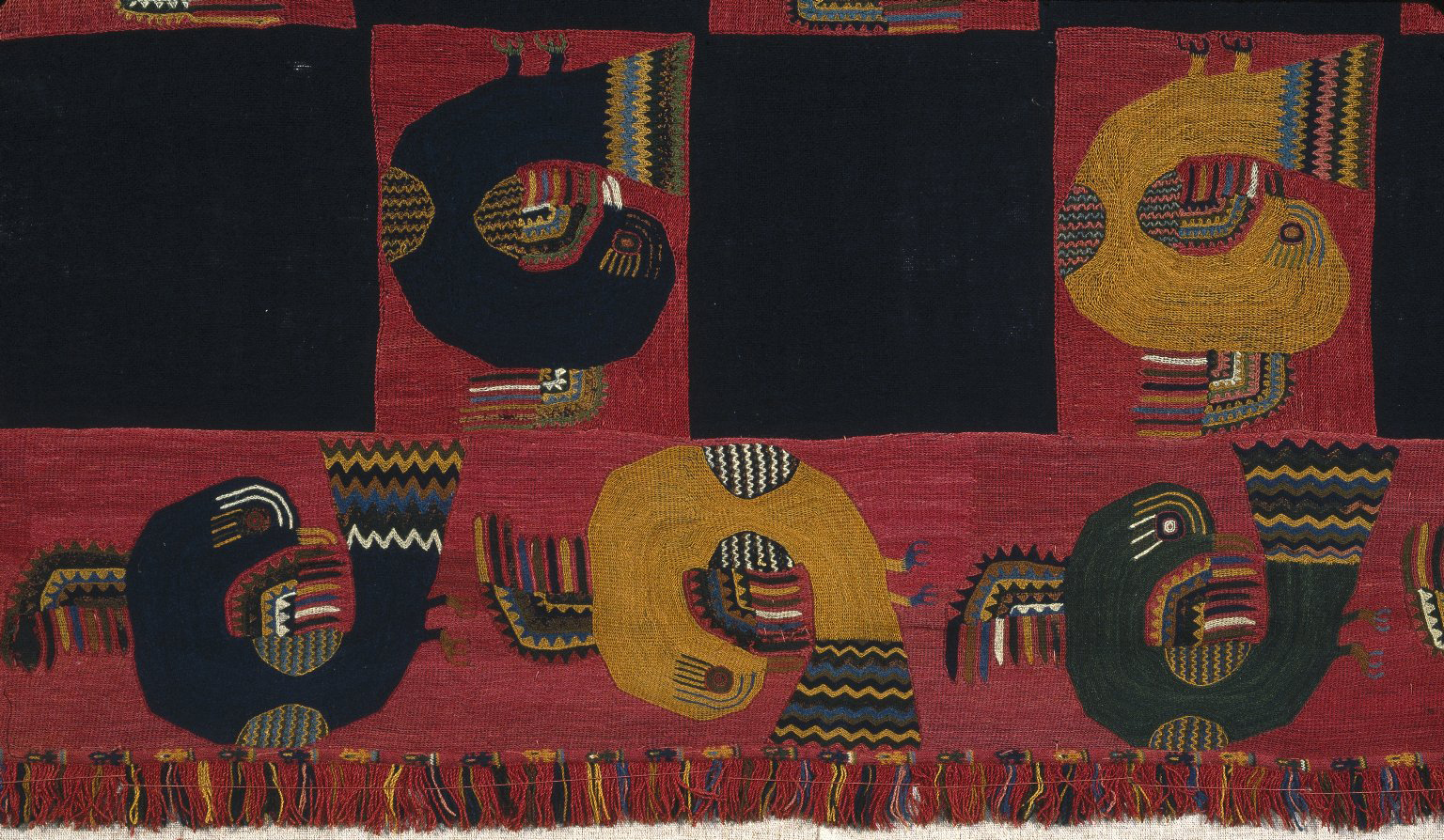
Beginning around 200 B.C.E., textile embroiderers added the curvilinear Block Color style to their production, resulting in an explosion of new forms and figures. Block Color embroidery broke away from the Linear Style iconographic template to include human figures in ritual costume, human/animal composite figures, and elaborate composites of multiple animals. Sprouting seeds, insects, flowers, serpents, sharks, the pampas cat, and in particular a wide variety of coastal and highland birds dominate this later phase of Paracas embroidery, and there are as many distinct figures as there are individual garments. This final, figural phase also often featured human figures in a state of flight or trance, akin to those found on both earlier and contemporaneous ceramics. While precise meanings remain elusive, the imagery suggests an intense interest in agricultural fertility, as well as an increasingly complex mythology and accompanying ritual activities.
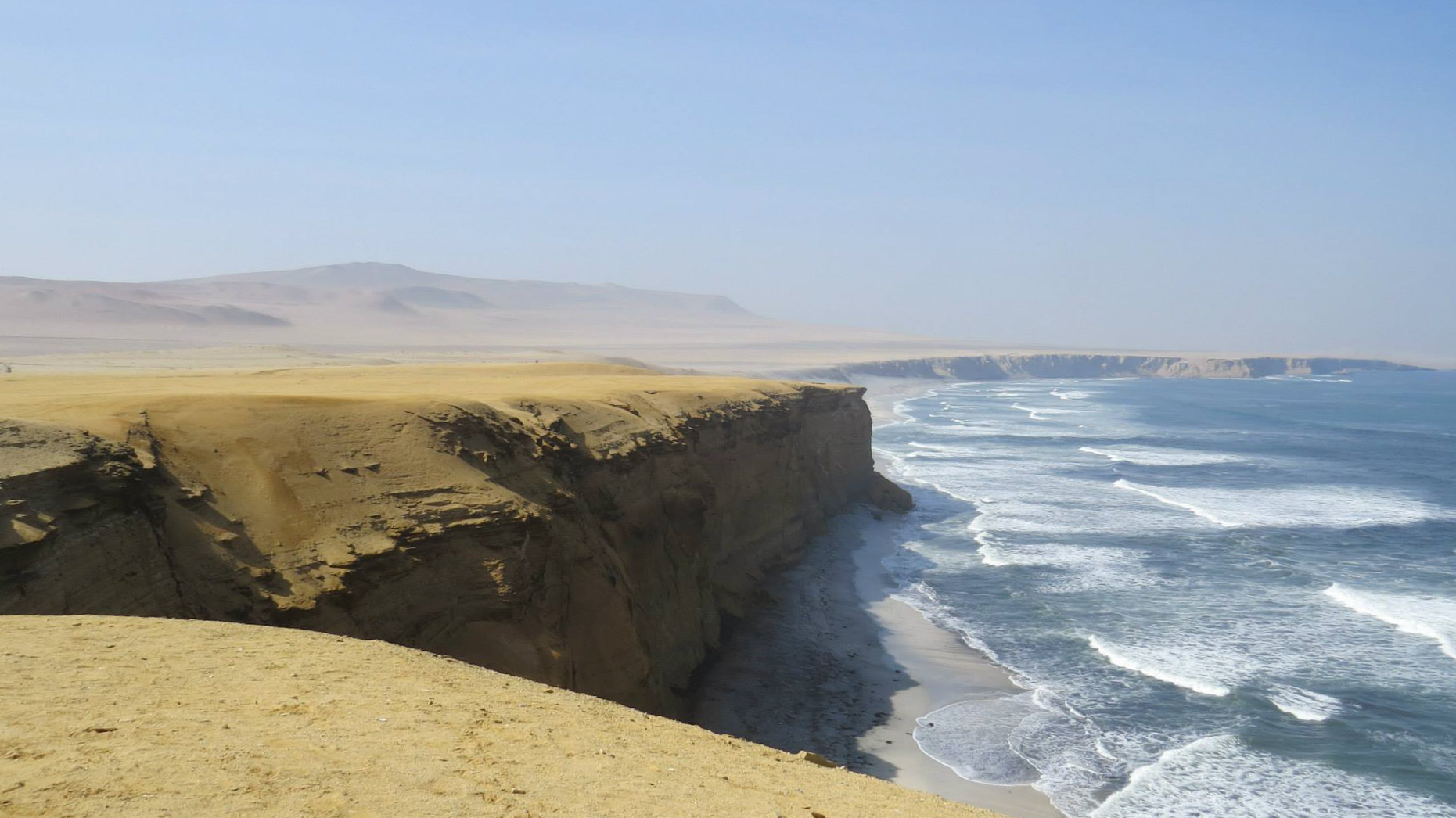
An enduring enigma
Much about Paracas culture will always remain a mystery. Their artistic record reveals a set of beliefs and rituals reflecting their culture’s dependence on the natural world and concern with perpetuating agricultural cycles, the important role of animals in political and religious activities, and a deep investment in the afterlife. The major works of Paracas artists, particularly those expressed in the embroidered figures that embellish woven textiles, are a pinnacle of Andean textile art and acknowledged as among the most accomplished fiber arts ever created. In the trajectory of Andean art, Paracas stands as an independent, inventive coastal counterpart to Chavín. Paracas culture was also a vehicle for transferring both textile and ceramic technology and iconography to the slightly later, south coastal Nasca culture, before disappearing forever into the golden desert sand.
Notes:
- Lisa DeLeonardis and George F. Lau, “Life, Death, and Ancestors,” in Andean Archeology, ed. Helaine Silverman (Malden, MA: Blackwell Publishing, 2004), p. 103
- Anne Paul, “Continuity in Paracas Textile Iconography and its Implications for the Meaning of Linear Style Images,” in The Junius B. Bird Conference on Andean Textiles, ed. Anne Pollard Rowe (Washington, D.C.: Textile Museum, 1986), p. 88
Additional resources:
Anne Paul, Paracas Ritual Attire: Symbols of Authority in Ancient Peru (Norman: University of Oklahoma Press, 1990)
Anne Paul, ed. Paracas Art and Architecture: Object and Context in South Coastal Peru (Iowa City: University of Iowa Press, 1990)
D.A. Proulx, “Paracas and Nasca: Regional Cultures on the South Coast of Peru,” in The Handbook of South American Archaeology, eds. Helaine Silverman and William H. Isbell, 563–585 (New York: Springer, 2008)
Paracas Textiles: An Introduction
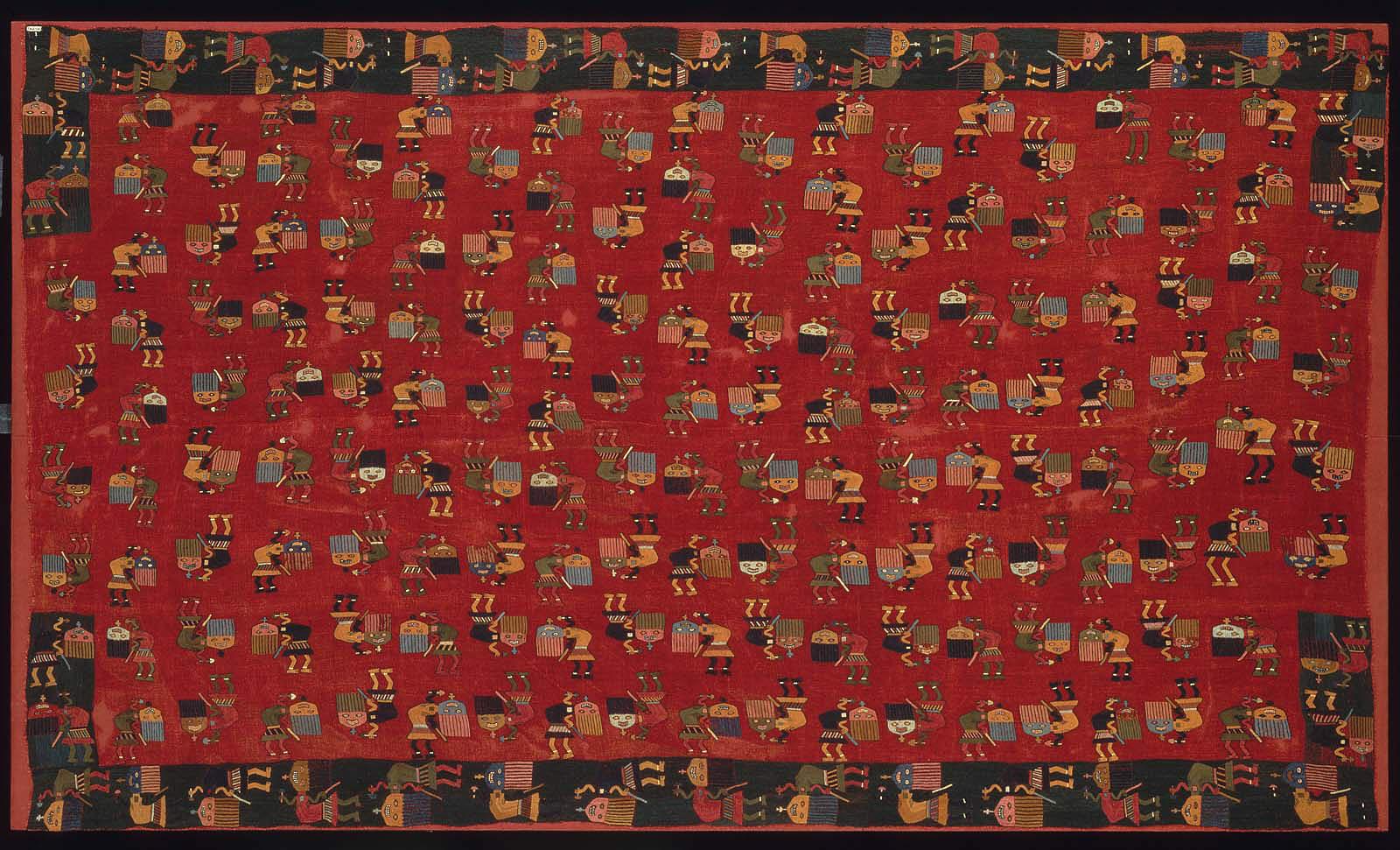
A Desert Necropolis in Peru
At around the same time that Chavín culture flourished in the highlands, the Paracas peninsula on the southern coast of Peru witnessed the rise of a new society of farmers and fishermen. The Paracas culture (c. 700 B.C.E.–200 C.E.) is best known not for its monumental architecture, but for what lay buried below the ground: a necropolis of hundreds of miraculously preserved mummy bundles. The Paracas mummies were buried in two different types of burial chambers. The Paracas Cavernas (cavern) pits were small bottle-shaped shaft tombs, while the Paracas Necropolis crypts were large mausoleums fitted with masonry walls.

Located within these tombs were mummy bundles wrapped in sumptuous embroidered textiles, some reaching up to four feet in circumference. The textiles ranged in quality from rough swaths of undecorated cloth to finely embroidered mantles. Mummies were also buried with offerings of food and jewelry to accompany the deceased into the afterlife. The types of textiles and offerings associated with a mummy bundle shed light on the individual’s social status; the larger and more elaborate the bundle, the higher social standing the person held during his or her life.
Paracas textiles provide some of the most stunning examples of pre-Columbian Andean fiber art. Close examination of Paracas textiles reveals a great deal of information on the sophisticated embroidery techniques developed by Paracas artists, their system of textile production, and their belief systems.
Material
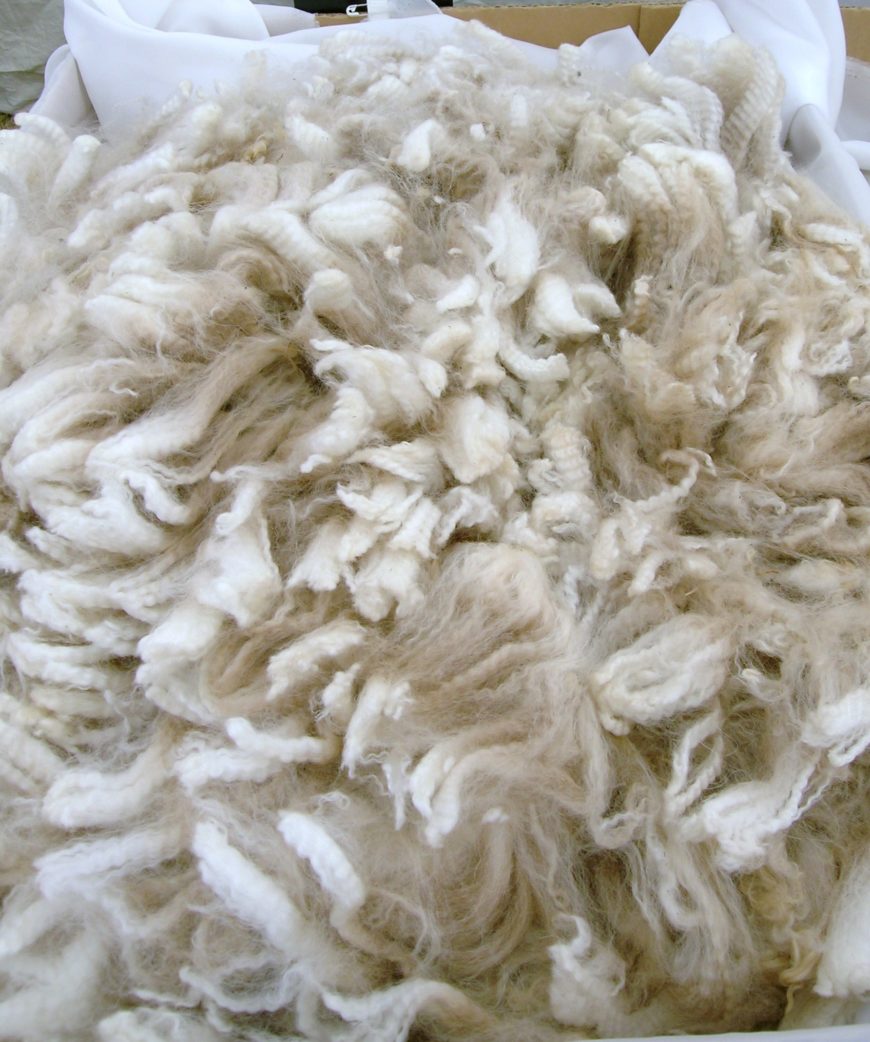
Paracas embroidered cloths were made out of cotton and camelid fibers. Cotton is a local coastal crop that would have been readily accessible to Paracas artists. Camelid (related to the camel family) fiber, on the other hand, derives from llamas, alpacas, and vicuñas indigenous to the highlands.
Paracas weavers would have procured camelid fiber through long-distance trade. Cotton would have been used for weaving the ground cloth while the silkier, high-quality camelid threads were typically used for the embroidery.
Style and techniques
Linear style
Linear Style textiles are embroidered cloths that feature repeating geometric designs. Many Linear Style textiles appear to be woven because the embroidery covers nearly the entire surface area of the ground cloth. Paracas textile specialists would embroider designs on a grid pattern instead of stitching along the contours of the design. In other words, the embroiderers would stitch each color separately in a linear fashion until the entire composition became filled in with lines. This required a great deal of planning and visualization to achieve the final product. Paracas textile specialists employed an apprentice system in which less experienced embroiderers produced designs alongside those of experts in order to mimic their designs and techniques. One single cloth could bear the work of many different hands with varying levels of expertise.
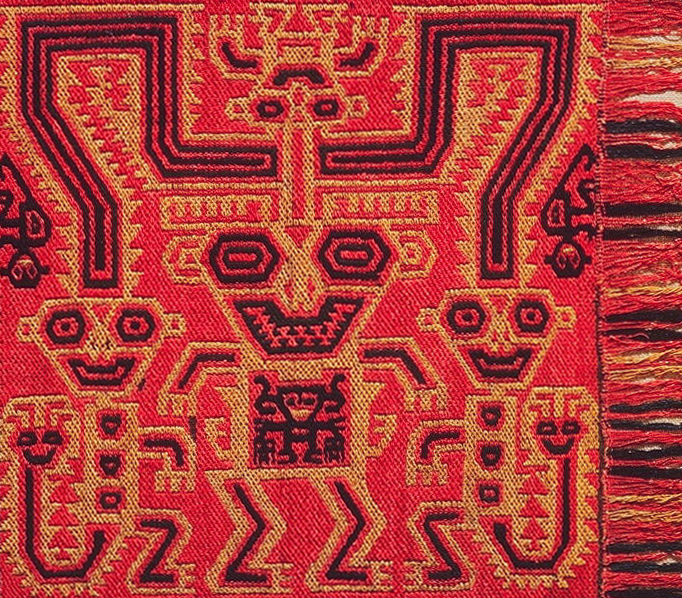
The Block Color style, on the other hand, was made by stitching outlines of shapes and then filling them in with broad areas of color. Block Color style tends to be less geometric than Linear Style, and has more open spaces between motifs. Both Linear and Block Color styles were being used during the same time period.
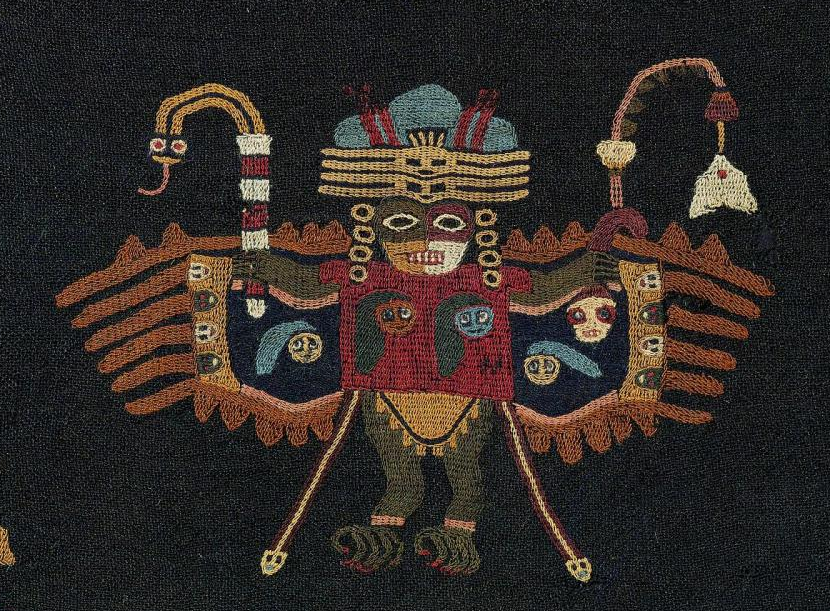
Symbols
Felines, serpents, birds, and fish dominate the Linear Style symbolic repertoire, while human figures are added to the subject matter of Block Color textiles. Unlike what we see at Chavín, Paracas symbolism mainly consists of local wildlife, including fish, pampas cats, falcons, and hummingbirds.
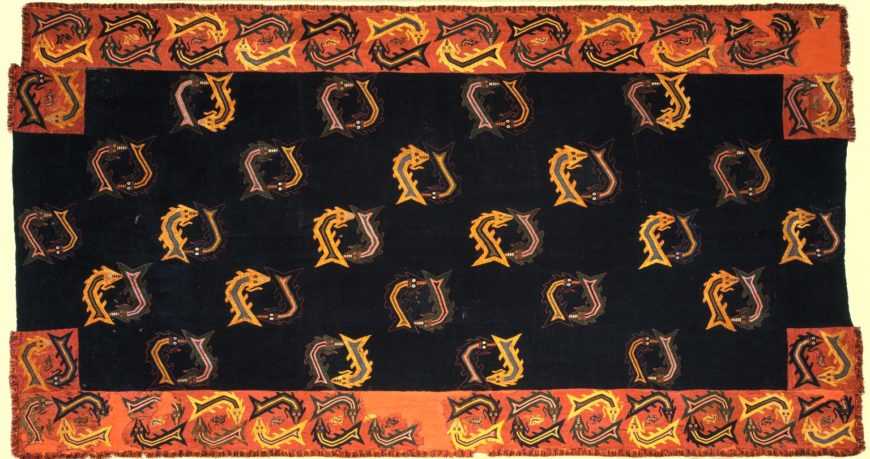
In the Double Fish Mantle we see a series of paired fish transposed to one another, with each head facing the tail of the other. Art historian Mary Frame suggests that they represent sharks due to the appearance of gills behind the eyes. In the orange border, smaller sharks are enclosed within the protected space of their connected bodies, and may be a reference to fertility and reproduction. The Paracas embroiderers depicted a range of aquatic and terrestrial life in their textiles, providing a comprehensive picture of the peninsula’s thriving ecosystem.
Paracas textiles contain standardized geometric, linear representations of animal motifs. The repeating images have a rhythmic character and usually remain faithful to the pattern. The designs are dense and compact, and bear little distinction between foreground and background. In the Double Fish Mantle, the fish motifs are arranged symmetrically within the mantle, with four pairs of fish embroidered along the long edges, followed by a row of five pairs, with six pairs along the center of the mantle.
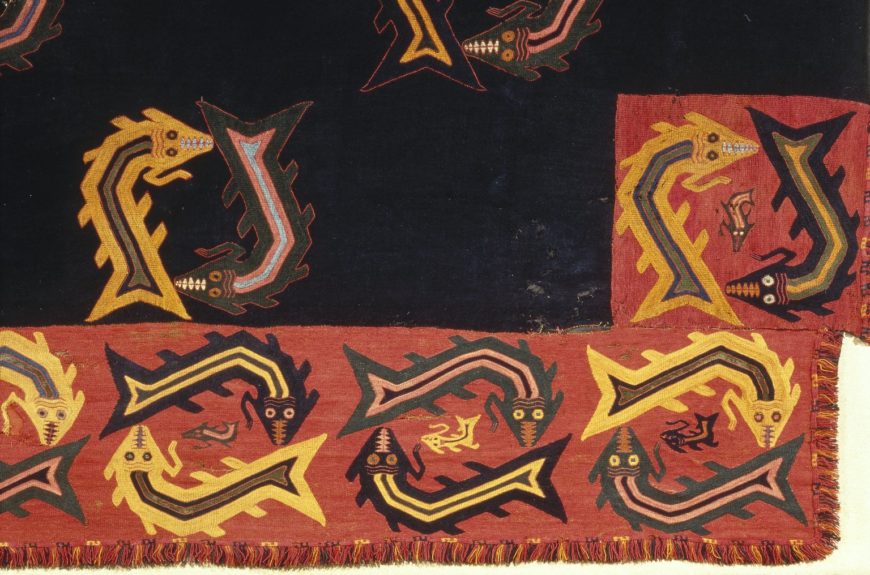
While the number and distribution of the fish pairs conform to a set pattern, a great deal of diversity can be found in the details of the embroidery. Some are green, blue, and pink; others are black, pink, and brown, while others are yellow, blue, and brown. The specific color combinations vary across the composition and do not fit into any discernible pattern. The subtle interventions made by the embroiderers, which break the pattern through the unsystematic distribution of colors, lend the mantle a powerful visual dynamism. The orange borders of the mantle offer a pop of color and also feature a slight variation of the fish motif.
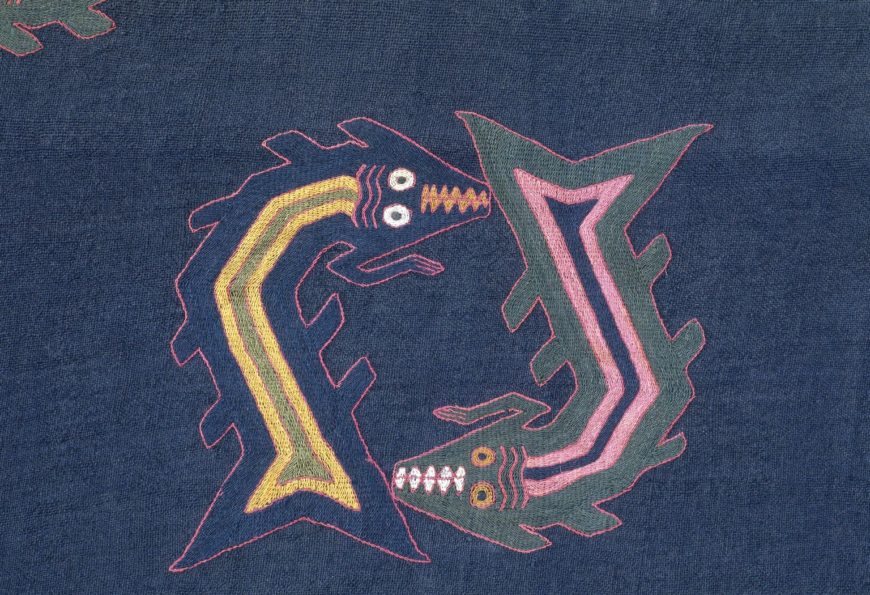
Use
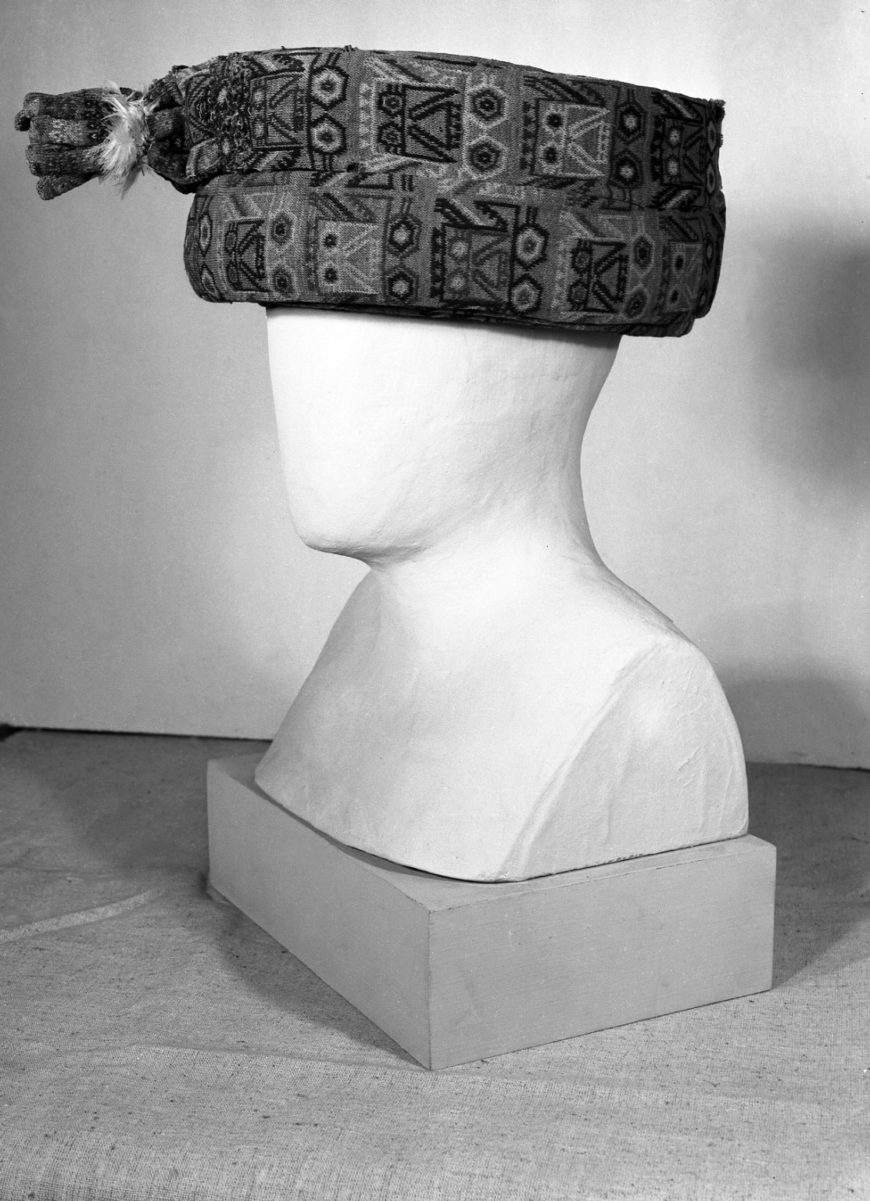
Paracas embroidery adorned a number of different types of textiles and garments. Everyday clothing such as hats, and ponchos often contained embroidered sections executed in the linear style.
The most elaborate embroideries can be found in mummy bundles. Long swaths of cloth embroidered in the linear style were wrapped around the deceased to create a bundle, some measuring up to 85 feet in length.
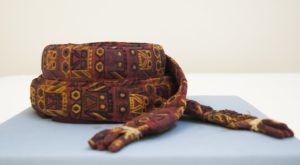
Additional resources
Read more about Andean textiles at the Metropolitan Museum of Art
Rebecca R. Stone, Art of the Andes: From Chavín to Inca (London: Thames & Hudson 2012)
Anne Paul, “Paracas ritual attire: symbols of authority in ancient Peru,” Civilization of the American Indian series (Norman: University of Oklahoma Press, 1990)
Anne Paul, Paracas art & architecture: object and context in South Coastal Peru, 1st ed (Iowa City: University of Iowa Press, 1991)
Helaine Silverman, “Differentiating Paracas Necropolis and Early Nasca Textiles,” Andean archaeology II: Art, Landscape, and Society, edited by W. H. Isbell and H. Silverman (New York: Kluwer Academic/Plenum Publishers, 2002), pp. 71–105
Paracas Supernatural Bird Mantle
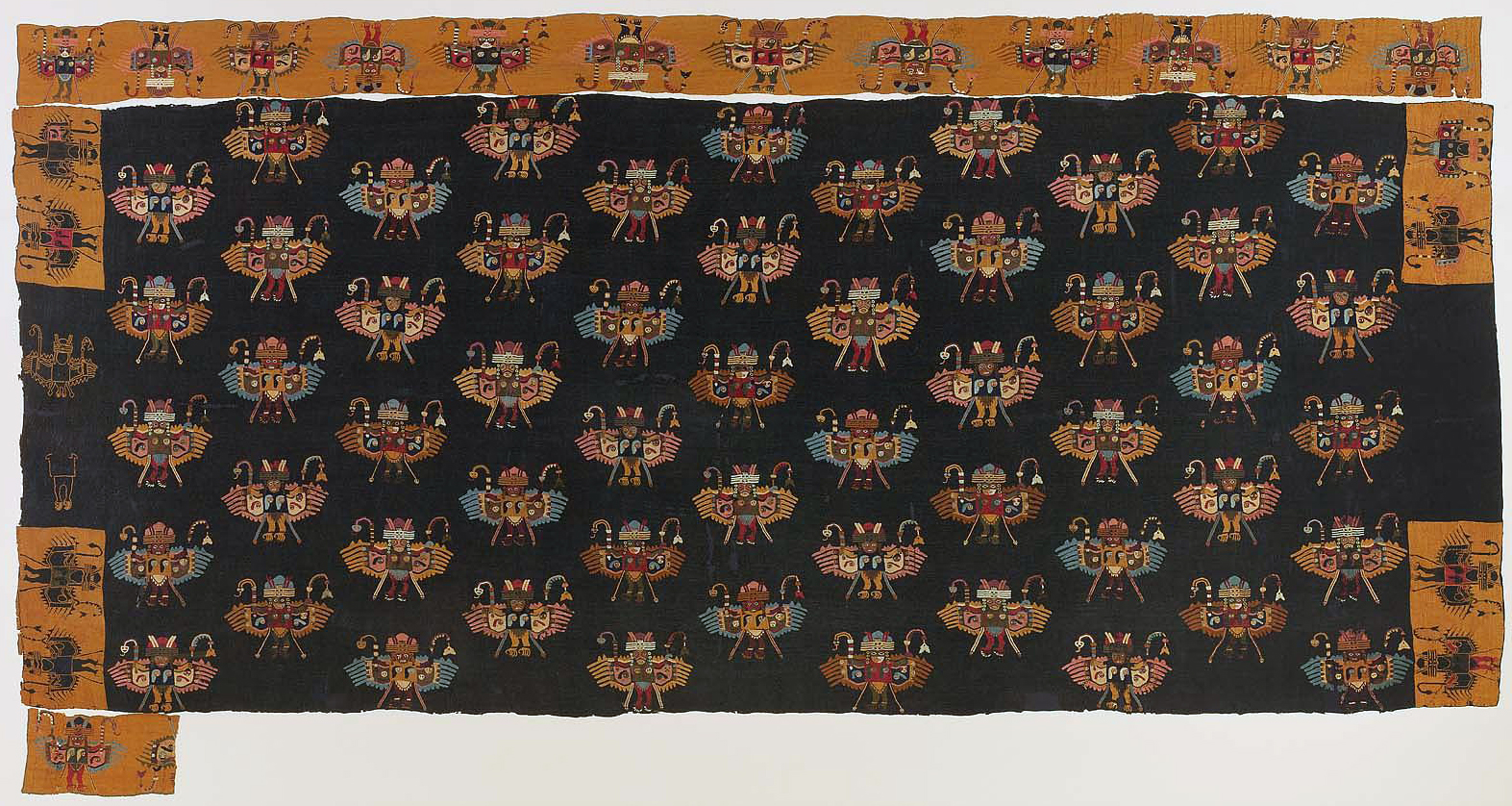
The Transcendent Bird
Birds and winged creatures have often been tasked with duties of great symbolic importance in human culture. From harpies to storks, interfacing with the spirit realm and ferrying precious items and messages are just a few of birds’ mythic and folkloric roles throughout time and place. In the Peruvian south coast, a village culture now known as Paracas (c. 700 B.C.E. to 200 C.E.) created a version of the supernatural bird that demonstrates enduring elements of Andean art—a bird with outstretched wings, composite imagery, and symbolic heads—in a distinctively Paracas visual style.
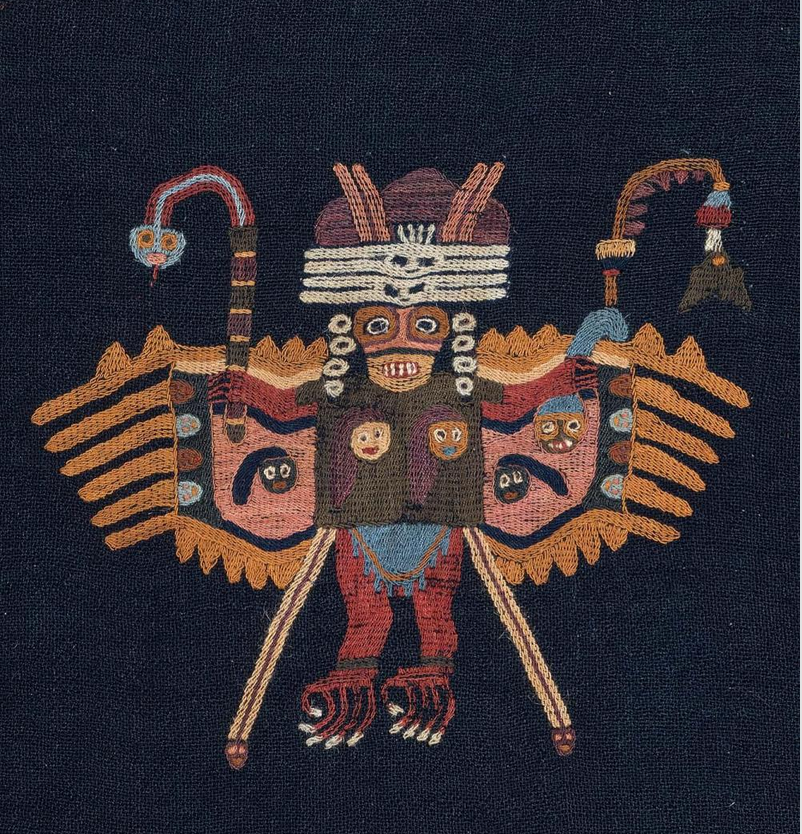
This being was recorded in embroidered camelid fiber upon a large funeral mantle, one layer of many textiles making up an elite mummy bundle preserved for some 2,000 years in the Paracas Necropolis cemetery on the arid coastal peninsula which gives the culture its name. When discovered and unwrapped, this textile (from the 1st century C.E.) revealed colorful, flying human/bird figures dressed in elaborate costume and possessing of an intriguing array of accessories.
Anatomy and Costume
The avian figures are rendered in the final stylistic phase of Paracas Necropolis embroidery that art historians refer to as the Block Color style. The placement of the figures in a checkerboard pattern across the mantle’s ground cloth and in alternating up/down poses on its border is typical of Block Color compositions. The inherent freedom of embroidery, a technique in which thread is stitched upon the surface of a woven cloth, made it possible for Paracas artists to create complex, multi-colored figures. Four different combinations of red, pink, blue, dark green, yellow, and soft green stitches articulate a headdress with frontal bands and dangling ornaments, colorful faces (possibly wearing masks), and fringed tunics. They carry banded staffs curving into serpents in one hand, curving staffs with fringe ending in floral or fishtail ornaments in another. Fantastical elements, such as avian toe-and-talon feet and snake emanations, place the figure firmly in the realm of the supernatural.
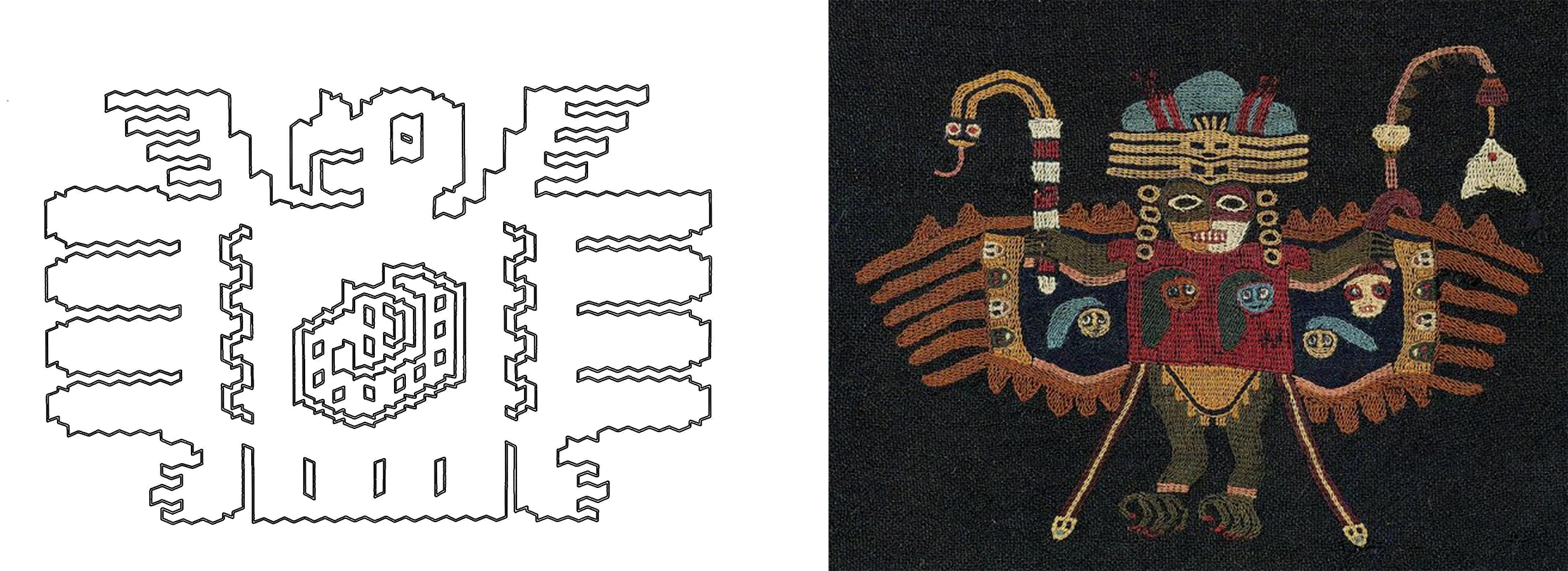
While the color and curvilinear style are unprecedented in Andean art, serpent/bird combinations and composite imagery are found in Andean art as early as the Cotton Pre-Ceramic period (c. 3000 B.C.E.–1800 B.C.E.) in the Huaca Prieta twined textile and in stone at the Old Temple of Chavín de Huantar (c. 900 B.C.E.–500 B.C.E.). The Paracas human/bird’s wing feathers also double as heads, another example of characteristically Andean composite imagery.
The Symbolic Power of Heads
Figures clutch a head by its hair, two heads are placed on the front of the body, and one is placed within each wing. Heads are a frequent motif appearing in all phases of Paracas art, and caches of severed human heads have been found within some of their burials. Numerous archeologists, beginning with Julio C. Tello in the early 20th century, believed severed heads were trophies taken in conflict. This interpretation has been supported by the fact that many heads, some of young men, were buried with ropes (presumably for transport and display) still attached to their skulls.
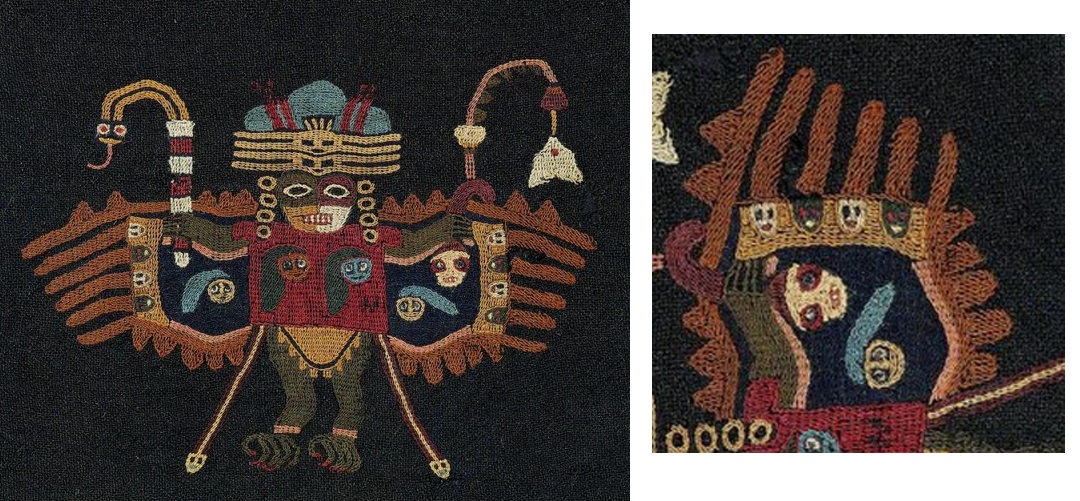
Other heads were buried intact and wrapped in cotton cloth before burial, suggesting they were not trophies, but the heads of ancestral elders. Art historian Anne Paul observed that there are far more heads depicted in Paracas art than are actually found in burials, and there is little evidence to suggest that Paracas was a particularly aggressive culture. She believes the presence of so many heads in their art may be a stronger reflection of their symbolic power than a frequent practice of head collection.[1]
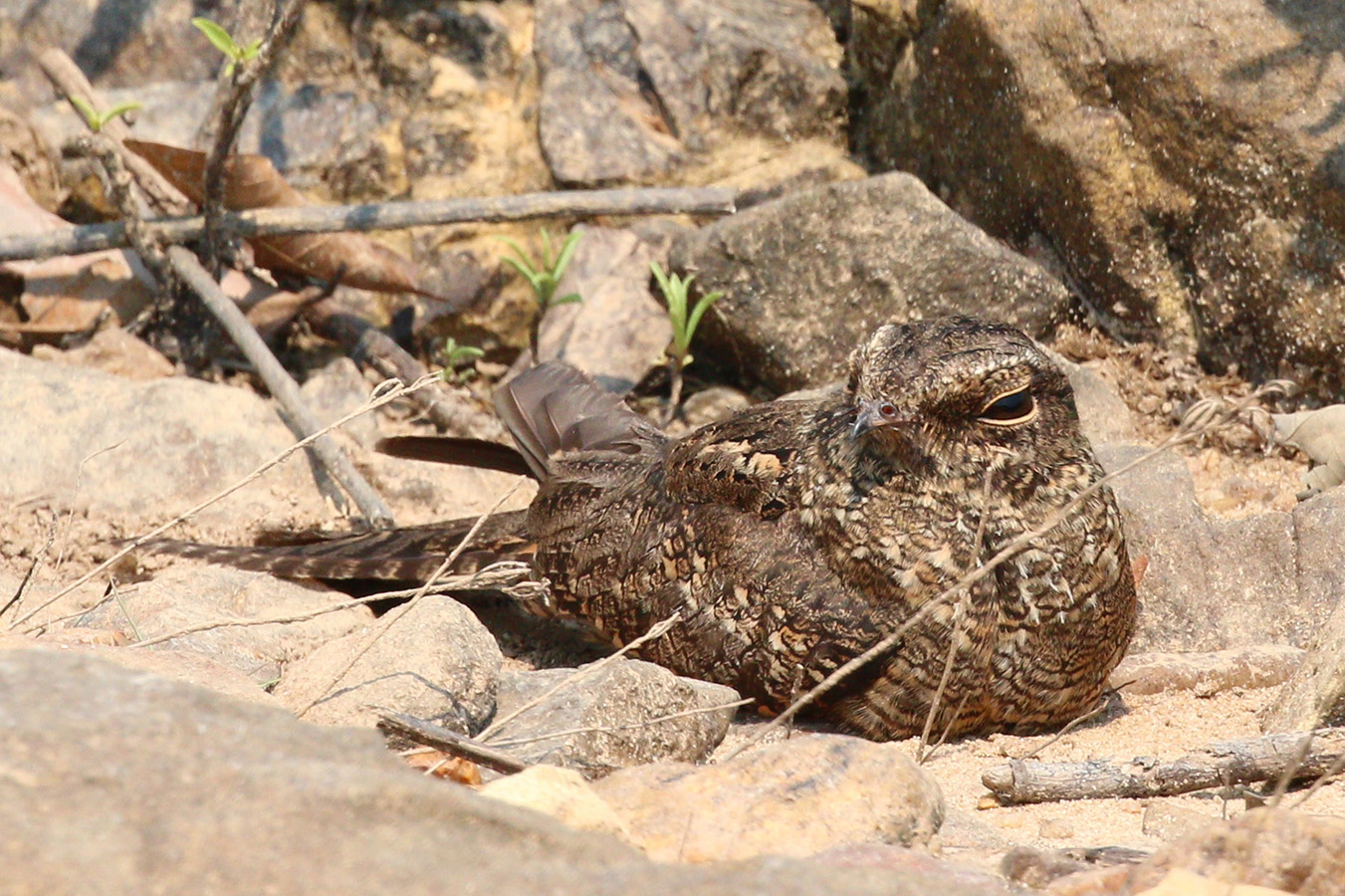
These heads intersected with conceptions of birds in a number of ways. Birds may have been seen as aids in the act of headhunting (for those that were likely trophy heads), as vehicles for transporting them to the spirit world, and as mirrors of their ritual consumption. An association between the nightjar bird and decapitation is documented in narratives from village cultures of eastern Brazil.[2]
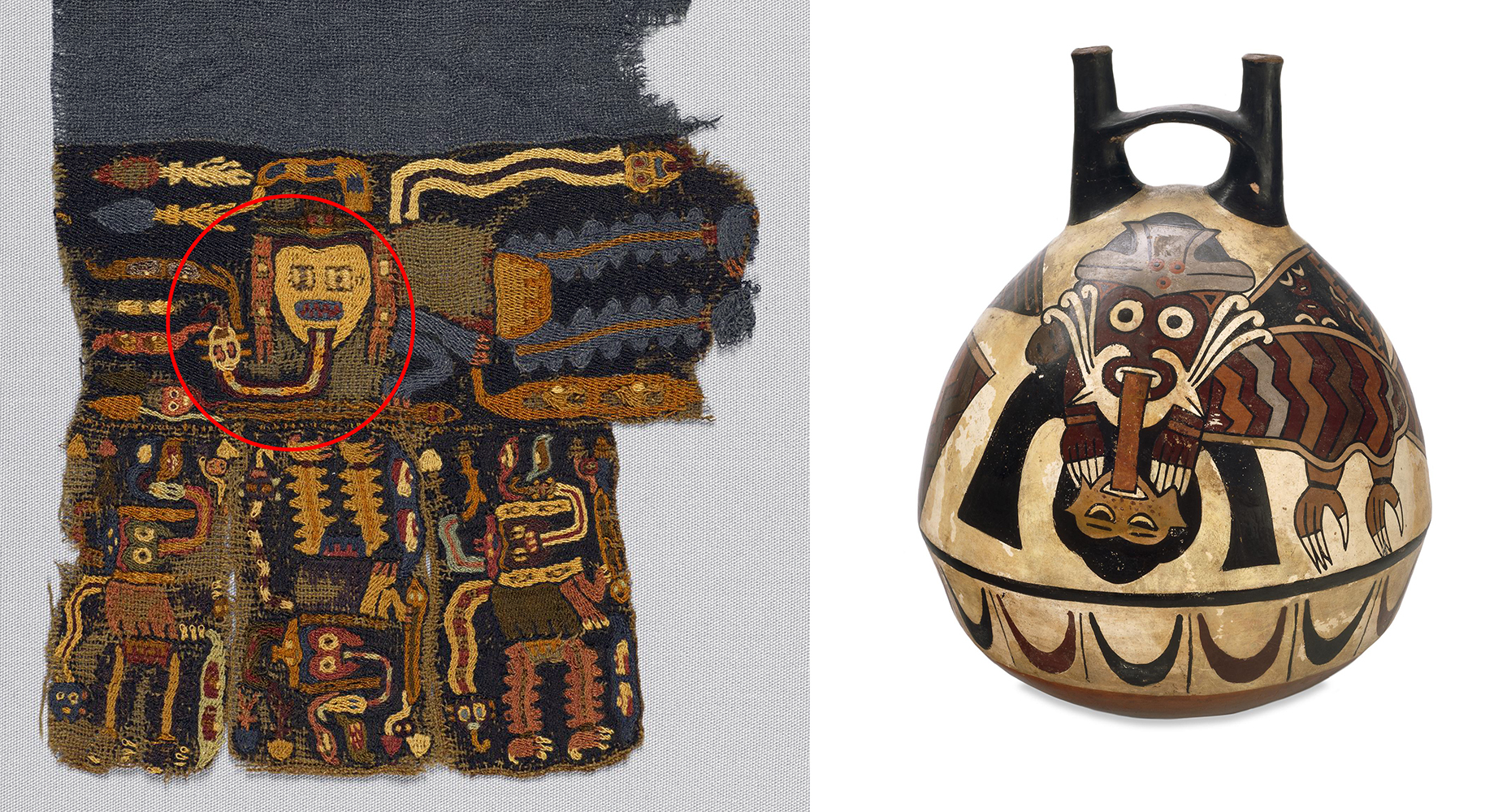
Some Paracas Block Color figures are shown with tongue-like appendages probing clutched heads, or small birds and other animals possibly substituting for heads.[3] Further, Paracans would have observed carrion-feeding birds such as Andean condors, who visited the coast, and the local turkey vultures consuming carcasses. These activities would have strongly resonated with their attunement to the cycle of life from death. As the Nasca culture (c. 100 C.E.–800 C.E.) arose to the south of the Paracas region, this imagery persisted in their art. One Nasca ceramic vessel very clearly depicts a winged supernatural with a headdress, masked face, avian feet, and faces within its wings; it is clutching and connected to a head by a shared mouth band.
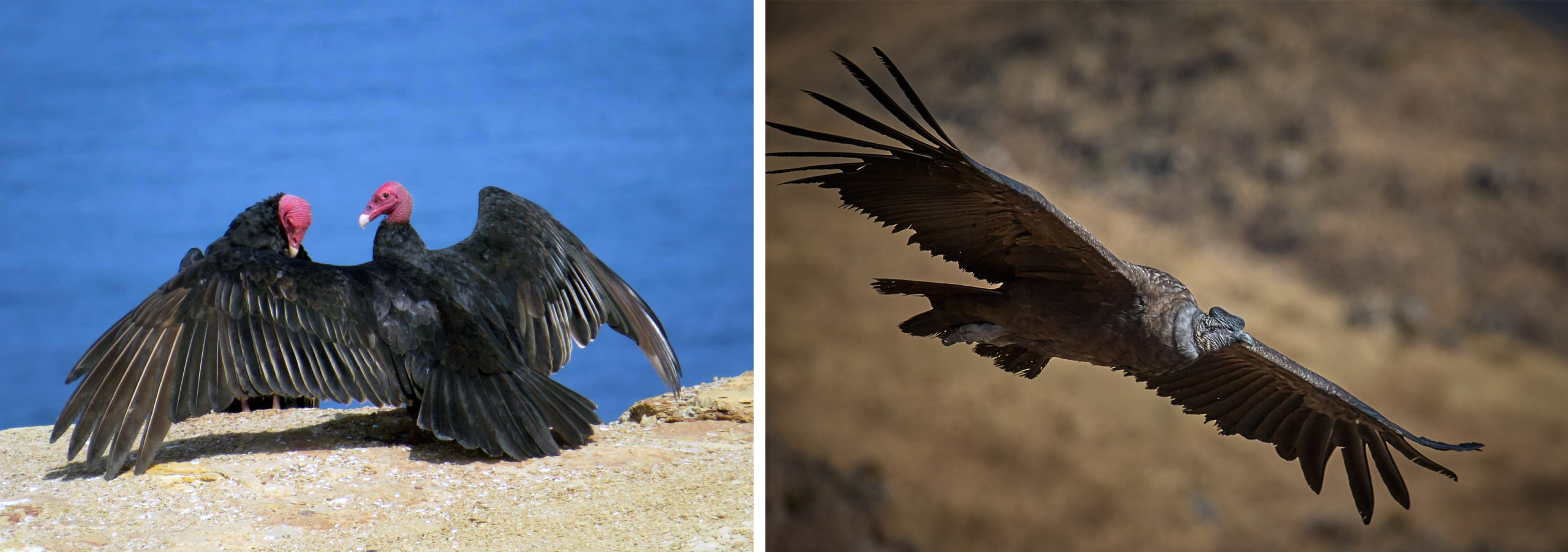
Avian Ritual Performance
The fringed tunics, headdress ornaments, and staffs depicted on the figures illustrate actual found objects within certain mummy bundles, revealing that they are more than symbols, they reflect a number of items used in Paracas ritual life.

Prior to the appearance of Paracas culture, there is very little evidence for the use of avian costume in the Andes. This imagery suggests that Paracas society may have been the first in the Andes to engage in avian-inspired ritual performance. These performances might have involved a state of trance during which an individual takes a psychological journey to another realm, generally to acquire knowledge and skills needed in the human world, often aided by an animal companion or symbolically becoming an animal in the process. As flyers and divers, birds are able to access realms unavailable to humans, and have thus been associated with ritual journeys and spiritual transformation worldwide. In the Andes, however, prior to Paracas culture the jaguar was the animal more closely associated with shamanic transformation, as demonstrated by the monumental stone art of highland Chavín culture.

Reading the Mantle
These fantastical avian beings reveal noteworthy elements of Paracas cultural life: the symbolic role of birds, heads, and the possibility of avian-inspired rituals. The flying figures may be illustrations of humans who engaged in ritual performance during life and were believed to transform into supernatural birds in the afterlife. The mantle may have been created as an aid to this transformative process, helping to incubate an individual within a bundle so that he would emerge in the afterlife as a bird/human hybrid. The imagery demonstrates an ongoing Andean interest in birds, bodiless heads, composite visual systems, and the importance of the afterlife, expressed in a unique Paracas art style.
Notes:
- Anne Paul, “Bodiless human heads in Paracas Necropolis textile iconography,” Andean Past 6, 2000: p. 76.
- Vanessa Drake Moraga, Animal Myth and Magic: Images from Pre-Columbian Textiles (Larkspur, CA: Ololo, 2005), p.127.
- Lisa DeLeonardis and George F. Lau, “Life, Death, and Ancestors” in Andean Archeology, ed. Helaine Silverman (Malden, MA: Blackwell Publishing, 2004), p. 98.
Additional resources:
Anne Paul, Paracas Ritual Attire (Norman: University of Oklahoma Press, 1991)
Denise Y. Arnold and Christine A. Hastorf, Heads of State: Icons, Power, and Politics in the Ancient and Modern Andes (London and New York: Routledge, 2016)
Elizabeth Benson, Birds and Beasts of Ancient Latin America. Gainesville: University Press of Florida, 1997
Read more about birds of the Andes at the Metropolitan Museum of Art’s Heilbrunn Timeline of Art History
Vanessa Drake Moraga, Animal Myth and Magic: Images from Pre-Columbian Textiles (Larkspur, CA: Ololo, 2005)
Paracas Feline Face Bottle
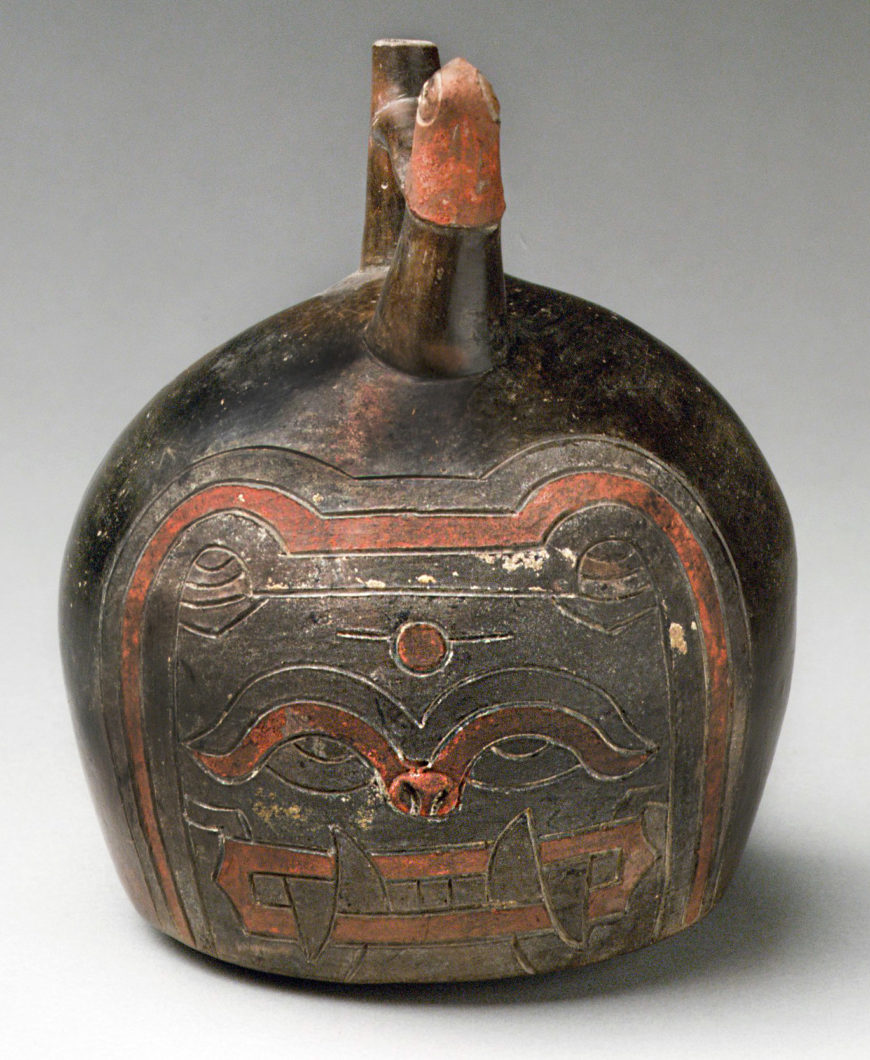
An animal face in clay
A feline with enormous fangs snarls on the front of an ancient Andean ceramic jar. Two spouts rise from the top, and a small bird’s head is lightly carved into one of them. The stories once told about the feline and bird are long lost to time, but the jar and its animals still communicate insights about the people who created them. In the absence of written texts, material culture such as this ceramic jar is the only surviving record of this ancient culture.
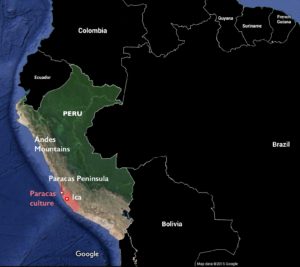
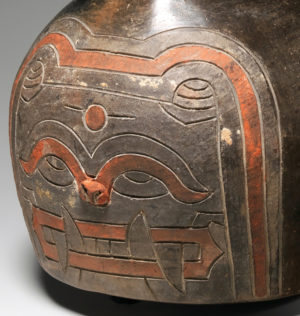
The jar is from the Paracas culture, a village society that thrived on the south coastal Peruvian desert during and just after the first millennium B.C.E. This vessel was found in the Ica Valley to the south of the Paracas peninsula.
The feline face was created by lines lightly carved into the soft, pre-fired clay surface, a technique called incising. After firing, the jar was colored with a resin paint, a distinctive Paracas technique. Colors, typically four or five but sometimes up to fifteen, were made of pigments and binders from the plants, minerals, and other materials available in the desert coast environment, including reptile urine. [1]
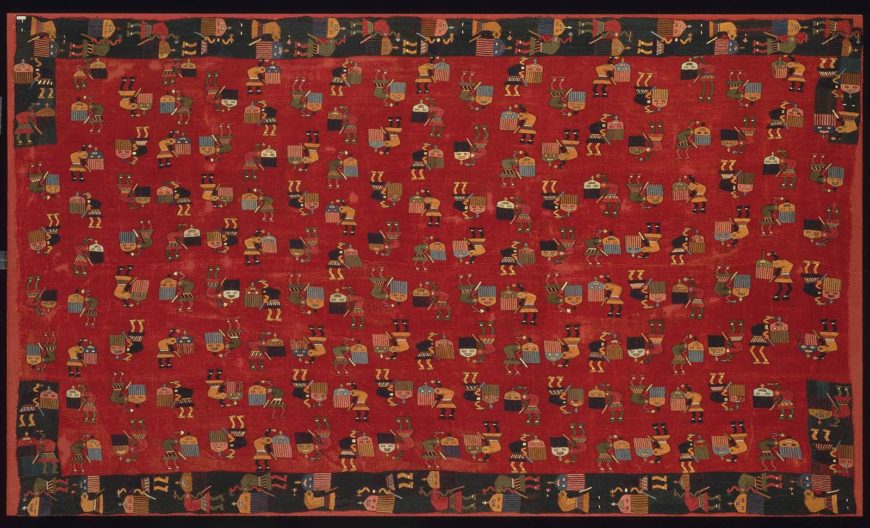
The jar’s survival can be credited to the culture’s reverence for their ancestors and concern with furnishing the realm of the afterlife. This resulted in the creation of mummy bundles (wrapping the dead in layers of textiles) and burying them with grave offerings in the arid Paracas peninsula and neighboring river valleys. The desert climate, the driest in the world, fortunately also preserved a large quantity of ancient textiles, fragile materials that are usually lost forever when buried.
Background: Chavín and its influence on Paracas
Examining the vessel’s technique, imagery, and style have revealed clues about cultural interactions between Paracas and another culture from the highland (mountainous) region, known as Chavín (pronounced Cha-VEEN). Comparing ceramics from the two cultures reveals how the Paracas ceramic tradition, once heavily influenced by Chavín, began to develop its own characteristics. One of the notable ways this occurred was by changing the style of a Chavín feline, among the most important highland animal images, and putting a bird on it.
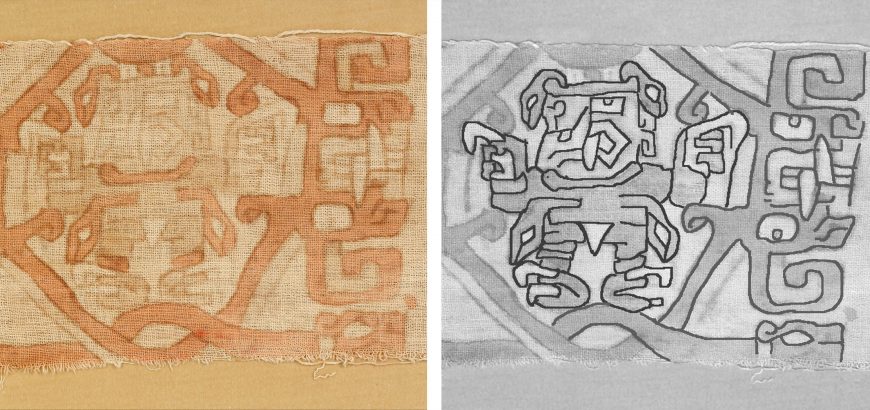
The highland culture of Chavín was one of the key cultures in the Early Horizon Andean interaction sphere (c. 900 B.C.E.–100 C.E.). Its influence is apparent in the highlands and the coast by the widespread use of a strikingly distinct visual art style. Chavín images are abstract and composite, with multiple animals appearing in one body, such as we see in a textile fragment showing the Staff God. Here, the Staff God is shown with its head in profile, with snakes emerging from the top of the head, a feline-fanged mouth, snake belt, and taloned hands and feet.
Animals in Chavín images often appear aggressive, with over-sized, interlocking fangs and long claws. The eyes feature pendant irises (where the iris hangs from the top of the eye), and an upturned, “push-face” nose resembling the features of certain canine breeds.

Due to contact with the Amazon rainforest on the eastern slopes of the Andes, their imagery also featured tropical animals such as the spotted jaguar, harpy eagle, and possibly a caiman (a small crocodilian). Jaguar images are particularly emblematic of Chavín art style, as they are typically shown with exaggerated, exposed incisor teeth that give the animals a permanently aggressive demeanor. The spotted jaguar is recognized in their art by large, concentric circles included on its body and on the bodies of hybrid feline/human/avian beings. The Chavín art style is best demonstrated by their stone carving tradition at the highland site of Chavín de Huantar, and was carried throughout the highlands and to the coast by way of portable arts such as textiles and ceramics.
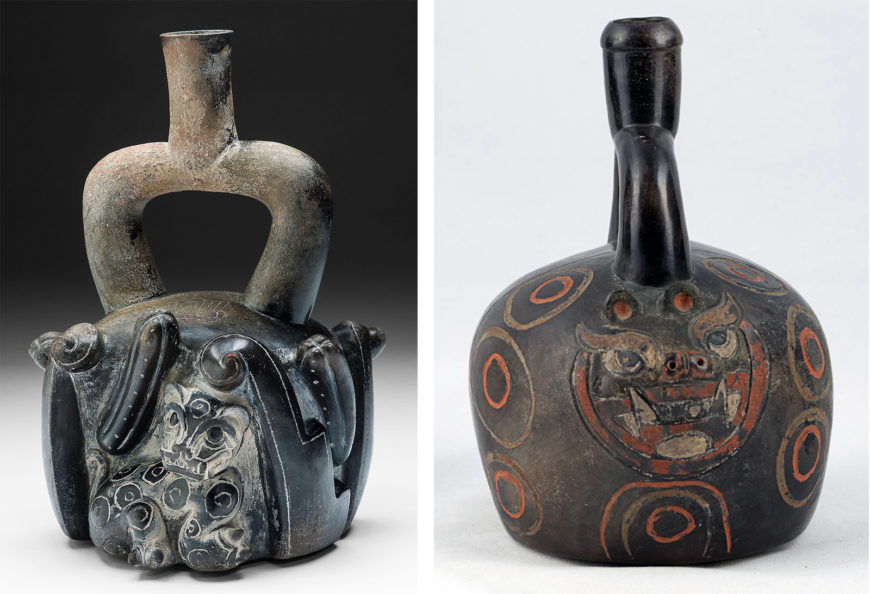
Chavín ceramics were mostly dark brown, red, or black in color. Flat-based, spherical vessels typically featured raised, sculptural imagery and handles in a horseshoe shape connected to a vertical spout, called a stirrup-spout. The earliest Paracas ceramic vessels show a marked Chavín influence, and they are believed to be some of the first appearances of Chavín art style in the region. In the image above, we see a Chavín vessel on the left and a Paracas vessel on the right. Both have flat bases, dark colors, stirrup-spouts, and felines with oversized, interlocking fangs in faces protruding from the surface of the vessel.
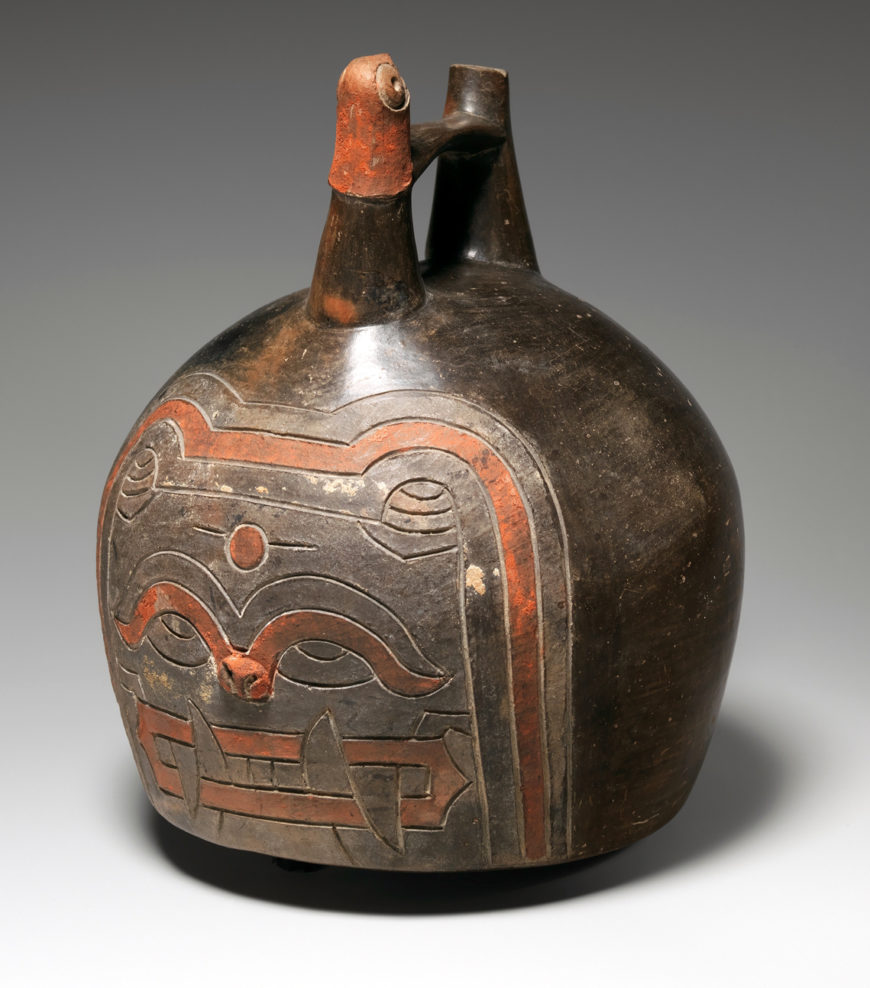
Paracas innovations: new forms, colors, and a bird
The Paracas vessel at The Metropolitan Museum of Art demonstrates how new ideas were changing the way Chavín imagery was used in Paracas art. While the vessel body retains the dark tones characteristic of Chavín, it also shows a number of changes. Its base is slightly more rounded than earlier vessels.
The face is confined to the surface, except for the small protruding nose. Instead of a stirrup-spout, the vessel has two spouts connected by a handle, known as the double-spout-and-bridge. This handle will become characteristic of ceramics of this region in the centuries after Paracas.
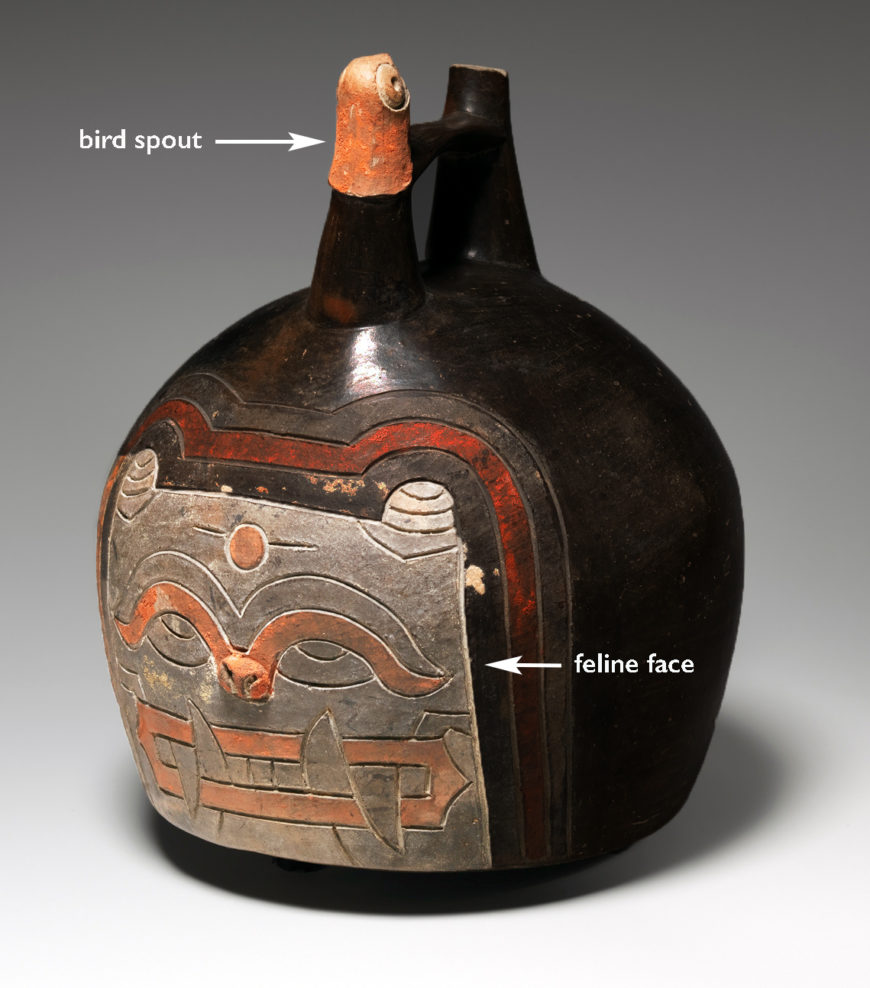
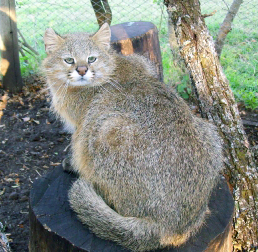
One spout on the Paracas vessel has been rendered as a rounded bird’s head, with large, round eyes and a dot for a pupil. Under the bird spout, the feline face retains the interlocking fangs of Chavín imagery that are seen in their ceramics and stone imagery; however, the irises hanging from the top of the eye have been softened to resemble an upward gaze. The eyes are crowned by curving brows that have lost the angry ferocity of Chavín prototypes.
The rounded ears have incised lines that might reference the stripes of a small, coastal pampas cat rather than the spotted jaguars depicted in the highlands. The design was originally colored by post-fire paint in bright white and red.
These changes will later give way to some vessels that are entirely in the shape of birds, with colorful, interlocking abstract bands and circles illustrating abstract, dappled wing feathers.
The Bird Whistle Spout

In the Metropolitan Museum of Art’s vessel, the Paracans connected sound to the bird’s head. The spout became a sound-maker when liquid was poured, as the fluid’s movement pushed the air inside through a whistle chamber. This effect animated the vessel and added to the sensory experience when it was put to use in a living ceremony, or conceptually in the afterlife. There is abundant material evidence of the importance of music in all areas of the Andes, from the earliest times through the conquest. Flutes made of bird bones were found in the ancient coastal site of Caral.
Shell trumpets appeared in highland Chavín. Ceramic trumpets, gourd rattles, and drums were in use throughout the south coast. Panpipes and whistles appeared on the north coast and throughout the pan-Andean Inka empire (among other instruments). The range of instruments and their extensive use indicate how music, with its ability to alter states of mind, helped create a bridge to the numinous (supernatural or divine forces) in Andean life.
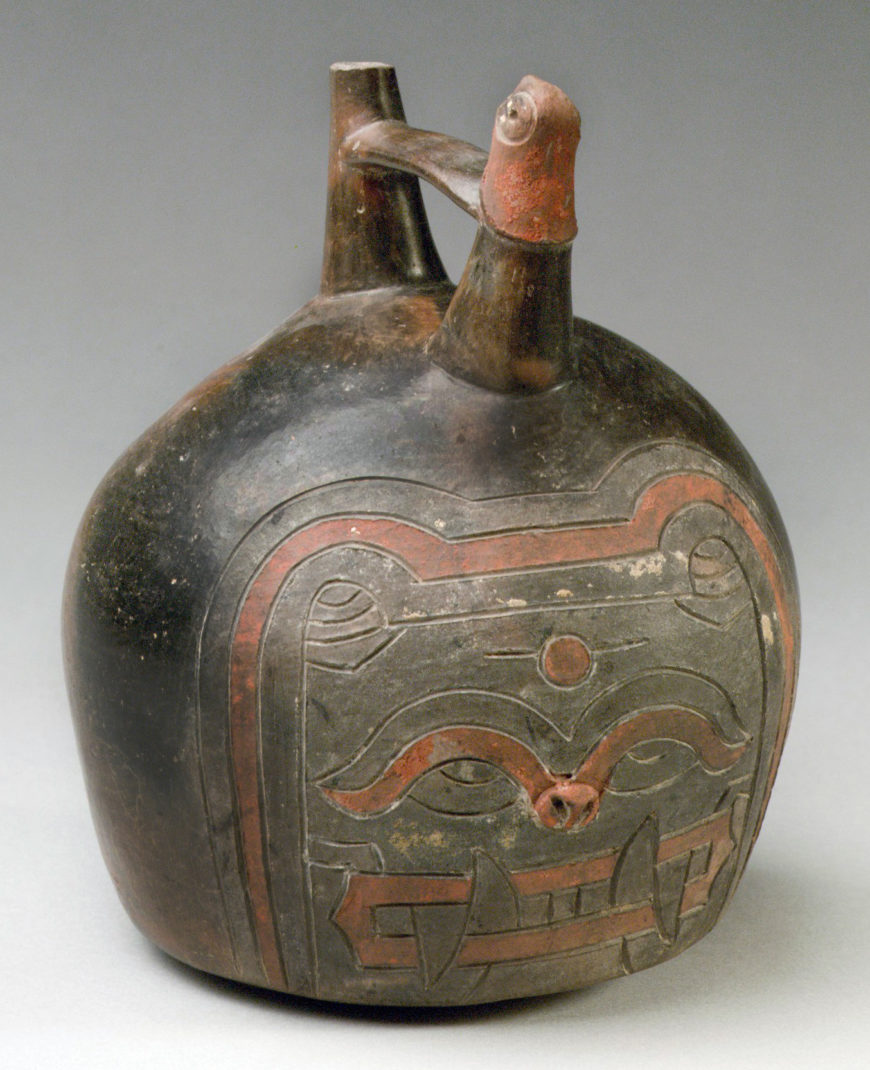
Lessons of the Feline Face Vessel
Ceramics were one of the principal ways Andean cultures recorded their ideas. Further, their techniques, imagery, and form—made possible by easily molded and incised surfaces—are all clues for better understanding cultural exchange and changes within a culture. In the early stages of their ceramic production, Paracans incorporated a foreign ceramic style and feline into their own ideology, yet ultimately modified the image to match both their unique art style and the new ideas emerging in Paracas culture. The bird spout and whistle are particularly notable Paracas innovations. This vessel helps underscore that in the latter part of the first millennium B.C.E., Paracas broke further away from a formerly dominant influence and would continue to develop along a more independent path.
Notes:
[1] Dawn Kriss, et al. “A Material and Technical Study of Paracas Painted Ceramics.” Antiquity, vol. 92, no. 366, 2018, pp. 1492–1510.
Additional resources
Read more about this vessel at the Metropolitan Museum of Art
Alan R. Sawyer, Ancient Peruvian Ceramics: The Nathan Cummings Collection (New York: Metropolitan Museum of Art, 1966).
Music in the Andes on the Metropolitan Museum’s Heilbrunn Timeline
Erin Blakemore, “Ancient pots reveal reptile pee pigments and cultural connections,” National Geographic (2018)
Dorothy Menzel, John H. Rowe, and Lawrence Dawson, Paracas Pottery of Ica: A Study in Style and Time (Berkeley: University of California Press, 1964).
Moche culture
Moche culture, a introduction

A Complex Culture
Moche architects and artists raised spectacular adobe platforms and pyramids, and created exquisite ceramics and jewelry. Their art, unlike that of most Andean cultures, is naturalistic and rich in imagery, inviting us to explore their world.
The Moche culture thrived on Peru’s northern coast between approximately 200 and 900 C.E. Rising and falling long before the Inka, the culture left no written records, and the early Spanish colonists who chronicled the cultures of Peru found the Chimú people in what had earlier been Moche territory. The Moche are a prime example of how archaeologists and art historians use scientific methods of data collection and evaluation in understanding ancient, non-literate cultures.
In the early 20th century, there was very little scientific excavation in Peru. Many art objects that came into museums and private collections were taken from graves and had no record of their original context. Based on this limited knowledge, scholars thought that the Moche had been a unified state that held sway over a large swath of the north coast, from near the border with modern-day Ecuador in the north to the Huarmey river valley to the south (Huarmey is approximately 180 miles north of the modern capital city of Lima). This conclusion was based on the similarity of ceramic and metal artworks being found throughout the range.
Not a single unified political entity
As modern scientific archaeology began in the area, it became clear that the Moche were not a single, unified political entity. Archaeologists and art historians began to see that differences in style and iconography could be determined between areas. Architectural structures were different at different sites. In addition, carbon dating allowed scholars to understand that some styles of pottery could be from one time frame in one river valley, while being associated with a completely different time frame in another. As more data was accumulated, hypotheses were tested and the conception of the Moche was revised and reassessed. What emerged was a vision of the Moche as politically independent groups who shared a common ideology, mythical and religious beliefs and practices, as well as a common iconography for their artwork.
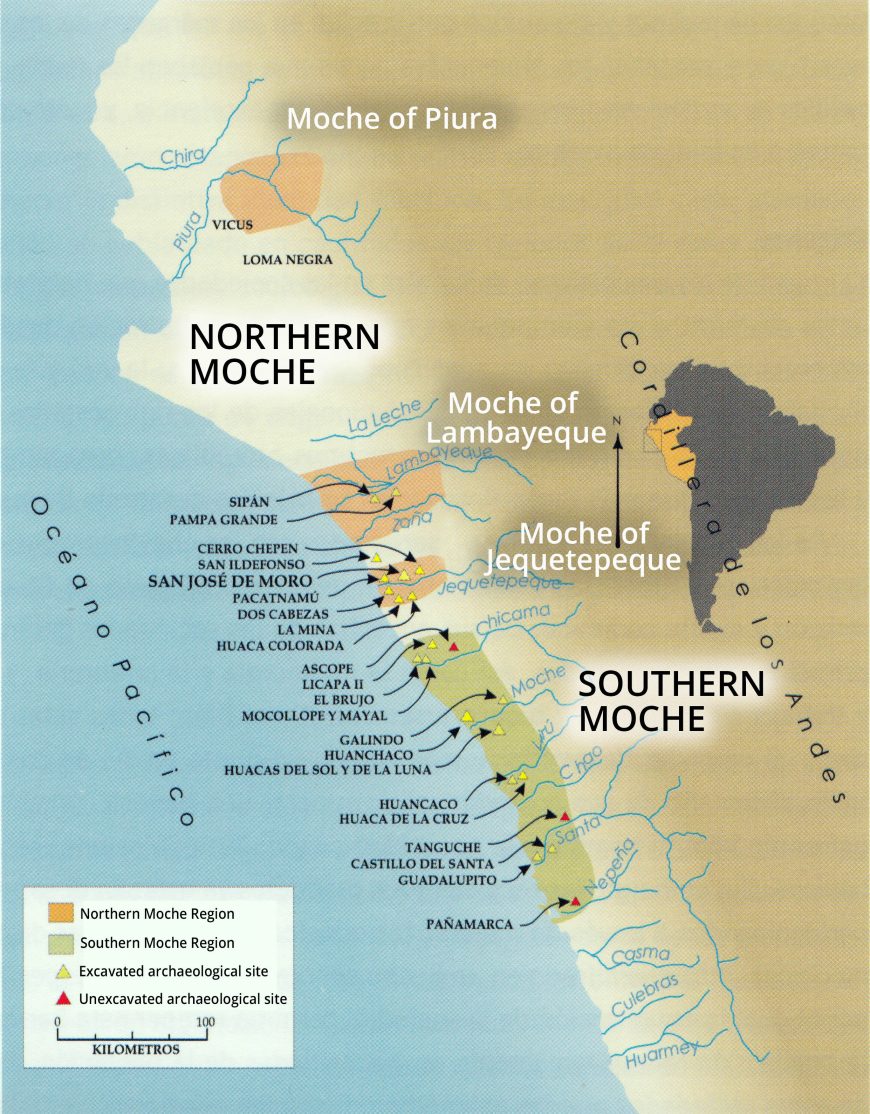
Independent areas (sometimes as large as a pair of river valleys, sometimes as small as one section of a single valley) would signal that they belonged to Moche culture by using Moche themes in their artwork, while at the same time asserting differences—in architecture, in iconographic style, and in which figures from the mythology were deemed important. In this way, separate Moche polities could express both their political independence as well as their sense of belonging to a larger cultural system. The biggest separation of Moche style and iconography splits them into northern and southern areas (see map above), which can then be subdivided into smaller, politically independent areas.
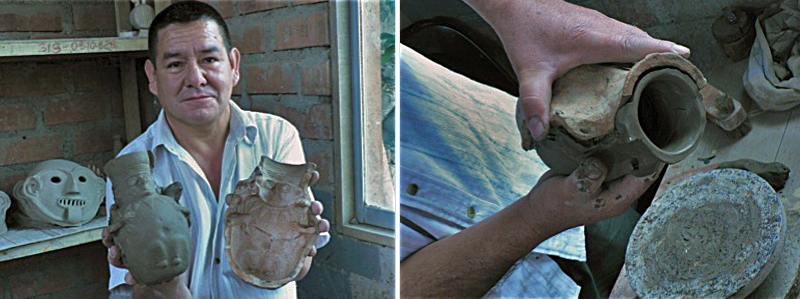

North-South Differences
The Southern Moche tended to be expert ceramicists—producing a large amount of fine, thin-walled vessels painted in slip. Moche artists used only three colors—cream, red-brown or red-orange, and black to decorate their ceramics. Many Moche ceramics were made using molds, and so we have many duplicate pieces. The ability to control imagery through the use of molds seems to have been important to the political elites of the Moche.
Early Moche vessels are very sculptural, depicting humans, supernatural figures, animals, and plants in a great variety. Later Moche ceramics feature complex line drawings of similar subject matter (called fineline style). The Moche often used a distinctive spout on their vessels, called a stirrup spout. It is composed of a hollow tube of clay bent into an upside-down U shape, with another tube piercing it at the apex of the curve (see images below). This spout form has ancient origins in the Andes, and it seems possible that the Moche deliberately chose this form to echo its use in during the earlier Cupisnique (1500-500 B.C.E.) and Chavín (900-200 B.C.E.) cultures. Fine ceramics would have been used as gifts from the highest elites to the lower elites and middle classes, helping to cement the social bonds that supported the power that the elites held. Fine ceramics have been found in households, and the pieces in graves show evidence that they had been used.

The Northern Moche are celebrated for their metalwork, especially the exquisite pieces found in the tombs of Sipán in the Lambayeque valley. Working in gold and silver, Moche artists were adept at hammering, soldering, and setting stones, as well as developing a process to make a copper-gold alloy appear to be solid gold—a technique known as depletion gilding. Gold, silver, semiprecious stones and Spondylus shell were used to make the elaborate regalia of the highest elites. Massive necklaces and bracelets, ear spools, headdresses, nose ornaments, and more were made by Moche artists for the great lords. While there certainly were skilled ceramicists in the north and able metalsmiths in the south, the general division of materials between these two areas helps define some of their differences. Both areas also would have had weavers producing fine textiles, but few examples have survived.
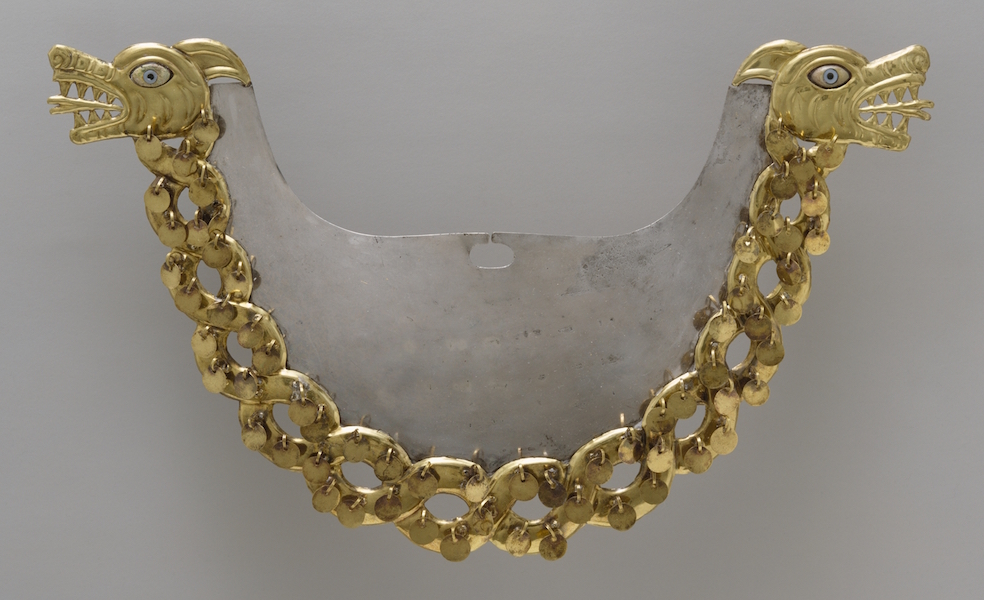
Iconography, Ideology, and Human Sacrifice
Early scholars assumed that armed conquest was the mechanism of power for the Moche state and Moche art certainly has a great deal of imagery relating to armed combat. However, it now appears that only some Moche expansion was due to military action. Other areas seem to have simply been colonized in uninhabited areas, or Moche culture was adopted by local elites who were impressed by the ideology. The imagery of combat is, in large part, related to that ideology, but not as a call to conquest. Instead, it seems that a lot of Moche combat imagery has ritual meaning. It focuses on hand-to-hand combat between two individuals, using cone-headed clubs as weapons and small shields for defense. Interestingly, this ignores what we know archaeologically about Moche warfare—which included the use of spears and darts propelled by throwing sticks, as well as slings used to propel stones with astonishing force. The Moche artwork, in other words, tells us one thing about their culture but omits other things. We can think of this as a form of propaganda—emphasizing the ritual aspects of Moche elite power rather than the more practical aspects of war. Moche art and archaeology also tell us what the point of this hand-to-hand combat was.
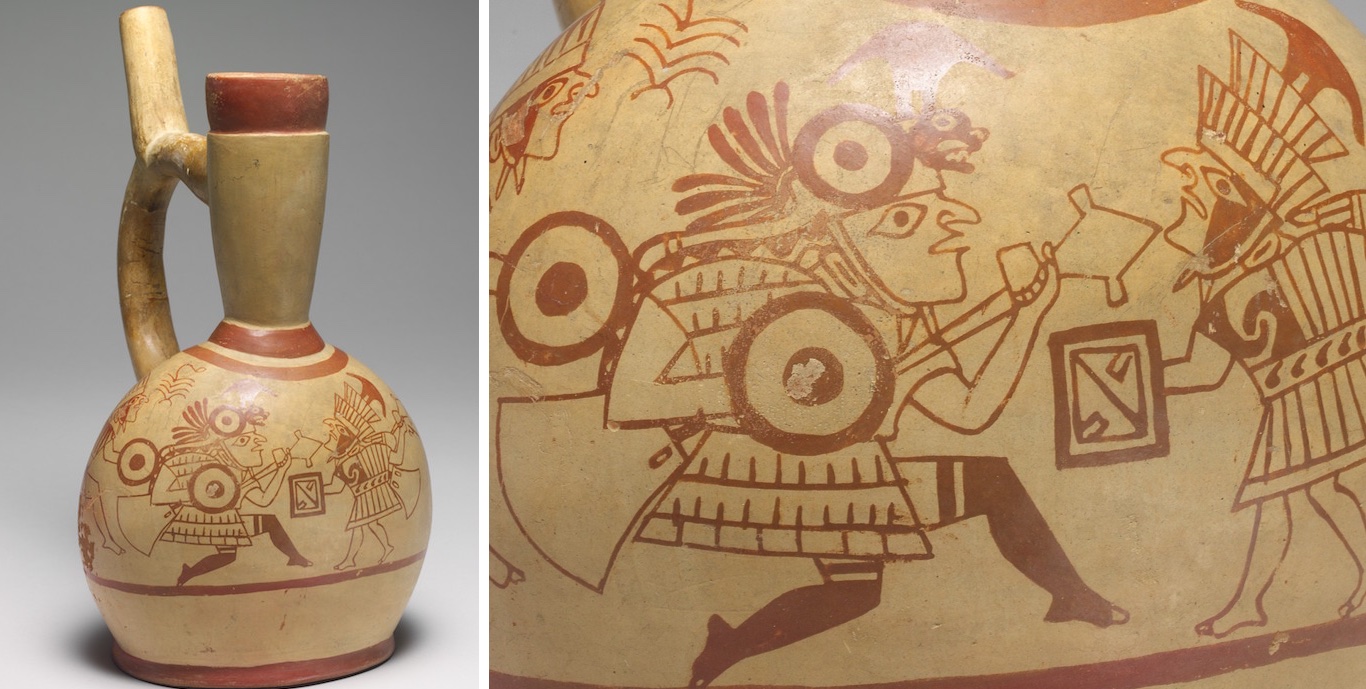
In the art, we see victorious warriors knocking the helmet off of their foe, sometimes bloodying their nose in the process. The defeated warrior is then stripped of his armor and clothing. With a rope tied around his neck, he is led by the victor, who carries the armor and clothing in a bundle to signify his victory. The defeated warriors are eventually sacrificed in an elaborate ritual, their necks sliced and blood collected, to be drunk by figures that are dressed in the costumes of gods.
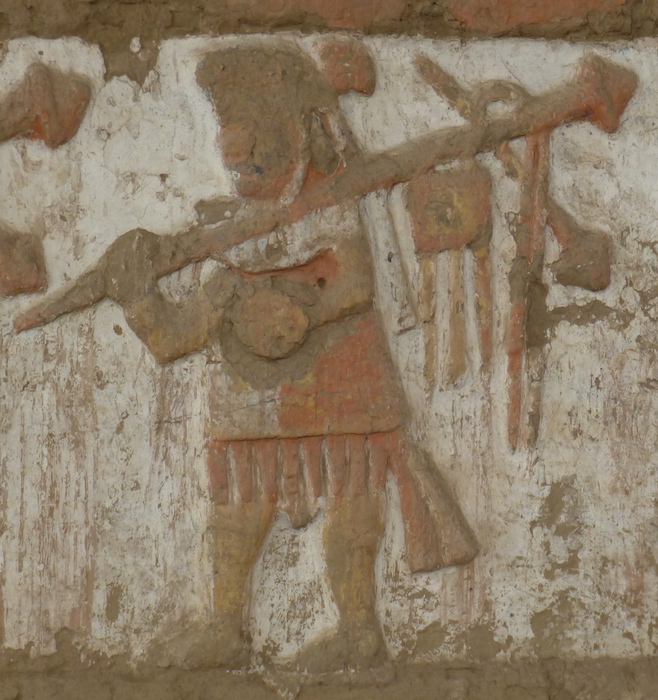
Archaeologists have uncovered three sets of sacrificed prisoners at the site of Huaca de la Luna in the Moche river valley. These large-scale sacrifices took place at different times over the course of hundreds of years. The skeletons show signs of having undergone combat, as well as having had their throats slit. These remains seem to show that what is depicted in the art was also carried out in life (at least these three times). Whether smaller-scale sacrifices related to this imagery took place is still being investigated, at Huaca de la Luna and other large Moche sites. The continued archaeological exploration and analysis of Moche artworks will help researchers to further understand this complex culture.
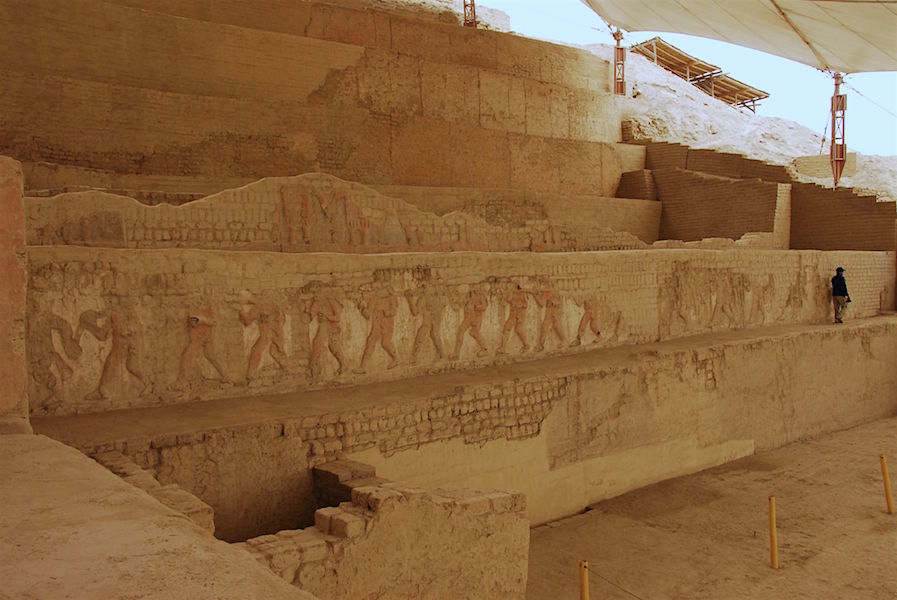
The Moche Royal Tombs of Sipán
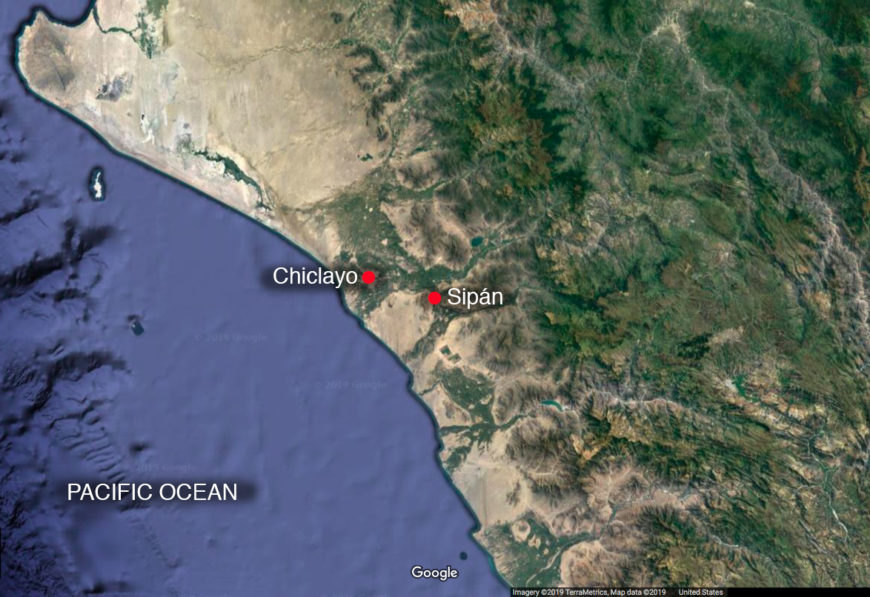
A golden discovery
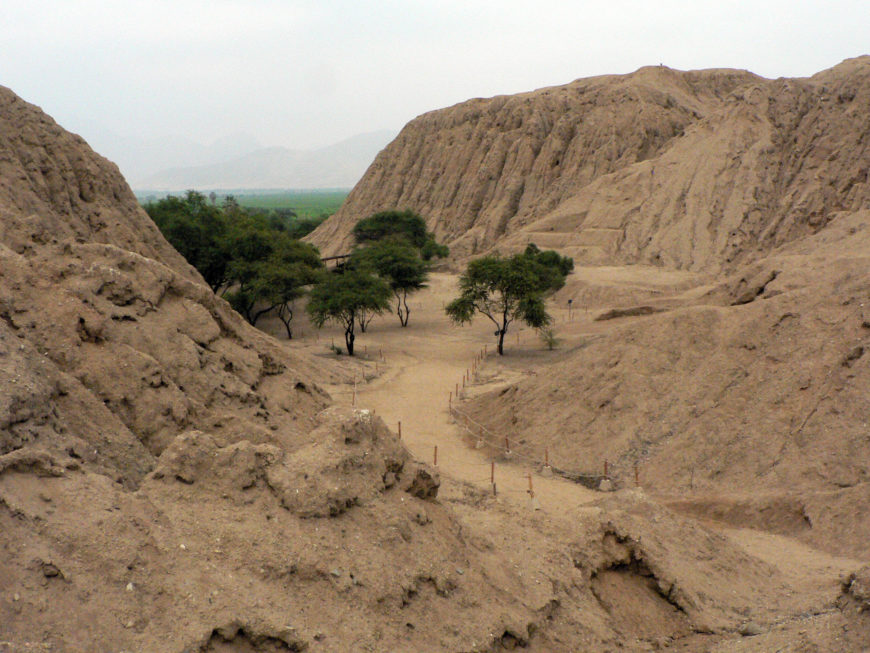
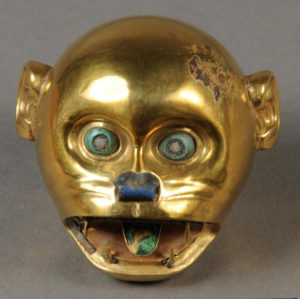
In 1987, Peruvian archaeologist Walter Alva received a tip from the police that local villagers had discovered gold in one of the huacas (a term for ancient sacred sites used widely in Peru) and were looting artifacts at the site of Huaca Rajada in the town of Sipán, near the modern city of Chiclayo on Peru’s northern coast. Recently, the local textile factory that had employed much of the town had suddenly shut down, and impoverished villagers turned to their local huaca for items to sell on the black market, largely driven by wealthy elites in the United States and Europe.
When Alva arrived at the scene, he discovered a rich Moche burial ground in Huaca Rajada, with some of the finest metalwork and ceramic pieces ever seen. This fateful night initiated an extensive archaeological excavation of the site over a period of nearly two decades, and excavation of the area continues today. The site has yielded over thirteen royal tombs, making it the richest burial site in the Western hemisphere.
This archaeological discovery was significant not only for the remarkable items contained within it, but because the tombs were found almost completely undisturbed due to the swift intervention on the part of the local police. Looted artifacts have been stripped from their archaeological context, making it very difficult for scholars to understand their original function and meaning.
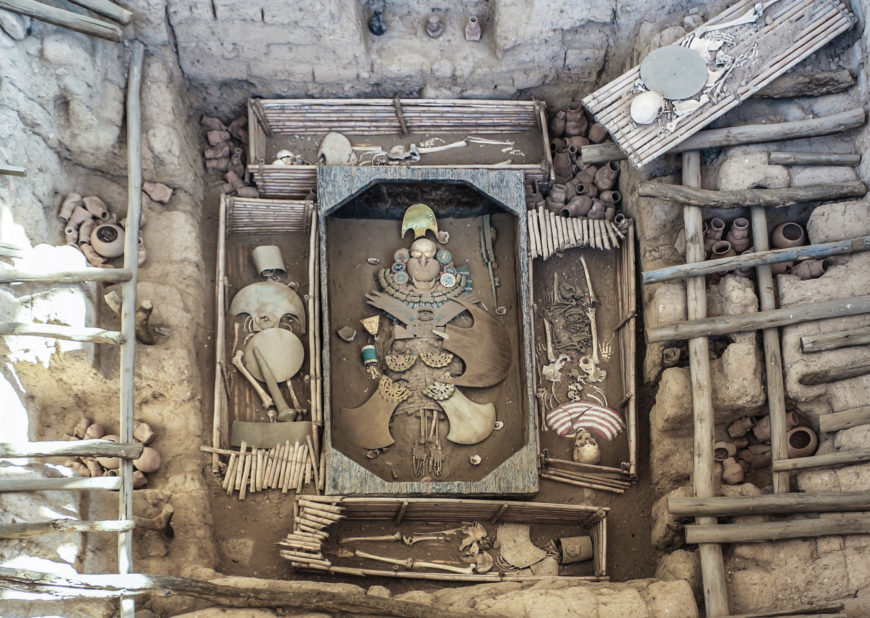
Lords of Sipán
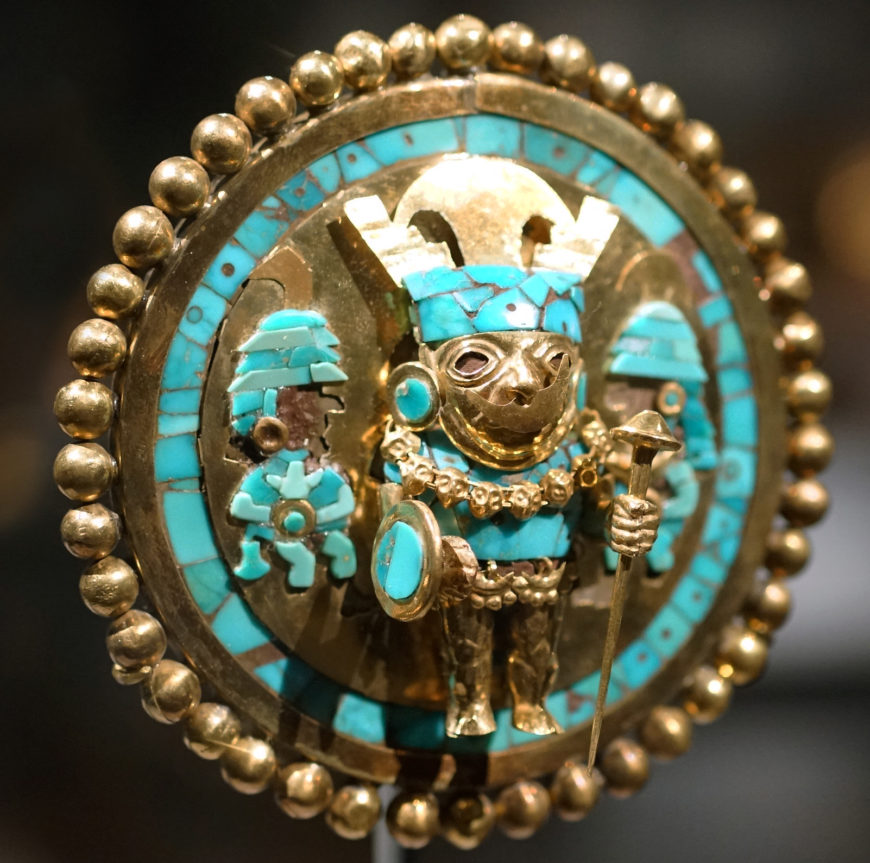
The thirteen burials and all of their associated artifacts were discovered in situ (in their original place), enabling archaeologists to associate specific objects with the buried individuals.
The largest burial was devoted to the individual the archaeologists named the Lord of Sipán, who was interred with 451 objects of gold, silver, copper, and turquoise. The quality of objects associated with the Sipán burials is superb, and would have required a massive and specialized workforce to create.
Among the objects found in the tomb were a pair of elaborate earflares depicting warriors, as well as another pair with deer, and others featuring geometric designs.
In the tomb of the Old Lord of Sipán (so called because archaeologist believe it is probably an ancestor of the Lord of Sipán), a resplendent necklace was found, composed of beads over three inches in diameter that feature a spider whose body markings resemble a human face and warrior’s helmet, emphasizing the relationship between warfare and sacrifice in the Moche world (spiders, which ensnare and devour their prey, were associated with rituals featuring the sacrifice of bound prisoners, as well as a god that some modern scholars have called the “Decapitator”).
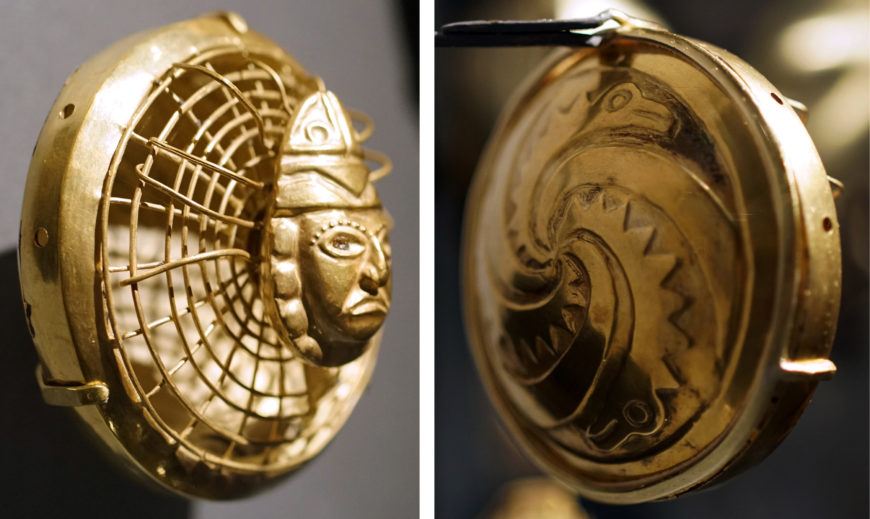
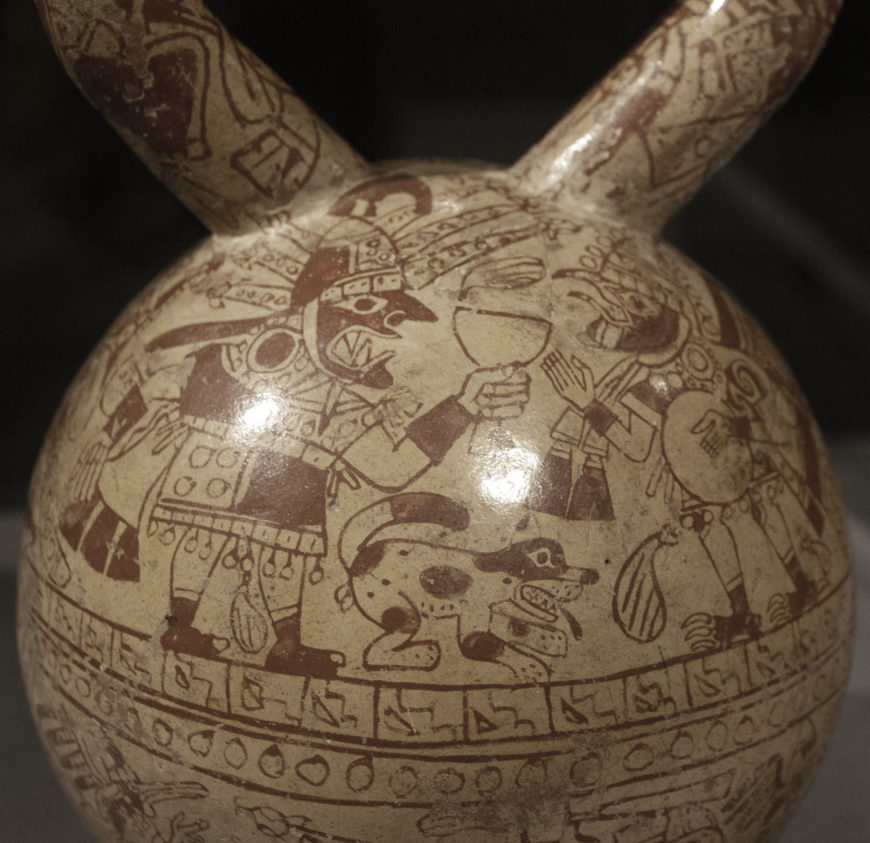
By discovering the tombs in their original context, archaeologists were also able to make an even larger discovery about Moche art as a whole. The Sacrifice Ceremony, found painted on ceramics and the walls of temples in parts of the Moche world, attained greater meaning after the Sipán discoveries.
The Sacrifice Ceremony involves the ritual sacrifice of prisoners, whose blood is collected in goblets and presented as an offering to the Warrior Priest by his entourage. While the images vary across media, all of the Sacrifice Ceremony scenes frequently include the figures scholars have dubbed the Warrior Priest and the Owl Priest, often accompanied by a Priestess and other figures.
The Sipán excavations revealed that these figures were not merely mythological characters, but were connected to real humans who were buried in regalia similar to those in the painted representations.
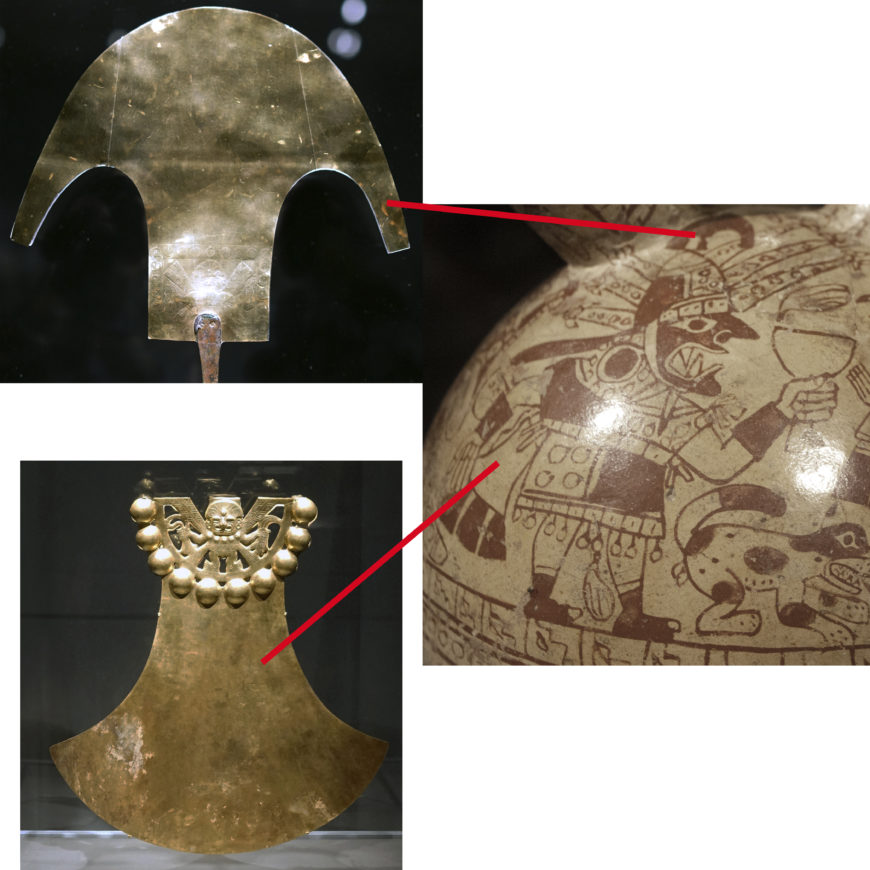
By cross-referencing the tombs and their contents with Moche iconography, the Sipán burials allowed scholars to gain a better understanding of how the characters may have been a part of elite symbols of power and prestige. While the ensembles in the Sipán tombs do not directly correlate to the costumes seen in the Sacrifice Ceremony, they contain many similar elements, showing how some Moche elites identified themselves with the major actors in the Sacrifice Ceremony. At another Moche site, San José de Moro, elite women over many generations were buried with objects that identified them with the Priestess of the Sacrifice Ceremony.
A golden return
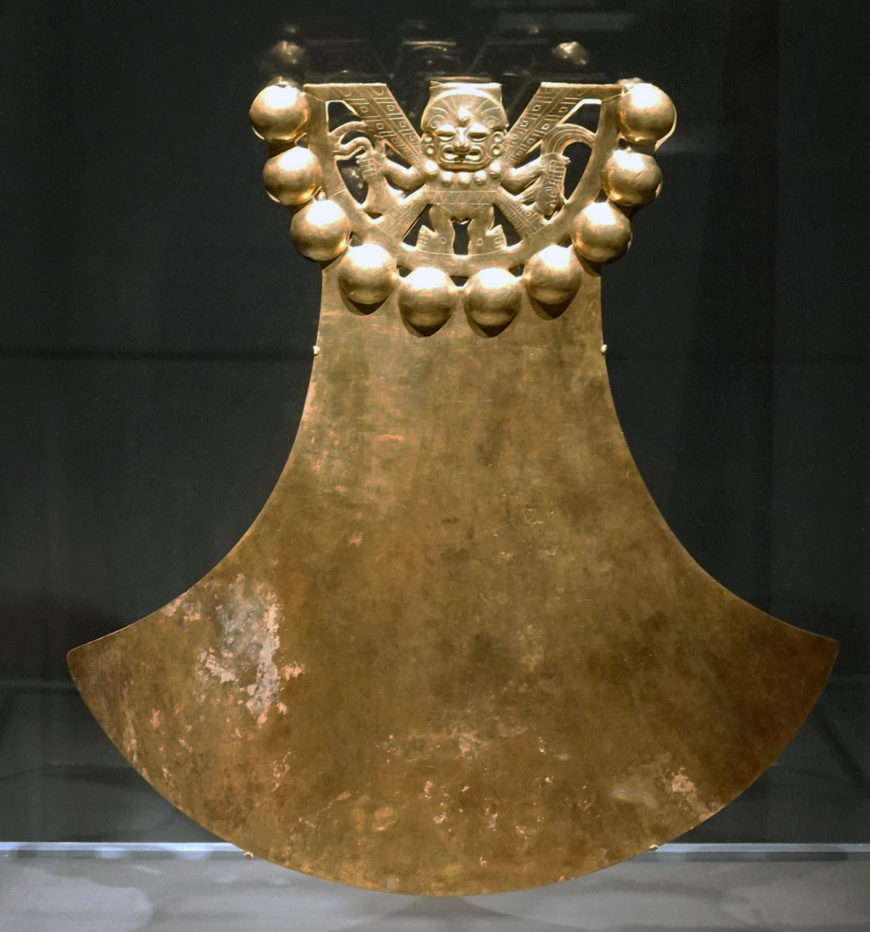
This gold backflap, an article of clothing hung from the belt and perhaps meant to protect the lower back, was part of a warrior’s costume in Moche art. This example is topped with a depiction of the Decapitator, who holds a ceremonial knife called a tumi in his right hand, and a severed human head in his left. The backflap’s overall shape echoes the shape of the tumi. The half-spheres surrounding the Decapitator are actually rattles, enclosing within them small pellets of metal that would have made sound as the person wearing the backflap moved.
The backflap was one of the items originally looted from the Huaca Rajada in 1987, and was trafficked out of the country sometime between 1995 and 1997. In 1997, undercover FBI agents purchased it in a sting operation that took place in a rest stop along the New Jersey Turnpike. On July 15, 1998, the FBI held a ceremony to officially return the backflap to Peru, and it is now in the Museo de la Nación in Lima. The items excavated from of the Sipán tombs are housed in the Museo Tumbas Reales de Sipán in nearby Chiclayo.
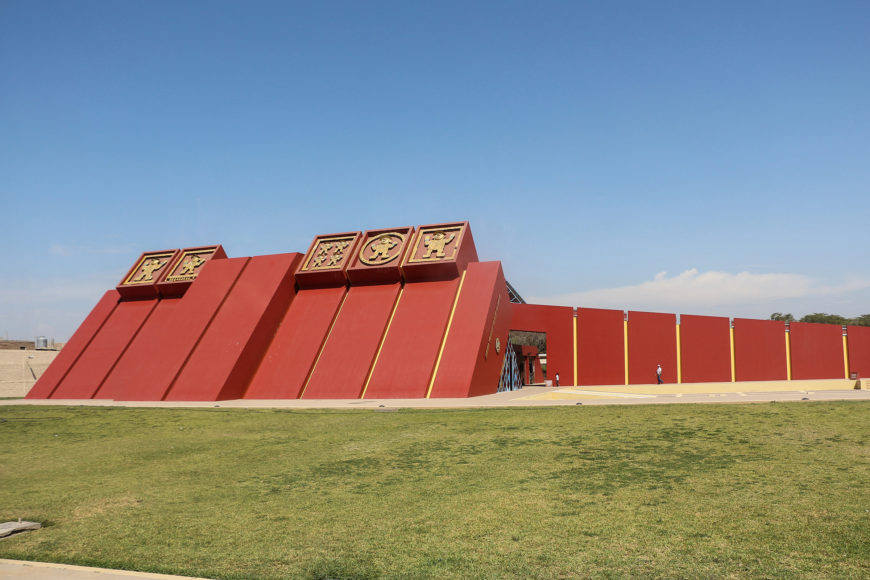
Additional resources
Sidney Kirkpatrick, Lords of Sipan: A tale of pre-Inca tombs, archaeology, and crime (New York: Morrow, 1992).
Read more about Moche iconography from Dumbarton Oaks
Read about the FBI involvement in recovering the backflap
Read more about Moche ceramics at the Metropolitan Museum of Art
Daniel Radthorne, “Poverty, Pots, and Golden Peanuts,” Prospectus (2011)
Walter Alva and Christopher B. Donnan, Royal Tombs of Sipán (Los Angeles: Fowler Museum, 1993)
Pair of Earflares, Winged Messengers
Video \(\PageIndex{5}\): Pair of Earflares, Winged Messengers, 3rd-7th century, Moche, Peru, gold, turquoise, sodalite, shell, 8 cm (The Metropolitan Museum of Art)
Smarthistory images for teaching and learning:
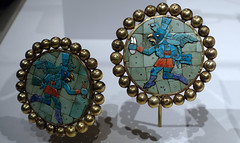
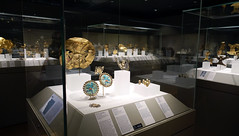

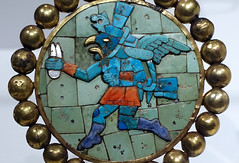
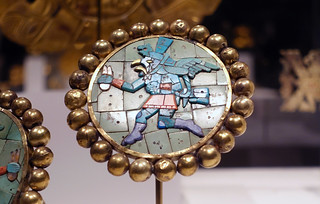
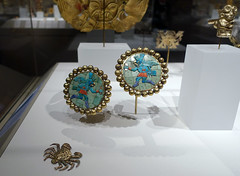
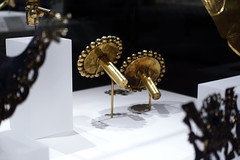
Moche Portrait Head Bottle
Video \(\PageIndex{6}\): Portrait Head Bottle, 5th–6th century (Moche culture), Peru, ceramic, 32.39 cm high (The Metropolitan Museum of Art)
Tiwanaku
Tiwanaku, an introduction
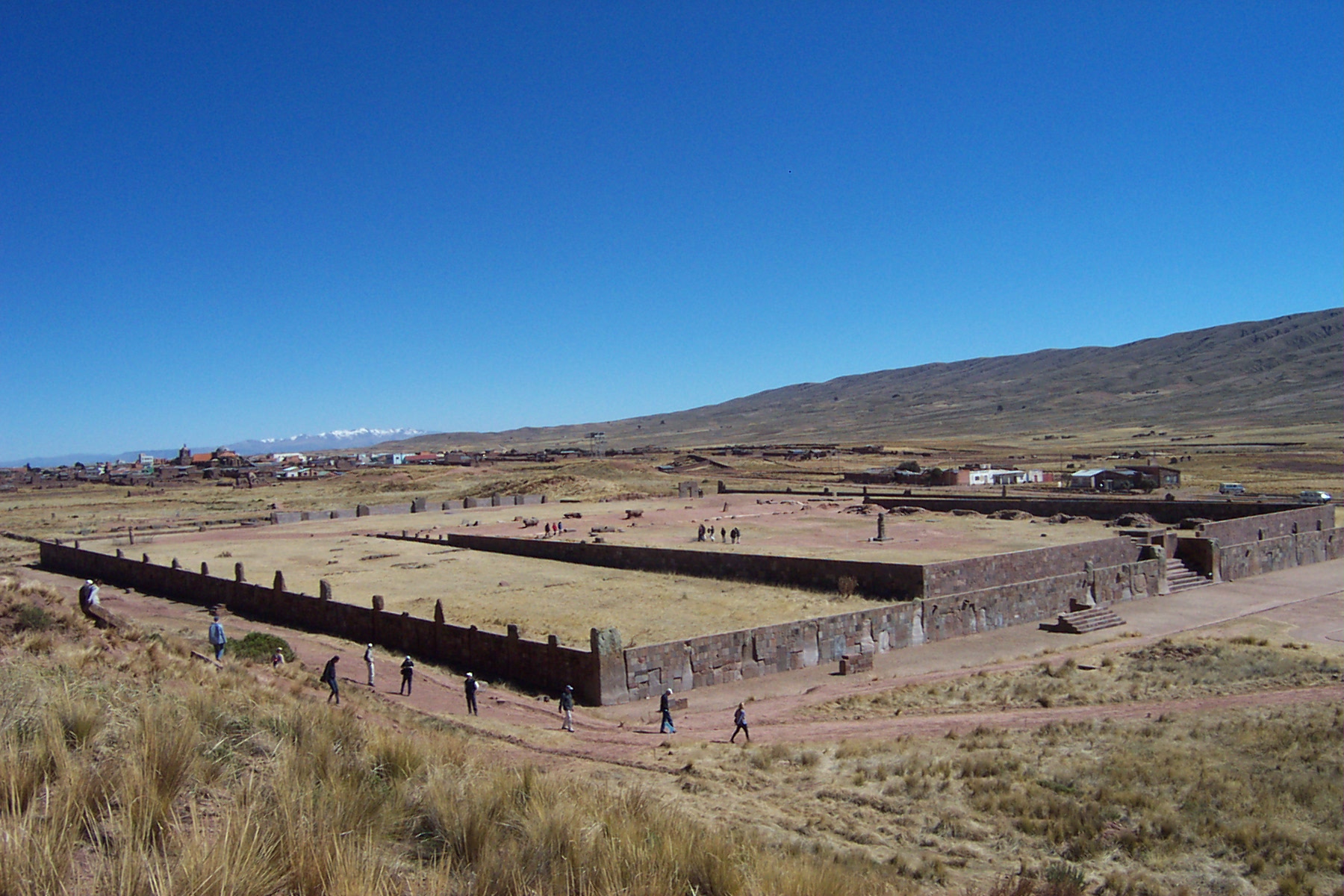
The Sacred Center of Tiwanaku
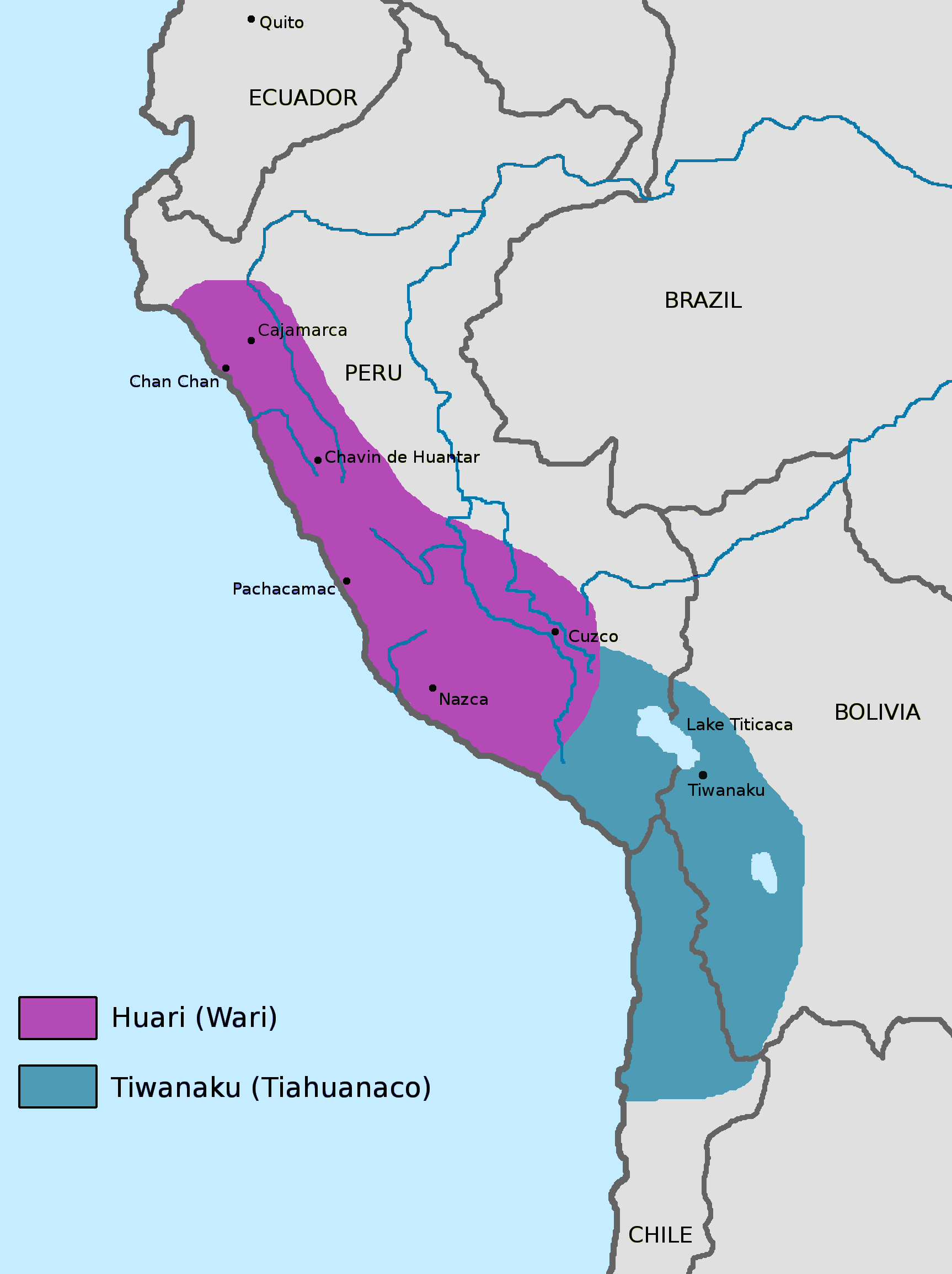
The north coast of Peru was not inactive after the fall of the Moche around 800 C.E. The Lambayeque and Chimú cultures that succeeded them built impressive monuments and cities. In fact, the Chimú civilization dominated nearly the entirety of the north coast of Peru for over 400 years until they were conquered by the Inka empire in 1470. Exciting cultural and artistic developments were also occurring in the highlands at around the same time that the Moche, Lambayeque, and Chimú cultures dominated the north coast.
The Tiwanaku civilization (200–1100 C.E.) was centered in the Lake Titicaca region of present-day southern Peru and western Bolivia, although its cultural influence spread into Bolivia and parts of Chile and Argentina. Tiwanaku’s main city center boasted a population of 25,000–40,000 at its peak, consisting of elites, farmers, llama herders, fishermen, and artisans. Its ceremonial center featured a tiered pyramid called the Akapana, and a temple complex (the Kalasasaya).
Gateway of the Sun
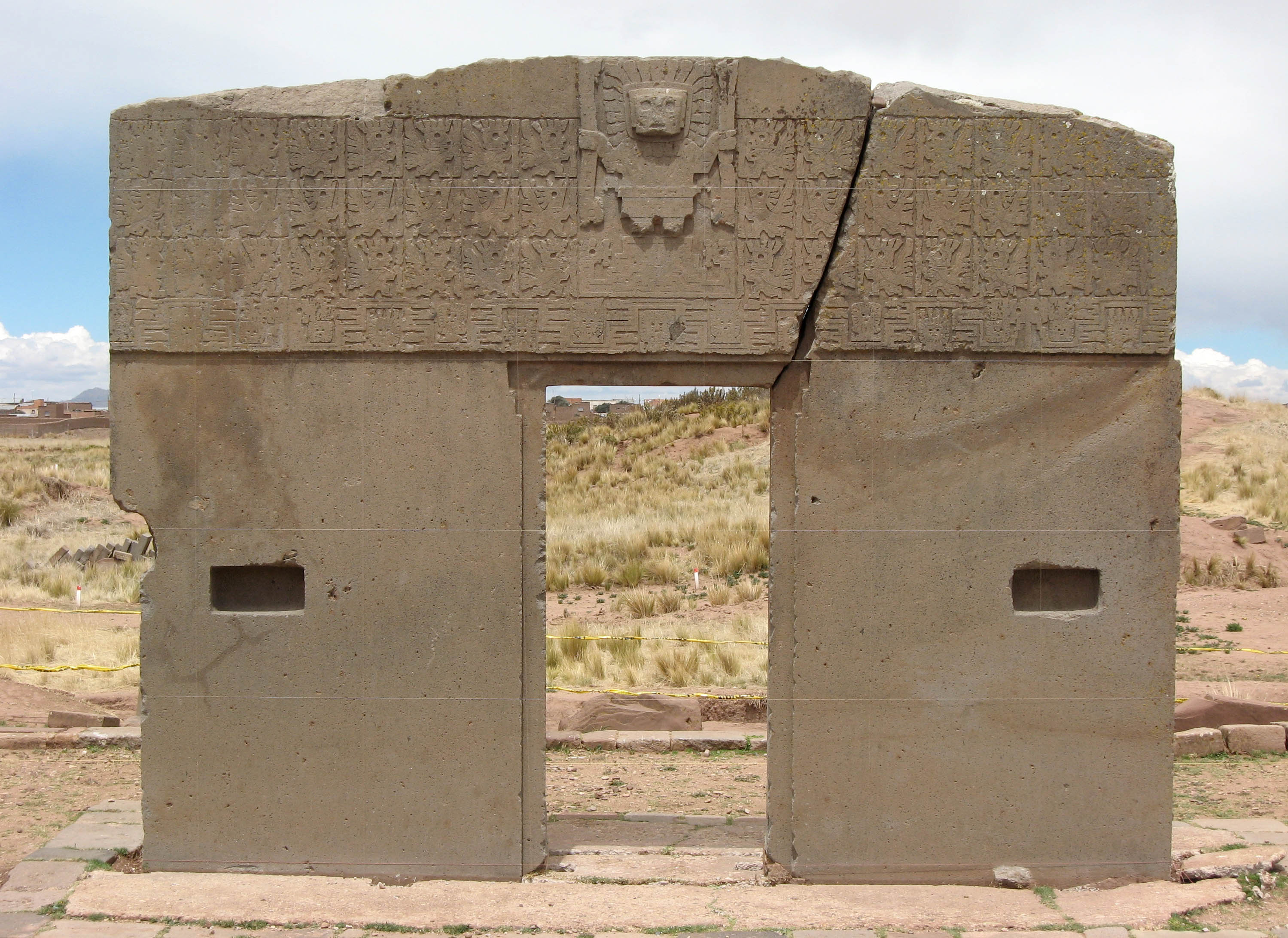
The people of Tiwanaku were skilled engineers and masons, producing impressive stone buildings and monuments. Perhaps one of the most iconic works of Tiwanaku public architecture is the Gateway of the Sun, a monolithic portal carved out of a single block of andesite. The monument was discovered in the city’s main courtyard and may have originally served as the portal to the Puma Punku, one of the city’s most important public shrines. The Gateway contains low relief carvings across the lintel set into a square grid. At the center of the lintel is Tiwanaku’s principal deity.

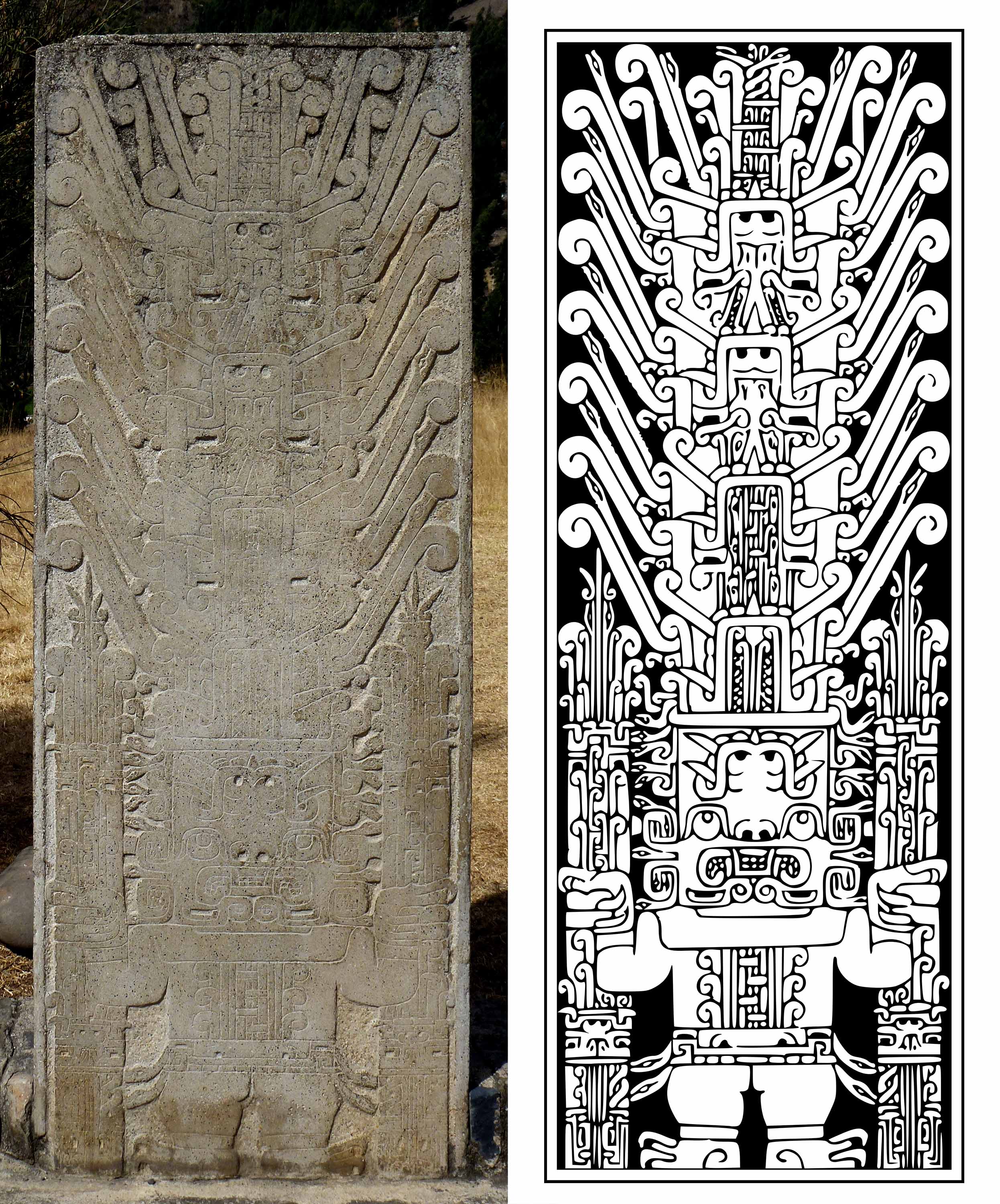
The figure is faced frontally, holding two implements terminating in bird heads, perhaps representing a spearthrower and spears. He wears an elaborate tunic decorated with human and animal faces. The eyes of the figure bear the characteristic Tiwanaku stylized teardrop—a winged feline that hangs down from the eye to the bottom of the face. Tendrils of hair emanate in rays from the head, terminating in feline heads and circles. Composite human-bird deities flank the central figure on both sides.
As many scholars have pointed out, the deity represented on the Gateway exhibits a number of similarities to the deity in the Raimondi Stele at Chavín de Huantar. Both stand frontally and carry a staff in each hand, grasping them in precisely the same manner. Their rayed headdresses/hairstyles extend outward in zoomorphic (animal-like) tendrils. The square, mask-like quality of their faces endows the deities with an ominous quality.
Archaeologists speculate that the doorway was originally brightly painted and inlaid with gold; thus, it is important to remember that the “pristine” and unadorned state of the ancient monuments we see today often bear little relationship to their original appearance.
Relationship with Chavín
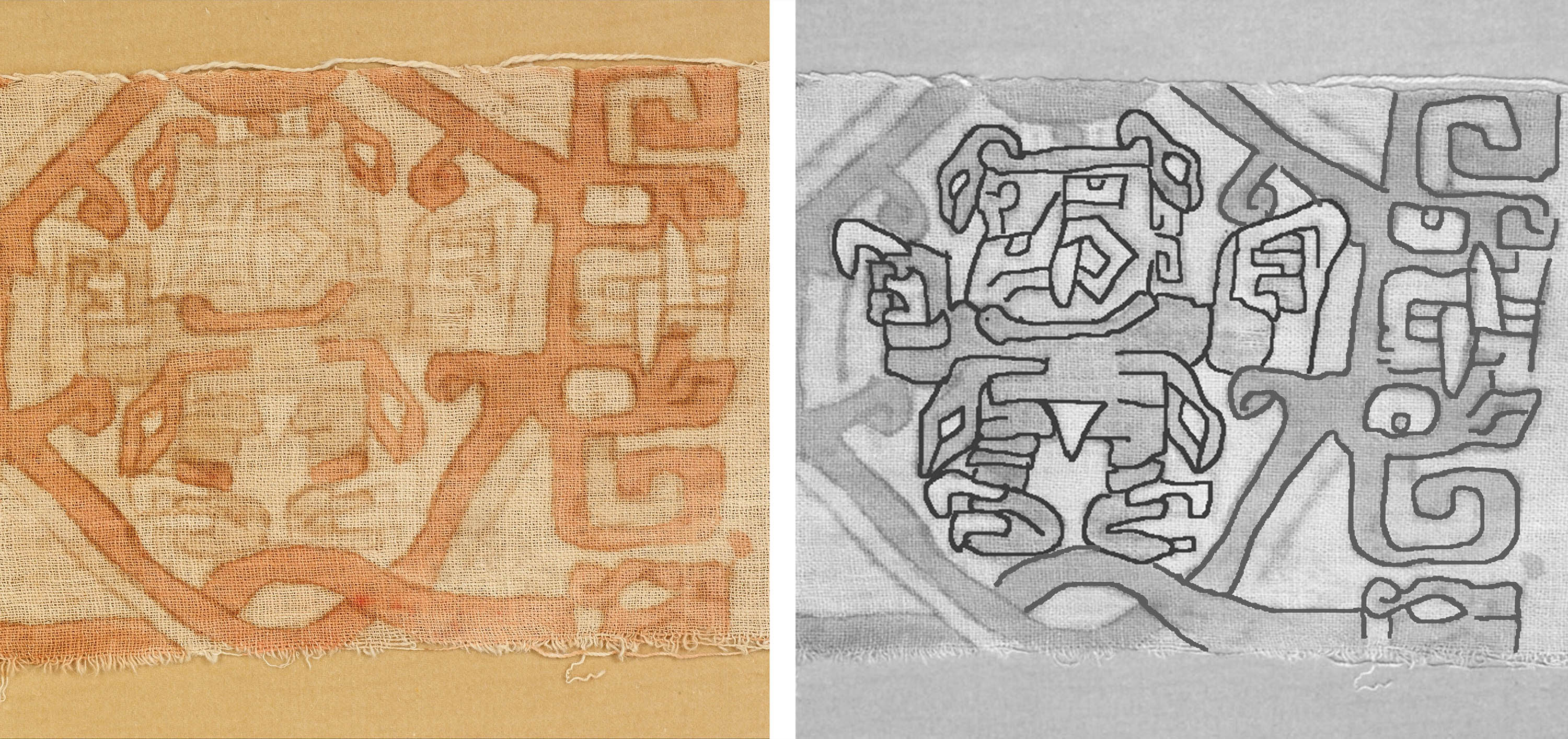
Adopting elements of Chavín iconography may have been a strategy for the Tiwanaku people to assert ancestral ties to the great early highland civilization. In the absence of a written language, images played a vital role in the transmission of ideas and values across space and time. Although the Chavín civilization had long succumbed by the time Tiwanaku reached its fluorescence, Chavín iconography traveled across the Andes through textiles and other portable objects, becoming continually reinterpreted and reinvented by each culture that came into contact with it.
Textiles and ceramics
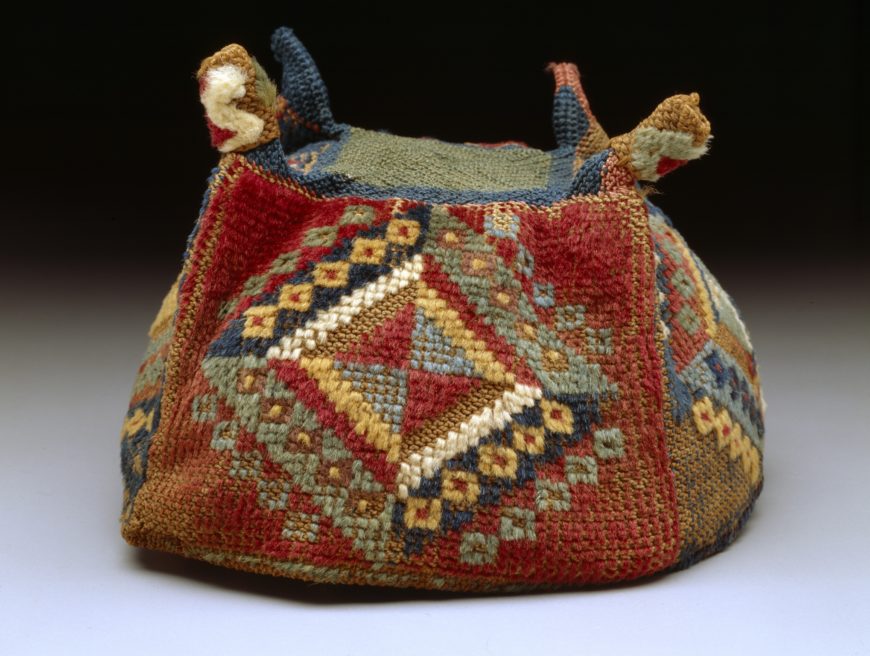
While monumental stone structures and sculpture are the hallmarks of Tiwanaku art, smaller works in textile and ceramic of refined quality were also produced. Like the Wari, Tiwanaku men of high rank wore intricately designed four-cornered hats, brightly colored and decorated with geometric designs. In the example above, the overall diamond shape of the design has been divided into four sections, which is often a reference to the four cardinal directions. The rich red and blues come from difficult and expensive dyes, further emphasizing the wealth and power of the man who wore it.
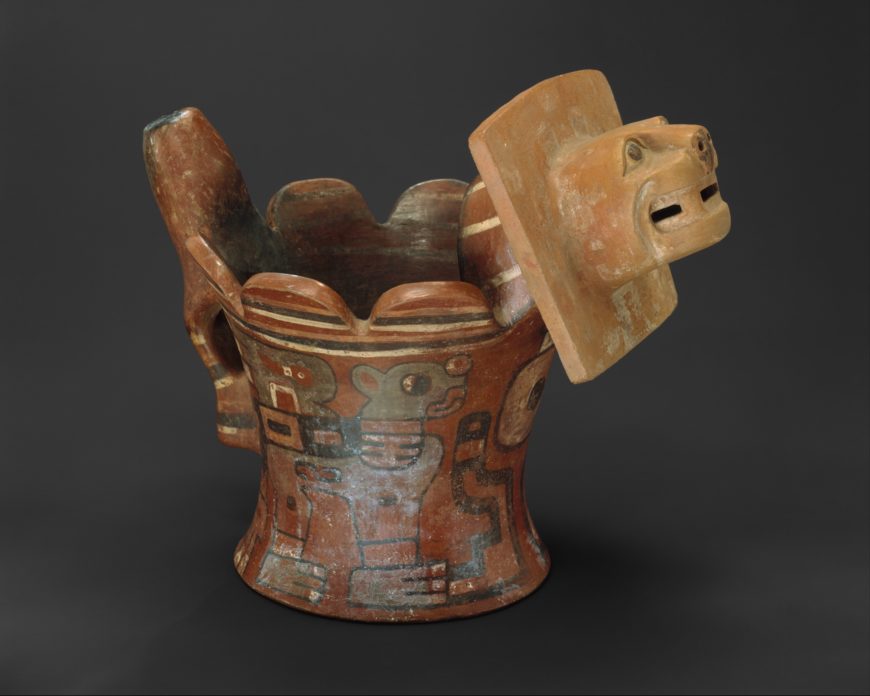
Tiwanaku ceramics, like the incense burner above, feature clean, somewhat blocky forms and surface decoration that echoes the aesthetic seen in stone sculpture, like the Gateway of the Sun above. A bold, black outline and flat areas of color characterize the painting. Here, an abstracted winged feline can be seen, with an eye divided down the middle between black and white, another typical element to Tiwanaku ceramic decoration. The painted feline head is rounder and more simplified than the sculpted one, which features more naturalistic, expressive eyes and an open mouth with prominent fangs.
Additional resources
Read more about the Staff God at Chavín de Huántar
Margaret Young-Sánchez et al., Tiwanaku: Ancestors of the Inca (Denver: Denver Art Museum, 2004)
Jean-Pierre Protzen and Stella Nair, “On Reconstructing Tiwanaku Architecture,” Journal of the Society of Architectural Historians 59, no. 3 (Sep., 2000), pp. 358–371
“Central and Southern Andes, 500–1000 A.D.” on the Met’s Museum Timeline
Semi-subterranean Court at the site of Tiwanaku
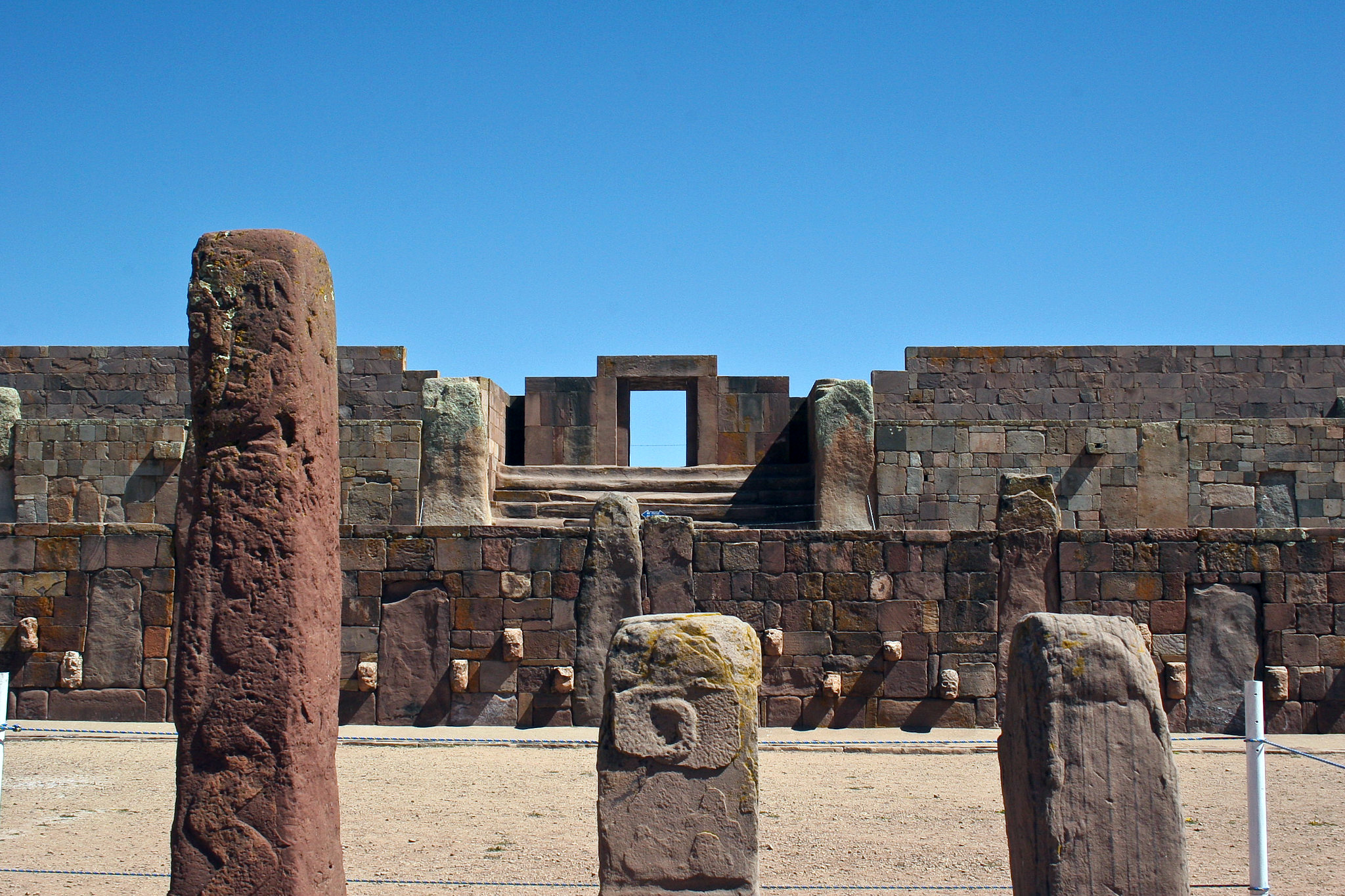
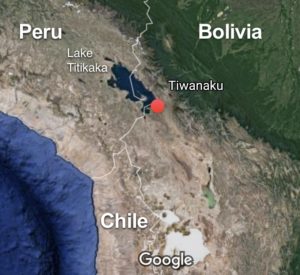
From approximately 200 to 1100 C.E., Tiwanaku, near Lake Titicaca in present-day western Bolivia, was the center of a civilization whose influence spread as far as southern coastal Peru and northern Chile.
At its height, the site was home to up to 40,000 people and was centered around a ceremonial center featuring several monumental stone structures, including the Semi-subterranean Court, which is the oldest of these structures, and used for over 1,000 years before the decline of the Tiwanaku civilization.
The experience of entering this court is a bit like entering an architectural time capsule. All its various features are visual representations of the ways the site’s inhabitants drew on older local cultures, adopted those from afar, and created their own variations to establish a unique culture. It is a fascinating window into the worldview and religion of the inhabitants through the centuries.
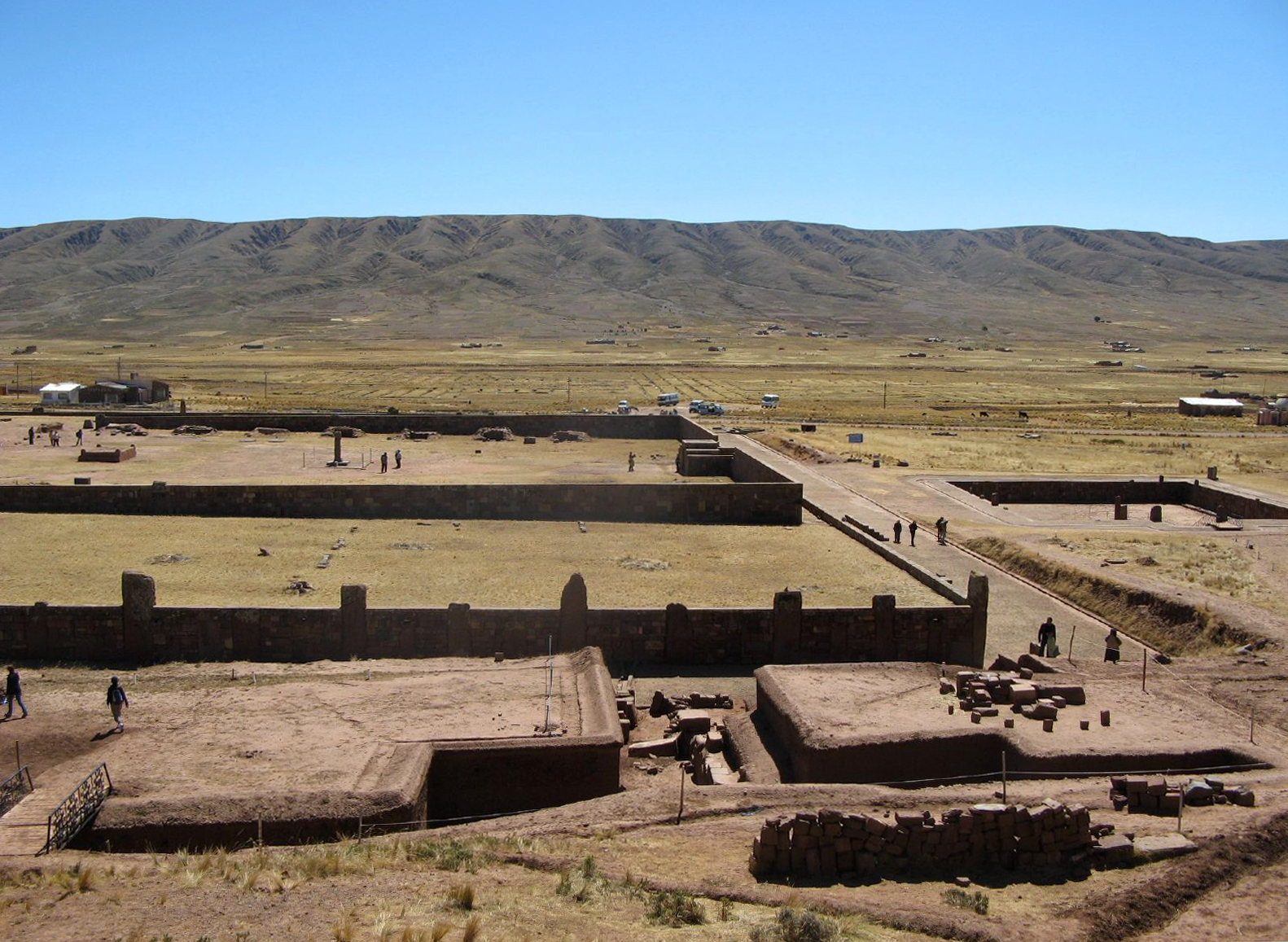
Location
Like most large cities, Tiwanaku had a central “downtown” area where the largest and most important buildings and structures are located. It is most often referred to as the ceremonial core due to its placement at the center of the site and the identification of most of the buildings as sites for important religious and political ceremonies. These buildings were constructed over the course of the site’s history, and some which were not in current use were even partially taken apart so the stones could be used in newer ones.
By the time Tiwanaku began to decline as a state, the ceremonial core had numerous buildings, platforms, and courtyards, the largest and most important being the Semi-subterranean Court, the Kalasasaya and Putuni Complex (a combination of raised platforms and courtyards), the Akapana (a complicated mound structure believed to be a recreation of the Quimsachata mountains), and a later temple complex, the Pumapunku.
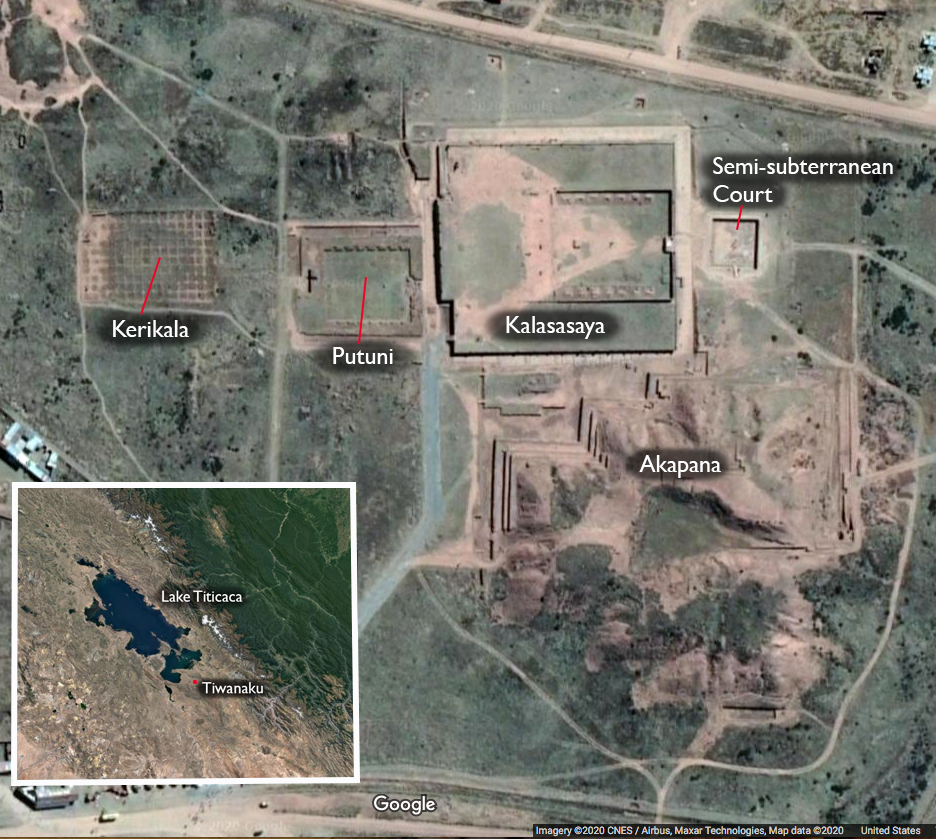
Structure and design
The Semi-subterranean Court is a square courtyard approximately ninety-one feet long and eighty-five feet wide, completely open to the sky. Its four stone walls were built approximately six feet down into the earth rather than upwards. Entered via a flight of steps worn down by centuries of use, the space gives the sense of standing at the boundary between the earth and the sky. This feeling is enhanced by fifty-seven large vertical stones extending out of the sunken space and serving as a bridge between the earth and the sky.
Mapping the sky
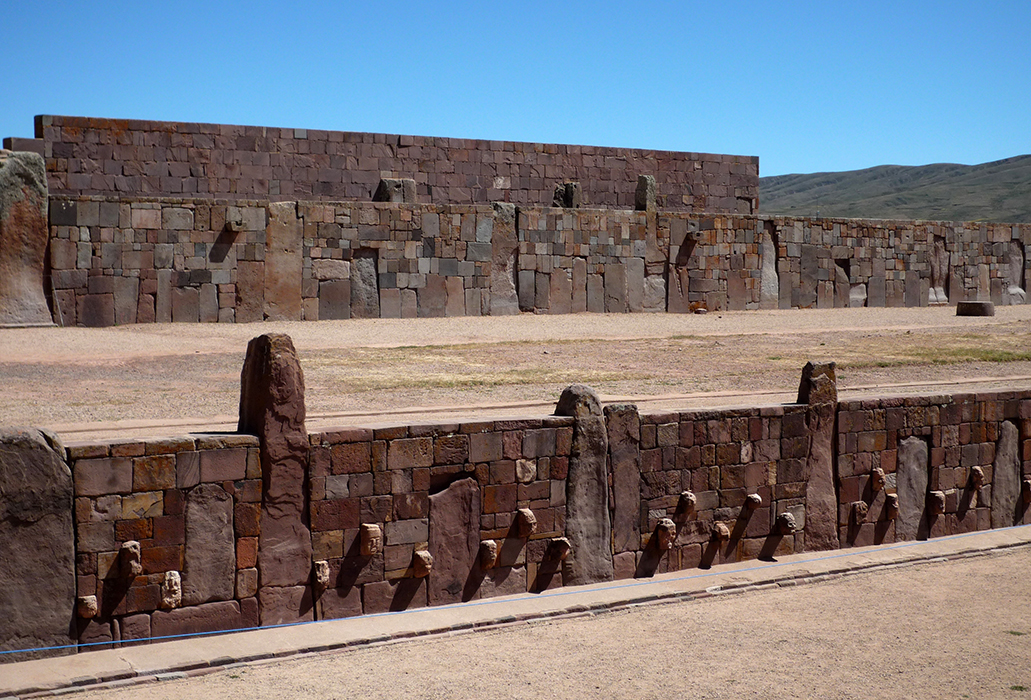
The central stones on three of the walls (north, east, and west) provide more than a physical connection to the sky above. They mark viewing points for various astronomical events such as solstice and equinox sunrises and sunsets, the rising and setting of important stars, and even point the way to the Celestial South Pole, the pivot of the southern hemisphere. The movements of the sun, moon, and stars across the sky regulated the rhythm of life in all Andean societies—used to determine when to plant and harvest crops and conduct religious rituals. As this court has been identified by archaeologists as a gathering place for these rituals, these stones would have helped participants properly orient themselves for the appropriate celestial event.
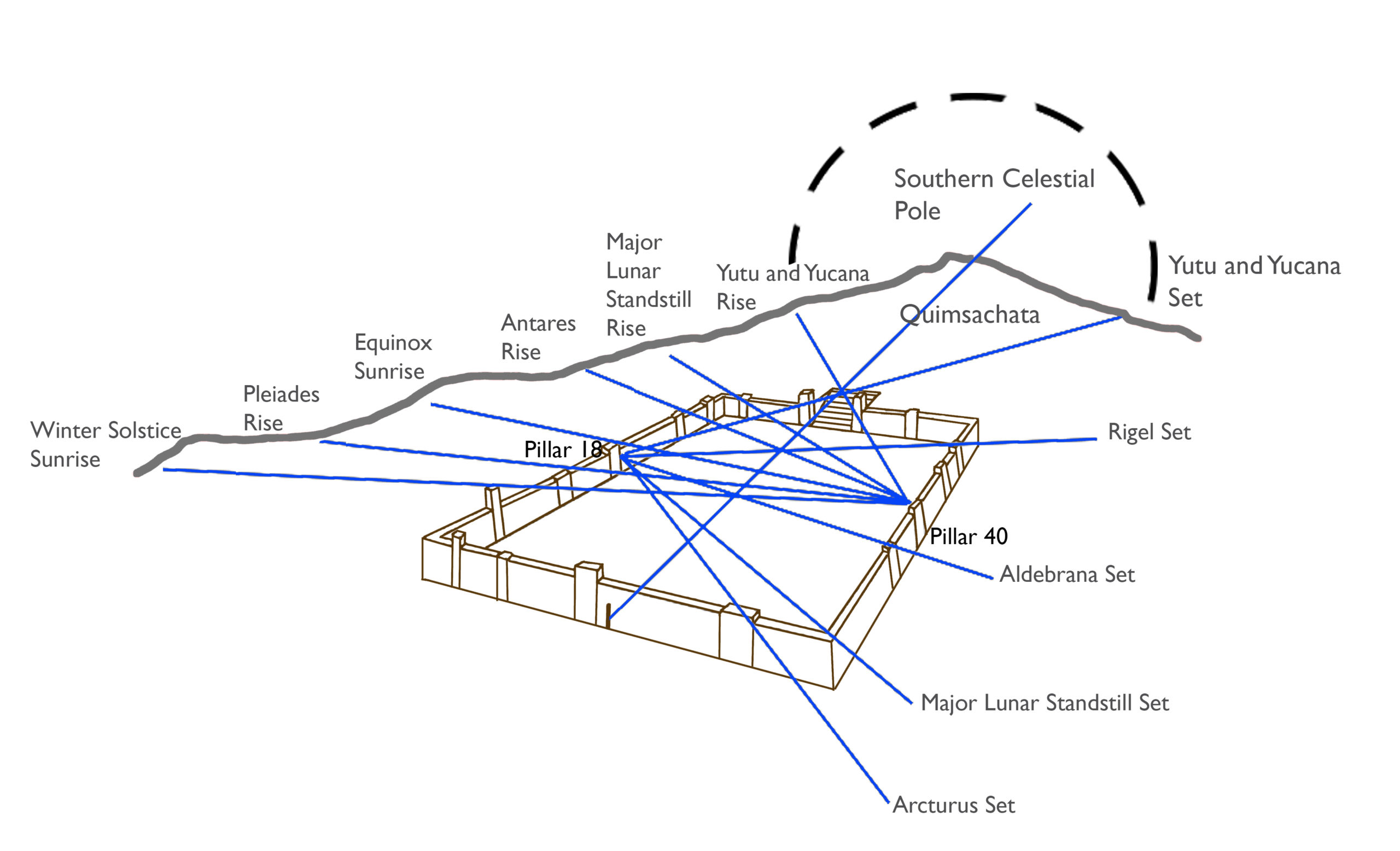
Connecting past and present
The Semi-subterranean Court served as a way in which the people of Tiwanaku could express their connections to past cultures while creating their own unique architectural and sculptural styles. Completed between 300–400 C.E., it is estimated to be the earliest monumental stone building constructed in the central ceremonial area.
The innovation of the Semi-subterranean Court begins with its size. The sunken court style of building is found in many of the archaeological sites which pre-date the founding of Tiwanaku in the regions surrounding Lake Titicaca such as Pucara and Chiripa, but the Semi-subterranean Court is the largest found to date. Its increased size was likely a statement of growing political power by the emerging Tiwanaku polity.

The second, more striking change to the older sunken court style is the addition of the tenon heads (sculptures of heads which are set into a wall, anchored by a post called a tenon, but extend out from the surface) to all four walls in a pattern of repeating triangles between the large vertical stones.
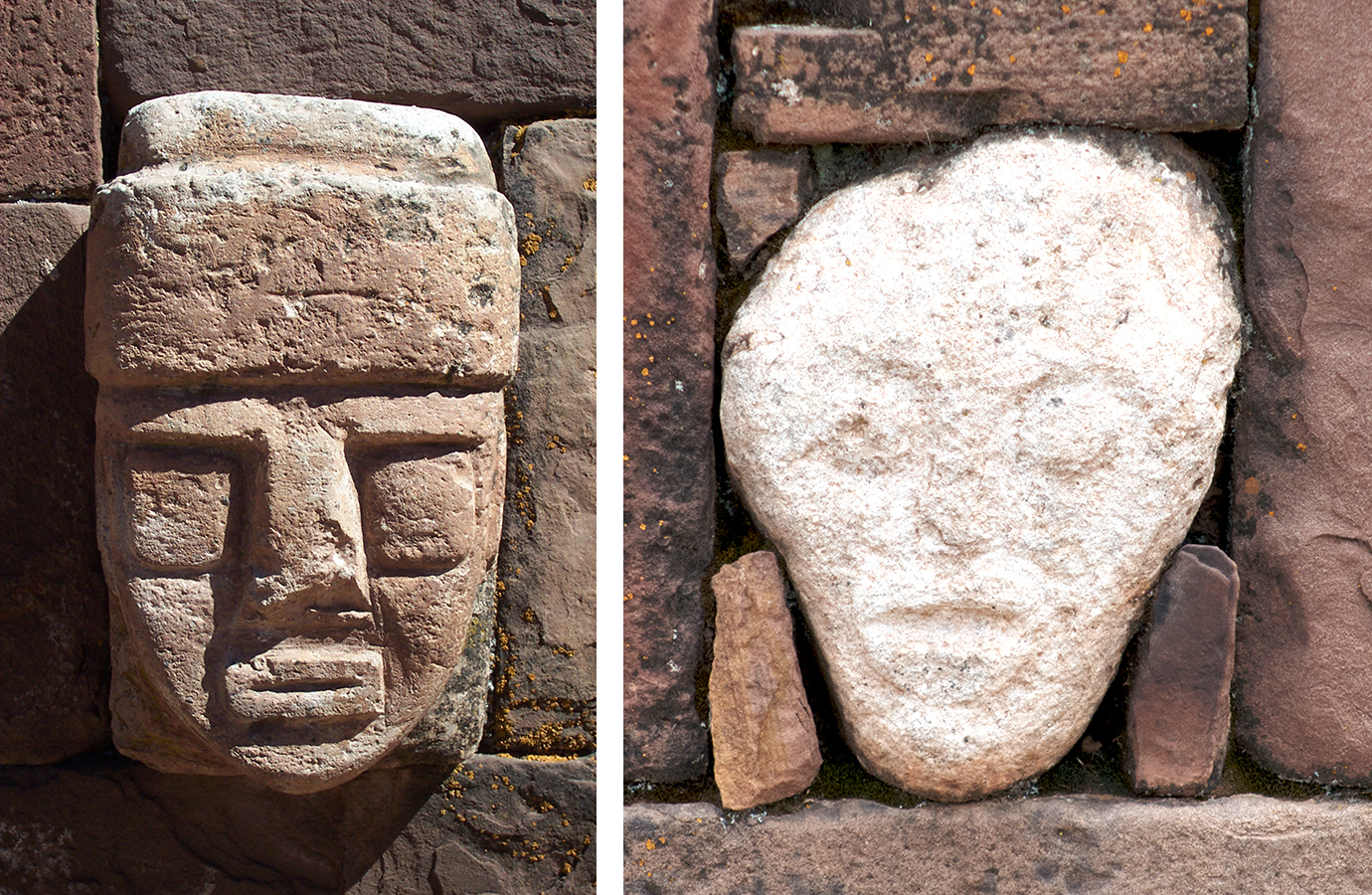
The heads in the best condition display a wide range of variations on two basic compositions. The first and most common is a face with a wide band around the forehead, large deep-set eyes, a T-shaped rectangular nose, and an oval mouth with thick lips. The second, of which few uneroded examples remain, is a face without the forehead band, a more oval-shaped nose, and much smaller eyes. No two heads carved in either style are exactly alike: noses range from broad to narrow, the eyes can be circular or square, some mouths are wide open with clearly defined lips while others are tightly closed.
These are believed to represent the range of ethnicities or communities who were governed by the Tiwanaku polity and attended the ceremonies held in the court. It is still unknown if they were contributed by the groups they represent willingly or by force.
Sculpture and religion through time
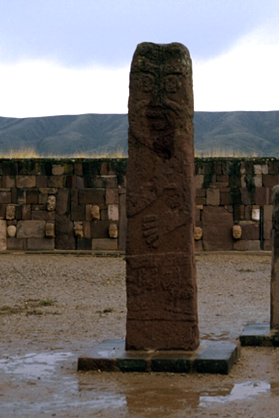
Archaeological excavations from the mid-twentieth century uncovered several freestanding sculptures, two of which have compositions that provide a striking visual representation of the cultural changes which occurred in Tiwanaku society through the centuries.
Stela 15 is a four-sided rectangular stone shaft with simple low relief carving on all four sides. The narrower sides contain vertical patterns of snake-like figures running up towards several small mammals with long tails. Although both wider sides were each carved with the image of a large humanoid figure, erosion has virtually erased the carving on one. The other shows a standing figure with a large face containing the T-shaped nose, deep-set circular eyes, and oval mouth seen in some of the tenon heads. A beard-like band encircles the lower face, indicating that it is a male figure. The arm on the viewer’s left is placed diagonally above the one on the right, both raised above a band showing two opposing feline figures.
This imagery is associated with the Yayamama religious tradition that was practiced across the Lake Titicaca region beginning in 800 B.C.E. and declining around 300 C.E. The placement of Stela 15 in the Semi-subterranean Court indicates that, like the other sunken courtyards in considerably older Lake Titicaca sites, this structure was initially used for Yayamama ceremonies. The imagery of better-preserved stelae at other Yayamama sites suggest that some of these ceremonies centered around celebrating the fertility forces of the female-male duality (represented by deified ancestors) as well as those found throughout nature, represented by various animals and a navel-like image thought to represent the center of the cosmos.

The wealth of realistic detail and iconography of the Bennett Monolith, built several centuries later, are the result of a dramatic change both in artistic styles and religious traditions. Here, the male figure (a towering twenty-four feet tall) is carved in the round and shown wearing elaborate clothing carved with extreme attention to detail. The figure’s torso and arms are covered with images of running bird-headed figures holding staffs and llamas sprouting sacred cacti. On the back there is also a rendition of the frontal-facing deity shown on the Sun Gate, identified by its large square face surrounded by rays ending in animal heads and circular shapes. Instead of holding two staffs, this version of the deity holds a flowering cactus plant in each hand.
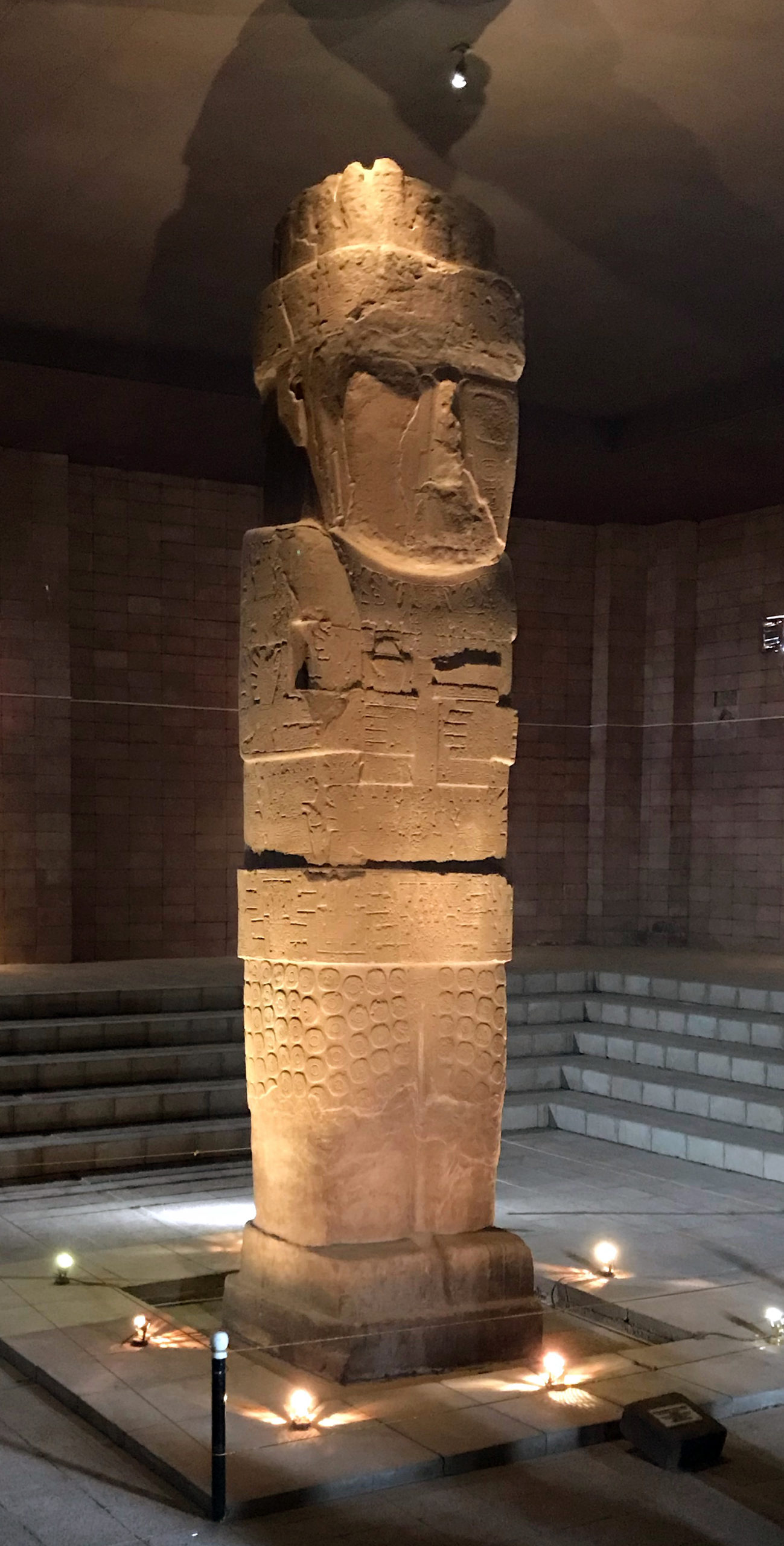
In contrast to Stela 15, the figure depicted in the Bennett Monolith holds both arms against its sides with the hands facing forward rather than placed on top of each other. Like the deity of the Sun Gate, each hand holds an object, the left a cup similar in shape to a kero and the right a snuff tray used to ingest trance-inducing substances during ceremonies.

The Bennett Monolith, with its references to Chavín de Huantar iconography, suggests that Tiwanaku gradually moved away from the Yayamama religious practices to those imported afar. Its presence in the Semi-subterranean Court, where it was originally placed near older sculptures like Stela 15, perfectly demonstrates how the inhabitants maintained ties with the past traditions of the Lake Titicaca region while continuing to innovate and adopt new ideas.
Overall, the Semi-Subterranean Court marks the rise of Tiwanaku’s importance as a regional center. Its large size, innovative architectural sculpture, and changing free-standing monuments demonstrate the inhabitants’ desire to create a unique version of the older regional culture and those from abroad to express their power and influence.
Additional resources:
Tiwanaku: Spiritual and Political Centre of the Tiwanaku Culture (UNESCO)
Margaret Young-Sánchez, Tiwanaku: Ancestors of the Inca (Denver Art Museum, 2004)
Alexei Vranich, “Monumental Perceptions of the Tiwanaku Landscape,” in Political Landscapes of Capital Cities, edited by Jelena Bogdanović, Eulogio Guzmán, and Jessica Joyce Christie (Boulder, CO: University of Colorado Press, 2016) pp. 181-211
Alexei Vranich and Scott C. Smith, “Nighttime Sky and Early Urbanism in the High Andes: Architecture and Ritual in the Southern Lake Titicaca Basin during the Formative and Tiwanaku Periods,” in Archaeology of the Night: Life After Dark in the Ancient World, edited by Nancy Gonlin and April Nowell (Boulder: University Press of Colorado, 2017), pp. 121-138
John Wayne Janusek, Ancient Tiwanaku (Cambridge: Cambridge University Press, 2008).
Michael A. Malpass, Ancient People of the Andes (Ithaca, NY and London: Cornell University Press, 2016)
Sergio Chávez and Karen L. Mohr Chávez, “Newly Discovered Monoliths from the Highlands of Pouno, Peru” Expedition vol 12, no. 4, pp. 25-39
Chancay culture
Chancay Standing Female Figure
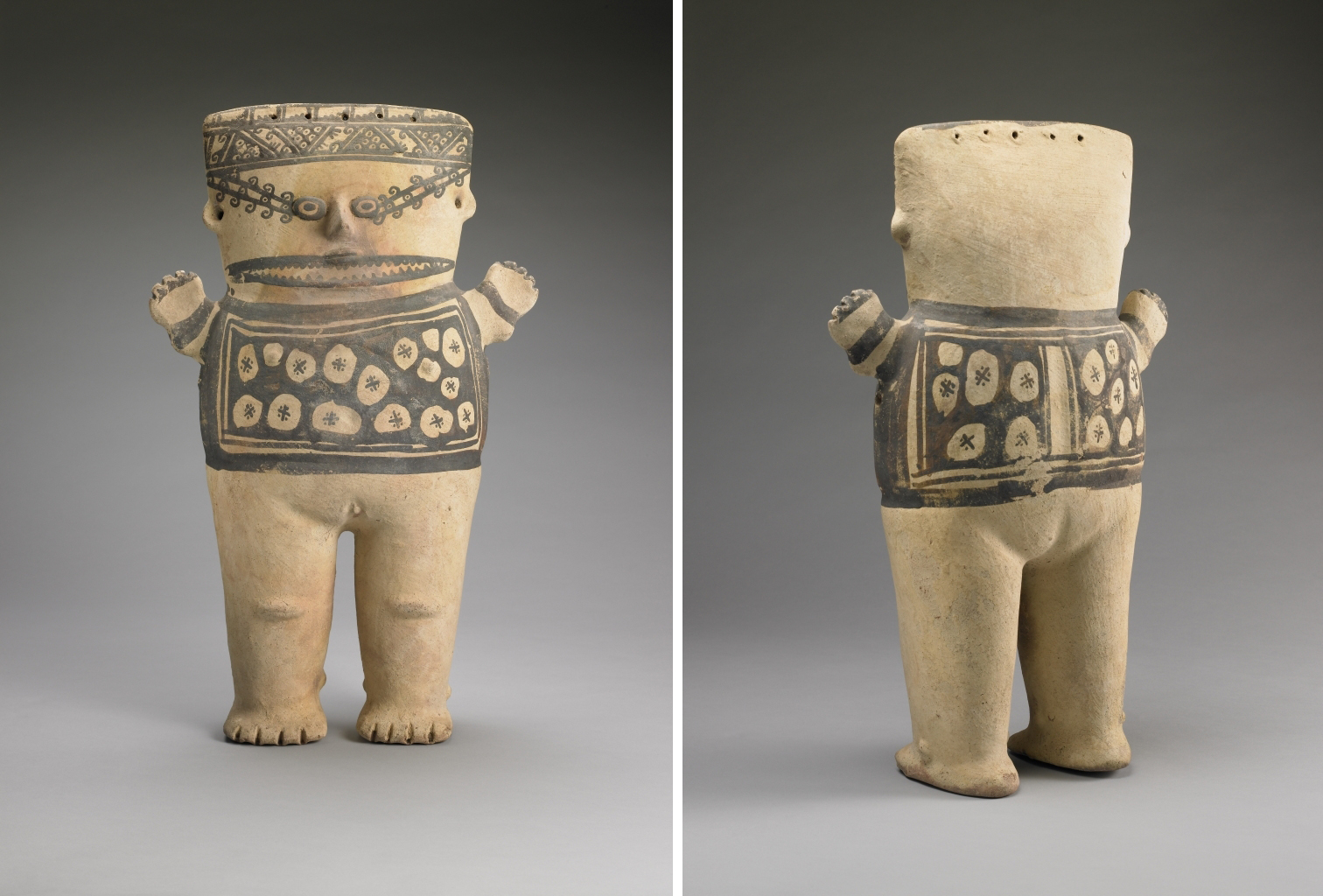
What can small-scale ceramic figurines tell us about the past? It turns out, they can tell us a great deal about cultures that no longer exist. A wonderful example is a Chancay female figure from 1200–1450.
The Chancay people lived on the central coast of Peru, centered on the Chancay river valley (approximately 80 kilometers north of Lima) from c. 1000 C.E. until their conquest by the Chimú and then the Inka in the fifteenth century. They were expert weavers, creating fine cloth as well as fiber sculptures, but they also created ceramic sculptures in a distinctive style. Among them are standing figures of both men and women, painted in a brown-black over a creamy white slip.
The Standing Female Figure is relatively large (over eighteen inches tall), hollow, and likely made by joining slabs of clay together, although molds could have been part of that process. The surface of the figure is painted with a white slip that was then overpainted with brown-black slip designs. The abstracted body is characterized by a large head, wide torso, and long, large legs with big feet that help to hold the sculpture upright. The small arms are relatively flat, with a bend at the elbow and paddle-like hands.
Her facial features are small compared to the overall head, with oval eyes, a sharply triangular nose, and a small mouth that is partially obscured by the decorative pattern on her chin that is made up of two serrated lines (this is actually an animal mouth painted over her actual mouth, as discussed below). Her face and head are in fact painted with a number of patterns made up of lines with a consistent thickness.
A woman…
At the top of her head, vertical lines delineate sections that are filled with a shape reminiscent of a step or mountain range. A design similar to this is found in most ancient Andean visual vocabularies, especially in textiles. Beneath that, a band with a more complex pattern features white circles outlined in black, with a black dot at the center. These circles fit into triangular shapes, alternating point up and point down, with a space in between decorated with curved and straight lines. This may be meant to indicate a textile headband, but the design does not wrap around the back of the head the way the design on the torso does. The corners of her eyes are linked to the bottom of the band by two thin lines set at a diagonal, with more dotted circles in between the lines and curves fringing the outer edges.
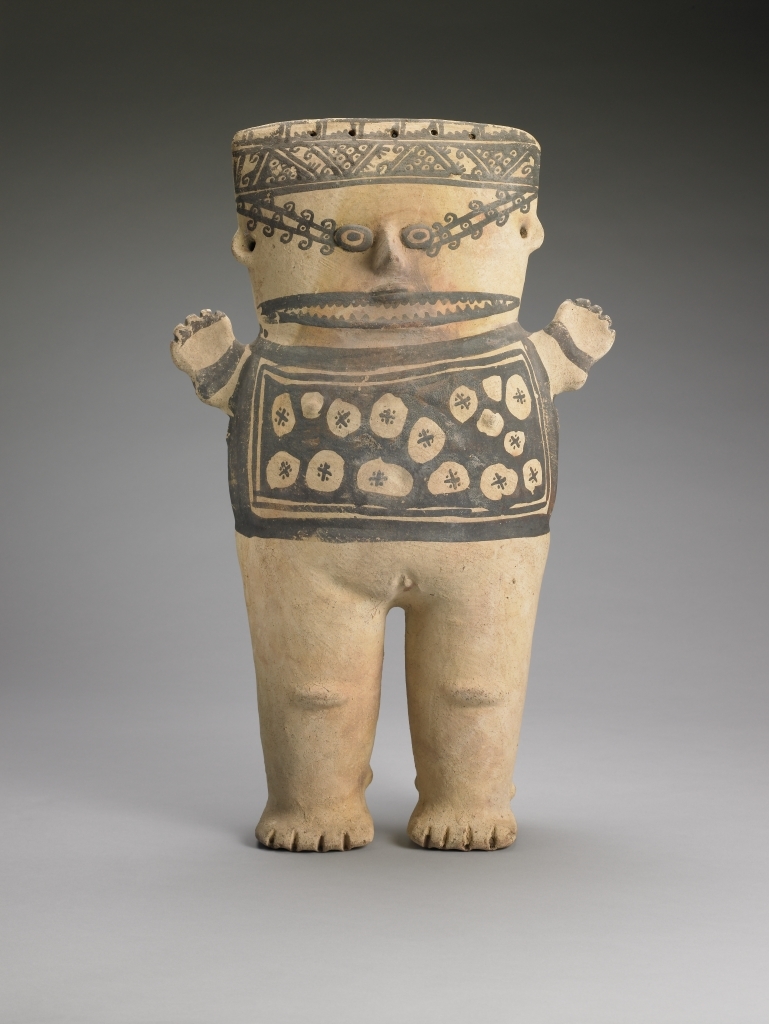
While the figure at first appears to be wearing a patterned tunic and nude from the waist down, the decoration on her torso is probably intended to represent body paint or tattooing. It consists of a black background, a frame-like border made up of two white lines, and white spots, some of which have a pattern in the center made up of two crossed lines and four dots. Two of the spots that do not have the central pattern actually surround small bumps that indicate breasts.
While not visible in the photographs, there is a faint impression of a textile on the sculpture that indicates that this figure was originally meant to be dressed, further indicating that the torso patterning is body decoration. The holes across the top of the head indicate that along with her dress, she would have been adorned with perhaps a feather headdress or other head ornament.
…and something else
The decoration of the body paint on the standing figure’s torso may just look like irregular splotches of white on a dark background, but Dr. Rebecca Stone has noted that the spots, along with the wide, toothy mouth painted over her actual mouth, likely reference the whale shark. Stone has also pointed out that the white strip down the back of the figure’s torso echoes the white line of dots that can highlight the edge of the shark’s dorsal fin. The whale shark is the largest living species of fish, with an average length of 32 feet and weight of 20,000 pounds. Their mouths can be up to 4.9 feet wide, and are filled with tiny teeth and filters for feeding on plankton and very small fish. As they are not predators, their attitude towards humans has historically been one of docile indifference.
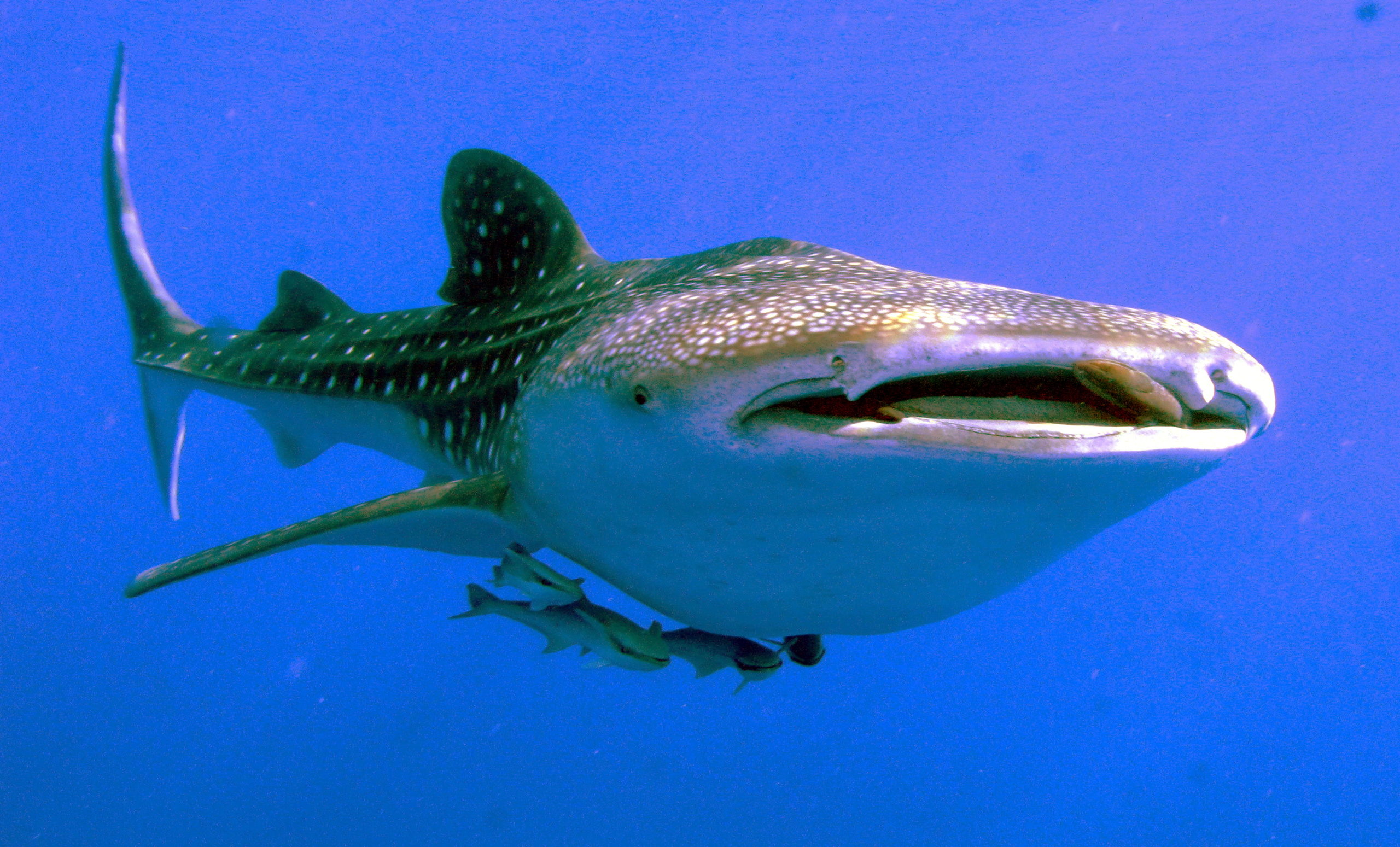
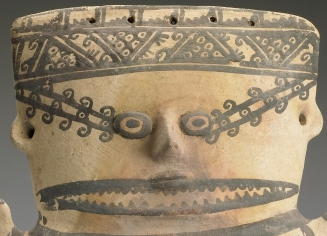
These whale shark attributes, layered over her human body, could be indications that this figure is being depicted as a ritual specialist transforming into a spiritual alter ego to travel into the spirit world, and whose animal self is the whale shark. While the whale shark is not a fierce predator like a jaguar, harpy eagle, or caiman — apex predators that are commonly associated with ritual transformation in Andean art — they are formidable in size, and are able to move from the surface of the water to depths of several thousand feet, which may have been thought of as an ability to travel between this world and the underworld, just as ritual specialists could travel between this world and the next. It is also possible that the woman’s body paint marks her as a member of a clan or other lineage group associated with the whale shark, perhaps claiming it as an ancestor.
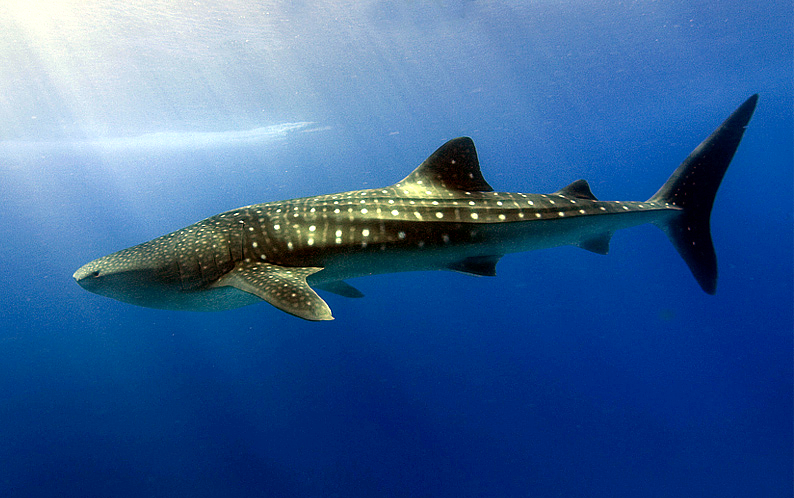
Female whale sharks can produce large litters of pups, perhaps also linking them with fertility in the minds of the Chancay people, and making this the spiritual power that the whale shark (as spiritual alter ego or as lineage ancestor) was thought to wield. Her wide, staring eyes may allude to trance or spiritual sight (the ability to see into the spirit world), but they also dovetail with the whale shark’s ability to roll its eyes back and pull them into its head, which must have made a strong impression on the Chancay people who witnessed it. The blending of human and animal traits in this figure shows us that the Chancay people were keen observers of nature, and that their beliefs were combined with what they knew about the natural world.
Additional resources:
Rebecca R. Stone, Art of the Andes: From Chavín to Inca (London: Thames & Hudson 2012)
Rebecca R. Stone, The Jaguar Within: Shamanic Trance in Ancient Central and South American Art (Austin: University of Texas Press, 2011)
Rebecca R. Stone and William B. Size, Seeing with New Eyes: Highlights of the Michael C. Carlos Museum Collection of Art of the Ancient Americas (Atlanta: Michael C. Carlos Museum, Emory University, 2002)
Chimú culture
Introduction to the Chimú culture
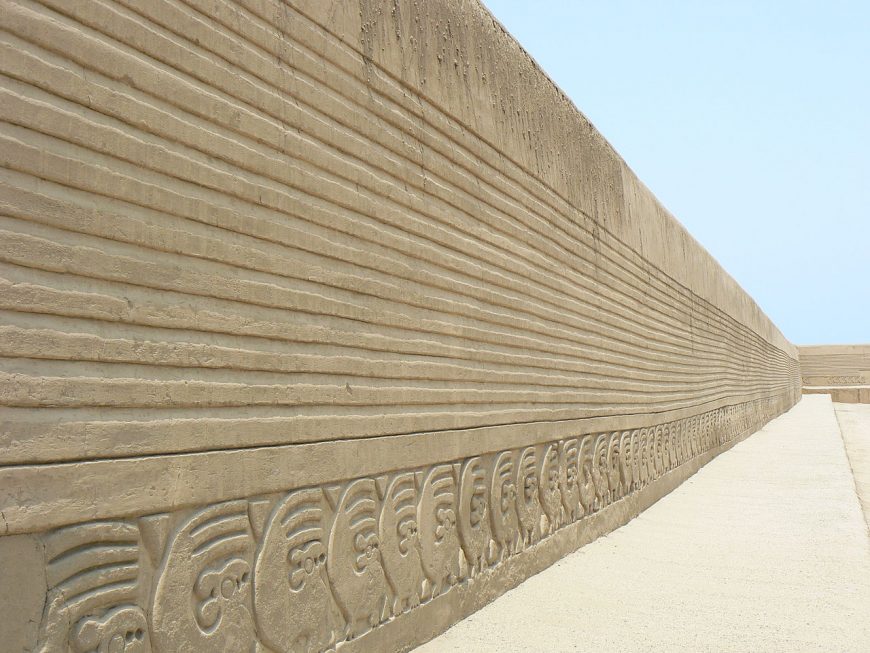
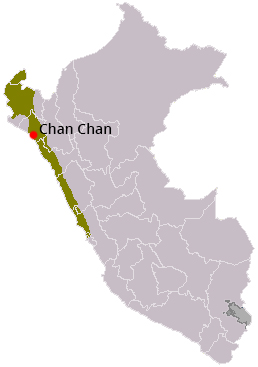
Following the decline of the Moche on the north coast of Peru, there arose two cultures in their place. One was the Sicán (or Lambayeque), beginning around 750 in the northern part of the old Moche territory in the Lambayeque and La Leche river valleys. The other was the Chimú, who began to flourish around 950 in the Moche valley (around the Moche River) and spread both north and south, eventually conquering the Sicán around 1375 and expanding almost as far as Lima. The Chimú kingdom, called Chimor, came to a close with their conquest by the Inka.
The capital of the Kingdom of Chimor was the city of Chan Chan, located in the Moche river valley, closer to the coast than the Moche culture’s center at the Huacas del Sol and de la Luna. Chan Chan was composed of royal compounds, today referred to as ciudadelas or citadels. These citadels were elaborate, labyrinthine compounds surrounded by high walls made of adobe bricks covered in mud plaster and reliefs.
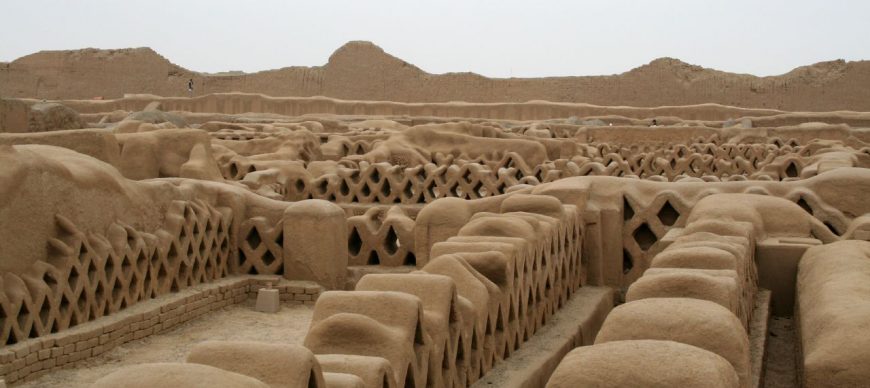
Ciudadelas were composed of long, narrow corridors leading to spaces with different uses, such as large, open plazas with central platforms for ceremonies, storage facilities, and even large wells. It would be difficult for someone unfamiliar with the citadel to navigate their way through, and so the architectural design provided a kind of security in addition to the presence of guards and court officials.
The citadel was a royal household, audience chamber, and storage facility during the life of the king, and his tomb upon his death. Each new king would build a new citadel, as the old king was buried in his. A new king would begin from square one, needing to build his wealth and his citadel, along with his reputation. This may have been one reason for the steady expansion of the kingdom of Chimor: the need for new sources of wealth for new kings.
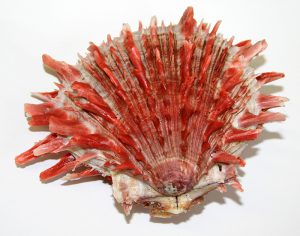
Chimú kings had access to high-quality textiles made with dyed camelid wool, gold- and silversmiths who made fantastical jewelry as well as delightful miniatures of everyday objects, and exotic feathers and shells. The feathers came from the cloud forests of the Andes as well as the Amazonian jungles that lay beyond, and Spondylus shells were brought from the warm waters of modern-day coastal Ecuador. The king of Chimor had in his retinue a servant called the Fonga Sigde, whose job it was to strew crushed Spondylus powder before the king as he walked, creating a “red carpet” for him to walk on and showing his extreme wealth and power.
Because of the legendary wealth of the kings of Chimor, the cuidadelas of Chan Chan were mercilessly looted beginning with the fall of the Chimú empire to the Inka around 1470, and very few objects have been recovered scientifically from the site. There is, however, a great deal of conservation and restoration work going on at the site, and other sites have yielded a wealth of Chimú objects, including the Moche pyramids of Huaca del Sol and Huaca de la Luna, which are less than three miles away. The Chimú may have seen these structures as belonging to revered ancestors, and therefore spiritually powerful and an appropriate place for their own dead.
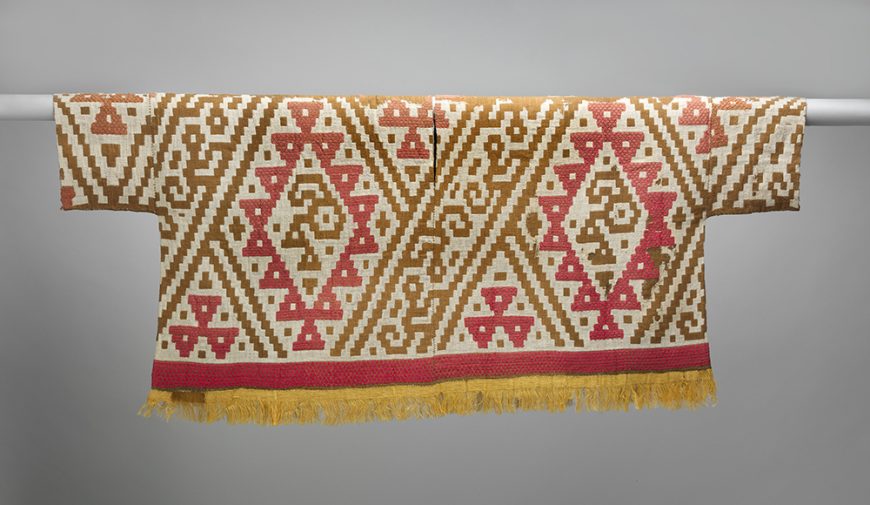
Clothed in glory
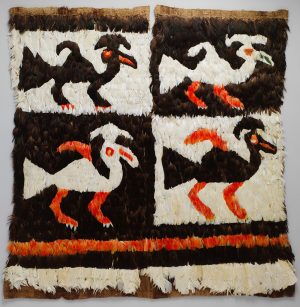
Chimú tunics varied in quality from plain, undyed cotton in natural colors to brilliantly-colored dyed camelid wool, (above) and eye-catching, exotic feathered tunics (left). Both of the tunics shown here feature bird designs, but the one above is heavily abstracted. The bird can be seen inside the large pink diamond shapes, reduced mainly to a large beak, round head with its eye, and two triangles for the body and tail. Heavily geometric designs like this one were common in Chimú textiles, although some are more naturalistic. The feathered tunic’s birds are easier to see. They were created by carefully tying rows of trimmed feathers to a plain textile backing. Despite their relative clarity, they are still similar in shape to those in the textile tunic. The plainest textiles would have been worn by the common people, with more elaborate creations like the ones seen here worn by the elites. The king was entitled to wear the most luxurious articles of clothing, distinguishing him from everyone else.
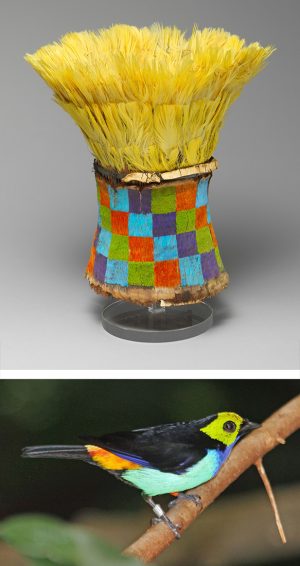
Feathers were also used to decorate crowns. The conical shape would be constructed of a basketry base, then decorated with feathers and other ornaments (in this case with copper bands at the top and bottom of the base). Art historians have identified the feathers as coming from the paradise tanager and the macaw, both birds that live in the dense tropical jungles to the east of the Andes mountains. The brilliant colors and exotic origins of the feathers signaled the ruler’s ability to procure luxury items from far away.
Pots that whistle
Chimú ceramics are very different from those of the Moche that preceded them. They are less sophisticated in execution, and usually are not painted, relying solely on modeled form and surface textures for their decoration.
The vessel below is a double chamber type that is common to Chimú, where two hollow forms are joined by a tube at the bottom and a strap handle at the top, with a more or less cylindrical spout sticking straight up from one chamber. In some cases, the vessel has been engineered so that pouring liquid out of it or sloshing the liquid around inside it will force air through a whistle inside one chamber, causing the pot to make a sound when it is used (audio of this vessel whistling can be found here). These vessels were fired in a kiln deprived of oxygen (referred to as a “reducing atmosphere”), causing the iron compounds in the clay to turn black. The general term for Andean ceramics made this way is “blackware.”
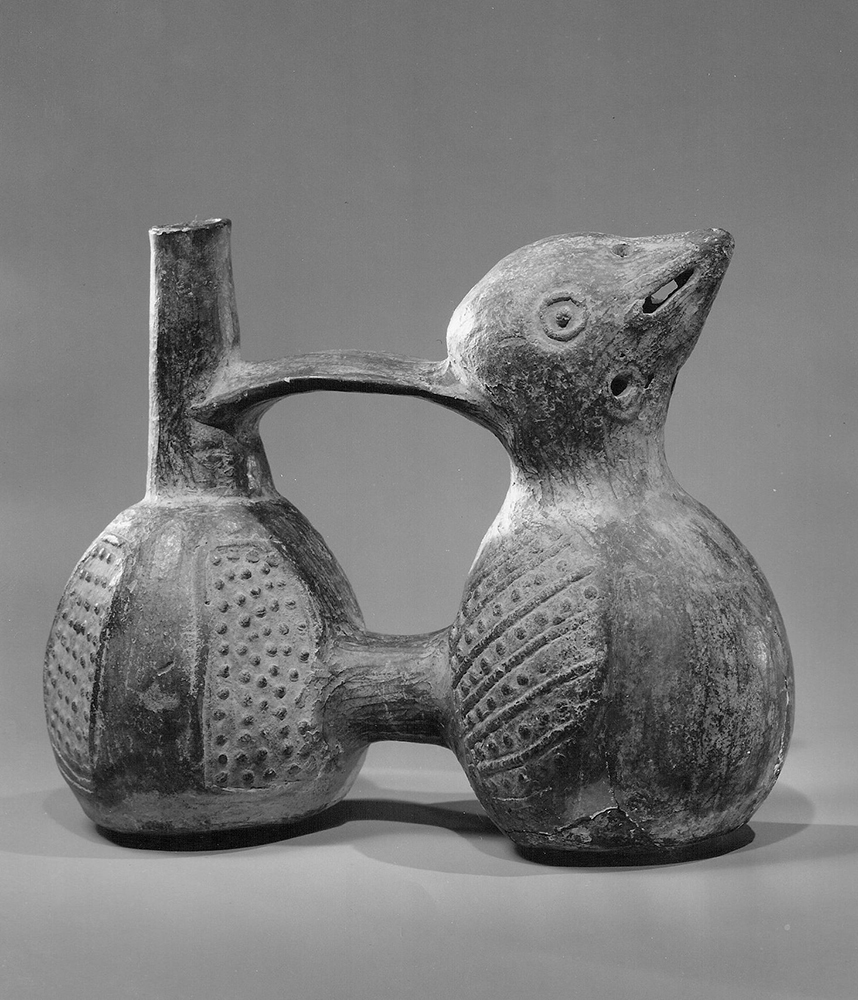
Glittering regalia
Chimú metalsmiths made many different kinds of objects. The earspools seen below would have been worn by a ruler or very high-ranking noble. They depict a man, probably a king, holding a beaker and a feather fan, carried on a litter by other figures. He wears a large headdress topped with a broad crescent of feathers, with a stepped ornament at the center. He wears earspools and a tunic with a fringed hem. Trapezoidal sequins dangle from wire loops on the surface of the earring, and would have shimmered as the wearer moved, adding further splendor to the object.
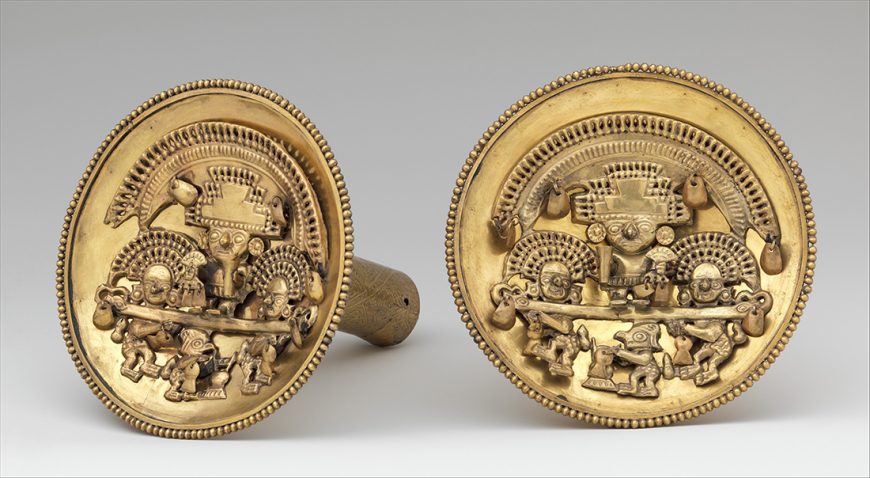
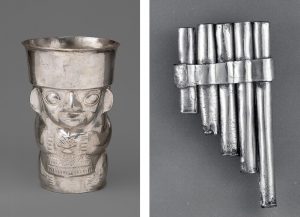
Metalsmiths also made silver and gold beakers, similar to those made by the Sicán. The figure in the beaker seen here holds a tunic with a bird design. The Chimú also made miniature metal versions of objects—household goods, musical instruments, even fruits. The tiny (2.7 x 5.6 cm!) panpipes to the right would have been included in a tomb as a precious, more durable version of an instrument normally made of reed.
In the ultimate statement of luxury, rulers also had silver versions of ceramic vessels made for them. The one below depicts a ruler seated on a throne that is decorated with birds, waves, and a supernatural figure, similar to thrones and adobe reliefs found at Chan Chan. Two attendant figures are seated below him. The design is repeated on the other side. The ruler figure is larger than those below him, emphasizing his power just as much as the elaborate repoussé that defines the throne. One subject figure on each side is carrying a bag, perhaps filled with tribute for the king of Chimor. The stirrup spout for the vessel shows that the Chimú continued some elements of Moche style.
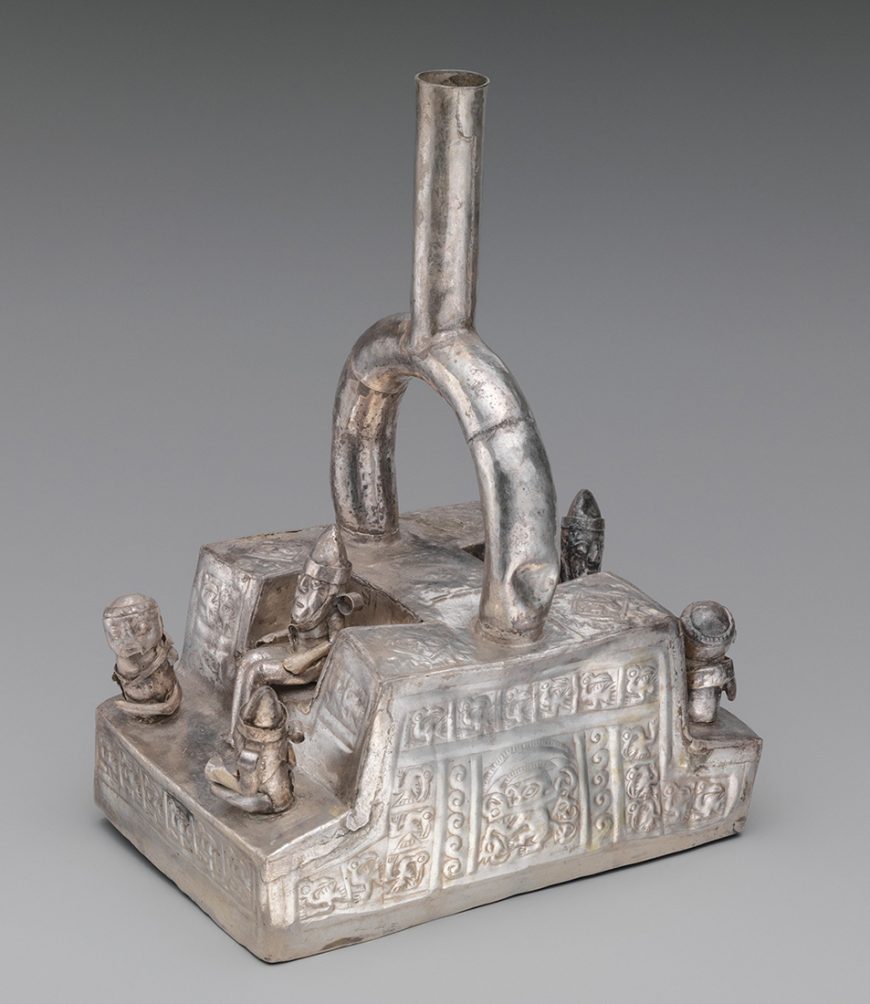
Treasures from the ocean
Chimú jewelry included not only metals and beads of precious stone but also shell. The red-orange Spondylus shell that was crushed for the king to walk on was also used to make beads, as were other shells, which produced purple, yellow, and white beads. The wrist ornament below is one of a pair, to be worn like cuffs. The rich colors echo those of high-status dyed textiles and exotic feathers. A ruler wearing these cuffs, a brilliantly colored tunic, a tall, colorful crown, and shiny gold earspools must certainly have been an intimidating sight, inspiring awe of the power of Chimor in all who witnessed him.
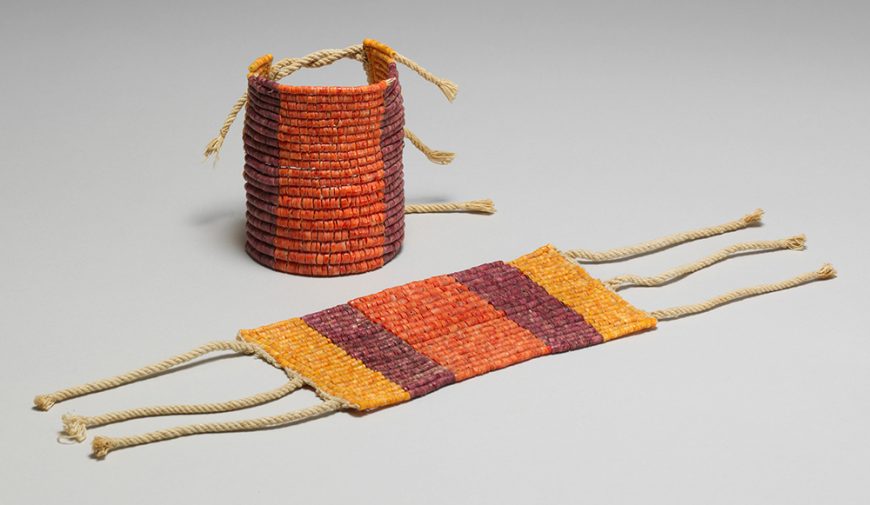
The conquest of the Kingdom of Chimor by the Inka around 1470 brought the age of luxury on the coast to an end. The artists and craftsmen of Chimor were taken to Cusco to make elite goods for the Inka nobles, and the ciudadelas were sacked and plundered. Further looting would take place over the centuries, leaving only the massive adobe architecture as a reminder of the might of the Chimú kings.
Additional resources:
Music in the Ancient Andes from The Metropolitan Museum of Art
Birds of the Andes from The Metropolitan Museum of Art
Architectural Models from the Ancient Andes from The Metropolitan Museum of Art
Alana Cordy-Collins, “Fonga Sigde, shell purveyor to the Chimu kings,” in M.E. Moseley and A. Cordy-Collins, eds., Kingship and Statecraft in Chimor (Washington, D.C.: Dumbarton Oaks, 1990), pp. 393-418.
Joanne Pillsbury, “The Thorny Oyster and the Origins of Empire: Implications of Recently Uncovered Spondylus Imagery from Chan Chan, Peru,” Latin American Antiquity, vol. 7, no. 4 (1996), pp. 313-340.
Sicán culture
Inverse-Face Beaker
Video \(\PageIndex{7}\): Inverse-Face Beaker, 10th-11th century, Sicán (Lambayeque), Peru, gold, 20 x 18.1 cm (The Metropolitan Museum of Art)
Key points:
- The Sicán culture was located on the north coast of Peru, and is sometimes referred to as Lambayeque.
- We have lost a significant amount of knowledge of Sicán culture due to systematic looting and grave-robbing. These looted objects were smuggled out of Peru and many find their way to private collections and museums in North America and Europe.
- This inverse-face beaker, made of hammered gold, shows a face in a position that would have been upside-down when it was used. This inversion may suggest the underworld, or contact with spirit forces.
Additional resources:
This work at The Metropolitan Museum of Art
Donna Yates, Batán Grande on Trafficking Culture
Izumi Shimada, “Precious Metal Objects of the Middle Sicán,” Scientific American (2005)
Inka art
In less than two centuries, the Inka developed a powerful empire and a complex set of artistic traditions.
1438 - 1532 C.E.
Introduction to the Inka
The Inka, like the Aztecs (or Mexica) of Mesoamerica, were relative newcomers to power at the time of European contact. When Francisco Pizarro took the Inka ruler (or Sapa Inka) Atahualpa hostage in 1532, the Inka empire had existed fewer than two centuries. Also like the Aztecs, the Inka had developed a complex culture deeply rooted in the traditions that came before them. Their textiles, ceramics, metal- and woodwork, and architecture all reflect the materials, environment, and cultural traditions of the Andes, as well as the power and ambitions of the Inka empire.
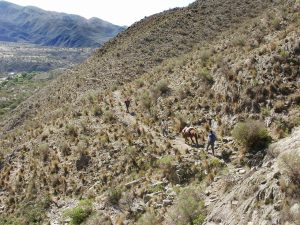
An Empire of Roads—and Cords
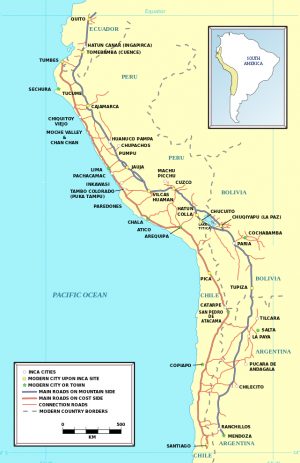
The Inka empire at its greatest extent sprawled from the modern-day city of Quito in Ecuador to Santiago in Chile. The Inka called their empire Tawantinsuyu, usually translated as “Land of the Four Quarters” in their language, Quechua. At the center of the empire was the capital city of Cusco. The empire was connected by a road system—the Qhapaq Ñan—that was used for official Inka business only. Soldiers, officials, and llama caravans carrying food, ceramics, textiles, and other items used the roads, and so did message runners. These runners were stationed at regular intervals along the roads, so that messages could travel swiftly throughout the empire.
However, the messages that these runners carried were not written in the way we would expect. They were not made of marks on paper, stone, or clay. They were, instead, encoded into a knotted string implement called a quipu. Our knowledge of quipu remains limited. We have been able to determine only some of the ways that the quipu were used. Researchers continue to investigate this unique system of communication. The knots along the various cords recorded numbers, so that a knot with 5 loops could represent the number 5. The position on the cord could then determine what the number meant in a decimal system, so that a 5-loop knot could represent the number 5, or 50, or 500, and so forth.
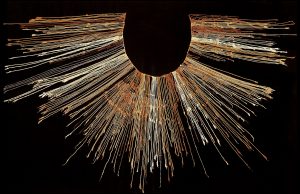
The cords of quipus are frequently composed of different natural and dyed colors, but the reason or meaning behind those colors so far eludes scholars. The numbers encoded in the quipus helped the Inka keep track of the tax-paying obligations of their subjects, record population numbers, harvest yields, herds of livestock, and other important information. Also recorded on the quipu were stories—histories of the Inka and other social information. However, scholars today still don’t know how that information was encoded into the quipu.
More valuable than gold
Quipus and other Inka fiber objects were made from yarn spun from alpaca fibers. Llamas and alpacas are the domesticated relatives of the wild camelids of the Andes, the guanaco and vicuña, and all of them are related to the camel. Alpacas and llamas were important to the functioning of the Inka empire, but they had been essential to the lives of Andeans for millennia. Llamas provided meat as well as acting as beasts of burden—an adult male llama can carry up to 100 pounds. Alpacas provided soft, strong wool for textiles and rope-making.

When the Spaniards encountered the Inka, they were confused by the fact that they considered textiles more valuable than gold. Textiles were integral to the structure of the Inka empire. Acllas, or “chosen women,” were kept in seclusion by the Inka to weave fine textiles (called qompi). These textiles mostly took the form of tunics and mantles. Some were distributed as high-status gifts by the Sapa Inka to cement the loyalty of local lords throughout the empire. Others were burned as sacrifices to Inti, the sun god and divine ancestor of the Inka ruling class. This shows us just how highly the Inka regarded textiles: they were fit for a god.
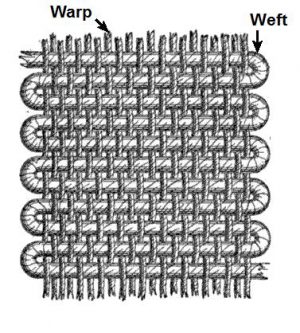
The acllas were not the only ones who wove. People of all ages spun, dyed, and wove textiles. The quality of wool, the fineness of its spinning, the relative rarity of the dye, and the skill of its weaving all determined the value of a textile. Some kinds of textiles were reserved for nobility or for warriors. The super-fine wool of wild guanacos and vicuñas was reserved only for the Sapa Inka’s garments.
A textile is created using a grid of warp (usually vertical) threads, which act as the support or skeleton of the fabric, and weft (usually horizontal) threads, which are passed under and over the warp threads. Where the weft threads cover the warp creates the surface design of the textile, somewhat like pixels in a computer image. The “pixel size” is determined by thread fineness. Decoration on Inka textiles was based in this grid structure, resulting in geometric designs.
Inka metalwork
Despite the value they placed on textiles, the Inka did also create works out of gold and silver, but unfortunately, most were melted down by the Spaniards for ease of transport, or destroyed because they were thought to be idols. Depictions of people, animals, and plants have survived. The plants tend to be quite naturalistic, while the people and animals are more abstracted. Human figures would likely originally have been dressed in miniature clothing. Figurines uncovered at the sites of human sacrifices on remote mountain peaks have been found dressed in finely-woven textiles with elaborate feather headdresses.
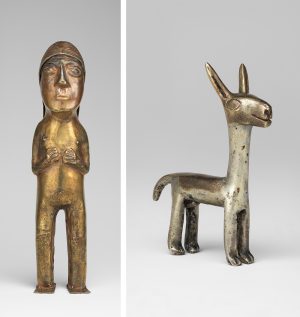
Vessels for feasting
Ceramics were also important to the Inka empire. Large vessels were used to store foods such as corn and dried alpaca meat in warehouses along the Qhapaq Ñan, which could feed soldiers and imperial officials, or be distributed to the people in times of hardship. Big vessels could also be used to cook food and brew corn beer (asua or chicha) for feasting.
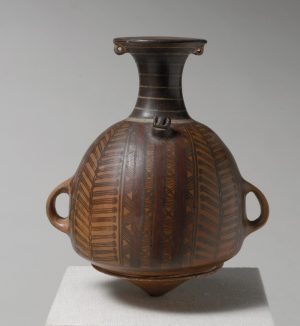
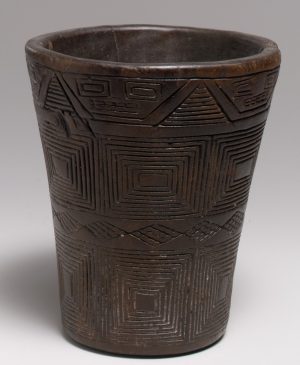
Feasting (the ceremonial consumption of food and drink) was a method of cementing social and political ties, and the nobility were expected to provide feasts for large crowds on important occasions. Vessels called urpus were used for transport, storage, and asua-brewing. Some are over four feet tall. They have large handles on their sides and a thick protrusion from the base of the neck. A rope could be looped between the handles and over this protrusion, making it possible to carry on the back of a person or llama. The pointed base could be pushed into the ground to hold the vessel steady.
Asua would be drunk out of kerus, flared beakers made of wood, ceramic, or metal, depending on the status of the drinker. Kerus were often made in pairs, reflecting the social implications of drinking asua as a part of feasting. One keru from each pair would be larger than the other. The person of higher rank would drink from the larger keru and offer asua to the person of lower rank in the smaller vessel. By drinking together, they cemented the reciprocal obligations that required nobles to provide asua and food to the people, and those below them to provide taxes and loyalty to the rulers of the empire. The keru shown here is made from wood, and like the urpu vessel, has geometric designs.
Inka architecture
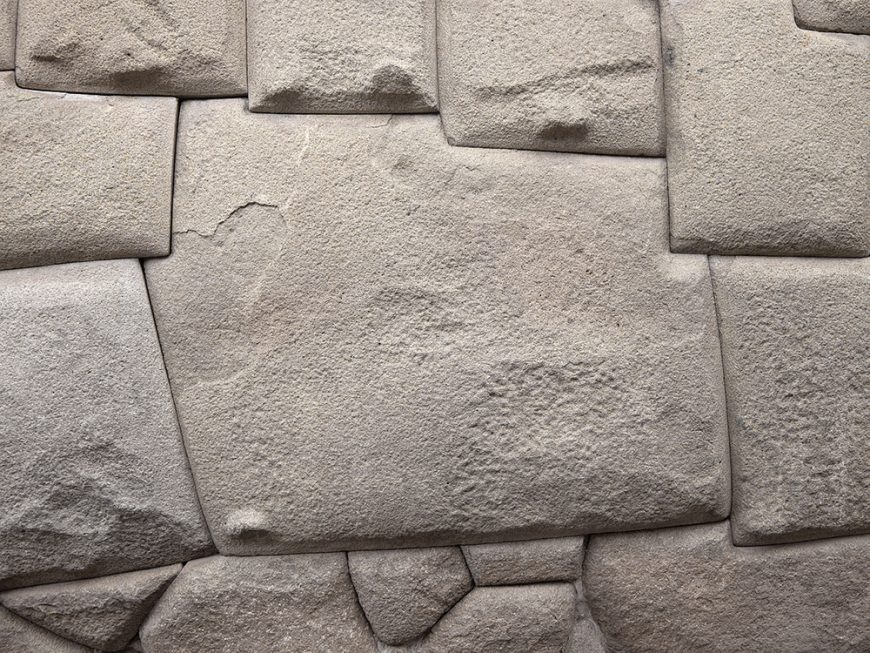
Perhaps the most well-known Inka art is their architecture. The Inka built everywhere they conquered, and their architectural style helped mark areas as belonging to the empire. Inka architecture is based on stone walls, fitted together in a very distinctive way. Instead of cutting stones into blocks and then laying those blocks together in rows, in some cases, the Inka would fit individual stones of varying sizes and shapes against each other, fitting them together like a puzzle. The stones would fit so closely that the Spanish remarked that a person could not even insert a knife blade between them.
Each stone was shaped so that it had a slight bulge or a slight indentation on the side where it would lay against another block. These bulges and indentations would slot together, holding the stones in place. It also allowed the stones to shift if they needed to—and they did need to, because Peru is seismically active and has frequent earthquakes.

The doorways, windows, and niches placed in Inka walls have a signature vertical trapezoid shape, a recognizable and distinctive aspect of their architecture. Sometimes referred to as a keyhole shape, it is thought that this form is also something that helps stabilize the architecture during earthquakes. The roofs of these buildings were made of wood and thatch.
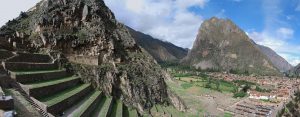
The Inka also built large architectural ensembles like the site of Ollantaytambo, which was a waystation along the Qhapaq Ñan. It consisted of storehouses, living quarters, and a series of terraces built into the side of a mountain. In most cases, the Inka used terraces as a way to stabilize mountainside soil for farming, but at Ollantaytambo they were planted solely with flowers—a show of the empire’s power through its ability to use stone, manpower, and water to do nothing but create a lavish and pleasant leisure space.
Inka traditions survive
With their defeat at the hands of the Spaniards, the Inka lost their place as divinely-descended leaders of their people. However, Inka nobles petitioned for and often won the right to be treated as elites in colonial Spanish society, and celebrated their heritage at Christian festivals, such as Corpus Christi. The privileges the nobles received did not translate to the rest of the population, though, and many people were deprived of their lands and personal freedom, required to pay taxes through often arduous labor.
Rebellions vying for a return to Inka rule occurred throughout the colonial period, the last of which took place in the 1780s. Peru finally achieved independence from Spanish rule in the 1820s, establishing a republican government. Modern residents of Cusco and its surrounding areas are still proud of their Inka heritage, and modern religious celebrations often incorporate parts of native culture into Christian practices.
Additional resources:
Qhapaq Ñan UNESCO World Heritage Site page
Dualism in Andean Art from The Metropolitan Museum of Art’s Timeline of Art History
The Great Inka Road: Engineering an Empire from the Smithsonian
Inka stone vessels
A huge empire
From their capital, Cuzco, in the central Peruvian Andes, the Inka created a huge empire reaching over 2,400 miles along the length of the Andes. The supreme head of state was the king, considered a living god ruling by divine right and the royal family controlled important areas of government such as the army.
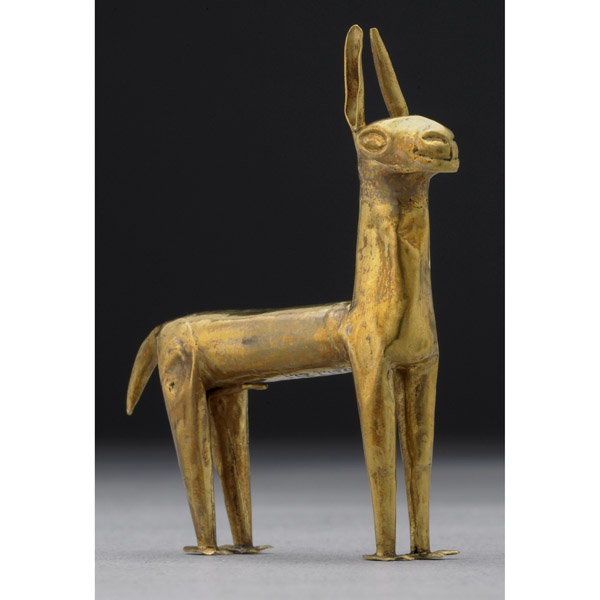
The empire’s economy was based on taxed labour. People contributed part of their labour to the state and the state-controlled religion. People farmed and herded animals, worked in mines and produced specialized goods such as clothing and pottery. The surplus was stored in numerous warehouses (tambos) for use by the army and state laborers.
Inka colonists were settled in newly conquered territories as a way of managing subject peoples and spreading Inka language and customs. Local lords were enlisted into the system of government to maintain order in their provinces, rebellious communities were resettled in the Inka heartland.
Inka engineers and laborers built a network of thousands of miles of roads and bridges to connect the empire. They constructed administrative centers, storehouses and military bases. A system of runners carrying information recorded on knotted strings called quipus also linked the capital to the regions.
Cuzco: the center of the Inka world
The capital of Cuzco was the center of the Inka world. Radiating from the central plaza the four main Inka roads led to the four corners of the empire. A sacred city of temples, royal palaces and residences for housing carefully-preserved bodies of dead rulers, early histories say the Inka likened Cuzco to the body of a puma (wild mountain cat), a symbol of Inka royalty.
The most sacred building in Cuzco was the Coricancha, a temple devoted to the sun, the main Inka deity. Its stone walls were covered in sheets of gold to reflect the sun’s light.
From this temple a system of sight-lines (ceques) radiated outwards dividing the surrounding landscape like slices of a pie. Over 300 shrines were situated at sacred places along these lines and there formed part of a sophisticated agricultural calendar.
Two carved stone vessels
This massive circular ritual vessel or cocha is sculpted from a single block of black volcanic basalt from the imperial capital Cusco. This is one of a small number of surviving vessels of this size that were probably housed in the Coricancha—the Temple of the Sun—or adjacent sacred buildings. It was probably used as a receptacle for liquid offerings, perhaps simple to hold water and create a still, reflective surface regarded as an eye seeing into the underworld.
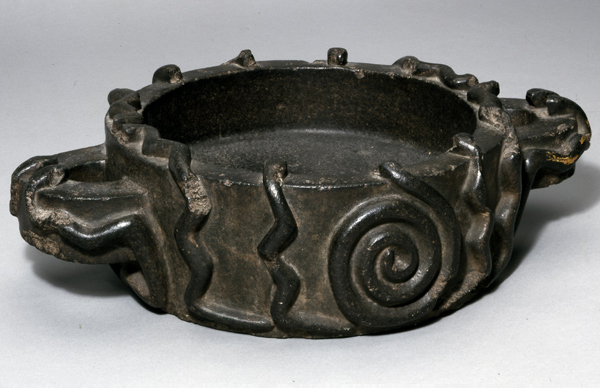
The tightly nestled concentric coils of the snake’s body mimics moving water. Ten serpent heads are symmetrically arranged around the vessel rim in a pattern resembling the ceque system which was used by the Inkas to organize space in Cusco and the land beyond.
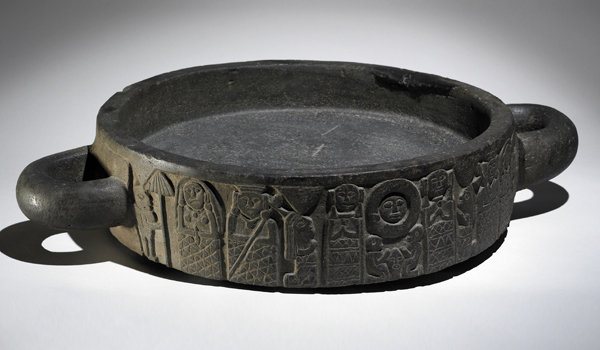
Inka ritual vessels of a similar size are usually carved with spiraling serpents and the example above is no different. But this piece is unique as it is the only known example which is inscribed with figurative scenes. It is thought that these were applied in the early colonial period.

On one side a large central solar disc with a face is flanked by two standing figures with their hands to their chest. Directly beneath the solar disc are two figures kneeling opposite each other with their hands clasped in front of them. Between them is a small diamond-shaped object with a face. The small cult figure appears to be the earthly manifestation or representative of the solar deity.

On the other side, a complementary scene has a male and female figure at the center—possibly the Inka and his queen—who are the focus for a procession comprising a woman with a spindle, a hunchback and llamas being led in from either side.
The scenes are likely to represent key times in the Inka agricultural calendar, perhaps planting or harvest festivals.
The British Museum’s collection includes both Inka (1400-1531 C.E.) and Inka-colonial (sixteenth – eighteenth century) objects. These range from large stone offering vessels (cocha) to miniature gold and silver figurines that were once used as offerings to the mountain deities in Inka state rituals. There are also examples of rare ceremonial pottery vessels fashioned in the form of an Andean foot-plough (chaquitaclla) and used for liquid offerings. After the Spanish conquest native artisans continued to create tapestries and wooden drinking vessels with new kinds of materials and motifs.
Suggested readings:
T.N. D’Altroy, The Inkas (Wiley-Blackwell, 2003).
T.N. D’Altroy, “Transitions in Power: Centralisation of Wanka Political Organisation Under Inka Rule,” Ethnohistory, 34 (1987), 78–102.
T.N. D’Altroy and C.A. Hastorf, “The Distribution and Contents of Inka State Storehouses in the Xauxa Region of Peru,” American Antiquity, 49 (1984), pp. 334–349.
T. Earle, “Wealth Finance in the Inka Empire: Evidence from the Calchaqui Valley, Argentina,” American Antiquity, 59 (1994), pp. 443–460.
D. Guillet, “Terracing and Irrigation in the Peruvian Highlands,” Current Archaeology, 28 (1987), pp. 409–430.
H. Lechtman, “Andean Value Systems and the Development of Prehistoric Metallurgy,” Technology and Culture 25 (1984), pp. 1–36.
S.K. Lothrop, “Gold and Silver from Southern Peru and Bolivia,” Journal of the Royal Anthropological Institute of Great Britain and Ireland, 67 (1937), pp. 305–325.
C. McEwan, Precolumbian Gold: Technology, Style and Iconography (2000).
C. McEwan, Ancient American Art in Detail (London, The British Museum Press, 2009).
C. McEwan, S. La Neice and N. Meeks, “The Gilded Image: Precolombian Gold from South and Central America,” Minerva, 7.3 (1996), pp. 10–16.
M.E. Moseley, The Inkas and their Ancestors (London, 1992).
J. Reinhard, “Sacred Mountains: an Ethno-archaeological Study of High Andean Ruins,” Mountain Research and Development, 5 (1985), pp. 299–317.
P.W. Stahl, “Pre-Columbian Andean Animal Domesticates at the Edge of Empire,” World Archaeology, 34 (2003), pp. 470–483.
© Trustees of the British Museum
City of Cusco

At the breath-taking elevation of 11,200 feet (roughly 3,400 m), the city of Cusco was not just the capital of Tawantinsuyu (“Land of the Four Quarters,” the Inka name for their empire in their native language, Quechua). It was an axis mundi—the center of existence—and a reflection of Inka power. The city was divided into two sections, hanan (upper or high) and hurin (lower), which paralleled the social organization of Inka society into upper and lower moieties (social divisions). Cusco was further divided into quarters that reflected the four divisions of the empire, and people from those sections inhabited their respective quarters of the city. In this way, the city was a map in miniature of the entire Inka empire, and a way for the Inka rulers to explicitly display their power to shape and order that empire. Some scholars think that the city was deliberately laid out so that it was shaped like a puma, symbol of Inka might, but this is still under debate.

The masonry of Cusco displays an understanding of stones as being like people, in that many different ones may fit together if they are properly organized. Each individual stone was pecked with tools and fitted to the one next to it, with the result that blocks will have a varied number of sides, such as the famous Twelve-Sided stone in the walls of Hatun Rumiyoq Street. Some sides of each stone were made to curve outward slightly, others to be slightly concave, so that the stones slotted together, while still allowing a small amount of movement. The ability to move a little was important in an area that is seismically active, protecting the walls from earthquakes.
The city hummed with activity, both secular and religious. Not only the Inka rulers and their nobles resided in Cusco. Local leaders from all sections of the empire also lived in Cusco—often compelled to do so as a means of controlling their home populations. Girls and young women were drawn from across the empire to the capital to serve as cloistered acllas (“chosen women”): to weave fine cloth for gods and nobles and to make corn beer (chicha) for religious rituals, to serve gods in shrines, and in some cases to be given to Inka favorites in marriage. Young men were also brought to Cusco to be educated and raised in the Inka culture. When they returned to their homes, they would be valuable advocates for Inka traditions and power. In addition to the Inka gods and ancestor mummies kept in the capital, there were also the captured gods of subject peoples, brought there as another means of controlling their followers.
Qorikancha

At the heart of hurin Cusco was the Qorikancha (“Golden House”), the most sacred shrine of the Inka, dedicated to the worship of the sun. While the Inka had many gods, they claimed descent from the sun, whom they called Inti, and held the sun’s worship above all others. The Qorikancha was the center point of the empire, and from it radiated imaginary lines, called ceques, which connected it to shrines throughout the Cusco valley. Rebecca Stone refers to the ceques as a “landscape calendar and cosmogram,” as the shrines were also a marker of time, with different noble families tending to and holding rituals at the shrines around the ceque system throughout the year.
After the conquest, the Qorikancha was one of many Inka shrines turned into a Christian holy space. The monastery and church of Santo Domingo were built around and on top of the original shrine, incorporating the old structure into the new one in a way that makes for a strange appearance today. Parts of the old temple are still visible, inside and out, alternating with Spanish Baroque architectural features (see image above).
The Qorikancha itself was renovated by the first emperor, Pachacuti Inka Yupanqui, after he had a mystical revelation that declared him a divine king. All of the doorways, windows, and wall niches of the Qorikancha were the distinctive Inka trapezoid shape, with doorways double-jambed (see image below) to signify the importance of the building.

The exceptionally fine masonry of the Qorikancha was reserved for the most important buildings, since it was even more time-consuming than regular Inka stonework.
Rather than fitting each stone together as an individual shape, creating an irregular-looking surface, here they were shaped into even courses of rectangular blocks, and polished to a smooth finish. The walls were then covered in sheets of gold to signify the shrine’s dedication to Inti, and would have reflected the sun’s rays with a blinding brilliance. But the spectacular, radiant exterior was not the apex of the building’s wonders. Inside, a reproduction of the world in miniature took the shape of a garden made from gold, silver and jewels, with people, animals, and plants. The riches of the Qorikancha would be taken in the looting of the city following the Spanish conquest in 1532, and melted down for their precious materials.
Saqsa Wayman


Saqsa Wayman looks down on the city of Cusco from the northwest. The structure, with its zig-zagging walls, is described as a fortress, although there are still many questions as to how it functioned in that capacity, and the purpose of some of its features is debated. It is possible that it was never finished, or that parts of it were left incomplete at the time of conquest, as Jean-Pierre Protzen has proposed. The stones used to construct it were much larger than those used in the streets and houses of Cusco, as can be seen in the photo at left. The stones were quarried and hauled into place using considerable manpower, obtained through the mit’a, or labor tax, that all able-bodied people of the empire owed the Inka.
Additional resources:
Video from Unesco on the City of Cusco
Carolyn Dean, A Culture of Stone: Inka Perspectives on Rock, (Durham, NC: Duke University Press, 2010).
Rebecca Stone, Art of the Andes: From Chavín to Inca (New York: Thames and Hudson, 2012).
Jean-Pierre Protzen, “The Fortress of Saqsa Waman: Was It Ever Finished?,” Ñawpa Pacha: Journal of Andean Archaeology, no. 25/27 (1987), pp. 155-75.
Rebecca Stone-Miller, Art of the Andes: From Chavín to Inca (New York: Thames and Hudson, 2012).
An Inka paccha

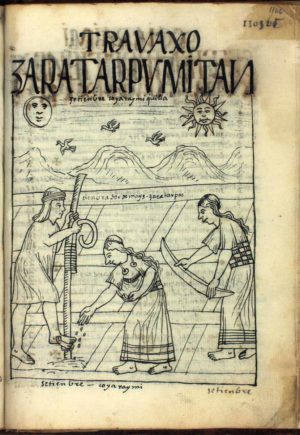
Felipe Guaman Poma de Ayala, in his massive colonial treatise The First New Chronicle and Good Government (or El primer nueva corónica y buen gobierno), dedicated an entire chapter to the months of the year and the traditional Inka agricultural activities associated with them. Planting, tending, and harvesting plants are all depicted, but one aspect of Inka farming prior to the arrival of the Spaniards is missing — the ceremonial use of a ritual watering device, known in Quechua as a paccha (POCK-cha).
Because Guaman Poma was interested in showing the Spanish king that the natives of the Andes, and especially the Inka, had become good Christians, he may have left out the paccha and its ritual use as an unnecessary reminder of pre-Christian traditions that the Spaniards considered idolatry.
Iconography of maize
While pacchas come in several styles and different imagery (in part due to the extensive reach of the Inka empire and local variations), the one seen above incorporates a sophisticated symbolism in its component parts that signals its purpose as a ritual device intended to promote agricultural fertility. Its three parts are composed of a taclla, or foot plow, an urpu or storage vessel, and an ear of corn, more properly called maize (Zea mays). When used in a ritual at the beginning of the planting season, the paccha symbolically encompassed the entire cycle of maize farming and use in the Inka world.
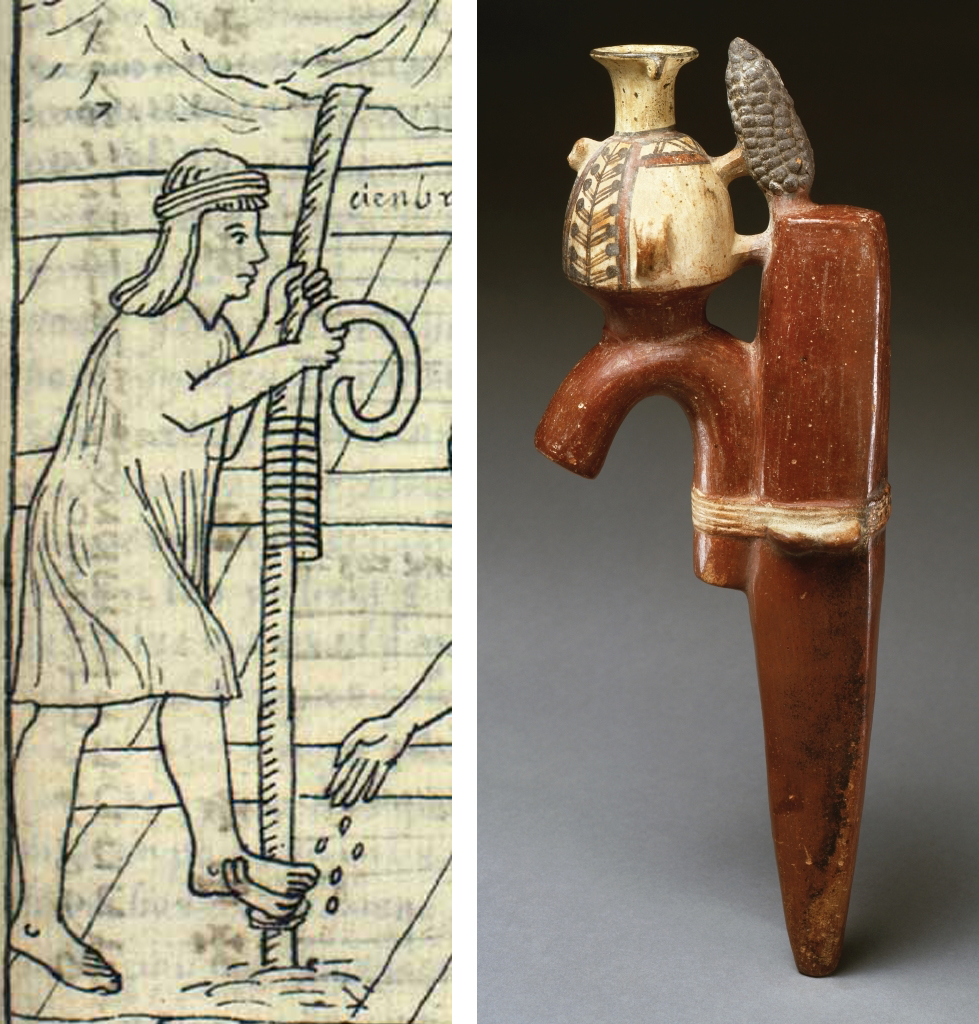
The taclla that forms the long portion of the paccha is a truncated version of the real farming implement. As we can see in a detail from Guaman Poma’s illustration, the portion in the paccha is the lower part, the part that is pushed into the soil to create a hole for seeds to be planted, combined with the curved handle from the upper portion. It represents the beginning of the agricultural year, when the soil is prepared and then planted. The form of the taclla is smooth and simple, an idealized form of the two pieces of wood bound tightly with string.
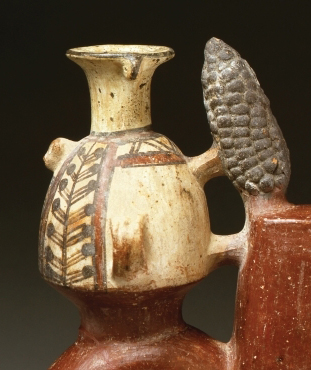
At the top of the taclla is a small ear of maize, painted with a black slip. It is highly naturalistic, and that is because it was made by taking an actual ear of maize and pressing two soft pieces of clay around it to form a mold. Once dry, the mold was used to create the ceramic replica.
The maize cob represents the growing and harvest portion of the agricultural year, the production of this symbolically and functionally important crop. Inka art runs the gamut from highly naturalistic to completely nonrepresentational, and it is perhaps a testament to maize’s importance that the cob on the paccha was produced with such exactitude. However, not all pacchas treated maize so naturalistically. A pair of similar pacchas (seen below) show a less careful construction, especially in the depiction of the maize cob. Rather than being molded from a real cob, the form was sculpted, giving it a more textured appearance.
The urpu perched next to the maize cob is a form of storage vessel that was produced in large quantities throughout the Inka empire. They are characterized by two handles on the lower sides of the vessel and a nub or small projection near the neck, which allowed a rope to be passed through the handles and looped over the nub so that it could be carried on a person’s back or as part of a llama’s pack. The pointed bottom of the vessel allowed it to be pushed into the earth for stability when being stored. Urpus had several uses, but principal among them was storage of maize and brewing of chicha, a type of beer made from maize that was an integral part of Inka social rituals. The urpu represents the use of the products of the agricultural cycle, especially the production of chicha and its use in feasting and religious rituals.
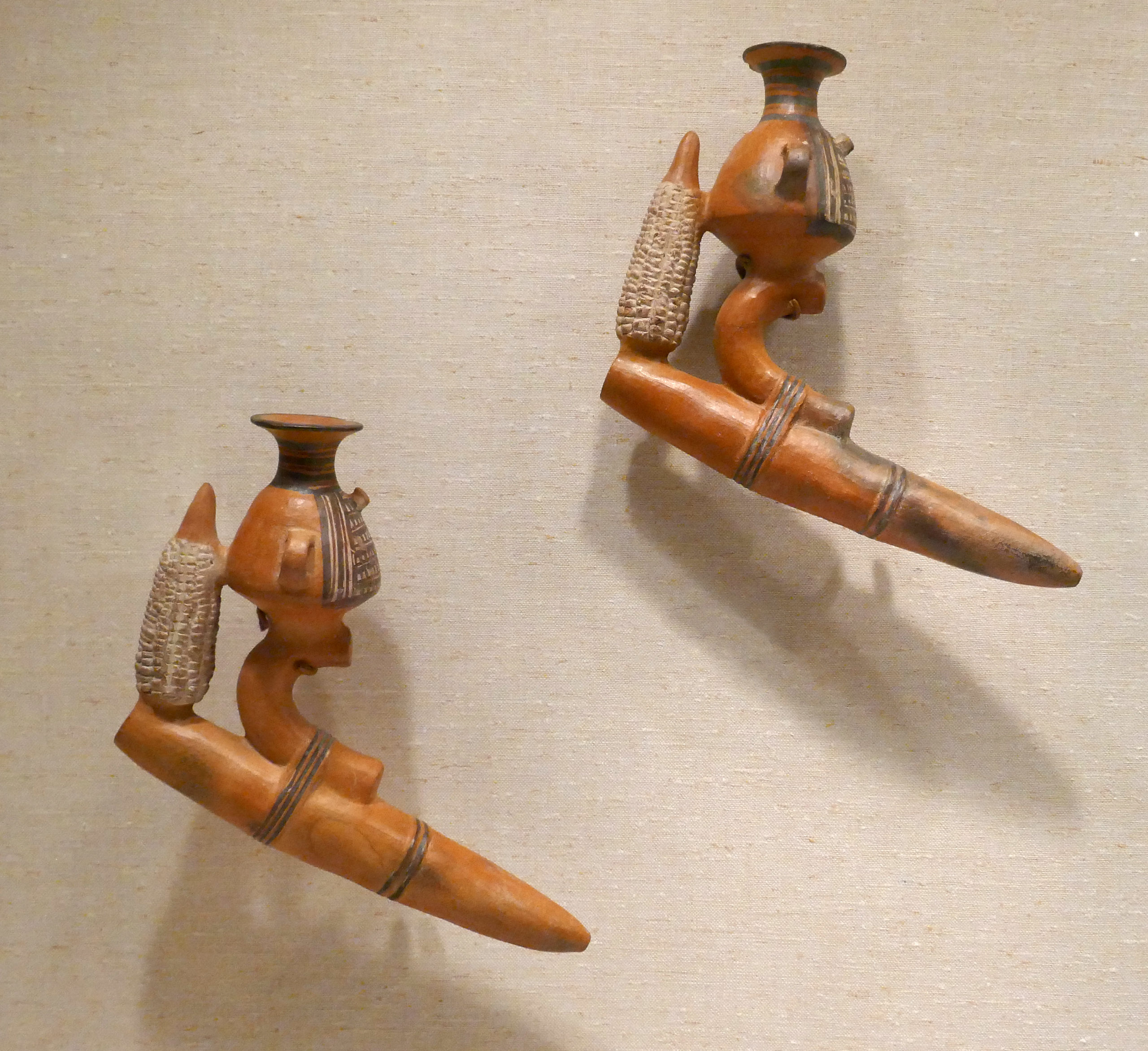
Feeding the earth, enacting obligation
The ceremony that the paccha was used in “fed” chicha back to the earth. The point of the taclla was pushed into the prepared field (you can see some damage at the base of the paccha, probably indicating it was used for many rituals over time). Chicha was mixed with some soil, and poured through the paccha into the ground. This action imbued the soil for the coming agricultural year with some of the success of the last one, “fed” the earth, and made it ritually fertile and ready to continue the agricultural cycle. By making the paccha a microcosm of that cycle, it added further spiritual power to the ritual of watering the earth with chicha.
Extensive scientific analysis by Dr. Rebecca Stone and other specialists at Emory University has been able to pinpoint considerable specific information about this paccha. Residue from the ritual use of the device left behind not just traces of chicha, but also sand particles that can be identified as from the Chancay river valley of coastal Peru, an area that was conquered by the Inka. In addition, the level of detail in the maize cob made it, too, identifiable. It is a strain that was grown in the Chancay valley, having been developed in the Cusco region and brought to the coast with the Inka conquest.
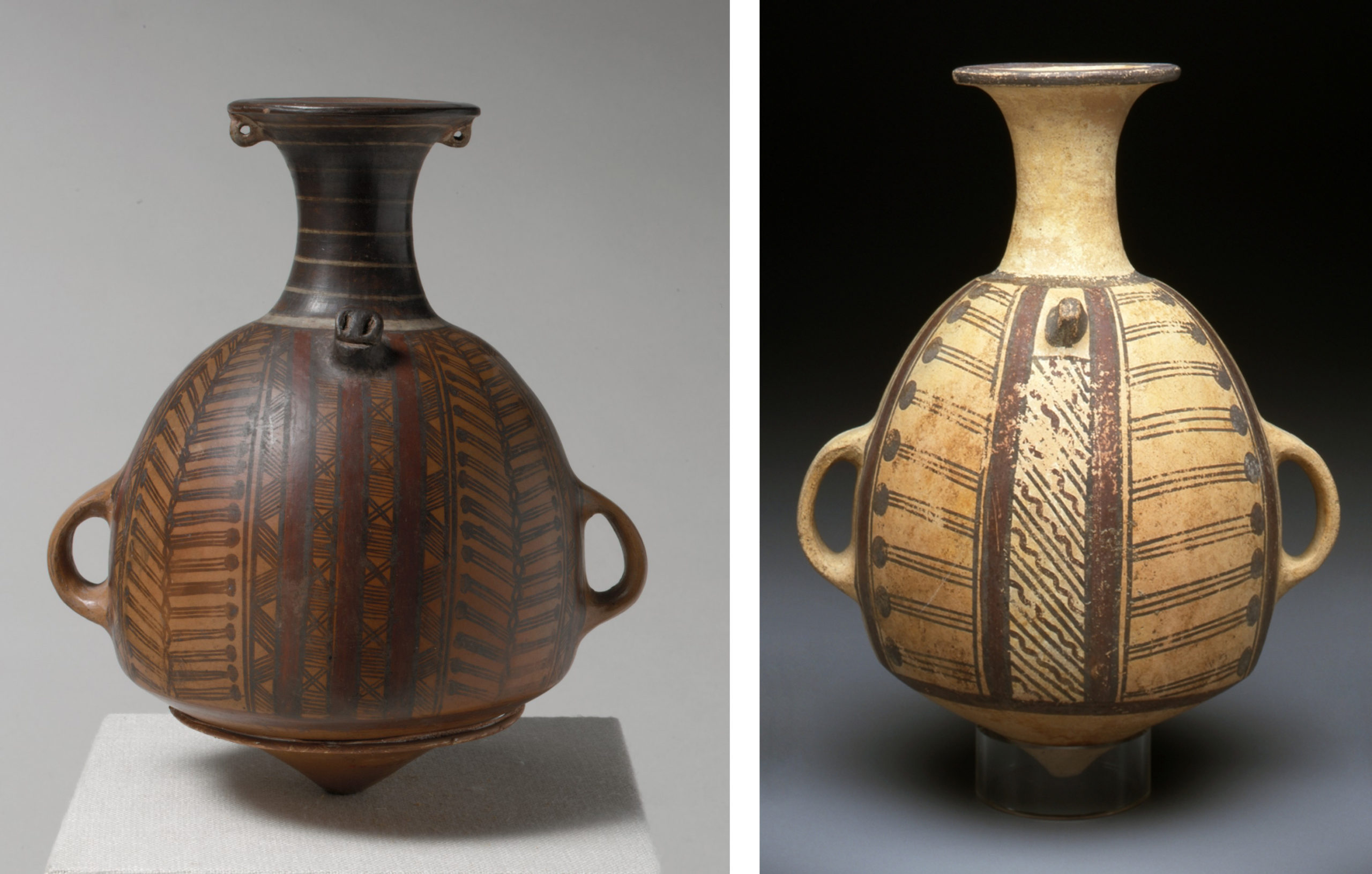
The urpu on the paccha is also something that has Inka-Chancay connections: it is a Chancay-style version of the traditional Inka form. The urpus seen above are similar in form, but have different painting styles. The one on the left is from the Cusco region, and is painted with multiple colors on an orangey background. The one on the right was made in the Chancay valley during the Inka occupation, and uses a Chancay color palette of brown-black colors over a light cream. They both feature the same abstract motif featuring a long upright line, with smaller forms consisting of three parallel lines ending in a circle projecting from it. This is a common motif, and has been interpreted as an abstraction of a maize plant by some scholars, although others speculate that it is meant to represent a khipu (an information-encoding device made from knotted string).
The ritual this paccha was made for would have been enacted in fields the Inka owned in the Chancay lands they had conquered. It would have been the first “drink” of the agricultural year that the dry soil had on the arid coast, a gift from the Inka that the earth would be obligated to pay back in maize. Soon after the soil had been planted, the more commonplace watering via irrigation would commence, but that first watering with chicha was considered just as important to a successful harvest. It was part of an Inka worldview that emphasized reciprocal obligations that knit the various levels of the empire together. This meant drinking chicha with the earth, with the ancestors, with supernatural forces, and at feasts, drawing all of existence into a web that the Inka ruled.
Additional resources:
Rebecca Stone-Miller, Seeing With New Eyes: Highlights of the Michael C. Carlos Museum Collection of Art of the Ancient Americas (Atlanta: Michael C. Carlos Museum, 2002).
Maize cobs

A garden of gold and silver
Imagine a garden of miniature llamas, corn, flowers, and people all made of gold and silver. Such a garden existed in the courtyard in one of the most important Inka temples, the Qorikancha, in the capital city of Cusco. One of these beautiful metal objects is a gold-silver alloy corncob sculpture. It mimics the appearance of a ripe ear of corn breaking through its husk, still on the stalk but ready to be harvested. In this sculptural representation of maize (Zea mays), individual kernels of corn protrude from the cob that is nestled in jagged metallic leaves. Inka metalsmiths expertly combined silver and copper to mimic the internal and external components of actual corn. Hollow and delicate, the ears of corn on the stalk are life-sized.
While many ancient Andean art traditions favored abstract and geometric forms (such as the All-T’oqapu Tunic), Inka visual expression often incorporated more naturalistic forms in small-scale metal objects. This silver alloy corncob sculpture is one example of this type of object.
After the Spaniards arrived in the Andes, the European invaders soon desired the gold and silver belonging to the Inka. Some of the earliest Spanish chroniclers record the placement of a garden composed of gold and silver objects among many of the offering and ritual spaces in the Qorikancha. Pedro de Cieza de León describes a golden garden in his 1554 account:
In the month of October of the year of the Lord 1534 the Spaniards entered the city of Cuzco, head of the great empire of the Inkas, where their court was, as well as the solemn Temple of the Sun and their greatest marvels. The high priest abandoned the temple, where [the Spaniards] plundered the garden of gold and the sheep [llamas] and shepherds of this metal along with so much silver that it is unbelievable and precious stones, which, if they were collected, would be worth a city.¹


After the defeat of Inka leadership in the 1530s, Spanish royal agents set up colonies across the continent. They looted Inka objects in large quantities and sent many back to Spain. The silver corncob and stalk were likely part of the spoils captured in this raid. By 1534, the collections of the Spanish king Charles V included a gold maize stalk with three leaves and two ears of corn, similar to the one above. Royal inventories also describe gold and silver llamas, female figures, a lamb, and a male figure that purportedly originated in in one of the most important Inka temples in the capital city of Cusco, the Qorikancha.
A compact version of the Inka cosmos
The life-size garden was a significant offering within the Qorikancha where it became part of a compact version of the cosmos controlled by the Inka state. It also represented the vast range of ecosystems encompassed by the empire and the most important agricultural products cultivated in them. The empire reached from the desert coasts to over 6000 feet above sea level. Plants and animals represented in the golden garden cannot grow and survive at every point in the empire, but only at specified altitudes. For example maize grows up to a mid-range altitude, and llamas graze at the highest points of the empire. The metallic maize cobs would have represented one of the most important imperial foodstuffs, used for making the chicha (maize beer) consumed at political feasts, which cemented the obligations of local political leaders to the Inka state .
For centuries, an organized “vertical archipelago” system and terracing technologies allowed Andean people to obtain the foods and materials that they needed to survive from different elevations. The Inka adopted these systems, enhanced them, and exploited them on an imperial scale. The Qorikancha’s garden asserted the natural world as a possession of the Inka at the same time it reinforced their divine right to rule across the Andes.

The Inka commonly deployed small-scale naturalistic metallic offerings, like the silver alloy corncobs, in ritual practices that supported state religion and government. Offerings have been found across Inka territories. Besides corn, these offerings included small gold and silver human figurines ornamented with textiles that accompanied qhapaq hucha sacrifices at the furthest reaches of the empire. All these offerings acted as symbols of the supernatural origin of the Inkas in the Sun, and their control over the natural world as descendants from the most powerful deity.
1. Pedro Cieza de León, The Discovery and Conquest of Peru: Chronicles of the New World Encounter, ed. and trans. Alexandra Parma Cook and Noble David Cook (Durham and London: Duke University Press, 1998), 316–19.
Additional resources:
Gold of the Indies on The Metropolitan Museum of Art’s Heilbrunn Timeline of Art History
Machu Picchu

A royal estate
Machu Picchu is often described as “mysterious,” but in fact a great deal is known about its construction and purpose. It was built as a royal estate for the first Inka emperor, Pachacuti Inka Yupanqui, in the middle of the 15th century, on a mountain saddle overlooking the Urubamba River (in modern day Peru). The location was approximately three days’ walk from the Inka capital of Cusco, and nearly 3,000 feet lower in elevation (7,972 feet / 2,430 meters), with a pleasant climate. It was intended as a place where the Inka emperor and his family could host feasts, perform religious ceremonies, and administer the affairs of empire, while also establishing a claim to land that would be owned by his lineage after his death. The site was chosen and situated for its relationship to the Andean landscape, including sight lines to other mountain peaks, called apus, which have long been considered ancestral deities throughout the Andes. The site contains housing for elites, retainers, and maintenance staff, religious shrines, fountains, and terraces, as well as carved rock outcrops, a signature element of Inka art.
Architecture

The site features architecture, from houses to terraces, built by carefully fitting individual stones against each other. Terraces were a common element of highland agriculture long before the Inka. They increased the arable land surface and reduced erosion by creating walled steps down the sides of steep mountains. Each step could then be planted with crops. Terracing took advantage of the landscape and provided some sustenance for the emperor and his entourage during his visits, as well as producing ritually-important maize crops. Further provisions came from the rich lands at the foot of the mountain peak, which were also beholden to Pachacuti and his family.

Water management at the site was crucial, and throughout Machu Picchu a system of stone channels drains water from rainfall and from a spring near the site. Some of the water was chanelled to stone fountains. There are sixteen in all, descending in elevation through the site. The first in the series is placed outside the door of the emperor’s compound. That fountain is constructed with walls that may have created a ritual bath for the emperor, connected to his duties as a sacred king who performed religious rituals.
The construction of the main buildings is typical of Inka elite architecture. The walls were built of stones that had been individually shaped to fit closely with one another, rather than being shaped into similar units. This was accomplished by a laborious process of pecking at the stones with tools, gradually shaping them so that each stone was uniquely nested against those around it. Each stone had some sides that protruded slightly, and some with slight concave faces, socketing the stones so that they held together, but allowed for earthquake-damping movement in this seismically active region. Outward faces were then worked smooth, so that the walls resemble an intricate mosaic. Most structures were roofed with wood and thatch. Entryways were in the unique Inka shape of a trapezoid, rather than a rectangle. The trapezoid shape was also used for niches and windows in the walls of buildings. Buildings for people or activities of lower status were made using a rough construction technique that did not take the time to shape the stones.

Population and social dynamics
The emperor and his retinue would only reside at Machu Picchu for part of the year. Most of the people who lived there permanently were yanaconas (retainers) and mitimaes (colonists obligated to move to their location). Graves at Machu Picchu have yielded evidence that many of the yanaconas there were craftspeople, including metalsmiths, who came from all over the empire. The ability to command people across the empire and to oblige them to work for the Inka nobility was an expression of imperial power. The buildings of Machu Picchu clearly show the social divisions of the site, with most of the high-status residential buildings in a cluster to the northeast. The emperor himself lived in a separate compound at the southwest of the site, indicating his unique status as the ruler. The Observatory (below) was adjacent to the royal residence, emphasizing the relationship between the elites, religious ritual, and astronomical observation, including Pachacuti’s claim as both a descendant of the sun (whom the Inka called Inti) and the sun himself.

One of the obligations of the royal family was performing rituals that sustained relationships with the supernatural forces that drove existence. The number of religious structures at Machu Picchu is high, indicating that Pachacuti and his lineage were heavily involved in the religious functioning of the empire, a task that underscored his right to rule.
Observatory
Also called the Temple of the Sun, this building’s purpose is echoed in its unique shape. It is composed of two main parts: an upper curved stone enclosure with windows and niches placed in it, and a cave beneath this structure with masonry additions that hold more niches. Modifications of the windows in the Observatory’s upper walls indicate that they were used to calculate the June solstice, as well as the first morning rise of the constellation Pleiades and other important constellations. The cave beneath the enclosure may refer to the place of the underworld in Inka myth, making the Observatory a building that embodied cosmological thought as much as it facilitated astronomical observation.
Intihuatana

The Intihuatana (“hitching post of the sun”) is a carved boulder located in the ritual area of the site, to the west of the main plaza. Carved boulders were a part of the Inka relationship with the earth, and expressions of belief in a landscape inhabited by supernatural forces. Carved boulders of this type are found throughout the heart of the Inka empire. The stone’s name refers to the idea that it was used to track the passage of the sun throughout the year, part of the reckoning of time used to determine when religious events would take place and similar to the Observatory.
Backstory
Due to its status as an important piece of both global and Peruvian heritage, Machu Picchu has recently become the focus of international attention with regard to both the repatriation of artifacts from the site, and preservation of the existing structures against environmental and human impact.
Covered by jungle and known only to locals since the sixteenth century, Machu Picchu was uncovered by Hiram Bingham III, a professor of South American history at Yale University, in 1911. In addition to the structures at the site, he and his team excavated thousands of artifacts, including ceramics, tools, jewelry and human bones, which he brought back to Yale under an agreement with the Peruvian government at the time. The agreement stipulated that the artifacts could be studied at Yale, with the provision that they could be requested and returned to Peru at any time. Since then, most of the objects have been housed at Yale’s Peabody Museum.
Despite Peru’s repeated demands for the objects’ return over the last century, it took a U.S. federal court case and the intervention of Peru’s president to finally secure their repatriation in 2010. According to the Peabody museum website,
In a gesture of friendship and in recognition of the unique place that Machu Picchu has come to hold for the people of Cuzco and the Peruvian nation, Yale agreed to return to Peru materials excavated by Bingham at Machu Picchu in 1912. This was the basis of a diplomatic resolution of the dispute between Yale University and the Peruvian government. The agreement was formalized in a Memorandum of Understanding with the Government of Peru on November 23 2010, a second Memorandum of Understanding with the University of Cuzco (UNSAAC) on February 11, 2011, and the return from the Peabody Museum of materials from Machu Picchu in 2011 and 2012.
The agreement has resulted in ongoing research cooperation between Yale and UNSAAC, and is an example of how repatriation efforts can lead to new and fruitful opportunities for cooperation.
The site of Machu Picchu itself is also now the focus of governmental efforts, as authorities attempt to cope with the great numbers of visitors and their impact on the site, in addition to environmental and agricultural factors that threaten the integrity of the landscape. According to the UNESCO website,
the Historic Sanctuary of Machu Picchu is among the greatest artistic, architectural and land use achievements anywhere and the most significant tangible legacy of the Inca civilization.…The strongly increasing number of visitors to the Historic Sanctuary of Machu Picchu must be matched by an adequate management regulating access.…The planning and organization of transportation and infrastructure construction, as well as the sanitary and safety conditions for both tourists and new residents attracted by tourism requires the creation of high quality and new long-term solutions, and is a significant ongoing concern.
The government of Peru recently instituted a ticketing system that caps the number of visitors and requires them reserve and pay for daily time slots at the site. Still, UNESCO warns that
Since the time of inscription consistent concerns have been expressed about ecosystem degradation through logging, firewood and commercial plant collection, poor waste management, poaching, agricultural encroachment…, introduced species and water pollution …, in addition from pressures derived from broader development in the region…. Continuous efforts are needed to comply with protected areas and other legislation and plans and prevent further degradation.
Given the number of agencies involved in planning and protecting Machu Picchu, UNESCO states, achieving an adequate master plan for the site is an ongoing challenge. Machu Picchu is only one of many such world heritage sites around the world that are dealing with the threats brought by increased visitation, and it points to the tensions between the need for everyone to enjoy and benefit from the experience of seeing these magnificent sites, and the need to preserve them for future generations.
Backstory by Dr. Naraelle Hohensee
Additional resources:
Video from UNESCO on Machu Picchu
Historic sanctuary of Machu Picchu from UNESCO
Richard L. Burger and Lucy C. Salazar, Machu Picchu: Unveiling the Mystery of the Incas (New Haven: Yale University Press, 2004).
Carolyn Dean, A Culture of Stone: Inka Perspectives on Rock (Durham, NC: Duke University Press, 2010).
Lucy C. Salazar, “Machu Picchu: Mysterious Royal Estate in the Cloud Forest,” in Machu Picchu : Unveiling the Mystery of the Incas, edited by Richard L. Burger and Lucy C. Salazar (New Haven: Yale University Press, 2004).
Lucy C. Salazar, “Machu Picchu’s Silent Majority,” in Variations in the Expression of Inka Power : A Symposium at Dumbarton Oaks, 18 and 19 October 1997, edited by Richard L. Burger, Craig Morris, Ramiro Matos Mendieta, Joanne Pillsbury and Jeffrey Quilter (Washington, D.C.; [Cambridge, Mass.]: Dumbarton Oaks Research Library and Collection ; Distributed by Harvard University Press, 2007).
Peru-Yale Partnership for the Future of Machu Picchu Artifacts from Yale News
Machu Picchu: The Agreement between Yale and Peru on the Peabody Museum website
“Finders Not Keepers: Yale Returns Artifacts To Peru” and “Yale Returns Machu Picchu Artifacts To Peru”, NPR News, 2010 and 2011
“Will new limits on visiting Machu Picchu save Peru’s most famous Inca citadel?” The Telegraph, June 21, 2017
All-T’oqapu Tunic
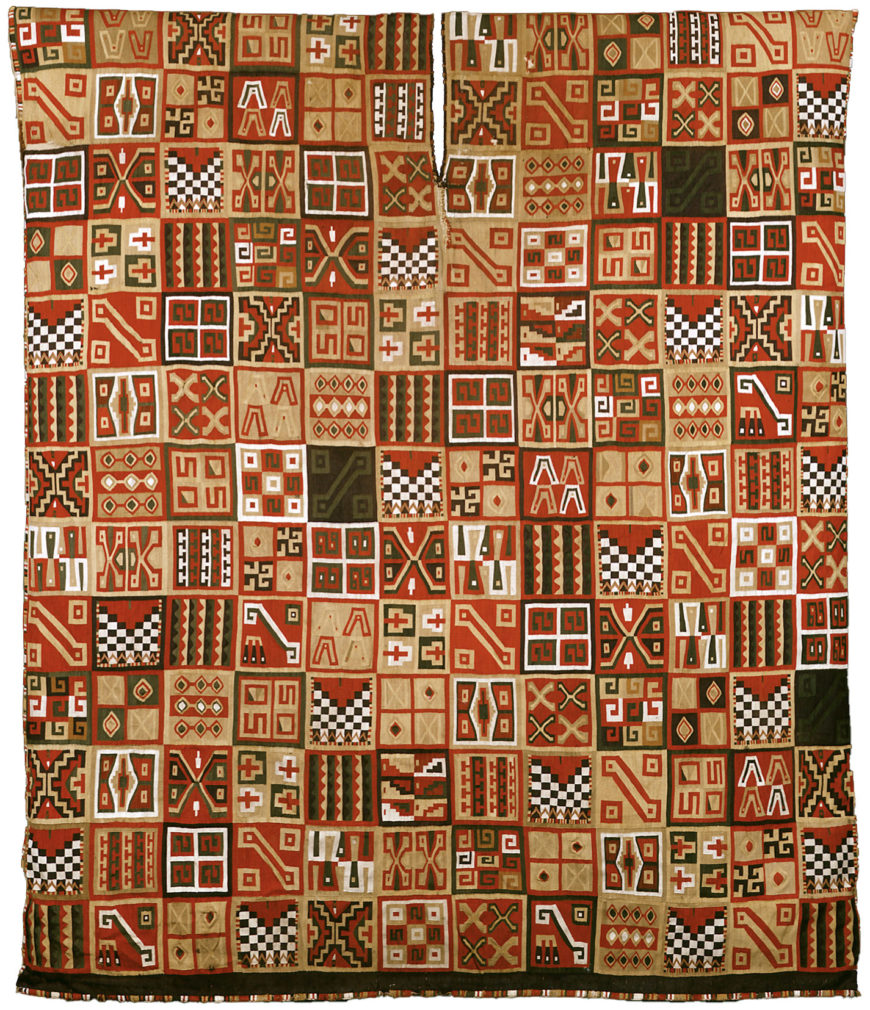

The Inka were masters of statecraft, forging an empire that at its height extended from modern Quito, Ecuador to Santiago, Chile. One of the engines that drove the empire was the exchange of high-status goods, which helped to secure the reciprocal but unequal economic and power relationships between the Inka and their subjects. Precious materials such as Spondylus shell from the warm waters of coastal Ecuador or gold from remote mountain mines were shaped into high-status objects. These were given to local leaders as part of a system of imposed obligations that gave the Inka the right to claim portions of local produce and labor as their due. Along with jewels, political feasts and gifts of finely-made textiles would also cement these unequal relationships.
Textiles and their creation had been highly important in the Andes long before the Inka came to power in the mid-15th century—in fact, textile technologies were developed well before ceramics. Finely-made textiles from the best materials were objects of high status among nearly all Andean cultures, much more valuable than gold or gems. The All-T’oqapu Tunic is an example of the height of Andean textile fabrication and its centrality to Inka expressions of power.
The making of Andean textiles


Weaving in Andean cultures was usually done on backstrap looms made from a series of sturdy sticks supporting the warp, or skeletal threads, of the textile. A backstrap loom is tied to a post or tree at one end, while the other end is attached to a strap that passes around the back of the weaver. By leaning forward or tilting back, the weaver can adjust the tension on the warp threads as he or she passes the weft threads back and forth, creating the pattern that we see on the surface of the textile. By the time of the Inka, an incredible number of variations on this basic technique had created all kinds of textile patterns and weaves.

The two main fibers spun into the threads of the tunic came from cotton and camelids. Cotton plants grew well on the Andean coast, in a variety of natural colors. Camelids thrived in the highlands (this includes the wild guanacos and vicuña and their domesticated brethren, the llama and the alpaca). Most Andean camelid-fiber textiles were made with the silky wool of the alpaca. Animal fibers are more easily dyed than plant fibers, so when weavers wanted bright colors they most commonly used alpaca wool. The All-T’oqapu Tunic is made of dyed camelid wool warp over a cotton weft, a common combination for high-status textiles.
Collecting, spinning, and dyeing the fibers for a textile represented a huge amount of work from numerous people before a weaver even began their task. Some dyes, like cochineal red or indigo blue, were especially prized and reserved for high-status textiles. Cochineal dye comes from the bodies of small insects that live on cacti, and it takes thousands of them to make a small amount of dye. Indigo dyeing requires a high level of technical skill and a large investment in time. Red- and blue-dyed textiles were not only beautiful, they also represented the apex of the resources needed to produce them and the social and political power that commanded those resources.
In the Inka empire, textiles were produced by a number of groups, but the finest cloth, called qompi in Quechua (the language of the Inkas), was produced by acllas (“chosen women”), women who were collected from across the empire and cloistered in buildings to weave fine cloth. The acllas also performed religious rituals, and made and served chicha (corn beer) at state feasts. These women spun, dyed, and wove fibers that were collected as part of the Inka taxation system. The textiles they produced were then given as royal gifts, worn by the royal household, or burned as a precious sacrifice to the sun god, Inti. The threads in the All-T’oqapu Tunic were spun so finely that there are approximately 100 threads per centimeter, making for a light, strong weave. It was traditional to weave garments in a single piece if possible, as cutting the cloth once it was off the loom would destroy its spirit existence (camac), which formed as it grew on the loom. The All-T’oqapu Tunic is a single piece of cloth, woven with a slit in the center for the head to pass through, and folded over and sewn together along the sides with spaces left open as arm holes.
Iconography

The decoration of the tunic is where its name derives from. T’oqapu are the square geometric motifs that make up the entirety of this tunic. These designs were only allowed to be worn by those of high rank in Inka society. Normally, an Inka tunic with t’oqapu on it would have a band or bands of the motif near the neck or at the waist. Individual t’oqapu designs appear to have been related to various peoples, places, and social roles within the Inka empire. Covering a single tunic with a large variety of t’oqapu, as seen in this example, likely makes it a royal tunic, and symbolizes the power of the Inka ruler (the Sapa Inka). The Sapa Inka’s power is manifest in the tunic in several ways. Firstly, its fine thread, expert weave, and bright colors signify his ability to command the taxation of the empire, access to luxury goods like rare and difficult dyes, and the weaving expertise of the acllas. Secondly, among the t’oqapu in the tunic is one pattern than contains a black and white checkerboard. This was the tunic pattern worn by the Inka army, and shows the Sapa Inka’s military might. Lastly, the collection of many patterns shows that the Sapa Inka (which means “unique Inka” in Quechua) was a special individual who held claim to all t’oqapu and therefore all the peoples and places of his empire. It is a statement of absolute dominion over the land, its people, and its resources, manifested in an item that is typically Andean in its material and manufacture.
Additional resources:
Andean Textiles on The Metropolitan Museum of Art’s Heilbrunn Timeline of Art History
Raoul d’Harcourt, Textiles of Ancient Peru and Their Techniques, Seattle: University of Washington Press, 1974.
John Murra, “Cloth and Its Functions in the Inca State,” American Anthropologist 64 (1962), pp. 710-728.
Rebecca Rollins Stone, “”And all theirs different from his”: The Dumbarton Oaks royal Inka tunic in context,” in Variations in the Expression of Inka Power, edited by Joanne Pillsbury, Jeffrey Quilter, Richard Burger, Craig Morris and Ramiro Matos (Washington, D.C.: Harvard University Press, 2007), pp. 385-422.
Rebecca Stone-Miller, To Weave For The Sun: Ancient Andean Textiles (Boston: Thames and Hudson, 1992).
Keru Vessel
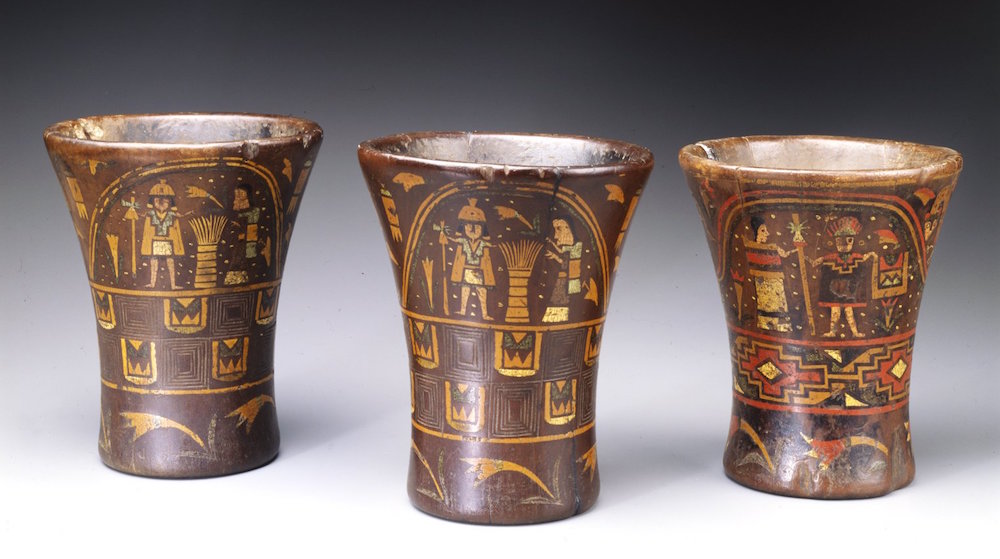
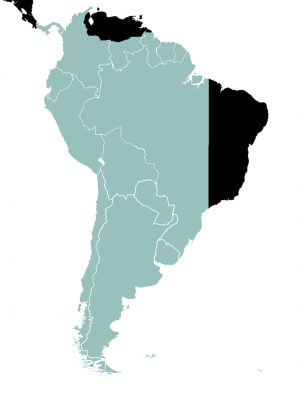
On a vibrantly colored keru cup from colonial Peru, exotically dressed figures, apparently a royal Inka couple, stand surrounded by flowers, vivid designs, and even a rainbow. A keru is a ceremonial Andean beaker that was an important part of Inka culture prior to the arrival of the Spaniards. This vessel was produced in the Viceroyalty of Peru, a Spanish colonial administrative district created in 1542 that included large parts of South America. It might surprise us to find Inka on a colonial vessel—a time after the arrival of the Spanish conquistadors (conquerors). But, although we speak of a Spanish “conquest” of the Andes, which started in the 1530s, Inka society did not disappear after the European invasion. Aspects of social and political bonds, religion, cults, and art—although often reduced or mixed with European characteristics—persisted. Even with the clash of cultures, the Inka (among other peoples) adapted to the new circumstances, as did the European intruders. The Spaniards were challenged to understand an indigenous society where nature was sacred, the sun, moon, stars, mountains, and rivers were venerated as gods and even the ruler, the Sapa Inka, was deified.
The Inka continued to use these types of cups in the early viceregal era, but soon the Spaniards grew suspicious. Why did the Andeans insist on continuing to use them? Were they somehow powerful? Was it possible to hide secret messages in their mysterious iconography that could evoke rebellions against Spanish rule? The Spaniards ultimately decided to destroy kerus in massive campaigns in the later sixteenth century.
A cup not made merely for drinking
Keru (also spelled kero or quero) vessels are typically associated with Inka culture (15th-16th century), but they originated with the Tiwanaku culture (6th – 9th century) in present-day Bolivia. They can also be found in other Andean societies like the Wari (8th – 10th century), Sicán (10th – 11th century—see the image below), Chancay (12th-14th century) or Chimú (14th – 16th century) in the territory of what is today Peru.
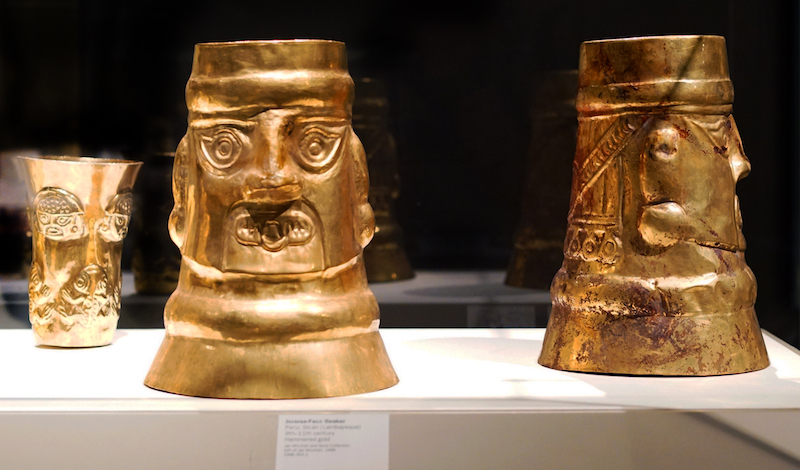
The Andean Quechua term keru primarily specified a “wooden cup.” While wood is the most common material of these vessels, there are also examples made of gold or silver (correctly, although not commonly, called aquillas), stone, or ceramic. Although precious metals like gold and silver did not have the same meaning for Andeans as for Europeans, the material did matter. Associated with the luminous sun, golden kerus were reserved for the Inka ruler. Venerating nature, especially the sun and the moon, the Inka saw their ruler as the descendant of the sun god and his wife as the daughter of the moon. In the same way, the silver cups, reflecting divine moonlight, had a high value in Andean society. Wooden or stone cups could also elevate a person’s status, depending on the degree of craftsmanship and decoration. In contrast, simple or undecorated vessels were used by the common population in their daily lives or in small ceremonies during which they prayed for fertility or the benevolence of the gods.
Kerukamayoq (querocamayoc) were responsible for the production of the kerus. These specialists had an exceptional position in Andean society that came with privileges, such as exemption from farming. Even after the Spanish conquest, the production of kerus was restricted to these indigenous artisans.
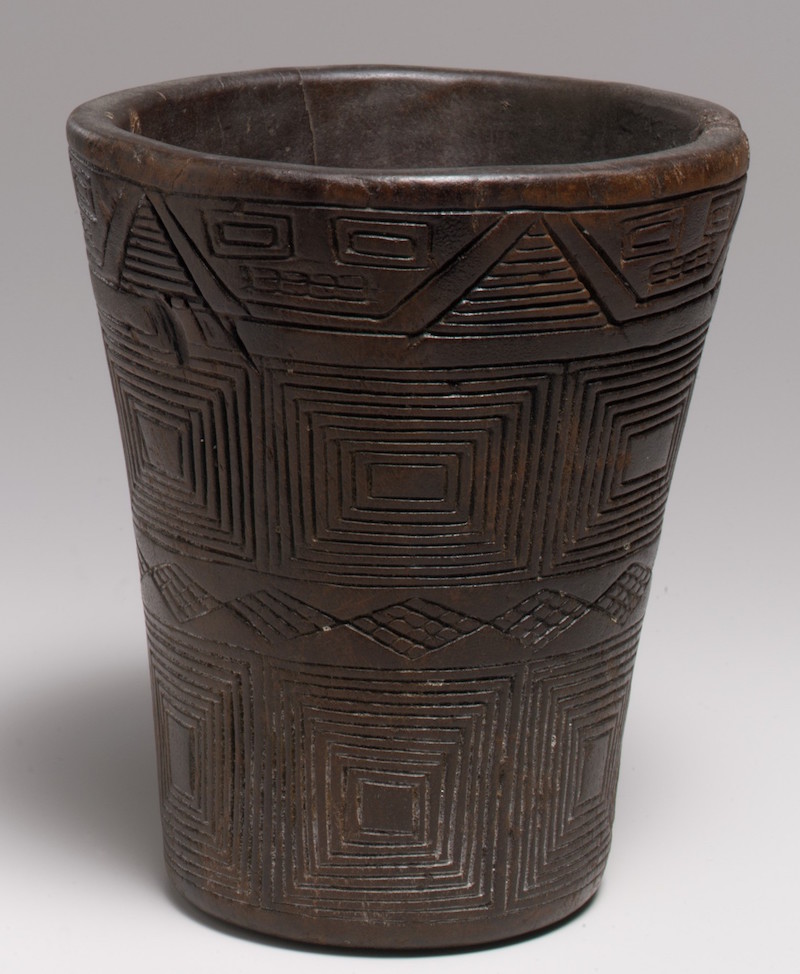
In pre-Hispanic times, the decoration of Inka kerus, if there was any, consisted solely of monochromatic carved geometric patterns, for example rectangles, rhombs, triangles, and lines. A few later exceptions showed abstract figures like llamas or even faces. It is possible that there is a deeper meaning behind these designs—they may refer to religious beliefs or traditions or may have revealed details about their owner.
In pre-Hispanic as in colonial times, the keru was not a mere drinking vessel but rather a ceremonial beaker, used during rituals and political ceremonies to establish and fortify important religious, social, and political relations. It had enormous symbolic power, even after the arrival of the Spaniards. To demonstrate the divine nature of rulers, rituals were performed in public during which the Sapa Inka exchanged identical keru pairs filled with chicha (maize beer) with his “father,” the sun, in a divine toast. The symbolic power of the kerus was transferred to secular issues, so that the exchange of kerus also took place between two Andean rulers, commonly the Sapa Inka and a soon-to-be ally, to formalize an agreement.
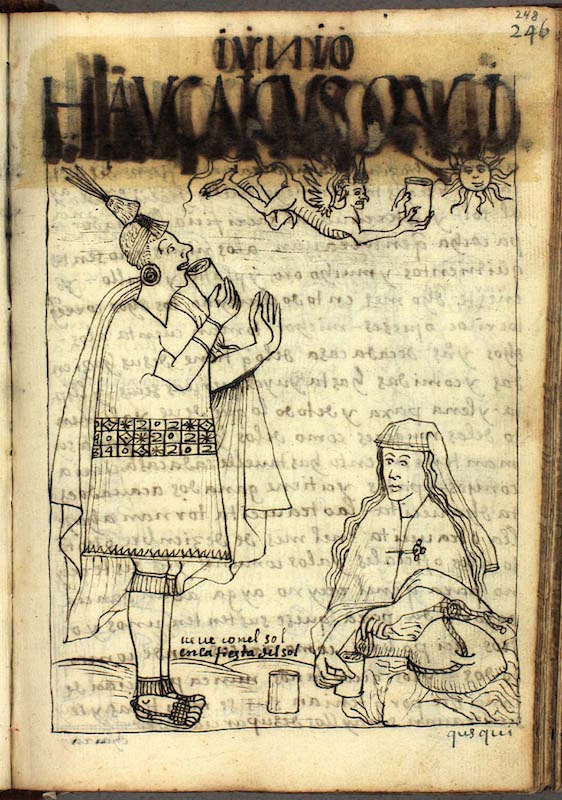
With the arrival of the Spaniards in the Inka region around 1530, new pictorial conventions were introduced to the Andes. Adapting to the European traditions, traditionally abstract keru decoration began to incorporate figurative scenes. The meaning of the images may have been easier to comprehend by the new colonial society as they contained recognizable figures, symbols, and narratives. Representations of daily Andean life now appeared on the kerus, as well as newly introduced colonial rituals, such as the branding of the cattle. These images also contained symbolism only decipherable by Andean insiders, like the kerukamayoq.
A world of powerful symbolism
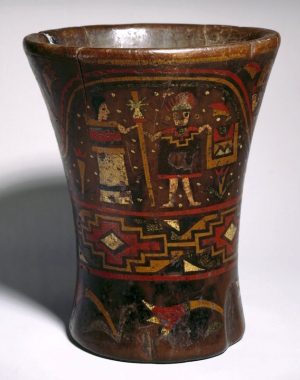
Let’s have a closer look at this particular Inka cup from the Brooklyn Museum. The iconography is quite common for colonial kerus. Its imagery is divided into three registers (bands)—like a comic strip. At the bottom, we see Andean flowers, likely Kantuta, which were symbolically connected to the Inka elite. Above, we find a strip with geometric patterns, similar to tocapu designs, which are also associated with Inka nobility. These designs were found on textiles as well, especially on the elaborate tunics, called unkus (also spelled uncus), of the Inka elite. As mentioned above, these motifs might have contained hidden meanings, as the Inka did not use a writing system, at least not in the strict sense of the term.
A figurative scene (image below) dominates the top register of the cup. We clearly recognize a man and a woman whose traditional apparel indicates that we are looking at representations of an Inka ruler, the Sapa Inka, and his wife, the coya. The ruler, addressing the observer in full frontal view, is wearing an unku and is crowned with the imperial headdress, the mascaypacha (also spelled mascapaycha or mascapaicha). The shield and spear in his hands characterize him as a leading warrior and are a reminder of his military power. At his side, the coya is likewise dressed in indigenous clothes, including a wrap dress (anacu) and a cloak (lliclla). The two individuals form a pair, symbolizing the complementary duality of opposites, in this case male and female, that formed Andean cosmology. As mentioned above, kerus were always produced in almost identical pairs that were then exchanged between two parties.
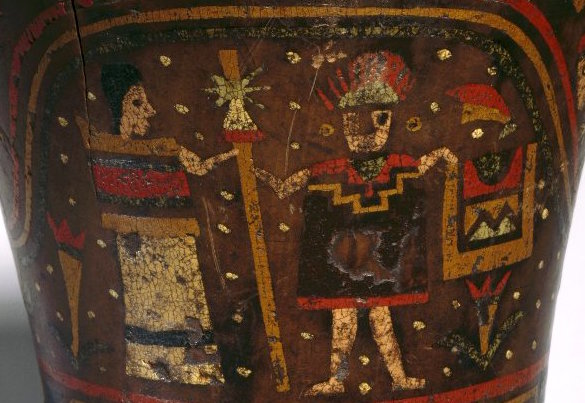
The figures on this keru stand under a rainbow, with light spots around and in between them, possibly depicting raindrops. Water was scarce and therefore a vital good in the often arid regions of the Andes. The rainbow thus connected the Inka with fertility and consequently with the power over life and death. Furthermore, the rainbow offered the Inka ruler a bridge to the heavenly realms as it connected the earth with Inti, the divine sun, the Sapa Inka’s father. On similar keru examples, the rainbow rises from the mouth of a feline, a frightful, strong and elegant animal that, owing to its attributes, is also associated with the Sapa Inka.
The royal pair is surrounded by potent symbols of military power, fertility, strength, and divine descent—all justifying Inka rulership. The iconography of this keru reflects its use in important religious and political rituals. While the rainbow indicates the ties between the Sapa Inka and Inti during the ceremonial toast to the sun god, the keru representation of the ruler as the leading Inka warrior with the power over life and death reminded political authorities during the official keru exchange with the Inka of the advantages, but also the possible menaces, resulting from forming or refusing alliances with the Inka.
Eliminating the threat
Over the years, the Spaniards realized that the kerus were not simple cups, but meaningful objects that continued to be used in Andean rituals. The Spanish Crown and the Catholic Church both suspected a possible threat emerging from these enigmatic vessels. For them, kerus formed part of a dangerous side of Andean culture that had to be transformed and controlled, so as not to undermine colonial rule or conflict with evangelization.
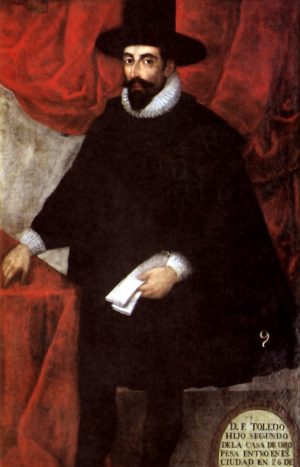
Francisco de Toledo, a viceroy of colonial Peru, gained notoriety in this context. In a time of financial struggles and continuous indigenous rebellions, Toledo carried out extensive reforms in the 1570s and 1580s to reestablish and secure Spanish royal power in the colonies. Everything Andean was viewed as a potential threat under his leadership. In the course of an extended campaign to erase any traditional indigenous beliefs and traditions, many kerus were destroyed along with other Inka objects like unkus, and the many religious figurines made of precious metals that where melted into easily transportable ingots. The kerus made of gold or silver were melted down, but wooden vessels survived, mainly because the cups were very popular in colonial society. Like modern souvenir hunting, Europeans loved these “indian” vessels and ordered their production for personal use, gifts, or trade.
Unfortunately, this love for the exotic endures today, so that kerus form a large part of the objects sold on the black market. The relatively few cups remaining for the use in a scientific context are spread all over the world in the different museums and collections. Unfortunately, many of the wooden examples have deteriorated over time. The exceptionally well-conserved keru at the Brooklyn Museum therefore represents a precious example and provides us with insights into a complex and fascinating society.
Additional resources:
This work at the Brooklyn Museum
Colonial Kero Cups on the Metropolitan Museum of Art’s Heilbrunn Timeline of Art History
Kero in the collection of The National Museum of the American Indian
Kero on the Google Art Project
Thomas Cummins, Toasts with the Inca. Andean Abstraction and Colonial Images on Quero Vessels (Ann Arbor, The University of Michigan Press, 2002)
Diane Fane, ed., Converging Cultures. Art and Identity in Spanish America (New York, Harry N. Abrams, 1996)
Jorge A Flores Ochoa, Elizabeth Kuon Arce, et al., Queros. Arte Inka en vasos ceremoniales (Lima, Banco de Crédito del Perú, 1998)
What is an Inka ushnu?
Ushnus
The Inka capital Cusco and principal outlying towns of the Inka Empire were organized around a public plaza with a specially-constructed platform placed facing a designated sacred central space called the ushnu. This sacred space was marked by a vertical opening into the body of the earth into which liquid and other offerings were made.

The ushnu platform was therefore a kind of stage from which the Inka king and his lords could observe and rule over an annual round of seasonal festivals and ceremonial events.
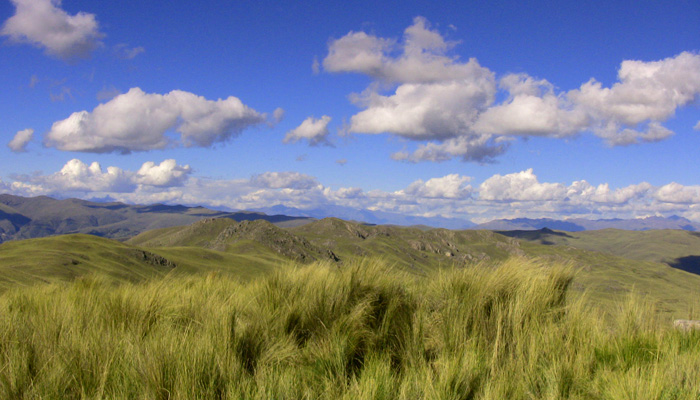
In the late 1990s archaeologists in Ecuador, Peru, Bolivia, Chile and Argentina began mapping the full system of Inka roads, including many of the less accessible, secondary trails at high altitude. In Peru this survey soon revealed a previously unrecognized category of stone platform with typically distinctive Inka stonework. These structures are carefully positioned on isolated mountain-tops 4000–4800 meters above sea level and represent some of the highest dressed-stone architecture found anywhere in the Americas, and possibly in the world. These structures were clearly important in Inka political and sacred geography and had profound symbolic significance.
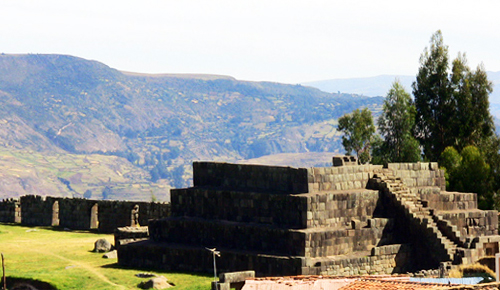
The sites were selected to command unsurpassed views of the snow-capped mountain peaks, worshipped as wamanis, or mountain deities, by the local communities. In this way local deities were incorporated into the overarching Inka state religion. The Inkas used the platforms as potent symbols of religious and political authority. They served as an innovative and powerful new instrument of statecraft in order both to define and proclaim their growing imperial hegemony.
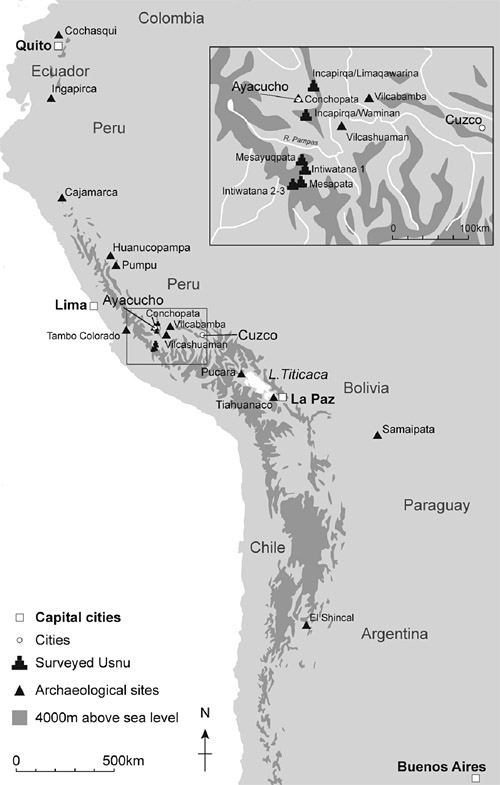
Research
Atahualpa, the Inka ruler taken and killed by Spanish invaders in the 1500s, asked for the meeting with his murderers to take place in the great plaza of the town of Cajamarca at the site of a “castillejo,” a type of platform we now call an ushnu. This shows not only thatushnus were appropriate sites to meet strangers, but that they were considered to hold great significance.
Research at 30 platforms across the modern area of Ayacucho has demonstrated that ushnus are located in both town squares and alongside Inka roads. In towns, the platforms are located in or by the side of the main square, while those located on Inka roads are often found on mountain tops. There, they offer views of the horizon and ofWamanis (mountain deities) in the landscape.
Vilcashuaman
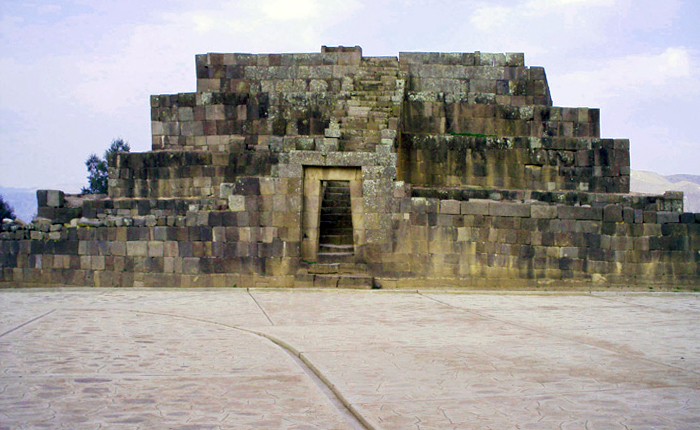
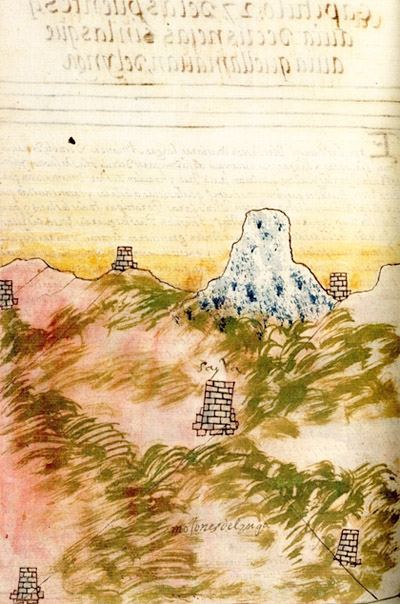
The major ushnu platform at Vilcashuaman, which has been extensively restored comprises four superimposed platforms with a staircase of 36 steps on its eastern side, which, through a gateway, allows access to the top. The staircase is built up against the structure, abutting it. The top platform on its west side has a ramp allowing access to the platform below. On top the platform has a large monolithic seat carved to accommodate two people.
On its eastern side two squarish structures are built up close to the bottom platform; beyond this are the remains of a largekallanka or great hall and it is likely there was a second one of these across an open space. Slightly further to the west is the town’s cemetery.
To the east and north-east is the main colonial plaza and to the north-east are extensive elaborate Inka remains including what have been identified as the footings of the local temples of the sun and moon. The fields surrounding the town are extensively dedicated to growing maize, barley and oats.
© Trustees of the British Museum
Inka ushnus: landscape, site and symbol in the Andes
Video \(\PageIndex{8}\): Video from The British Museum (Inca Ushnus project).
Ancient Colombia chiefdoms
Ancient Colombian goldmaking

El Dorado

For centuries Europeans were dazzled by the legend of a lost city of gold in South America. The truth behind this myth is fascinating. El Dorado–literally “the golden one”–actually refers to the ritual that took place at Lake Guatavita, near modern Bogotá. The newly elected leader, covered in powdered gold, dived into the lake and emerged as the new chief of the Muisca people who lived in the central highlands of present-day Colombia’s Eastern Range.
The Muisca, Quimbaya, Calima, Tairona, Tolima and Zenú chiefdoms in ancient Colombia used gold to fashion some of the most visually dramatic and sophisticated works of art found anywhere in the Americas before European contact. Although gold was not valued as currency in pre-Hispanic Colombia, it had great symbolic meaning. It was one way the elite could publicly assert their rank and semi-divine status, both in life and in death.
More than just gold
Objects that seem at first glance made of gold are more complex and are in fact made of metal alloys. In most instances they combine, in different degrees, gold, some natural occurring silver, and copper, a combination known as tumbaga. These metals were symbolically charged in pre-Hispanic times, being associated with the sun and the moon respectively. Their combination produced a microcosm, a balance between opposites in the rendering of each object.

The creation of alloys also allowed for differences in color, ranging from reddish to golden tones. Each object had its own particular color, shine and finish thanks to the mastery and skills of the artists that produced them. Some even show contrasting colors in the same object, producing beautiful patterns and details.
Hammering and casting
Small ingots of tumbaga, in the shape of round buttons, were crafted into unique objects either by hammering or casting them (or by a combination of both techniques). Ancient Colombian artists mastered both techniques to an unprecedented degree, creating exceptional works of art.
Hammering metal was a delicate process. Metal becomes easily brittle when hammered and they have to be repeatedly cooled and dipped in water before the final form is achieved. The thin sheets of gold were then cut, decorated (for example by repoussé) or joined by clipping or folding several sheets together.
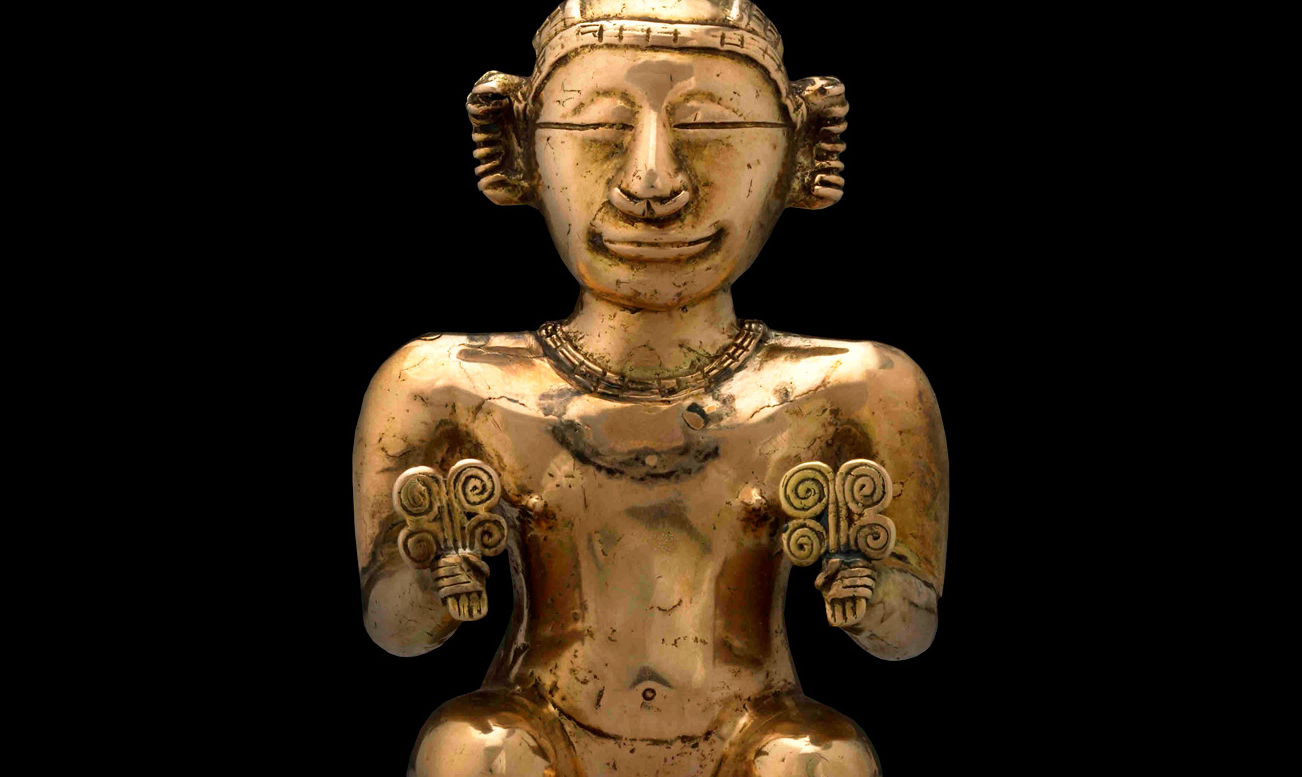
However, it was the casting of metals that was developed most in ancient Colombia. Using the lost wax technique, artist modeled the final piece they wanted to achieve in beeswax (from stingless bees). Once the wax figure was finished it was covered in fine clay and charcoal, leaving pouring channels. The whole mould was fired and the melted wax poured out. Its place would be taken by molten metal, which cooled slowly as it solidified inside the mould. The mould was then broken and the final metal piece polished and finished.
Ancient Colombian artists even created hollow objects following this technique, for example flasks and containers. Great skill was needed to produce them. The figure was modeled in clay and charcoal, and a thin layer of wax was applied to cover the final result. Over this another layer of clay would be added, and wooden pegs were inserted to fix the inner mould to the outer one to keep them in place when the wax melted. Controlling the flow of the metal to every single detail of the piece, its slow solidification, and then freeing the figure without damaging it was challenge that could only be achieved by the most experienced hands.
© Trustees of the British Museum


